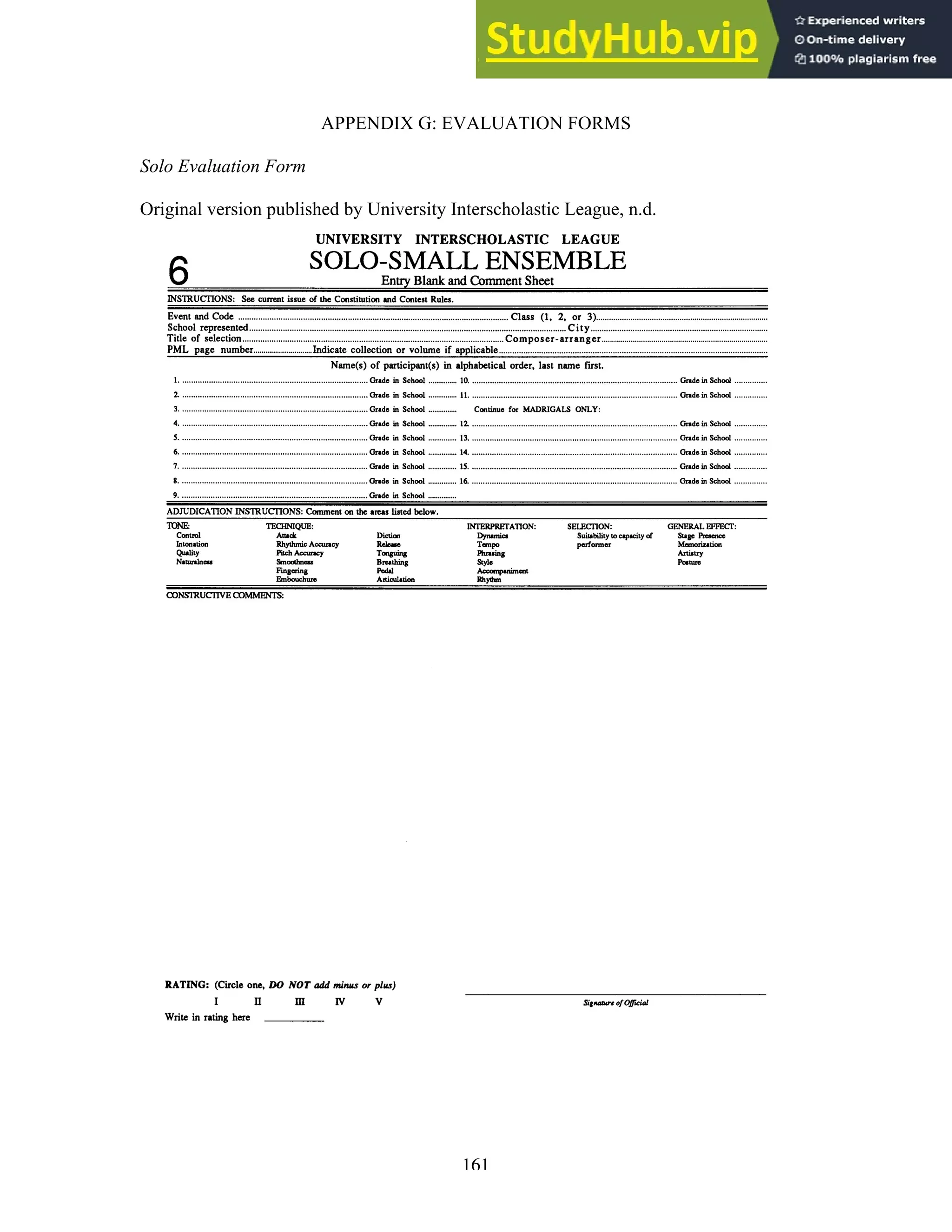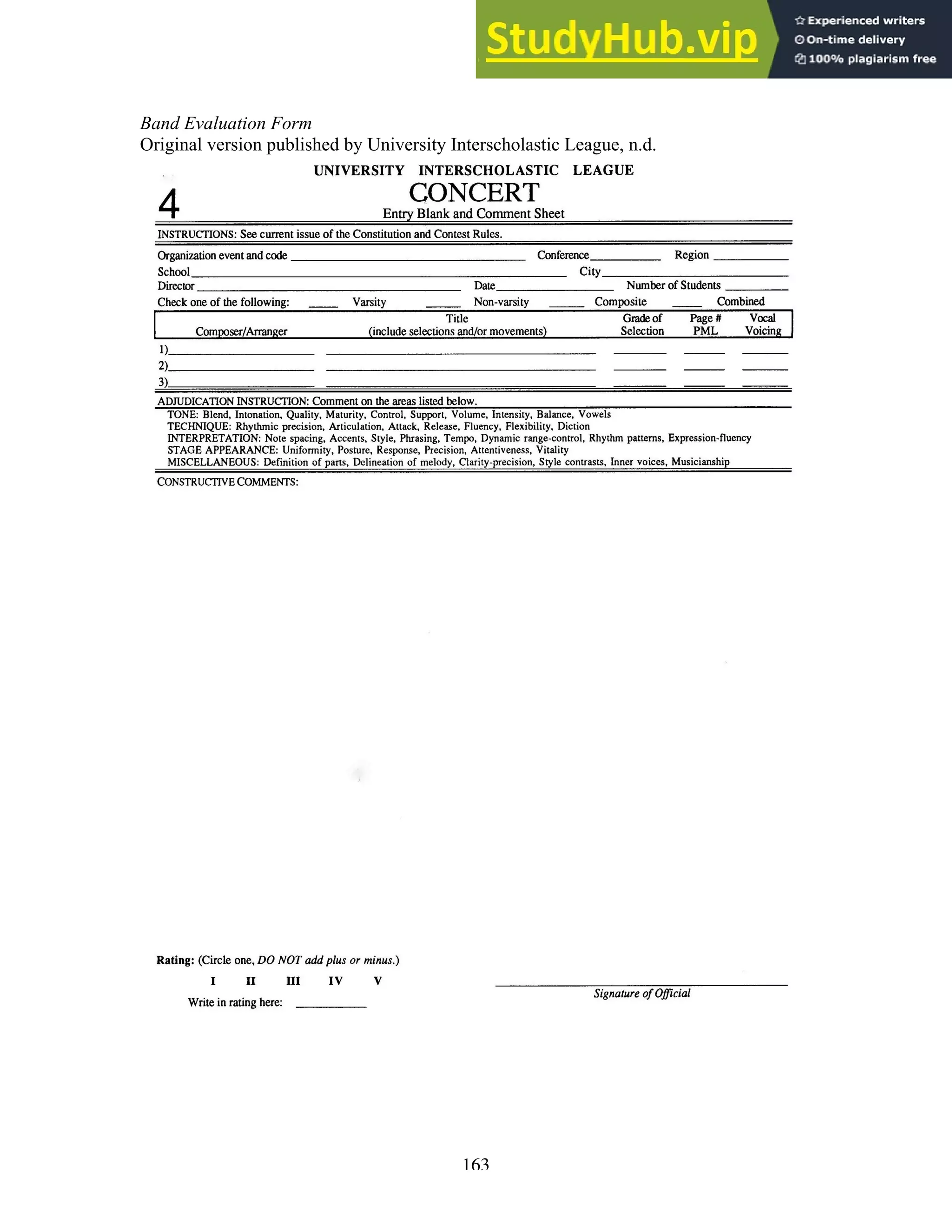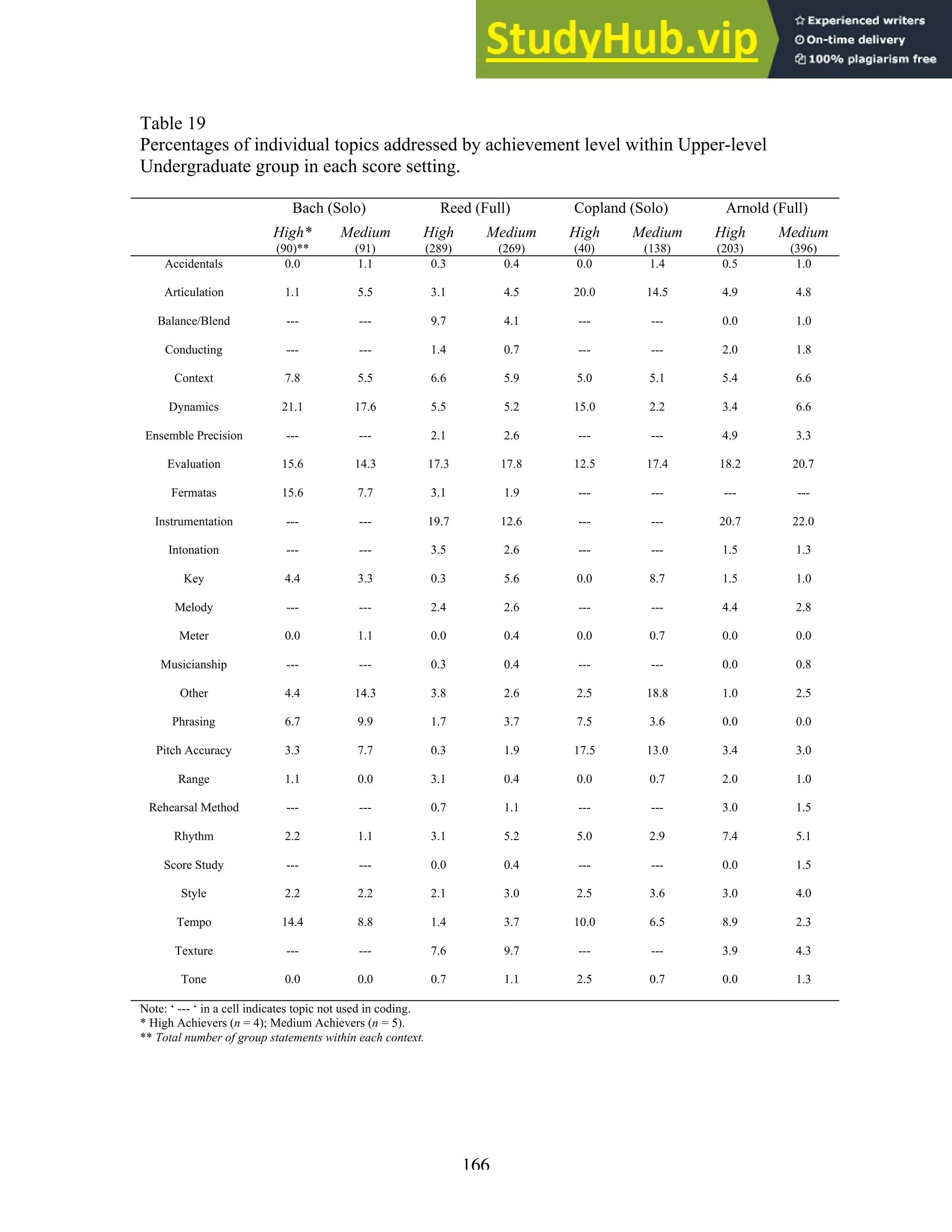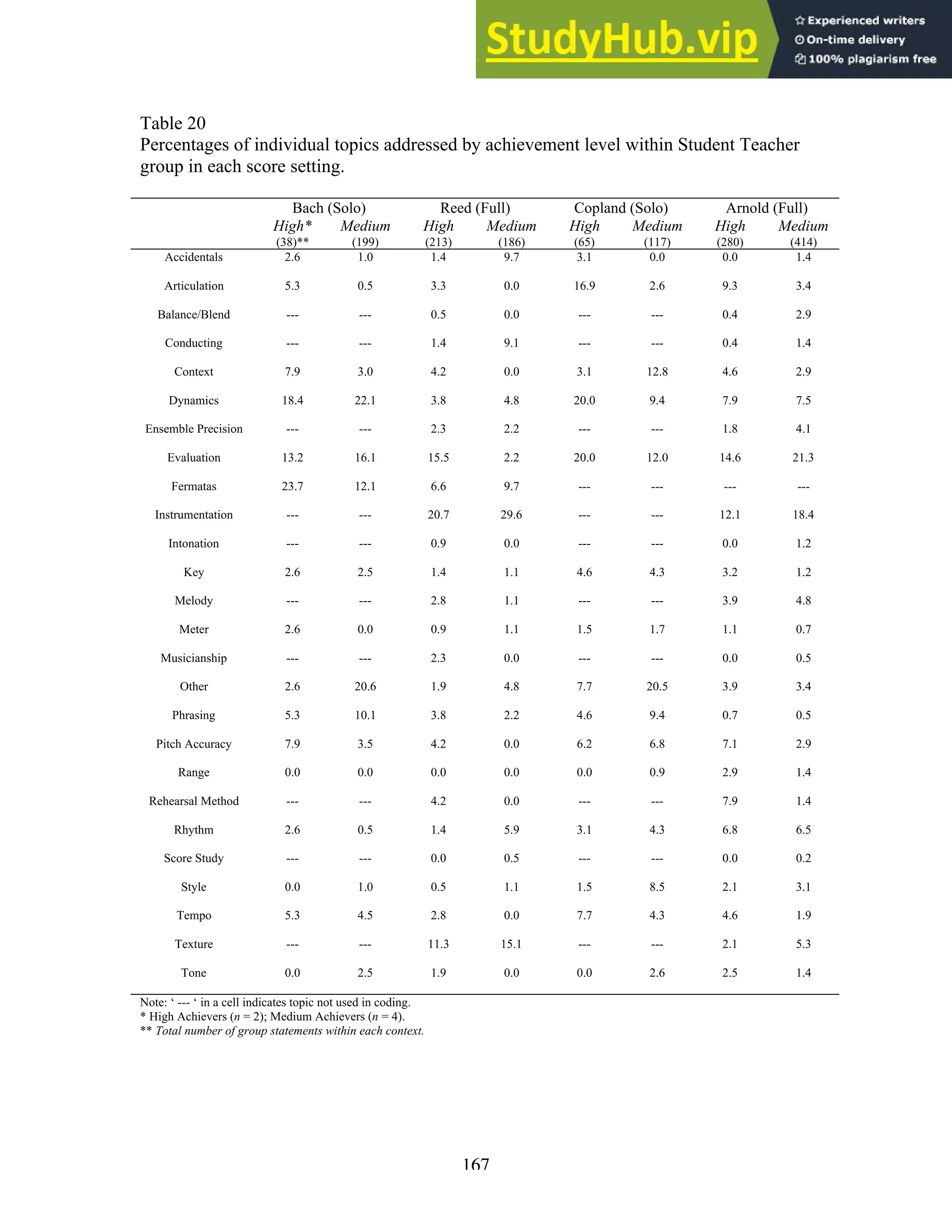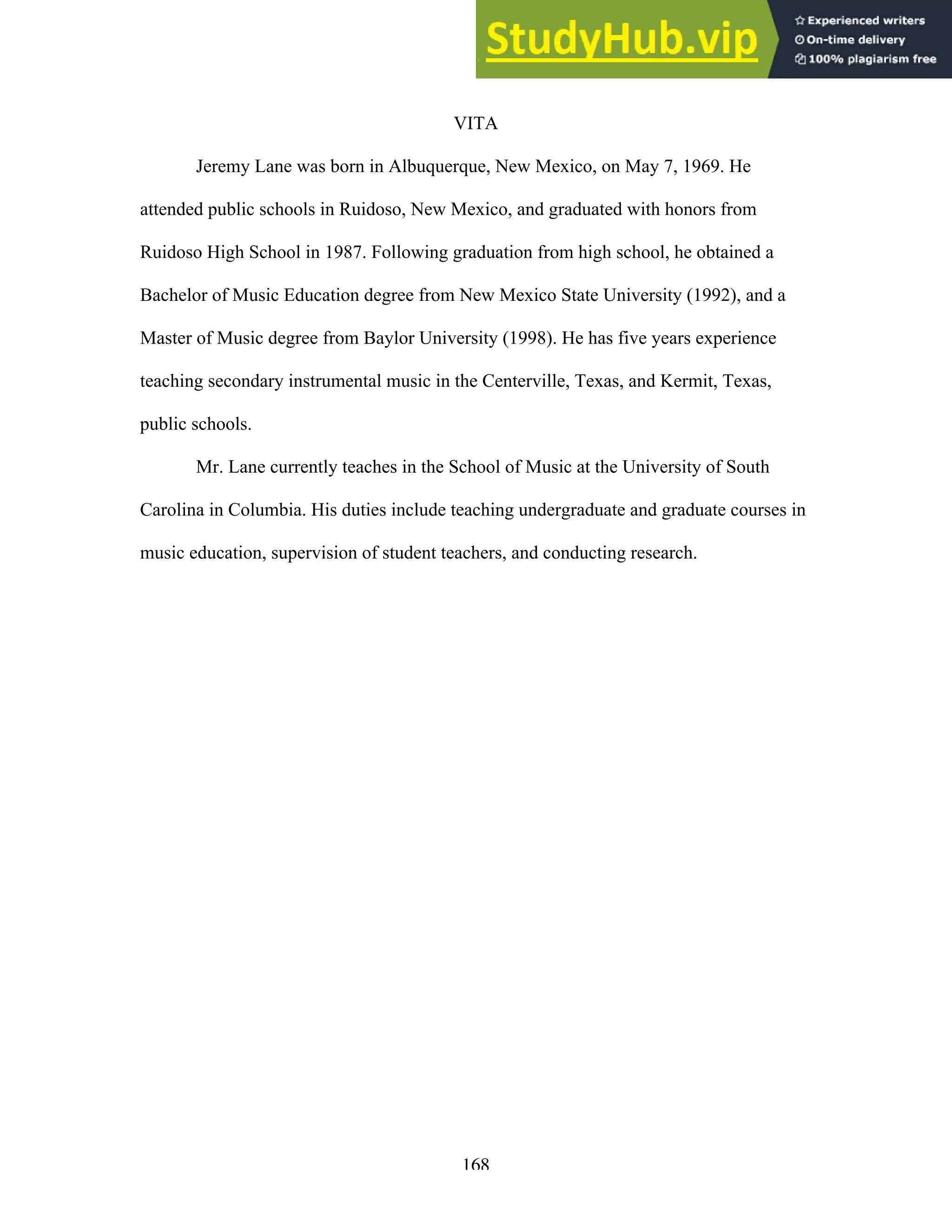This dissertation examines the score study procedures of undergraduate instrumental music education majors when studying solo and full scores. The study involved 21 subjects who participated in interviews and "thought out loud" as they studied scores. The goals were to describe the procedures used, examine relationships between procedures and musical contexts/experience levels, and compare subjects' approaches to those of expert conductors. The results showed that while subjects recognized the importance of score study, their actual procedures provided little evidence of developing an internal sound image. Subjects also did not effectively use their musical knowledge to contextualize scores or make decisions. Their approaches tended to focus more on expressive elements for solos but technical elements for full scores. Overall experience and coursework had a positive
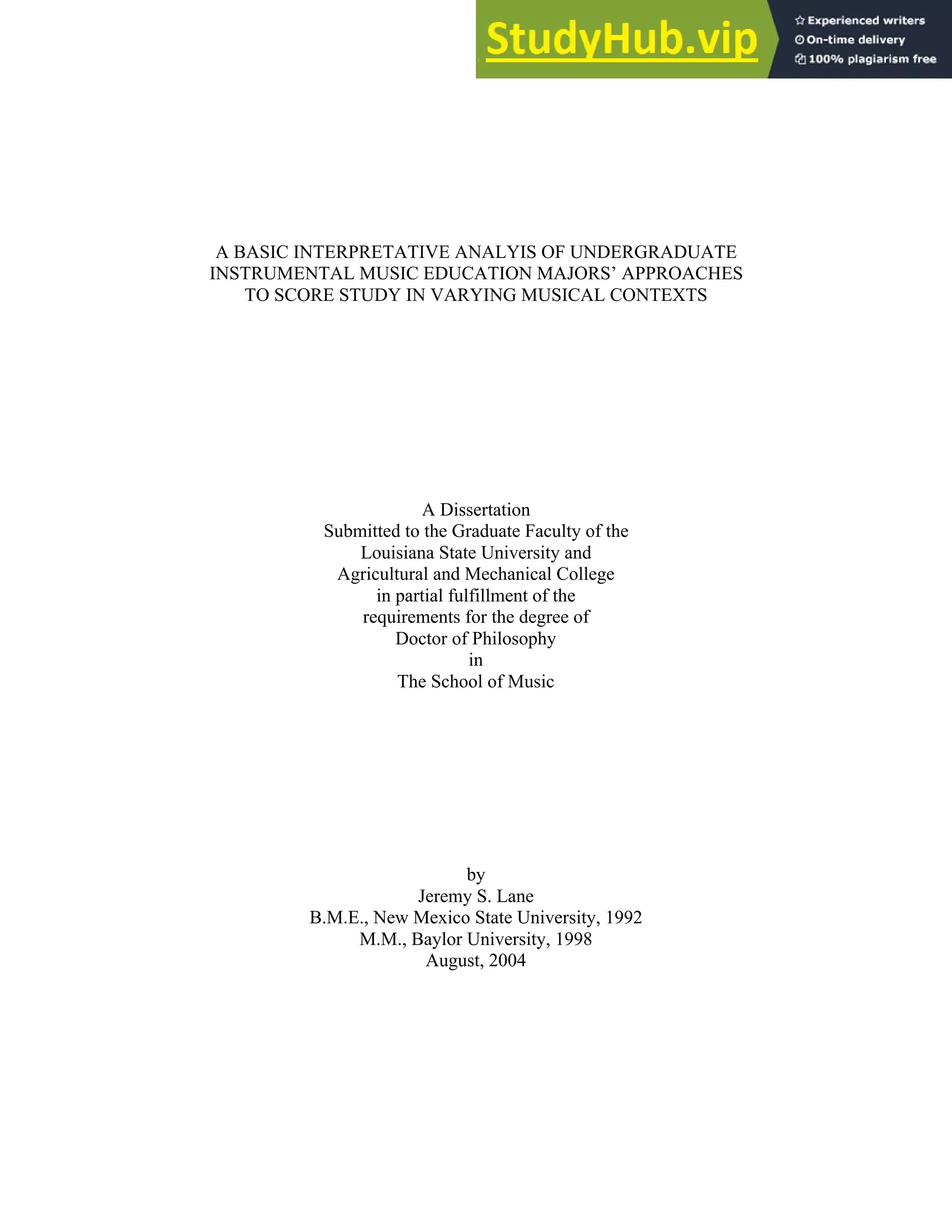
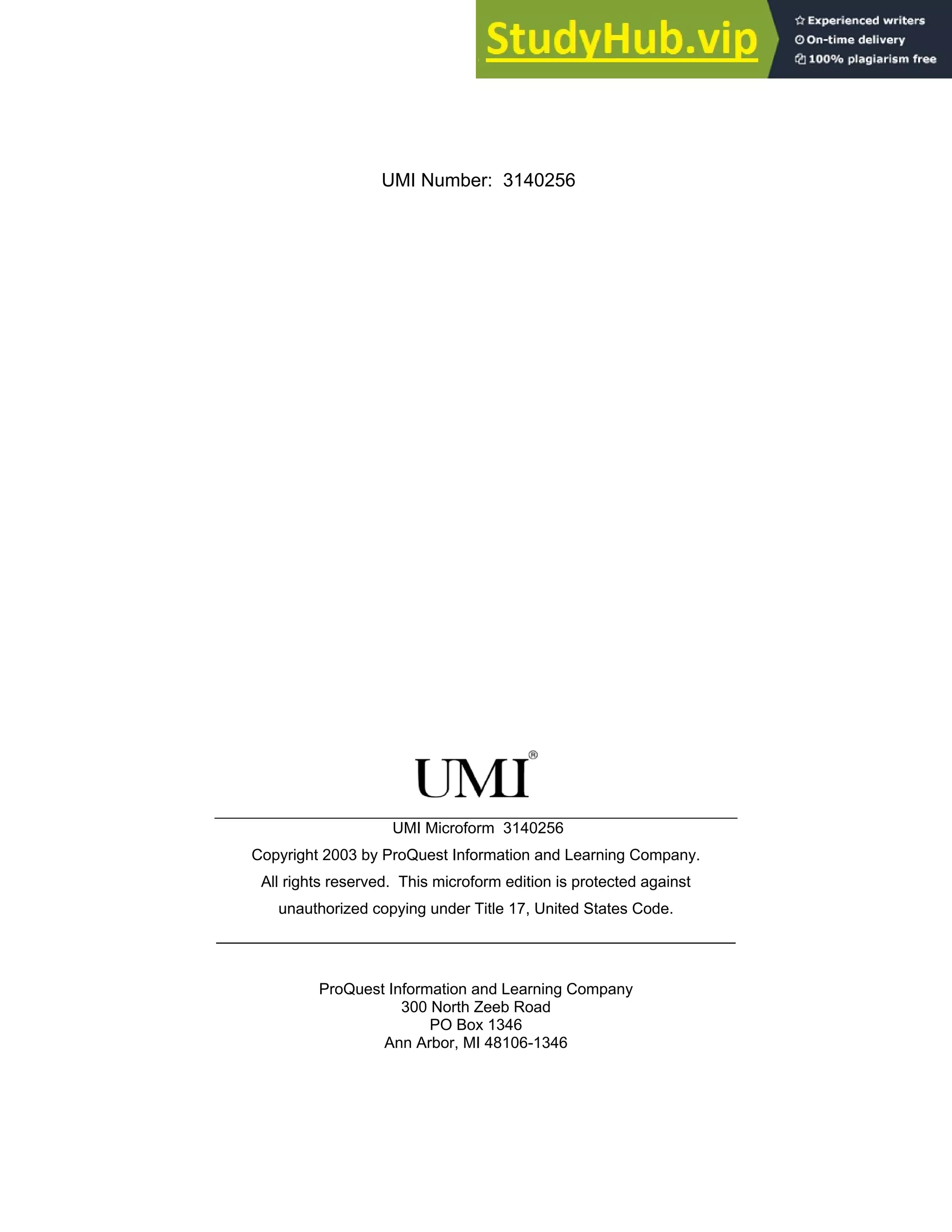
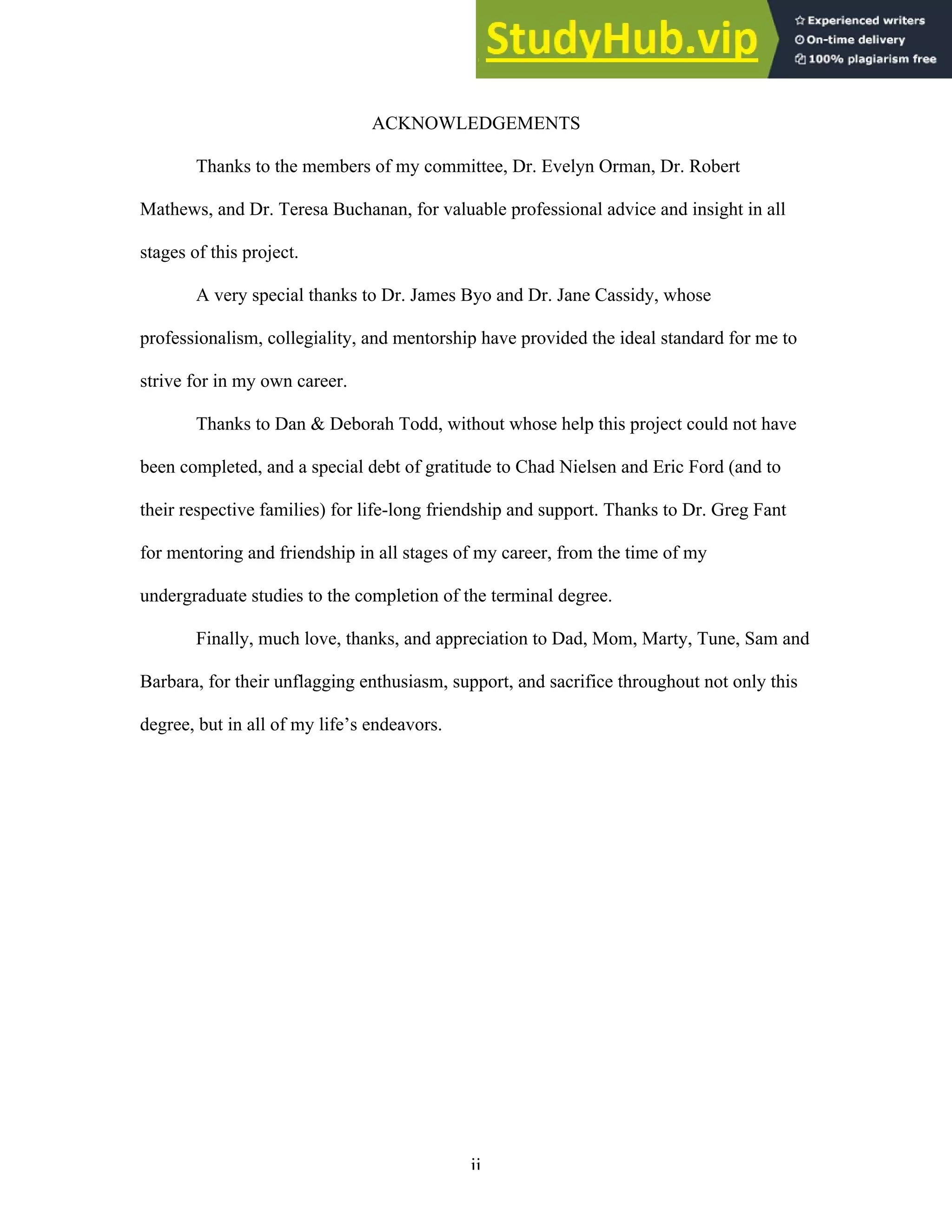
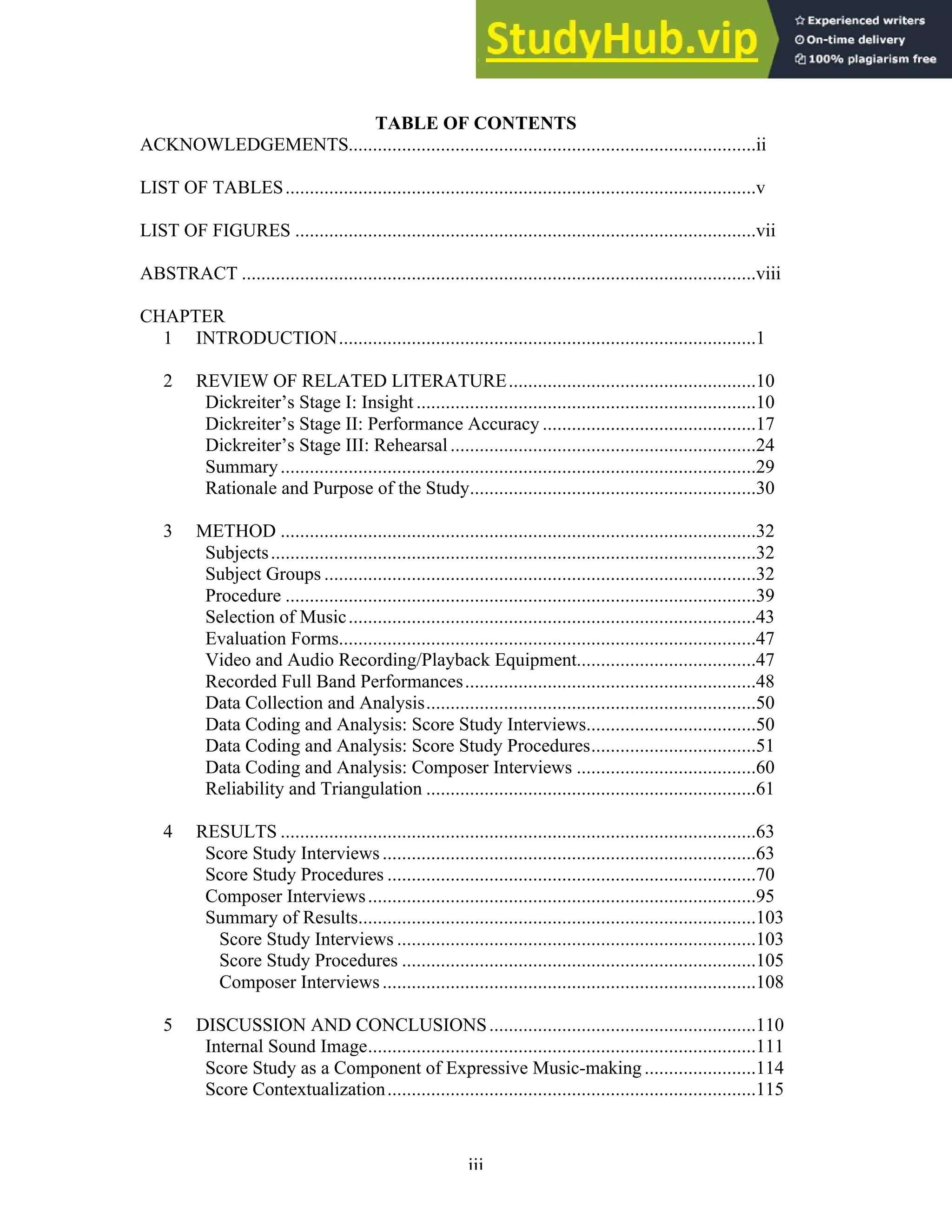
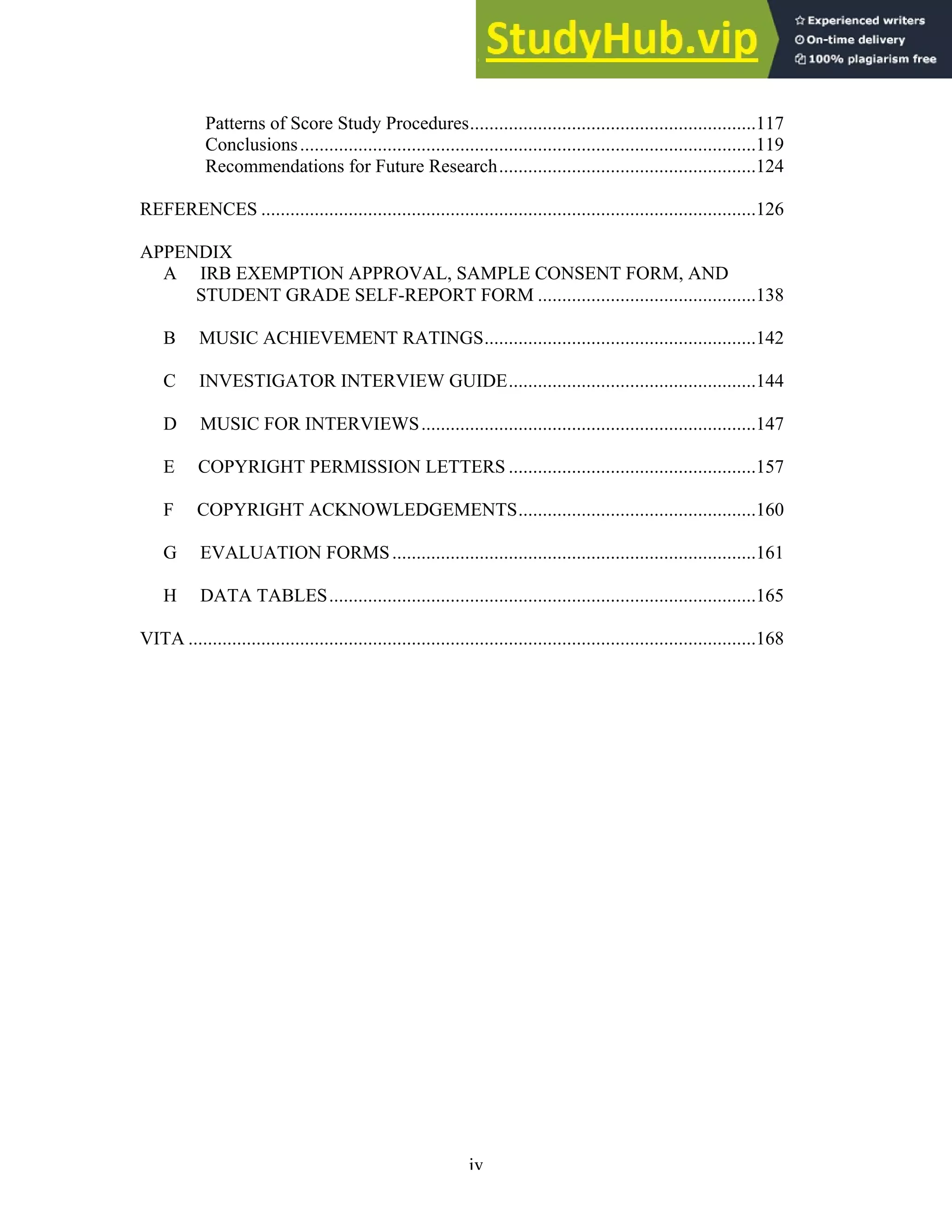



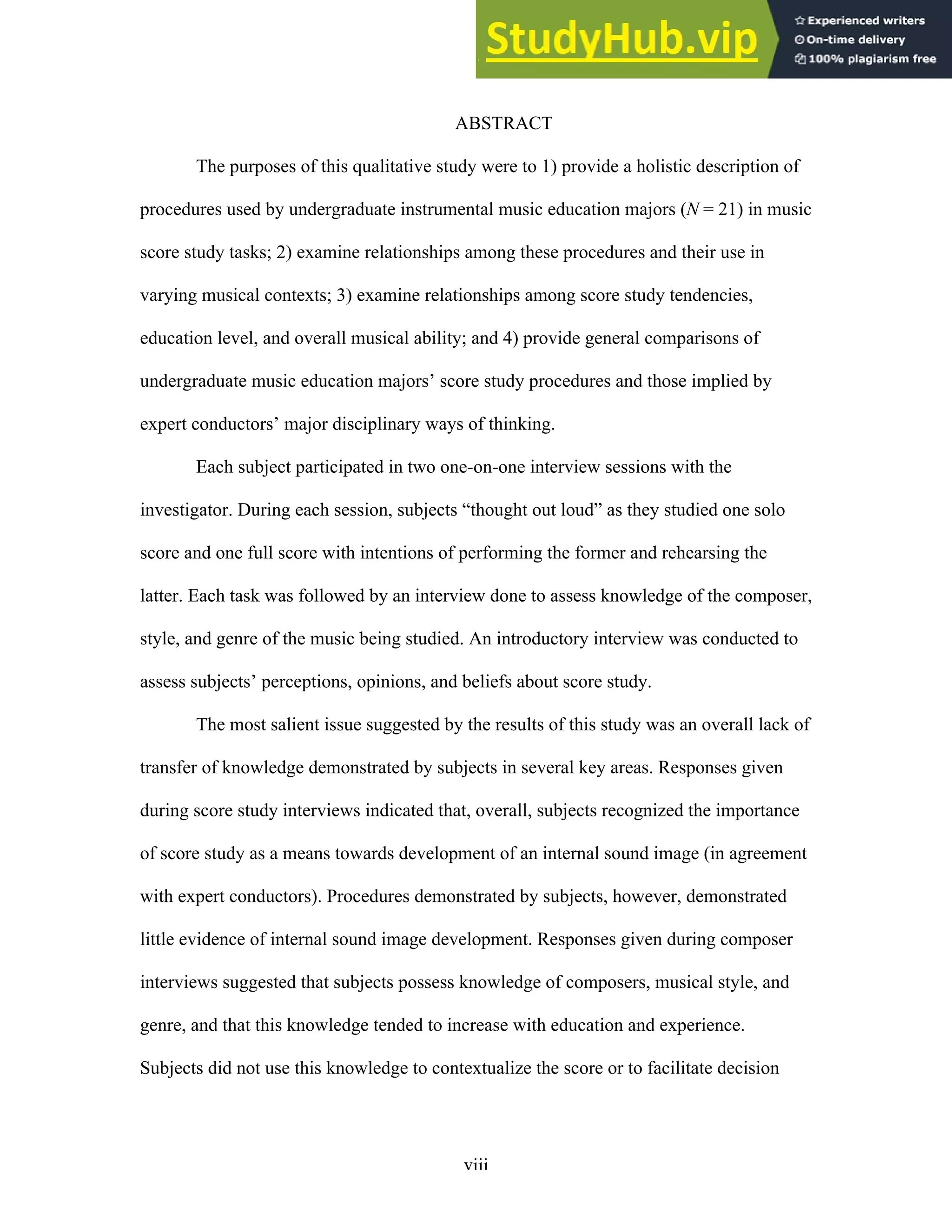
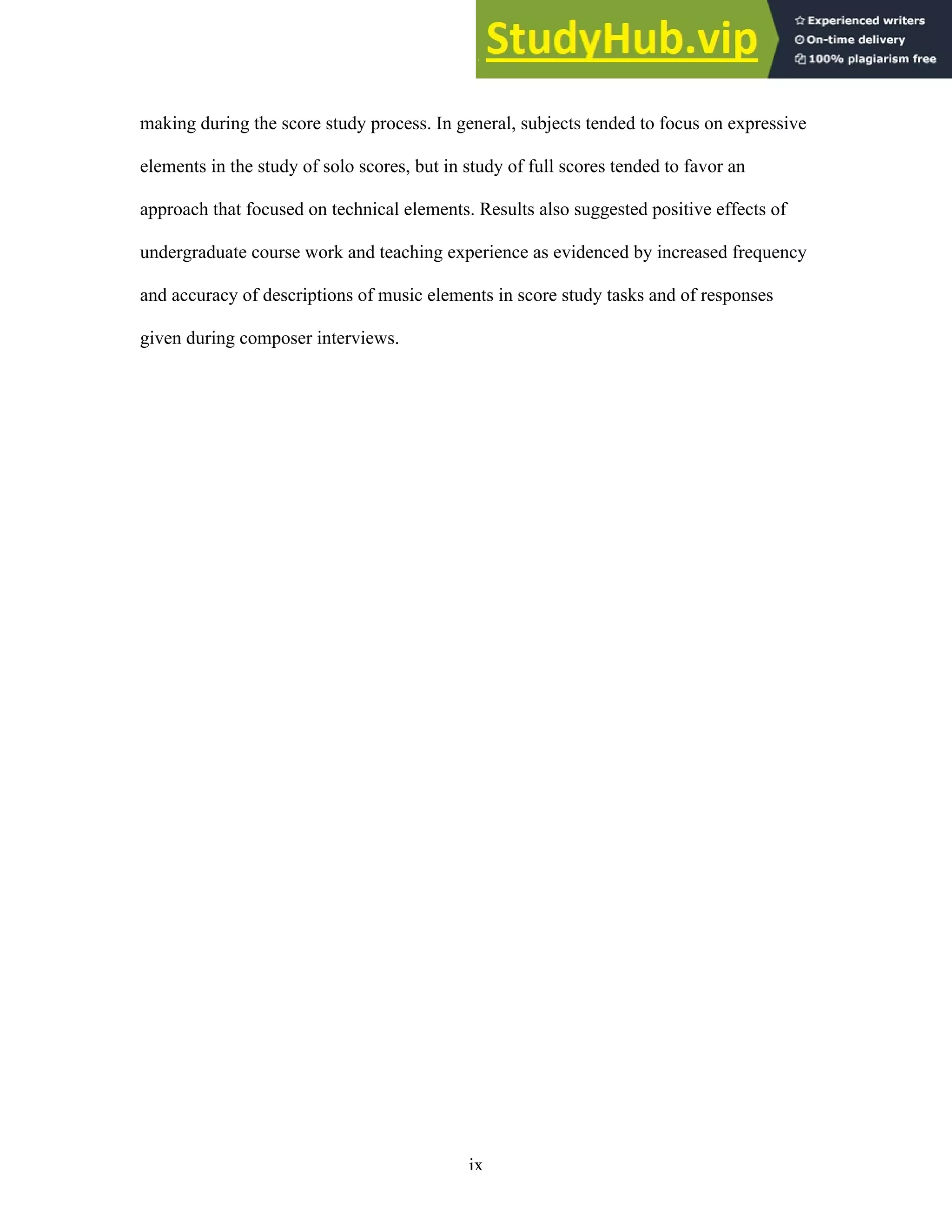
![1
CHAPTER 1: INTRODUCTION
One day I was in my piano class and I was asked to go into the office of the director… he
said to me, ‘Have you ever thought to be a conductor?’ And I said, ‘No.’ He said, ‘Would
you like to try?’ I said, ‘Why?’… Tomorrow was a rehearsal with the orchestra and in
the programme were two works by Bach. So… I had the scores, very simple scores
because these were Bach concertos… The next day in the afternoon at four o’clock I was
in front of the student orchestra and after a half an hour of trying, the teacher of the class
went up to the office of the Conservatorio and said ‘A new conductor is born.’ And that
was the beginning (quoted in Chesterman, 1989, p. 133).
For most novices, learning how to conduct an ensemble in musical performance is
a process considerably more challenging than the one described above by noted
conductor Riccardo Muti. The complex nature of conducting makes it a difficult subject
to learn, and equally as difficult to teach. In fact, many professional conductors doubt that
it can be taught at all, subscribing to Leopold Stokowski’s view that, “Conductors are
born, not made. No amount of academic education can make a real conductor out of
someone who is not born with the necessary qualities” (quoted in Bamberger, 1965, p.
202).
Though it may be difficult, training novices in the art of conducting is well within
the abilities of proactive, capable teachers. Educational scholar and philosopher Jerome
Bruner wrote, “Any subject can be taught effectively in some intellectually honest form
to any [student] at any stage of development” (Bruner, 1960, p. 33). Even Stokowski
admitted that certain aspects of conducting can be taught, such as “how to beat time, how
to read orchestral scores, and the nature of orchestral instruments” (quoted in Bamberger,
1965, p. 202-203).
Findings of research in music education show that many conducting skills can be
taught effectively to novices, including gesture (Johnson & Fredrickson, 1995; Orzolek,
2002; Price, 1985; Yarbrough, 1987; Yarbrough, Wapnick & Kelley, 1979), aural
perception skills (Hayslett, 1996), and error detection (Boyer, 1974; Collings, 1973;](https://image.slidesharecdn.com/abasicinterpretiveanalysis-230806181021-8e7fdd33/75/A-Basic-Interpretive-Analysis-11-2048.jpg)
![2
Costanza, 1971; Decarbo, 1982; Grunow, 1980; Liles, 1978; Ramsey, 1979; Sidnell,
1971). Computer-assisted methods have been effective in analyzing gesture (Kraus, et al.,
2002; Marrin, 2002), score study (Hudson, 1996), and error discrimination (Gruner,
1993; Jones, 1990). Videotaped behavioral-self assessment has generally produced
positive effects on attainment and improvement of basic conducting skills (Grashel, 1991;
Karpicke, 1987; Leppla, 1990; McWilliams, 1996; Price, 1985; Yarbrough, 1987;
Yarbrough, Wapnick & Kelley, 1979).
Although many aspects of conducting can be taught effectively, time constraints
force the issue of choice with regards to which of these aspects should be taught. It would
be nearly impossible for sufficient coverage to be devoted to every aspect of conducting
within the allotted time frame of most conducting courses at the collegiate level. Frank
Battisti, former teacher and conductor of the New England Conservatory Wind
Ensemble, explains the problem, stating, “In most conducting programs… [master’s
degree students] have two years total…. With the starts and stops between semesters…
you end up with forty-eight weeks to prepare somebody to conduct. That’s not a hell of a
lot of time” (quoted in Harris, 2001, p. 81). For this reason, instructors must choose from
the multitude of related skills only those most essential to effective conducting and
address these as deeply as possible.
Leading educational scholars have proposed a strategy for selection and
development of curricular content based on the idea of planning backward (Duke, 2001;
Gardner, 2000; Wiggins & McTighe, 1998). Planning backward begins with the
identification of the ideal results and outcomes of instruction prior to development of any
other aspect of the curriculum. Identification of the exemplary student, or accomplished](https://image.slidesharecdn.com/abasicinterpretiveanalysis-230806181021-8e7fdd33/75/A-Basic-Interpretive-Analysis-12-2048.jpg)


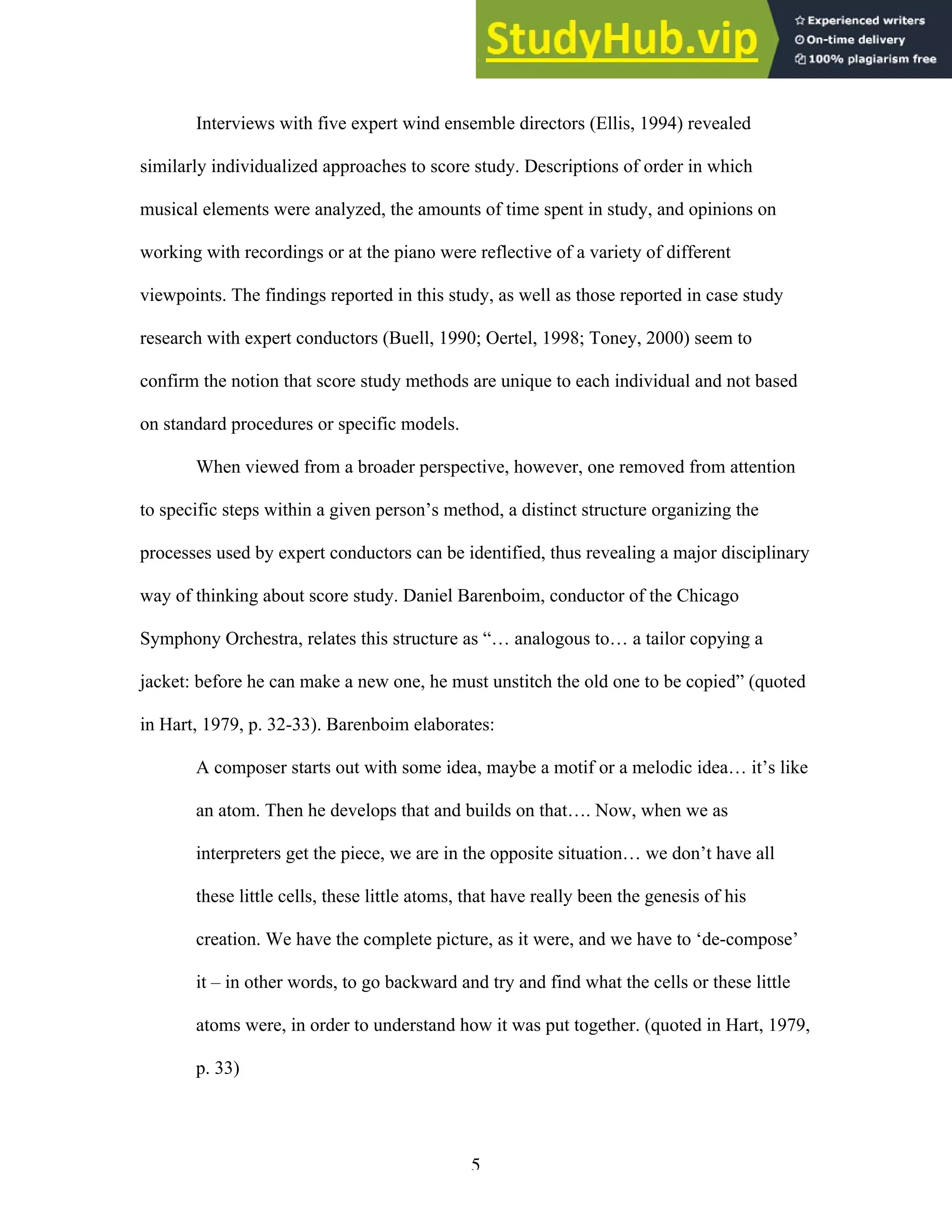
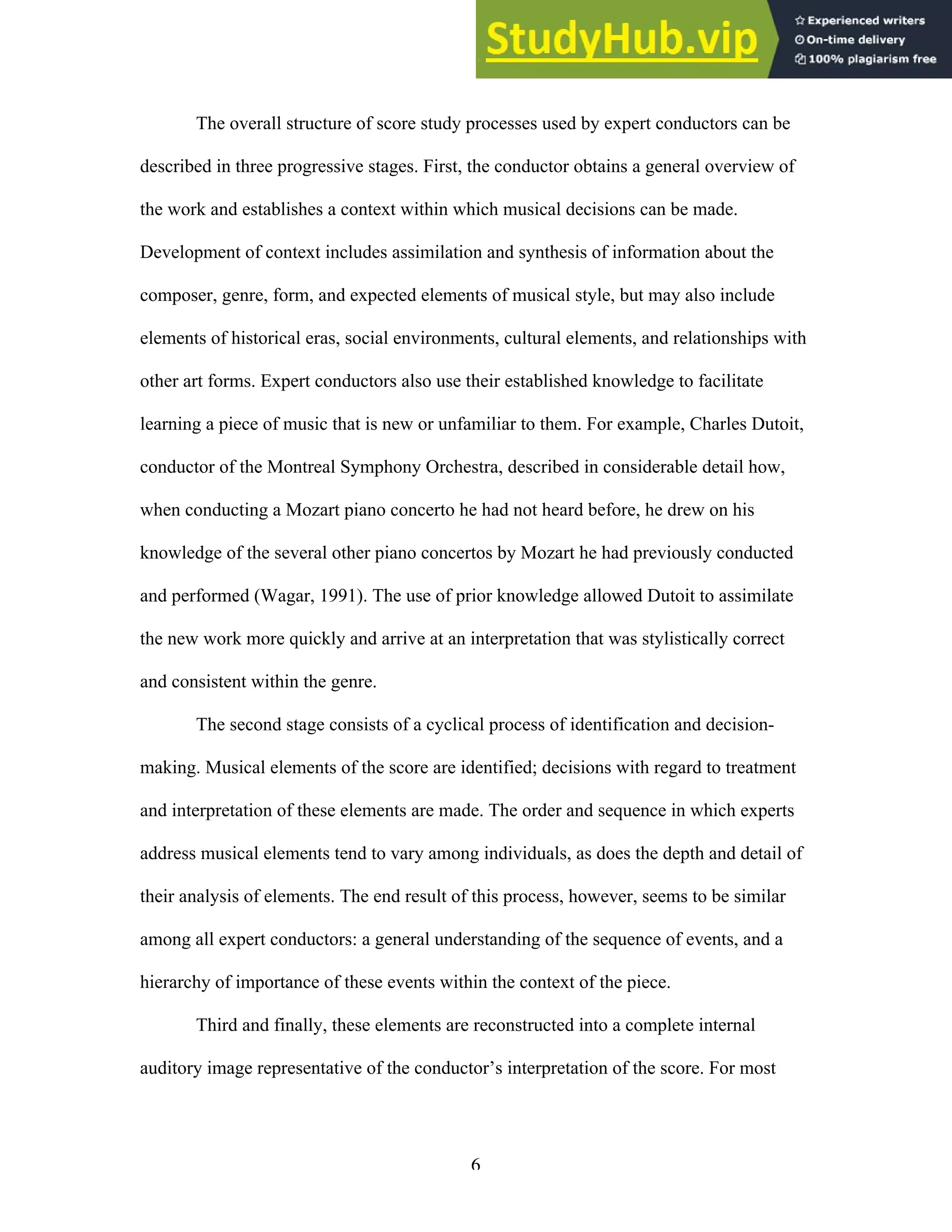
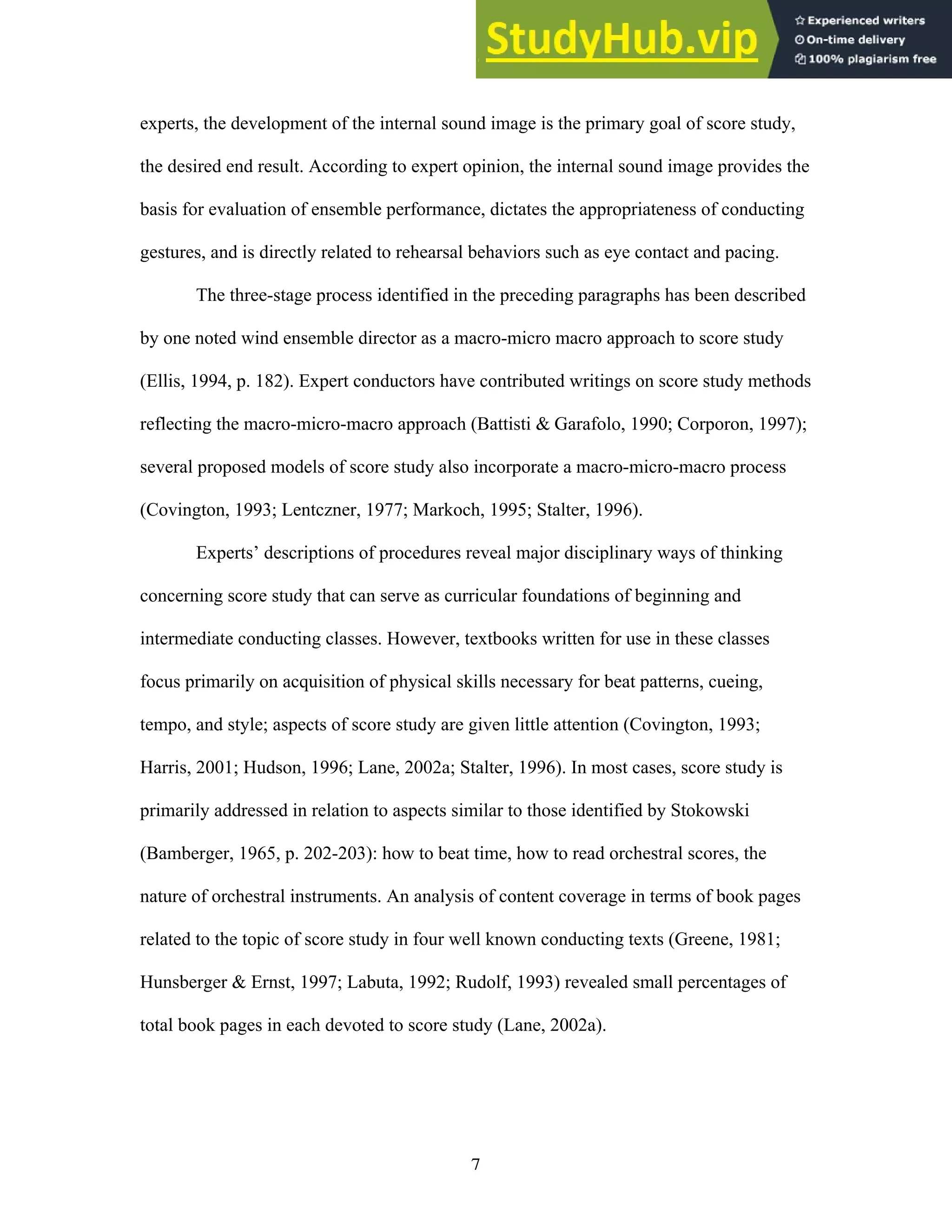
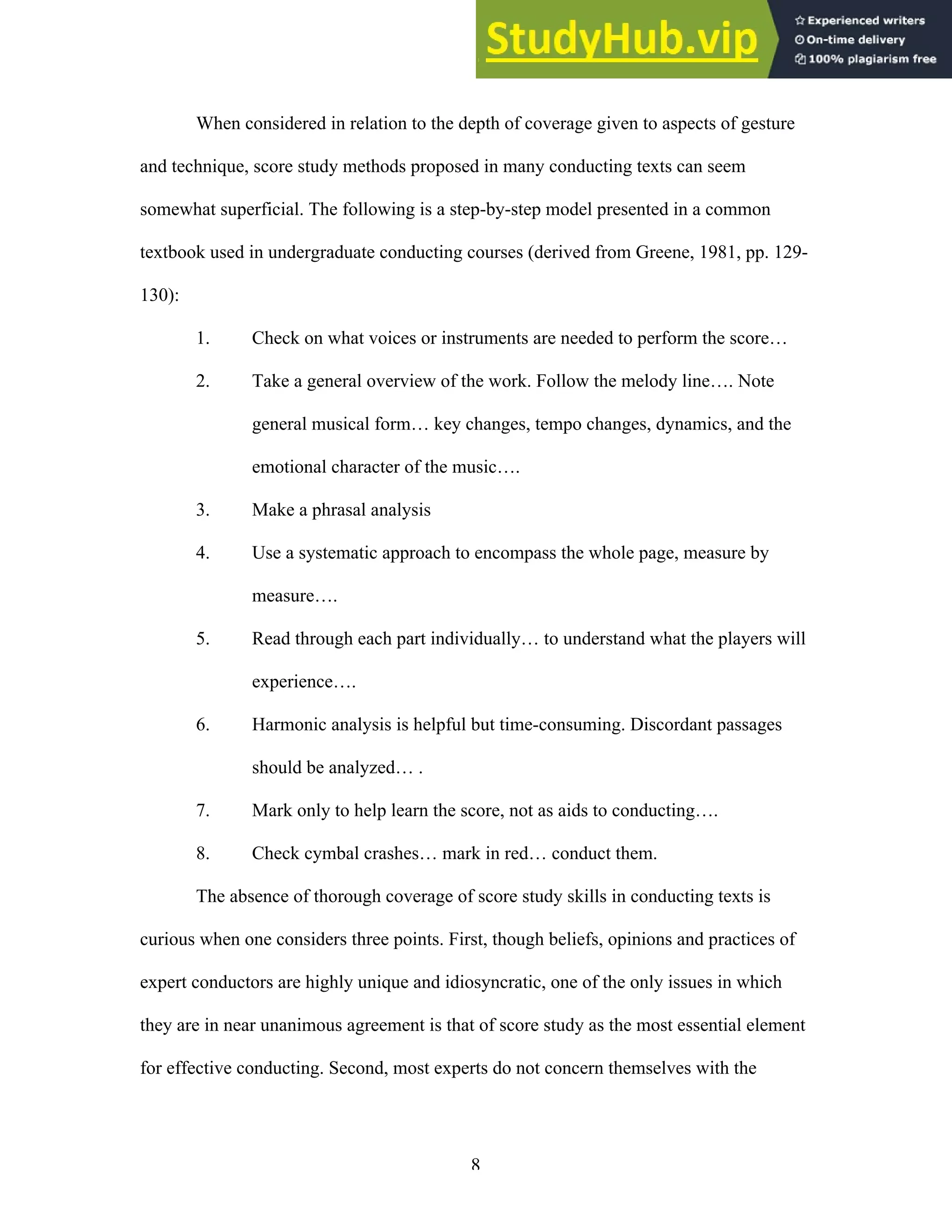
![9
gestures necessary for a specific piece of music until they have first assimilated a deep
and thorough knowledge of the score. Finally, score study skills are generally described
by experts as considerably more difficult to learn than those of conducting technique.
Noted conductor Edo de Waart recalls that during his first years as a professional, trying
to learn scores was a source of great frustration. “I still remember [asking conductor
George] Szell… ‘How do I learn it? How do you learn a score?’ And I really have never
gotten an answer from anybody, because nobody really ever knows” (quoted in Hart,
1979, p. 209).](https://image.slidesharecdn.com/abasicinterpretiveanalysis-230806181021-8e7fdd33/75/A-Basic-Interpretive-Analysis-19-2048.jpg)
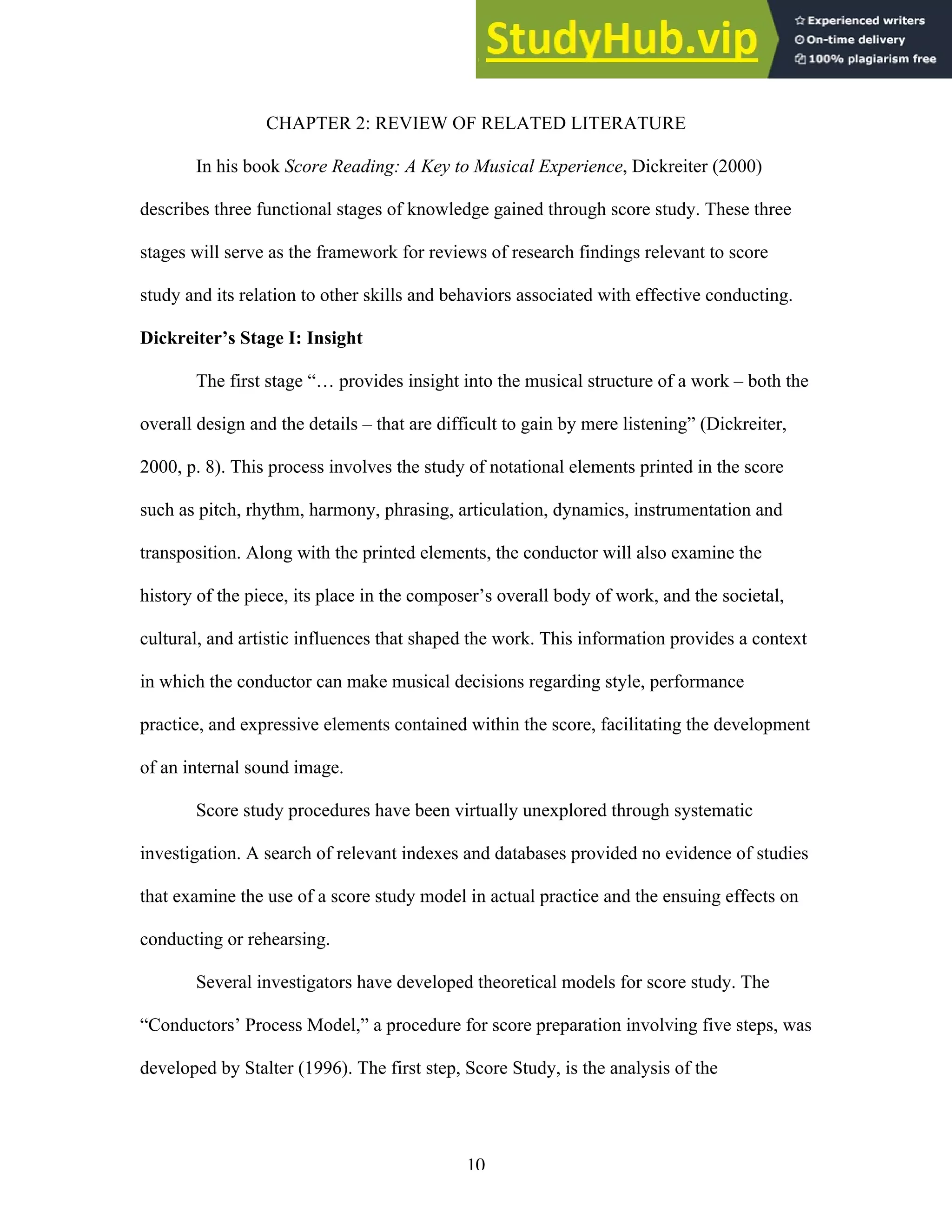

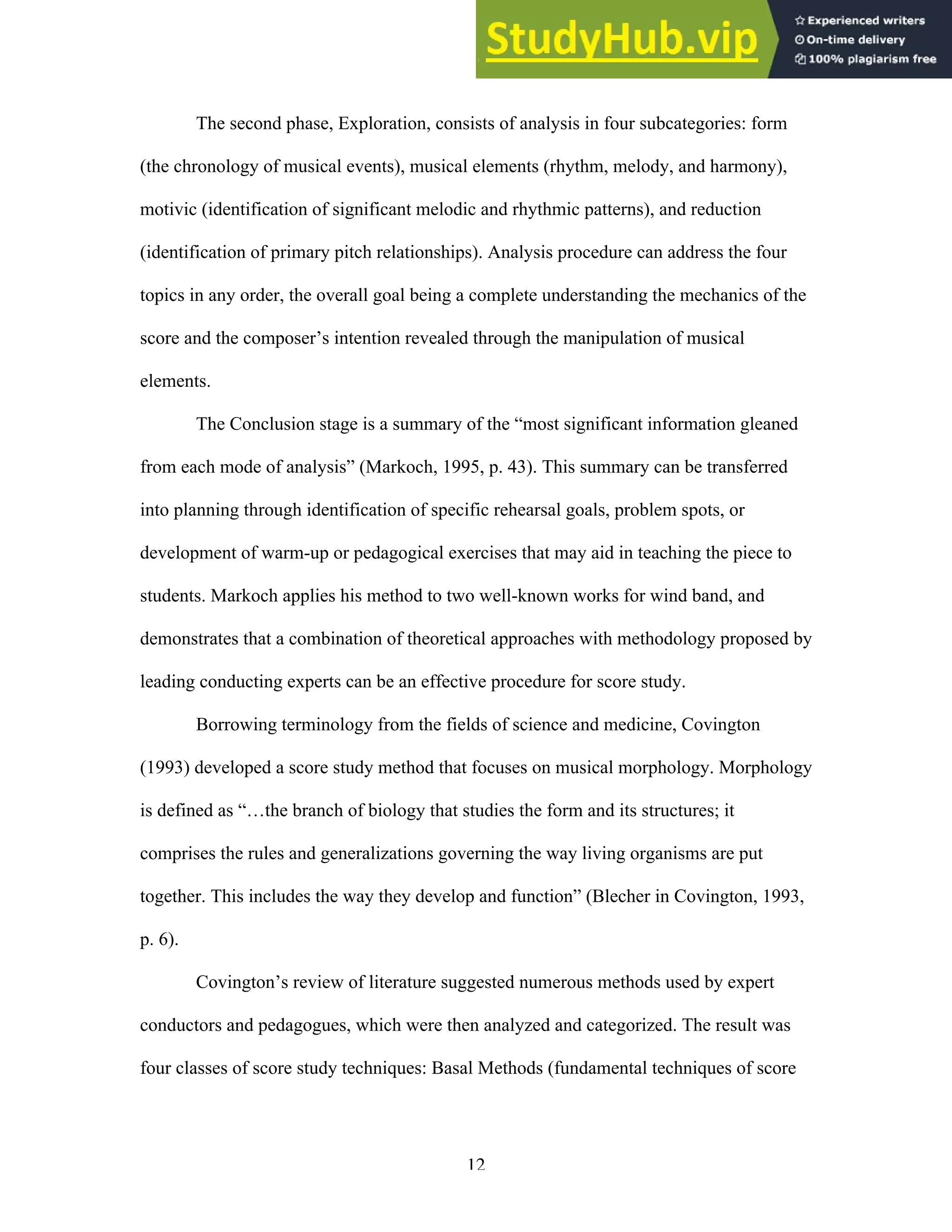
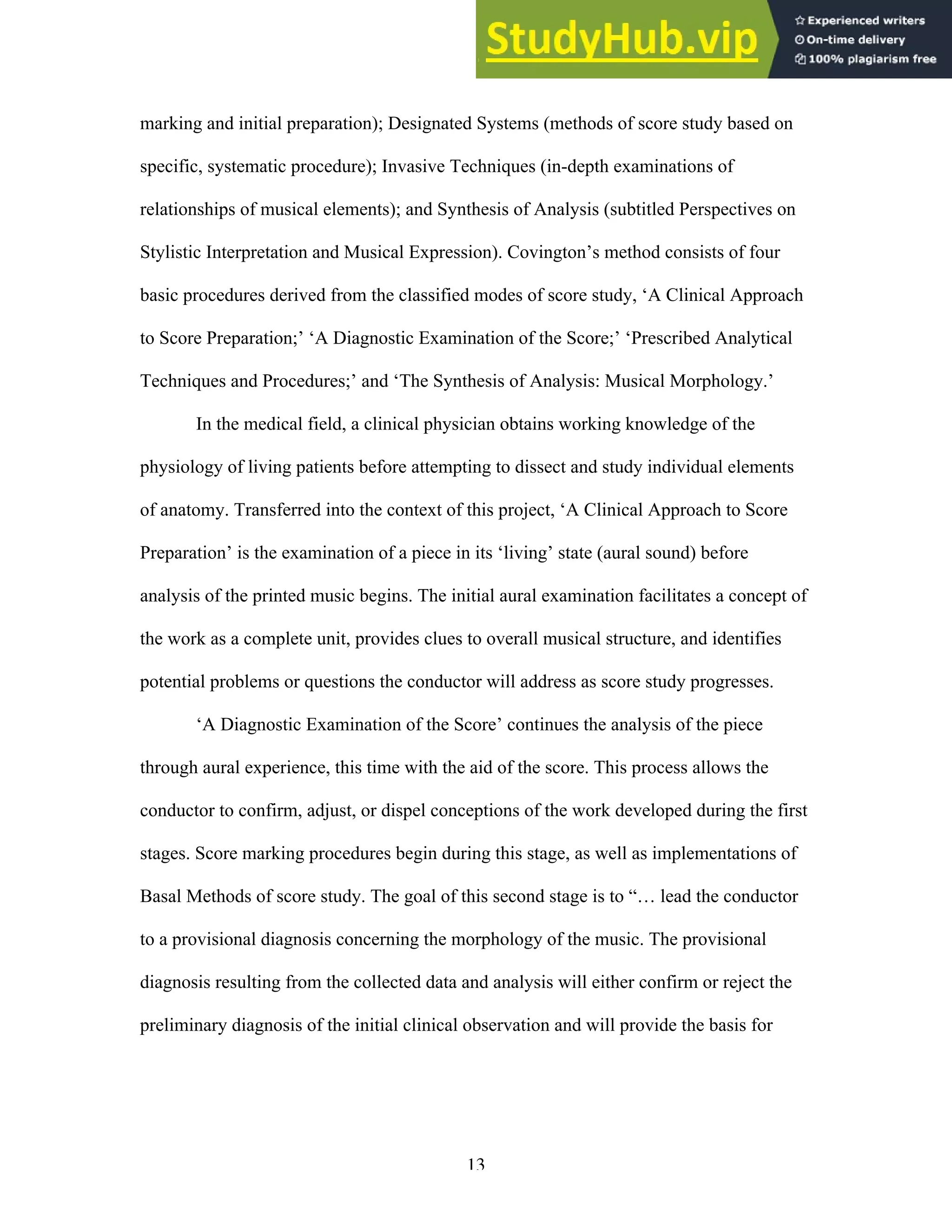
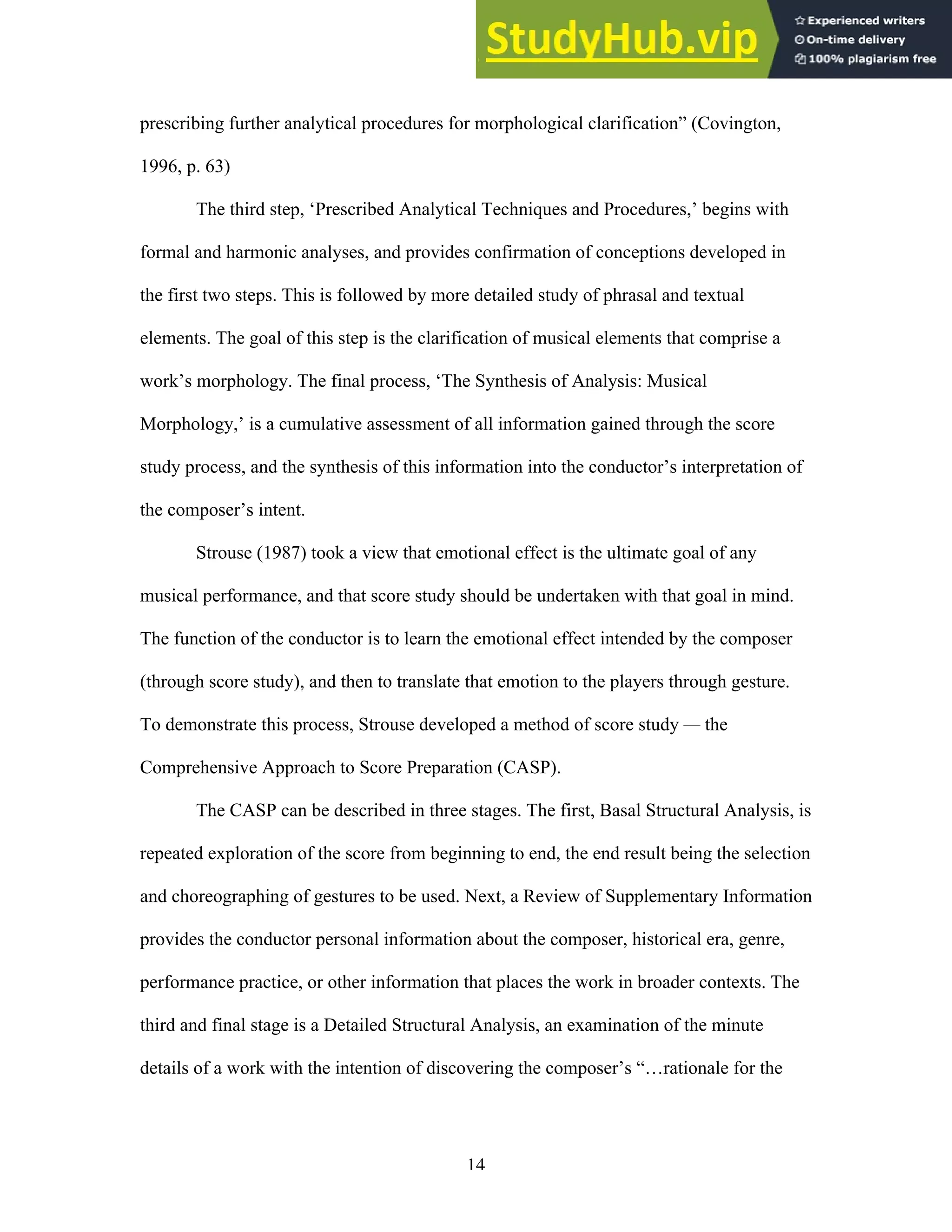
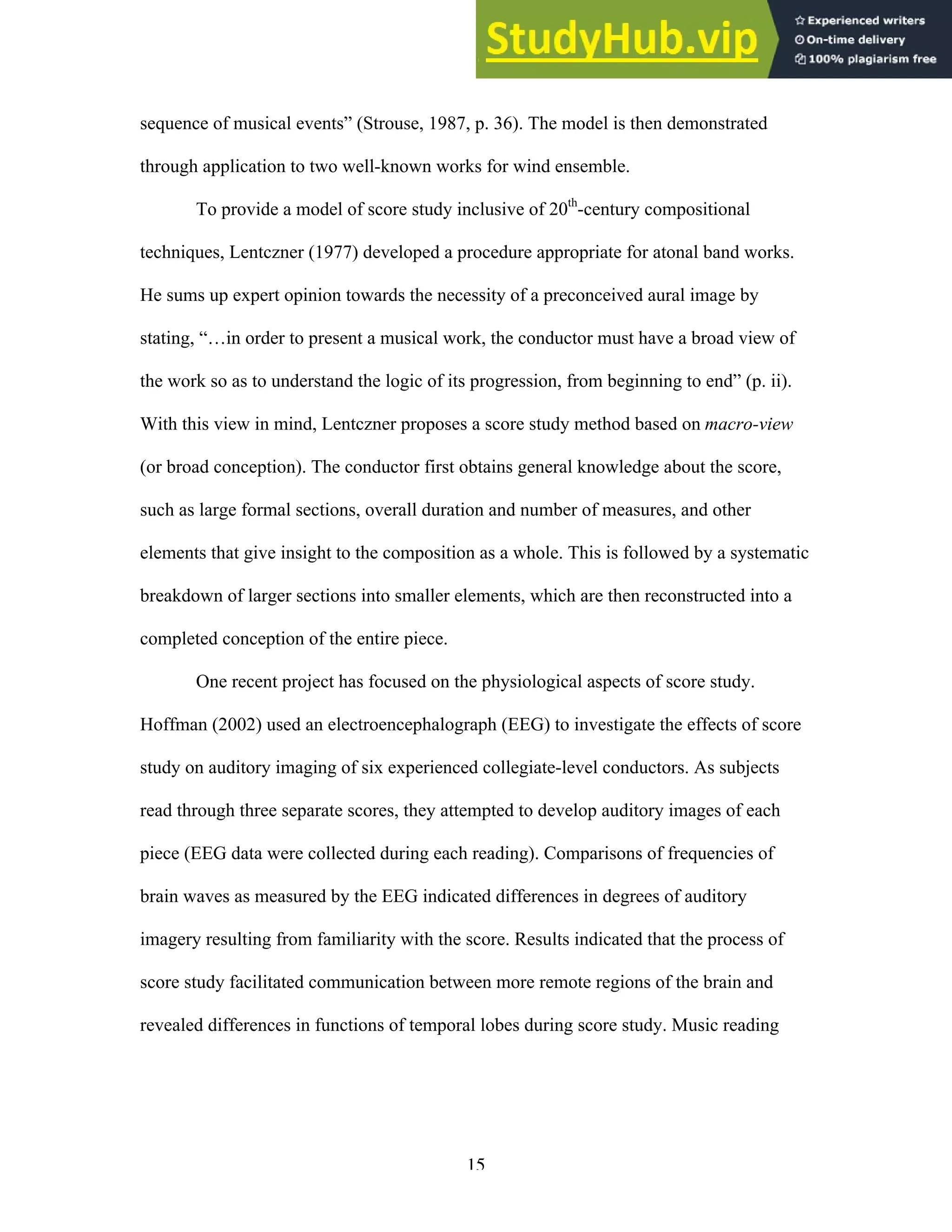
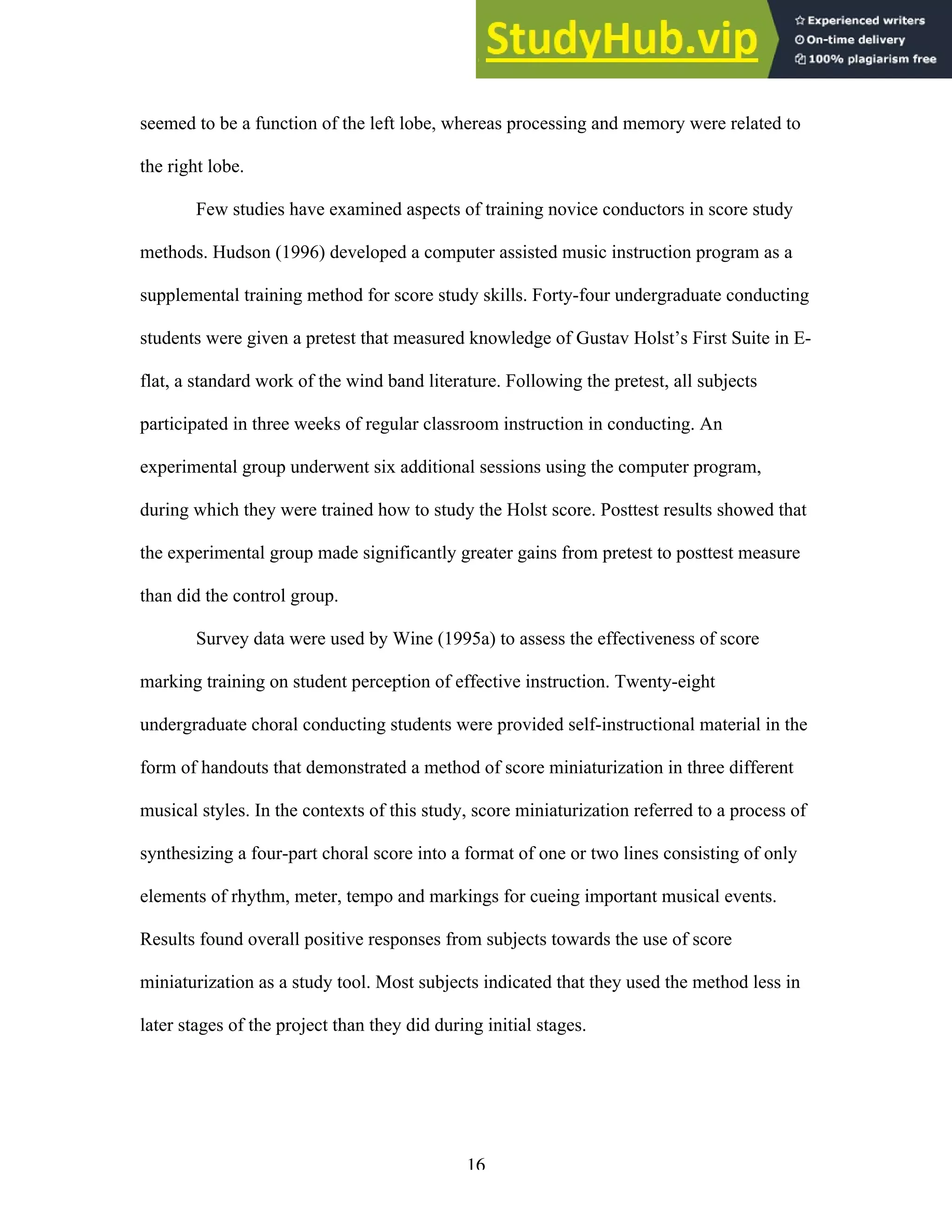
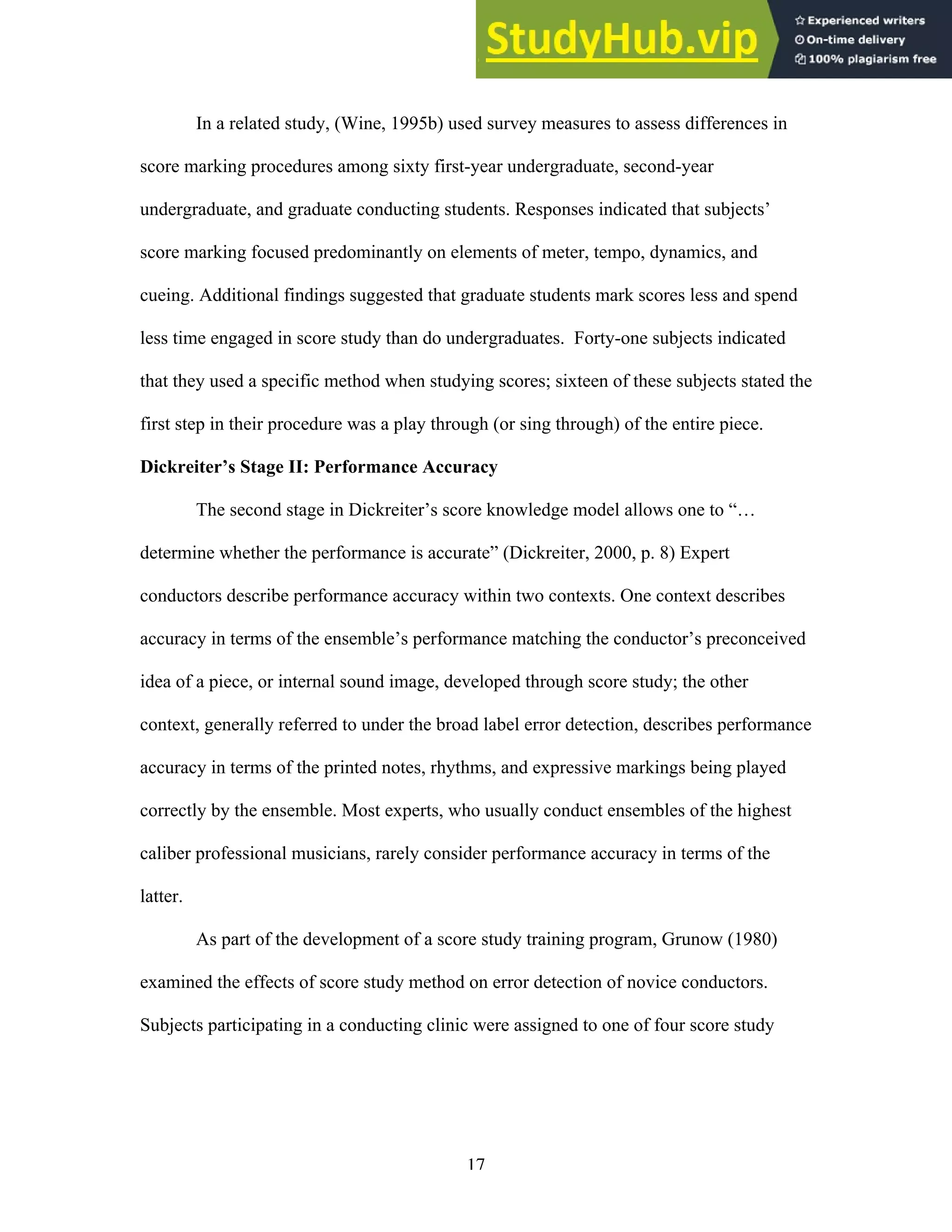

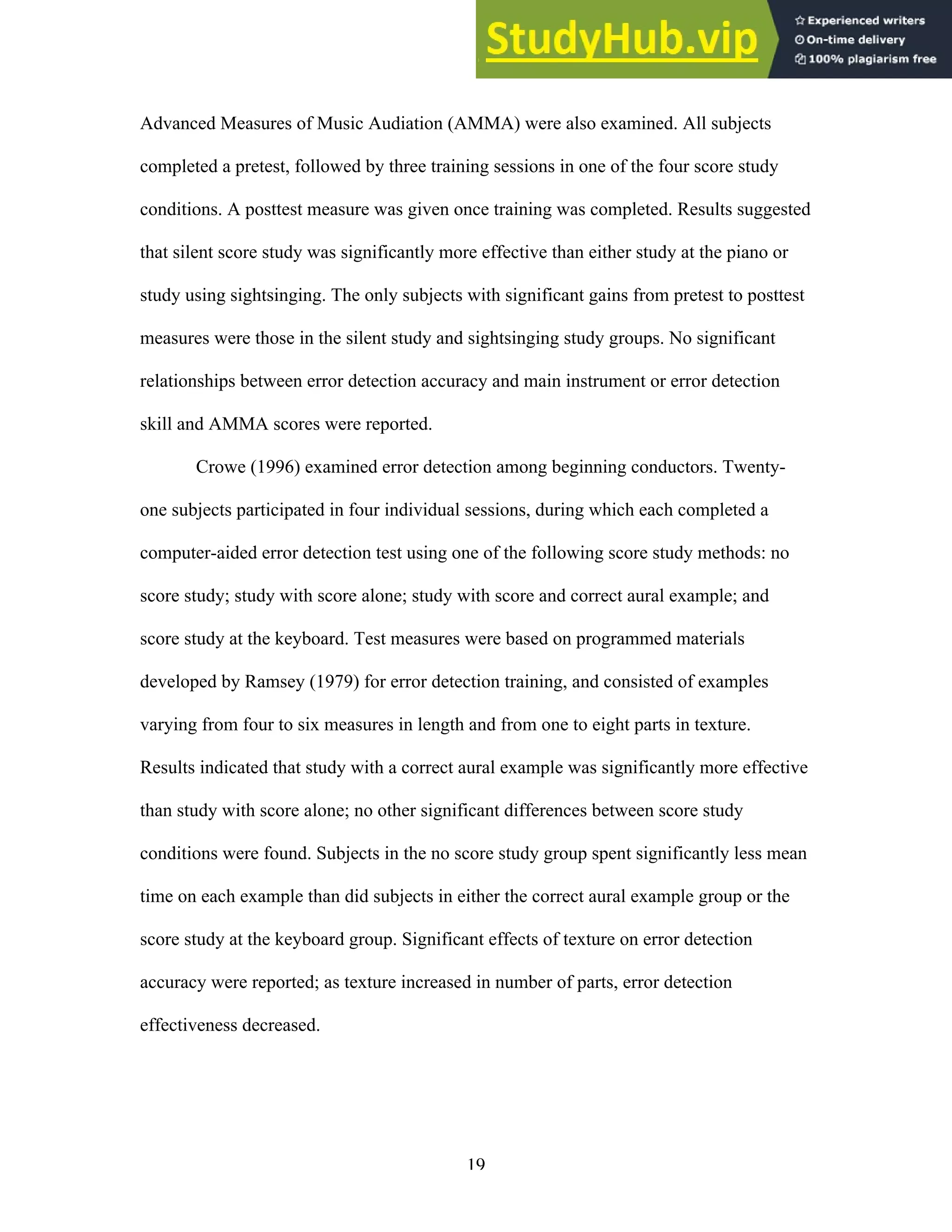
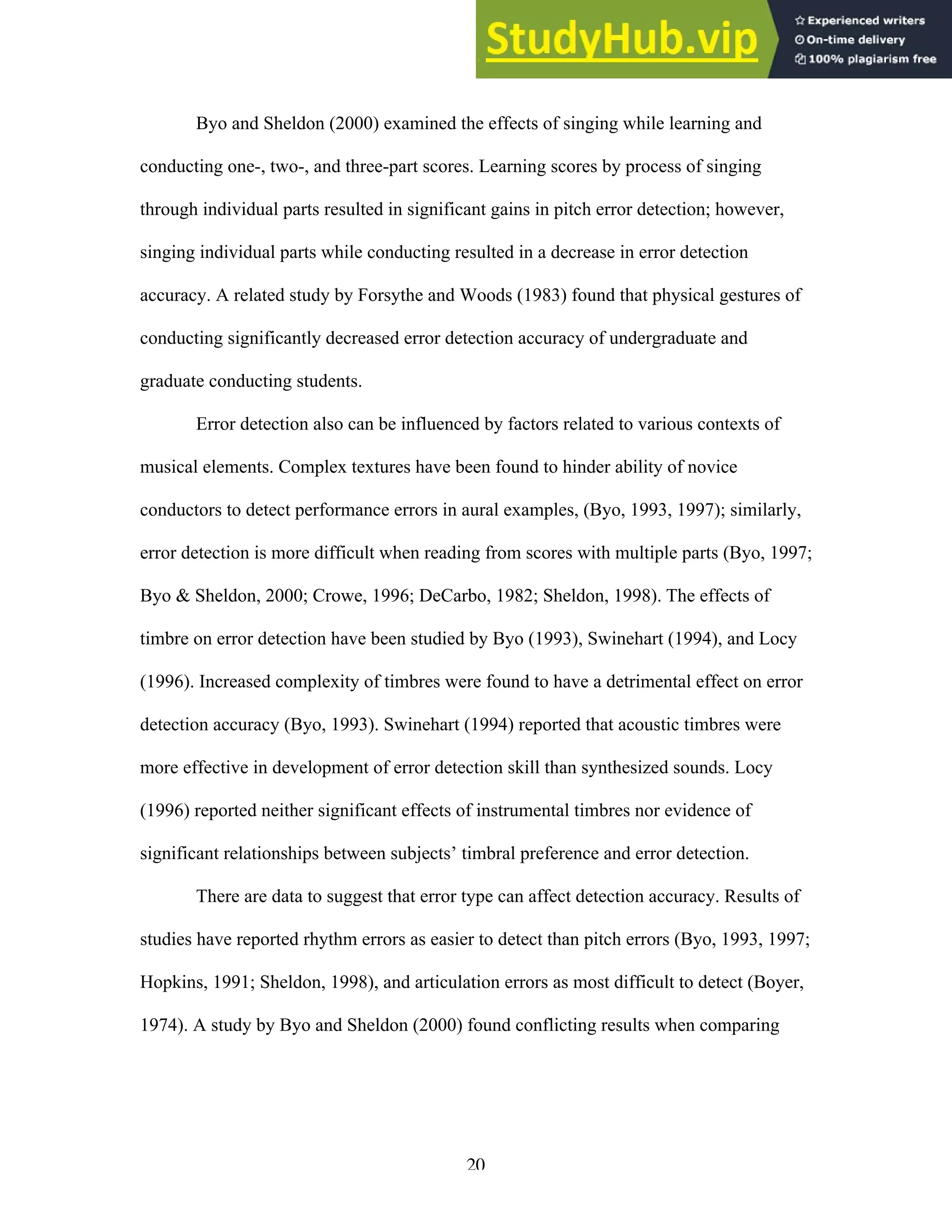


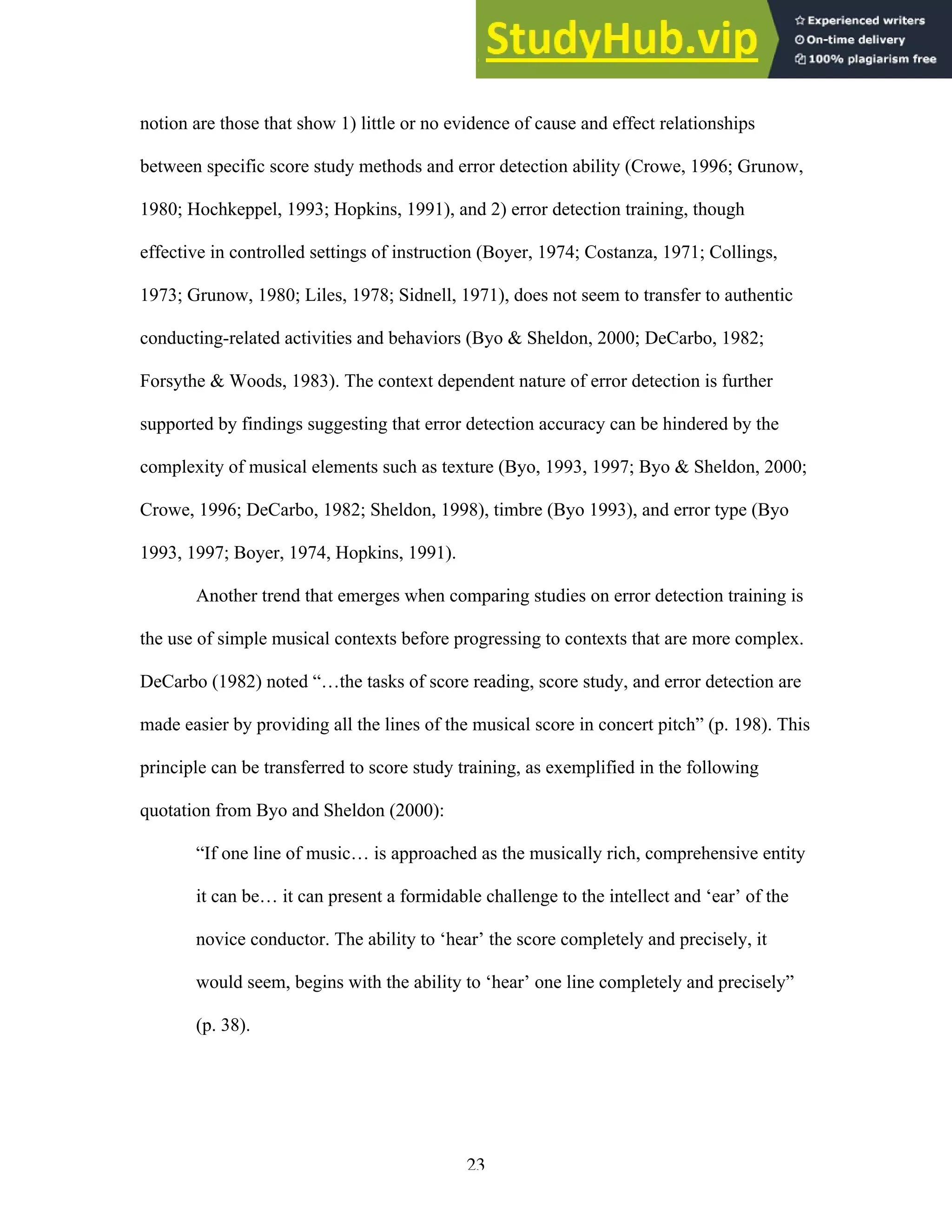
![24
Dickreiter’s Stage III: Rehearsal
Dickreiter’s third stage “… makes it possible to identify special places in [the
work], which is important in a rehearsal” (Dickreiter, 2000, p. 8) The process of rehearsal
is critical, for that is where an ensemble’s performance is shaped to conform to the
conductor’s internal sound image. In most cases, time is of primary concern; therefore it
is essential that conductors facilitate efficient, productive rehearsals. A large body of
research has been devoted to analysis of rehearsal behaviors relating to time use,
reinforcement, pacing, feedback, and other verbal behaviors (see reviews by Duke, 1999;
Grant & Drafall, 1991; Price & Byo, 2002).
Efficiency within the rehearsal can be greatly enhanced through effective use of
expressive conducting gestures and eye contact. A conductor translates their internal
sound image, or interpretation, of a work to their ensemble primarily through these
nonverbal means. A majority of experts assert that while the use of words during a
rehearsal is sometimes inevitable and indeed necessary, they prefer to use their gestures
to convey musical message. Score study is essential to this process. Gunther Schuller
(1997) wrote:
A simple definition of the art of conducting could be that it involves
eliciting from the orchestra with the most appropriate minimum of conductorial
(if you will, choreographic) gestures a maximum of accurate acoustical results.
But in order to know what those ‘most appropriate’ gestures and ‘accurate
acoustical results’ might be, one must have a precise and deep knowledge of the
score…. [We develop] our physical, manual, gestural skills… to their highest](https://image.slidesharecdn.com/abasicinterpretiveanalysis-230806181021-8e7fdd33/75/A-Basic-Interpretive-Analysis-34-2048.jpg)
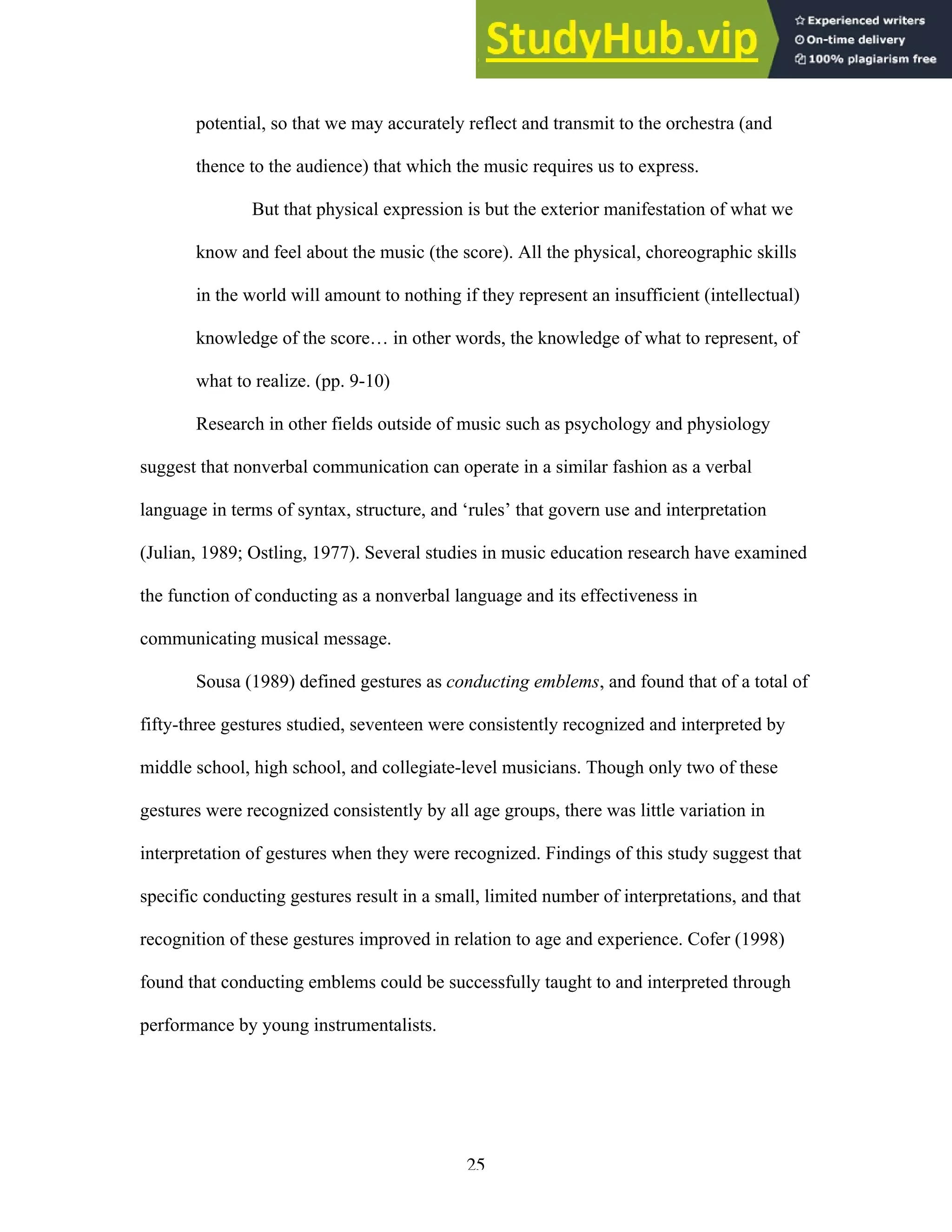

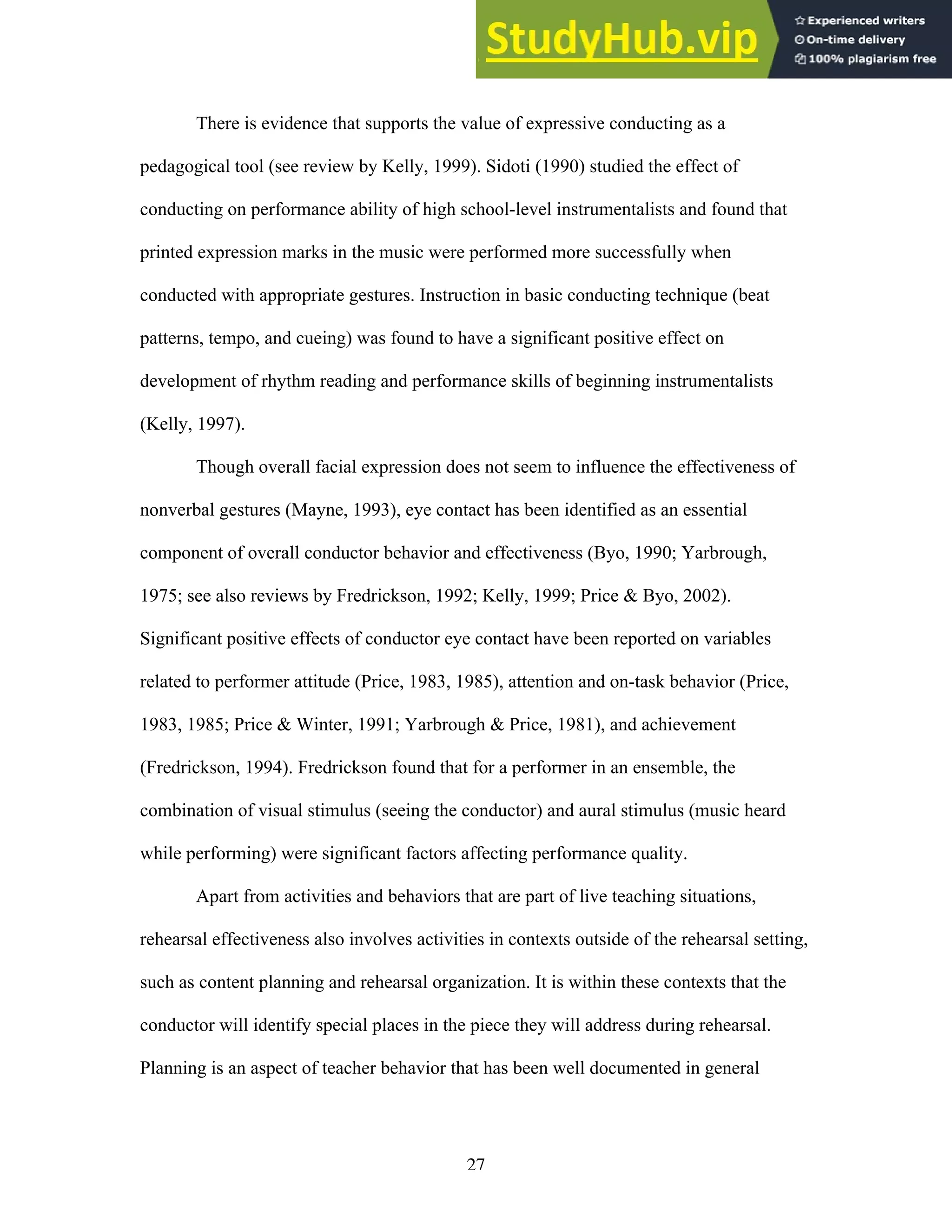
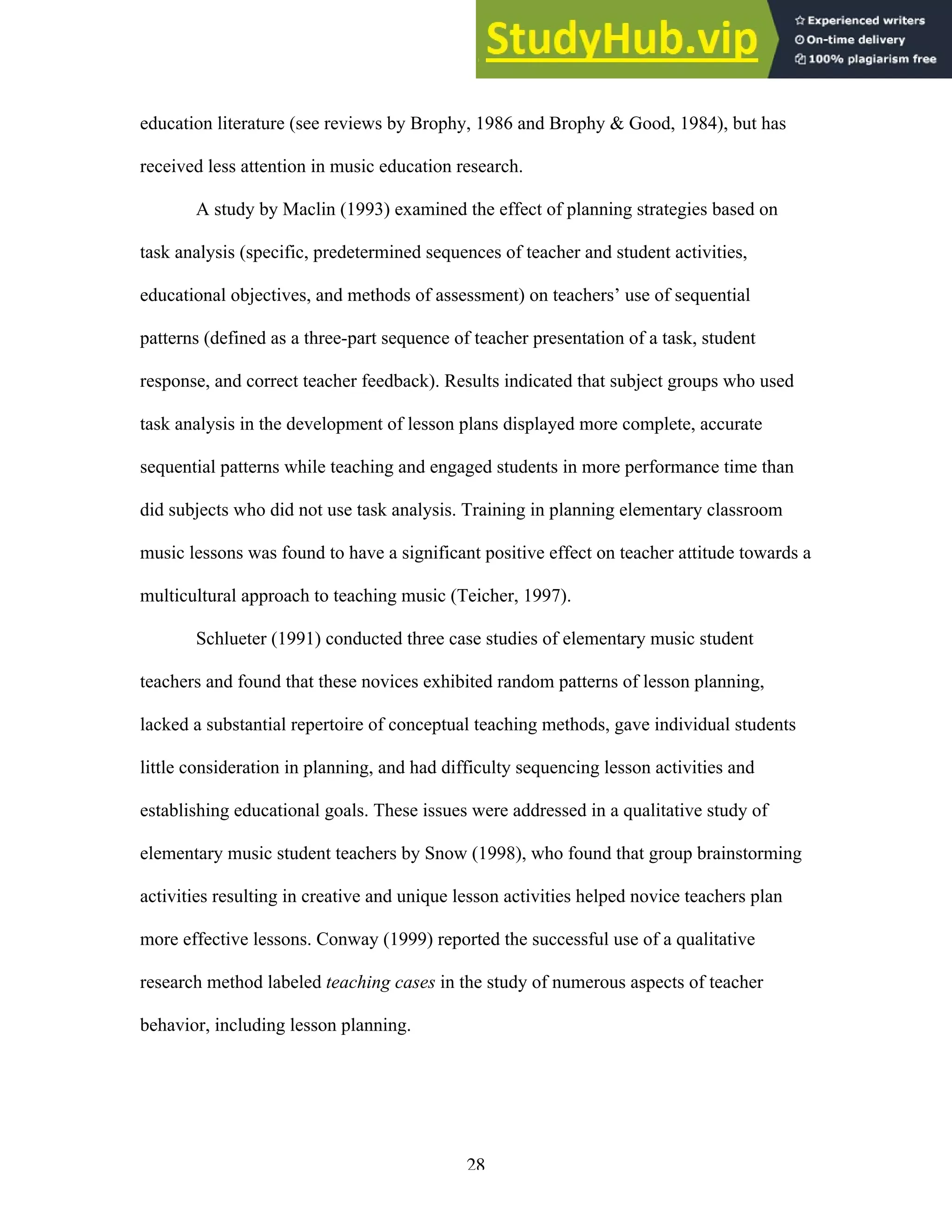
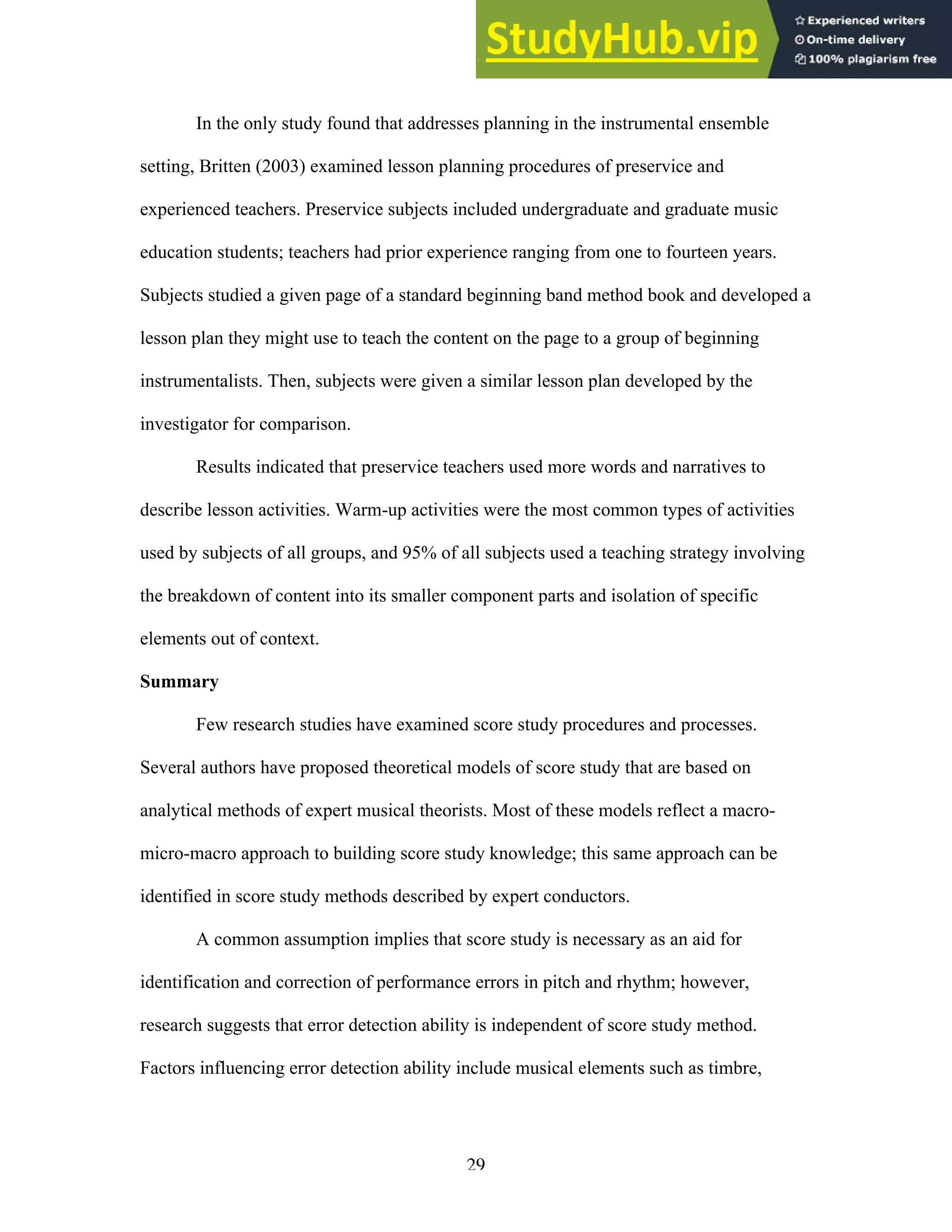
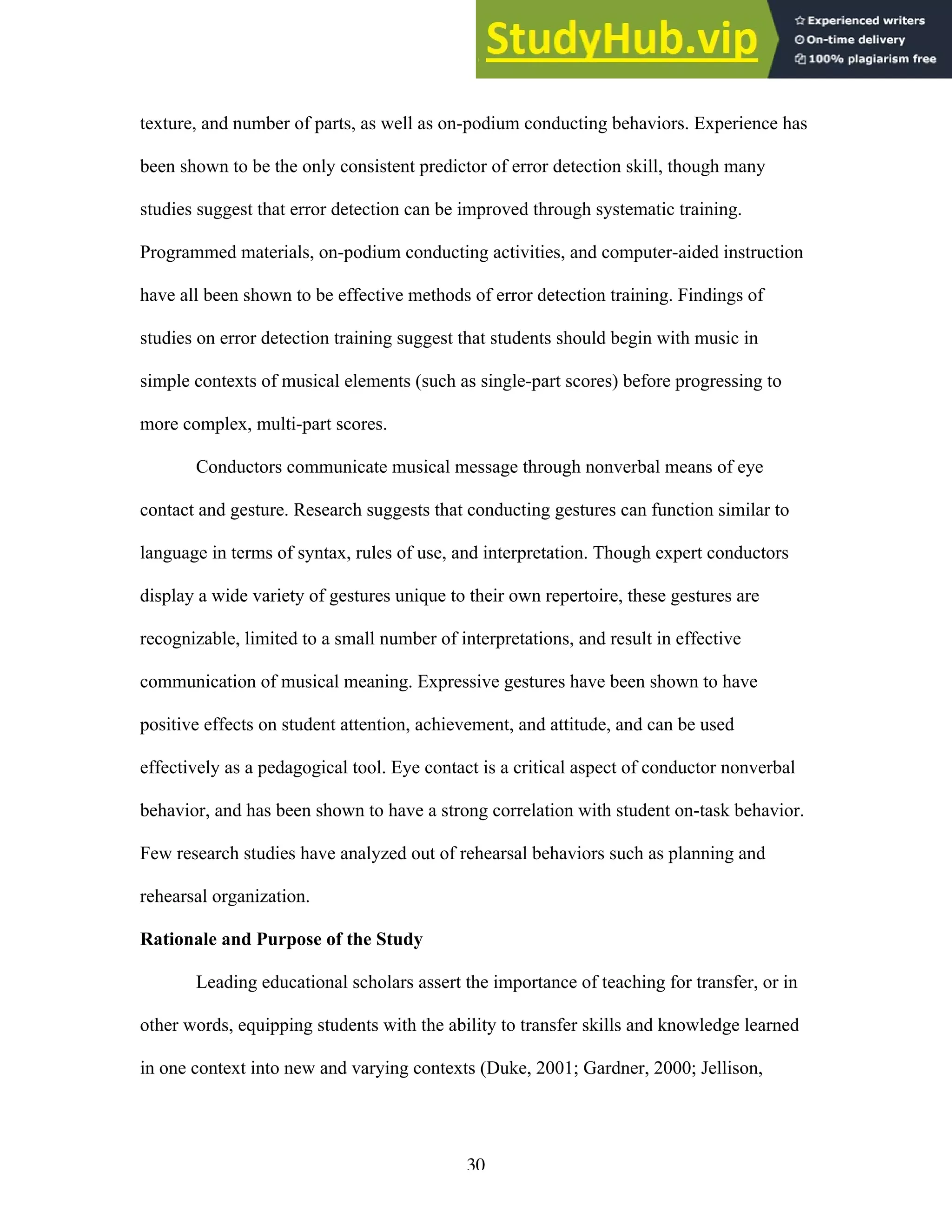
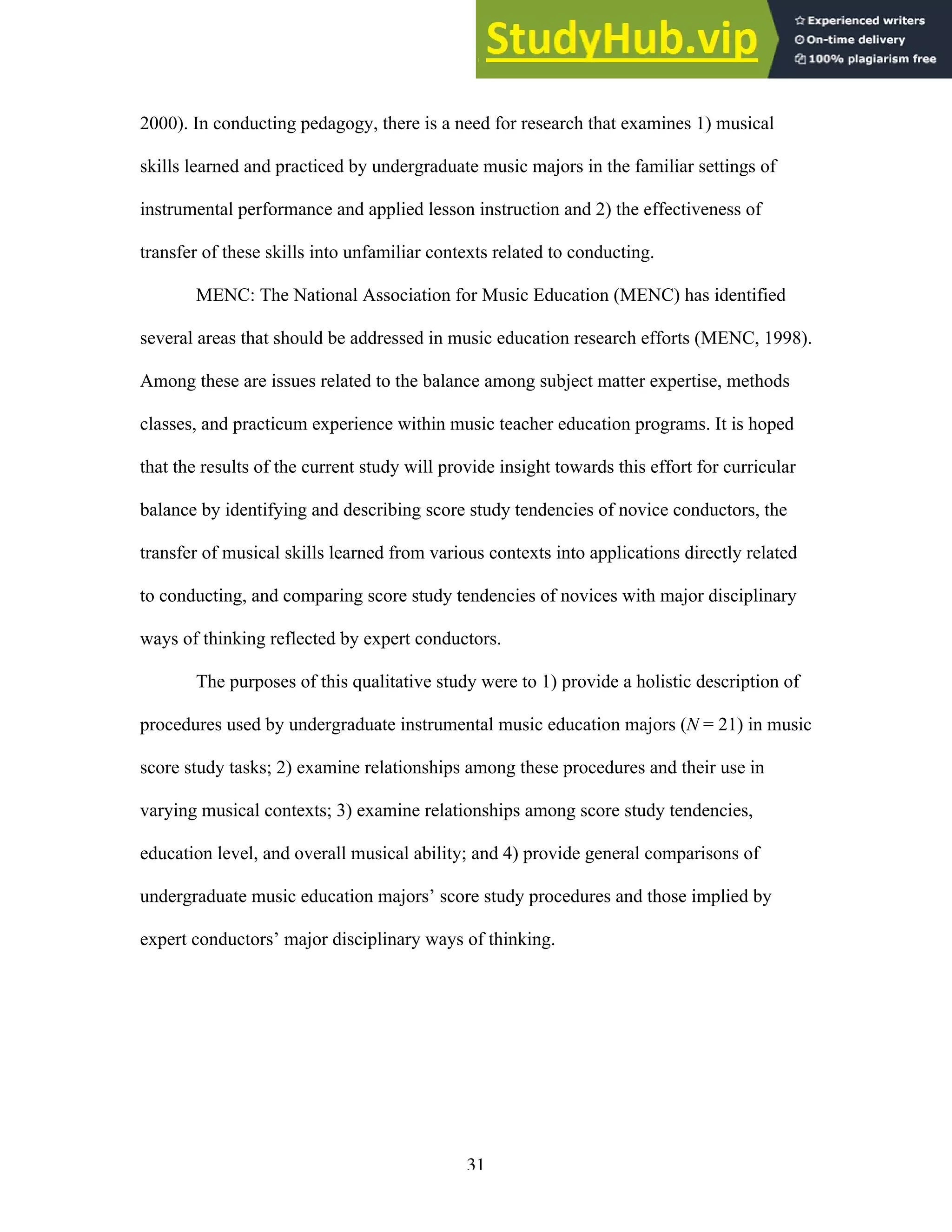
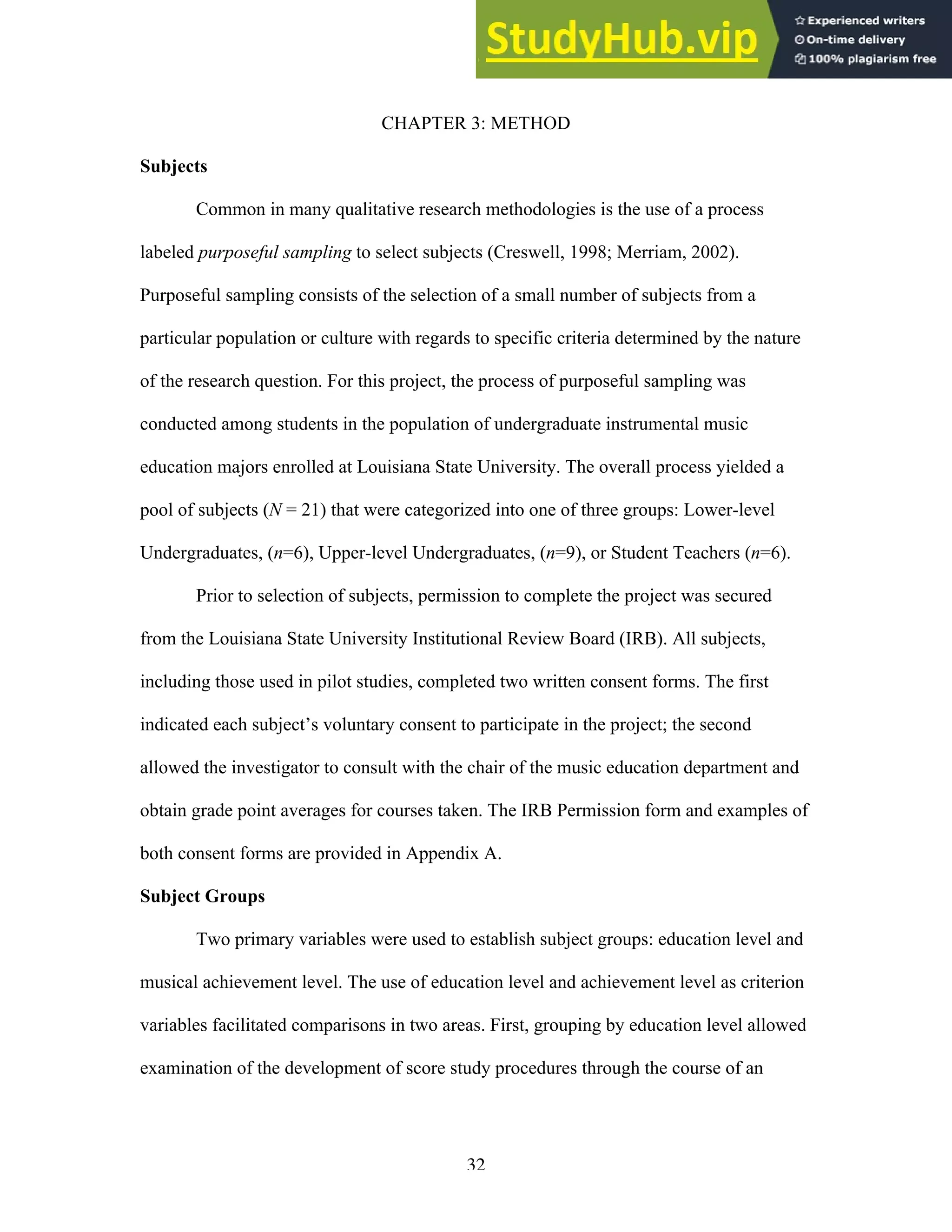
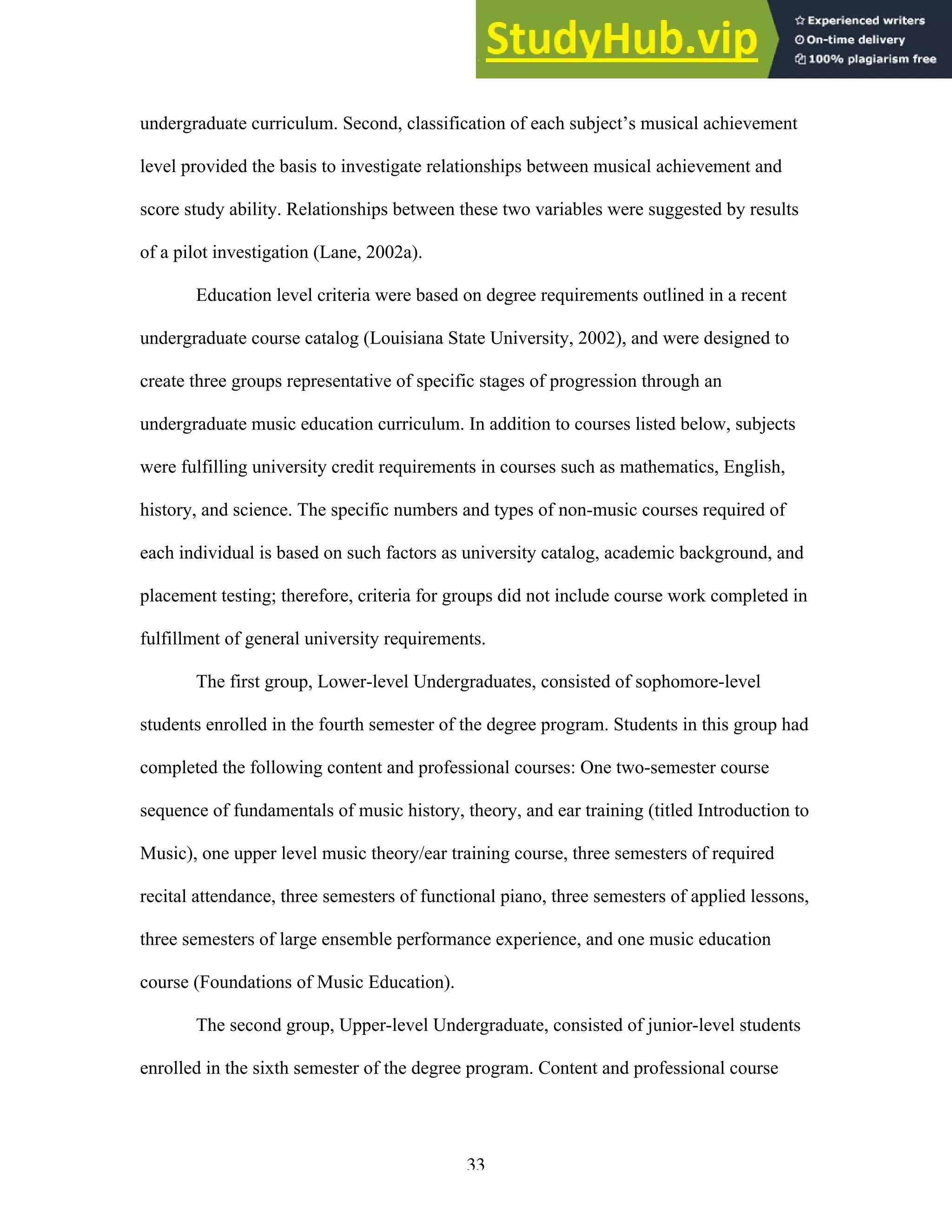
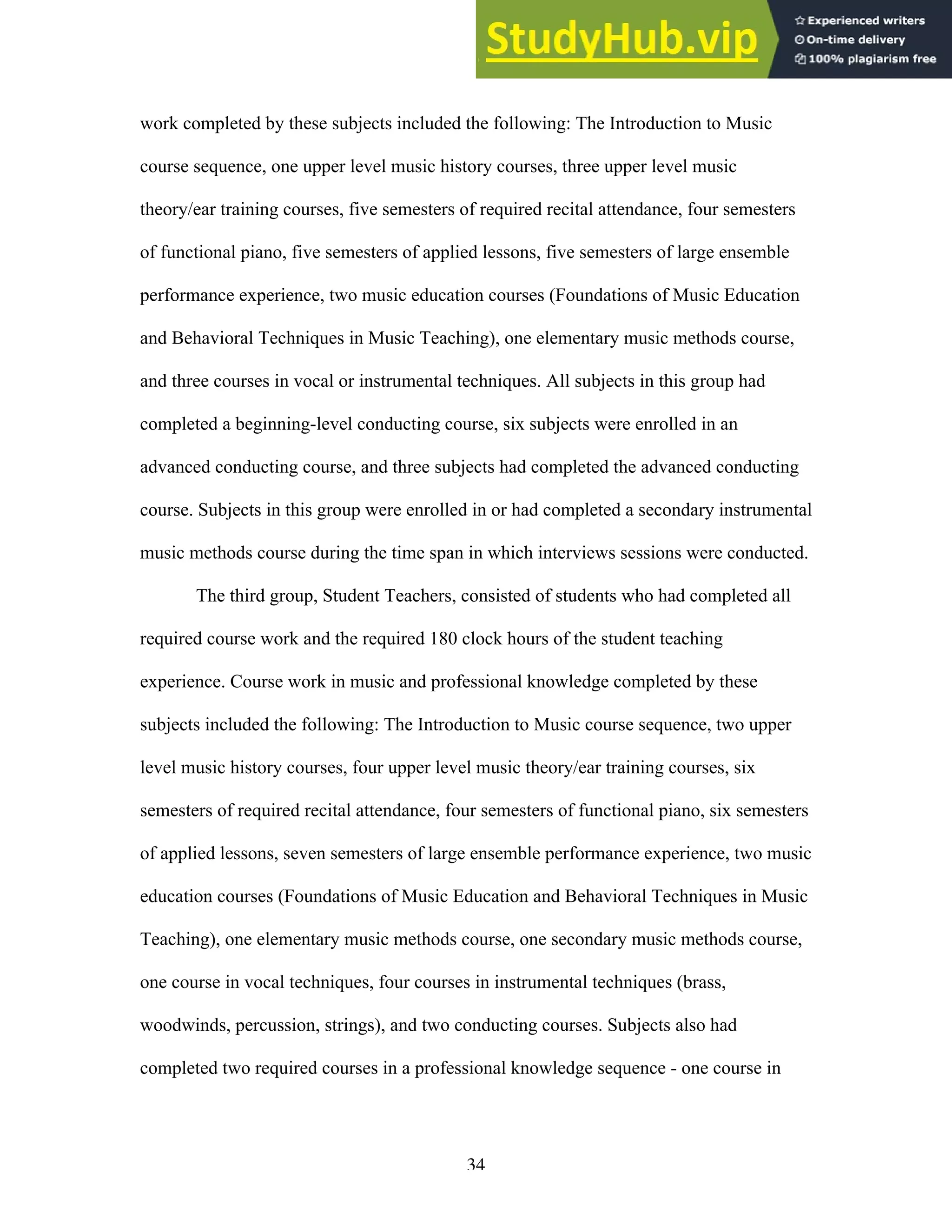
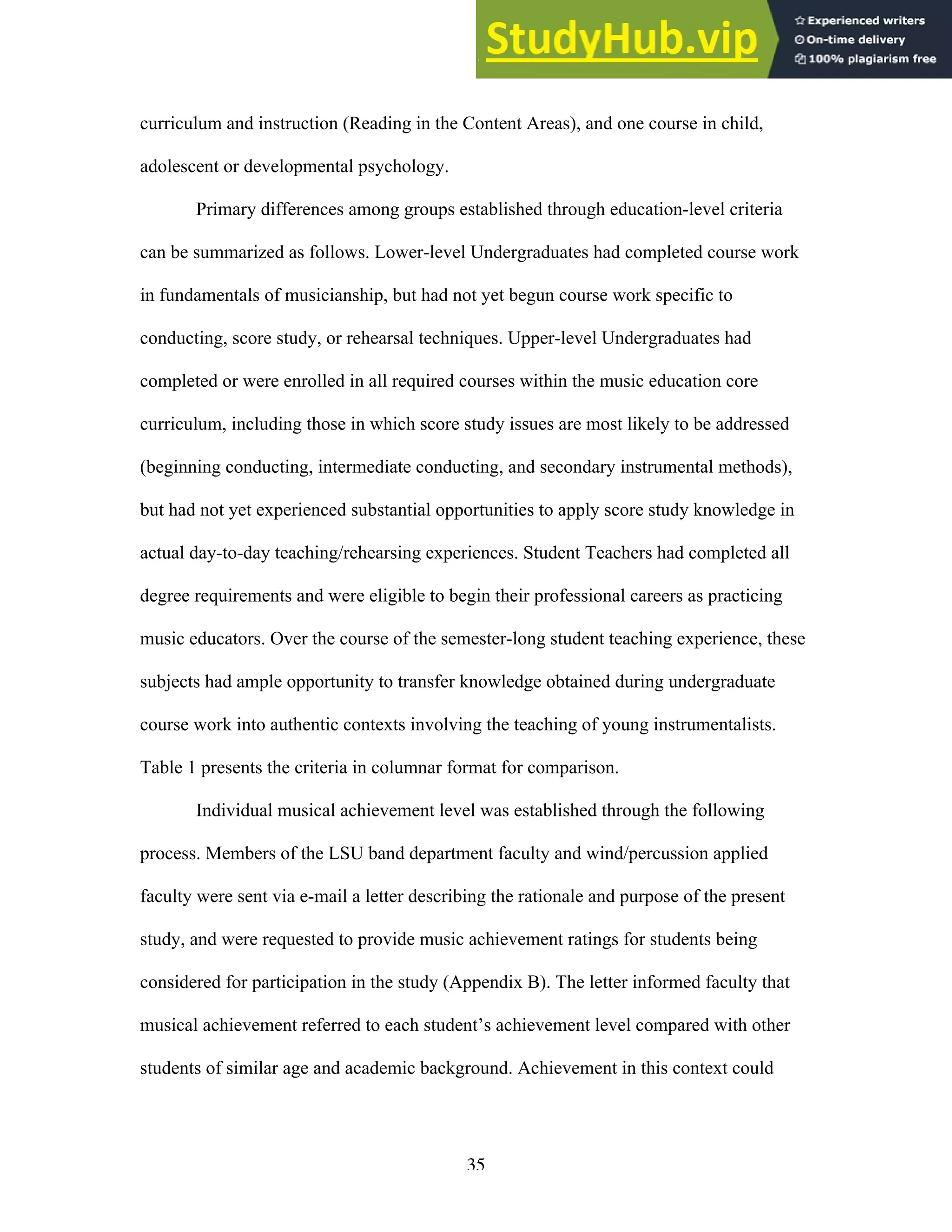
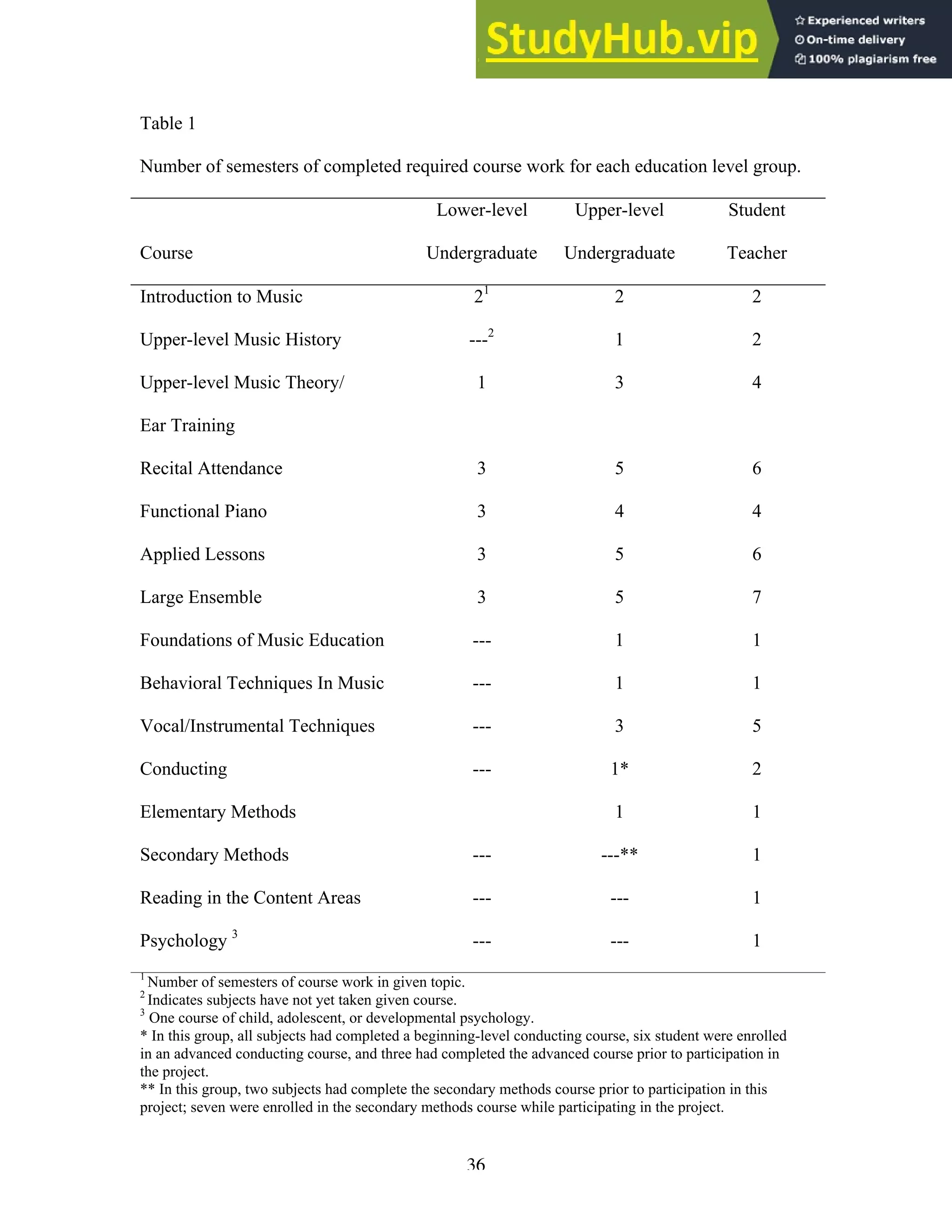
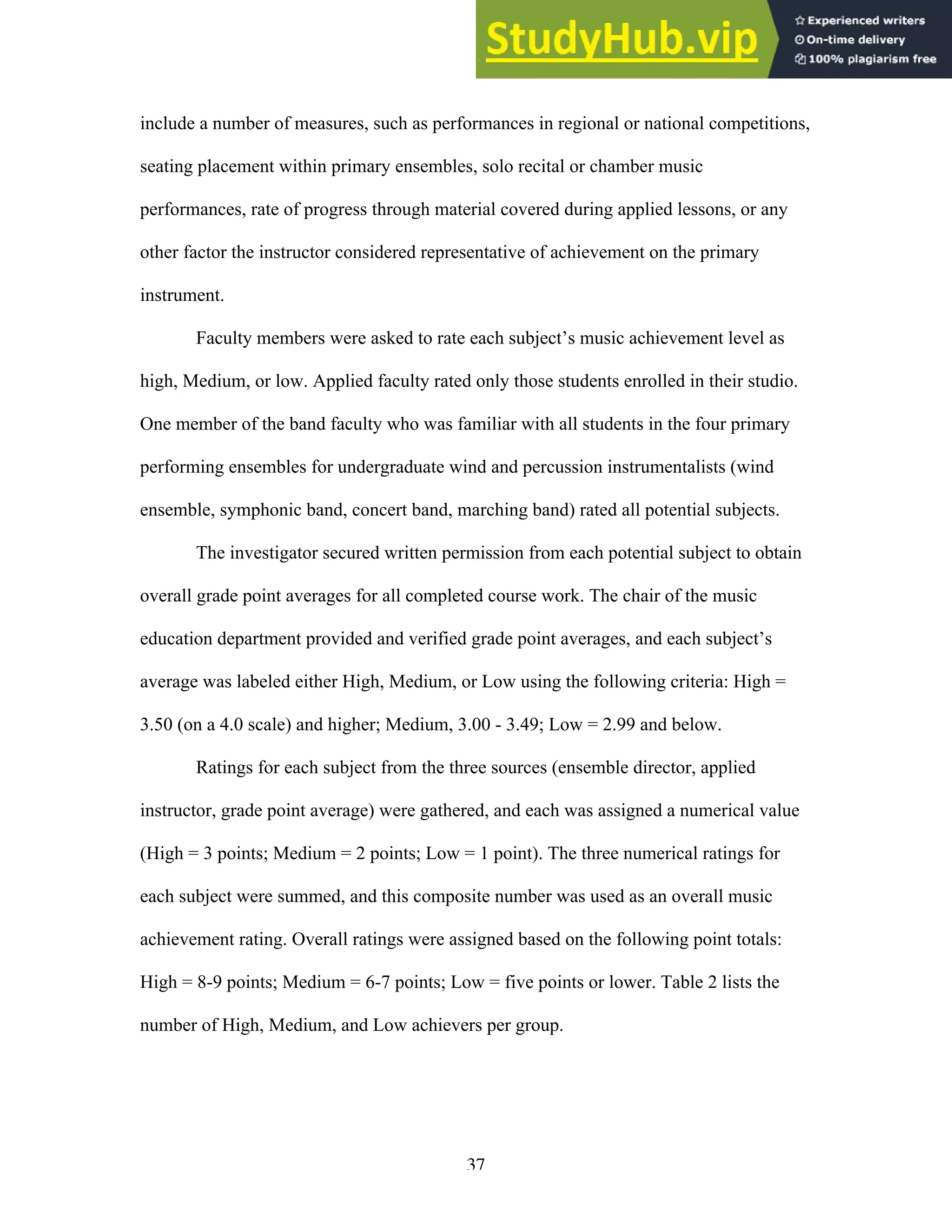


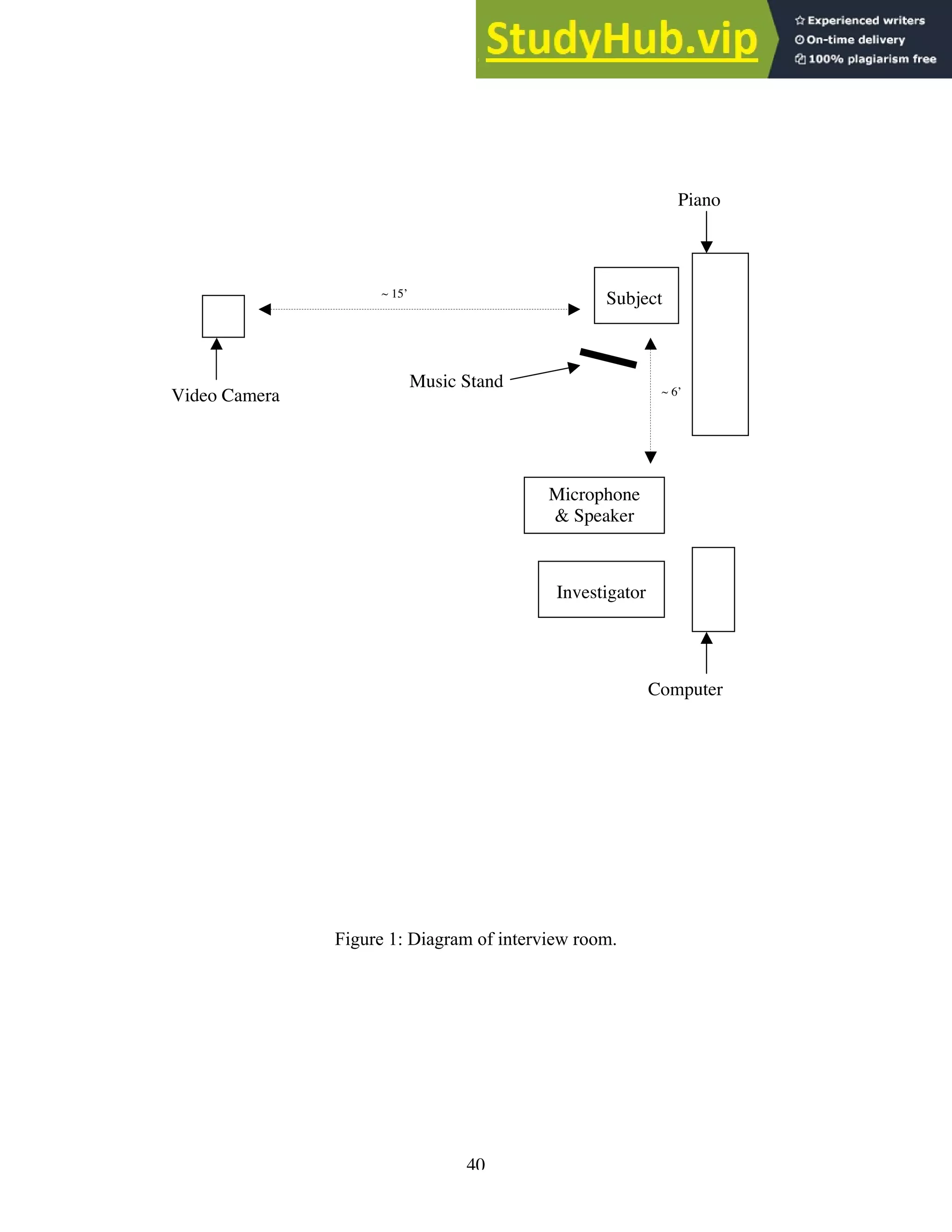
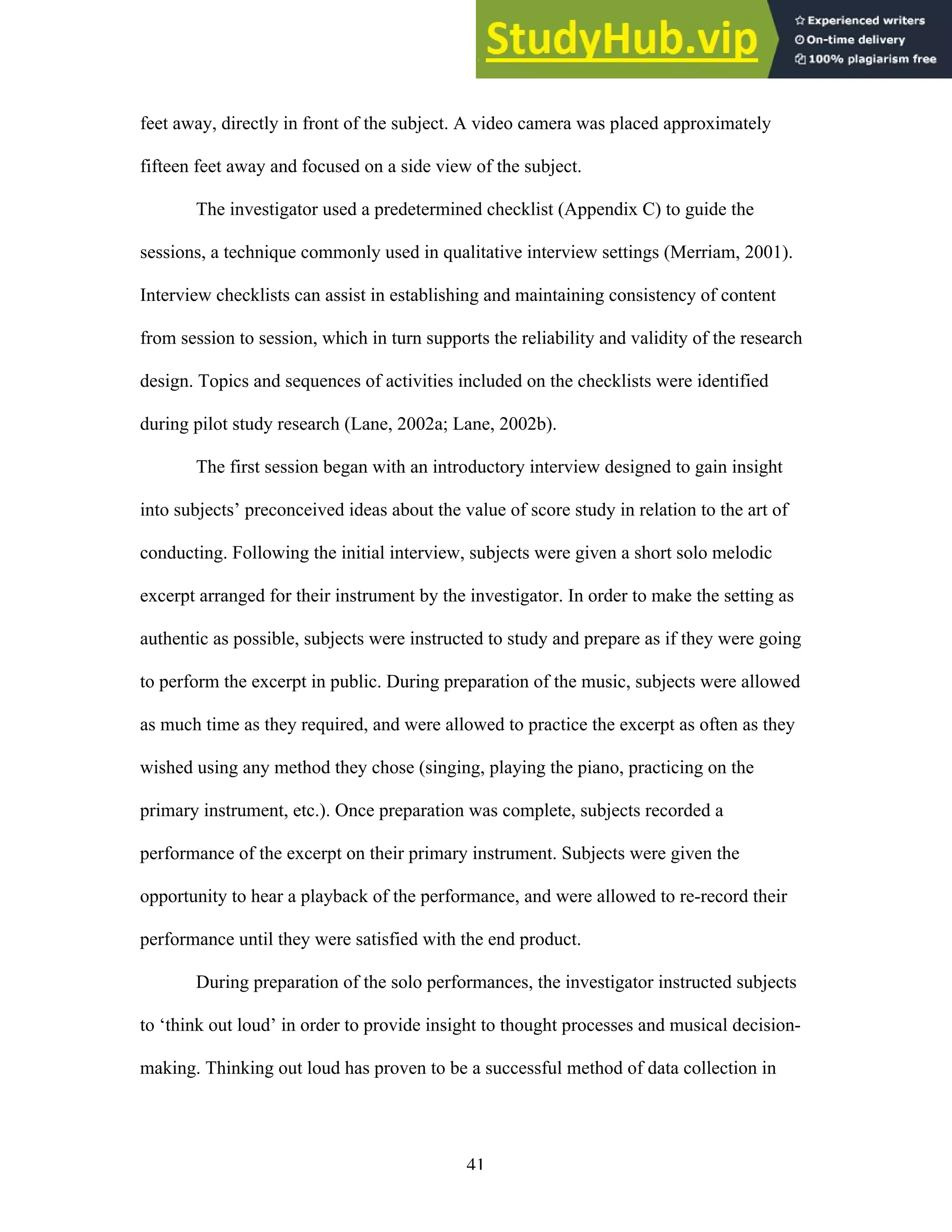
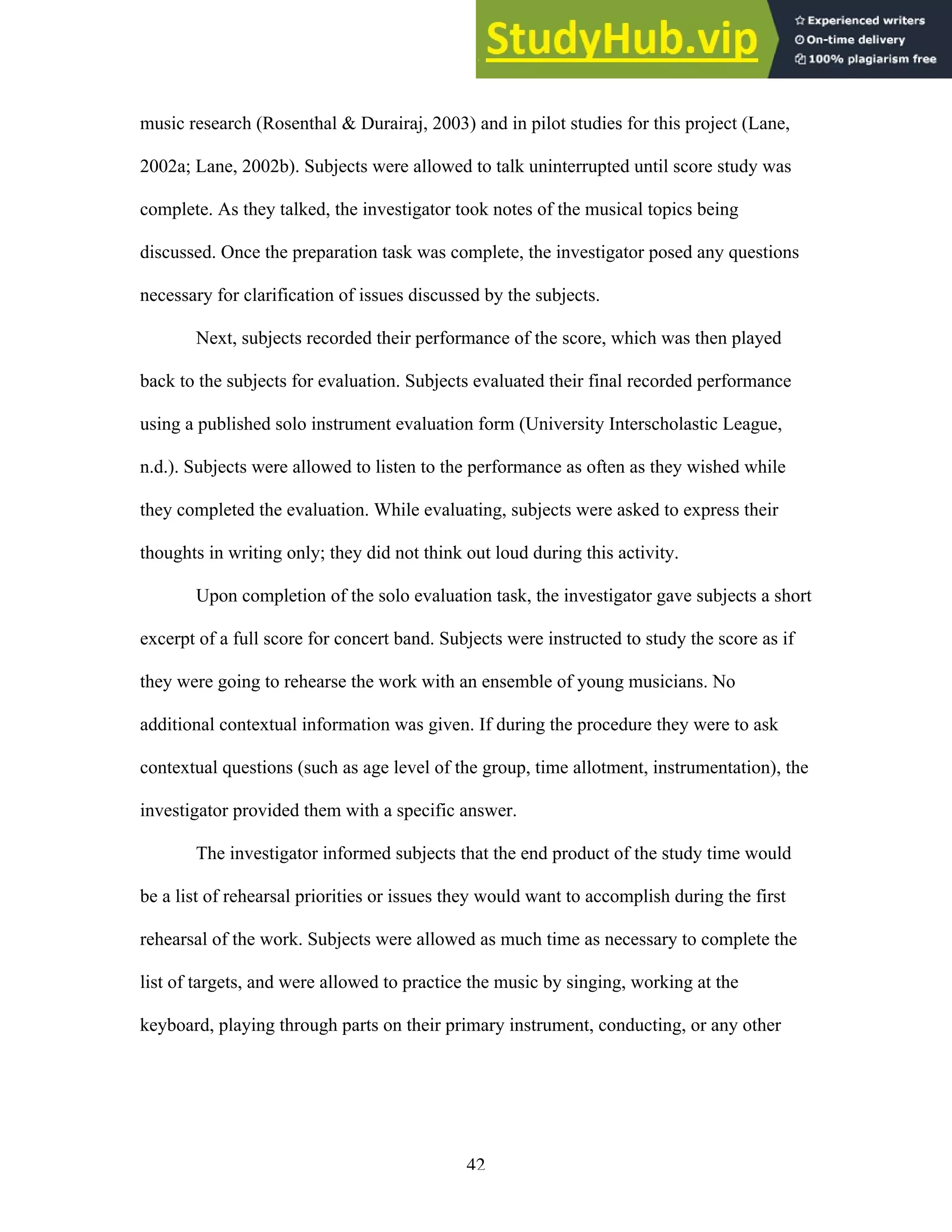


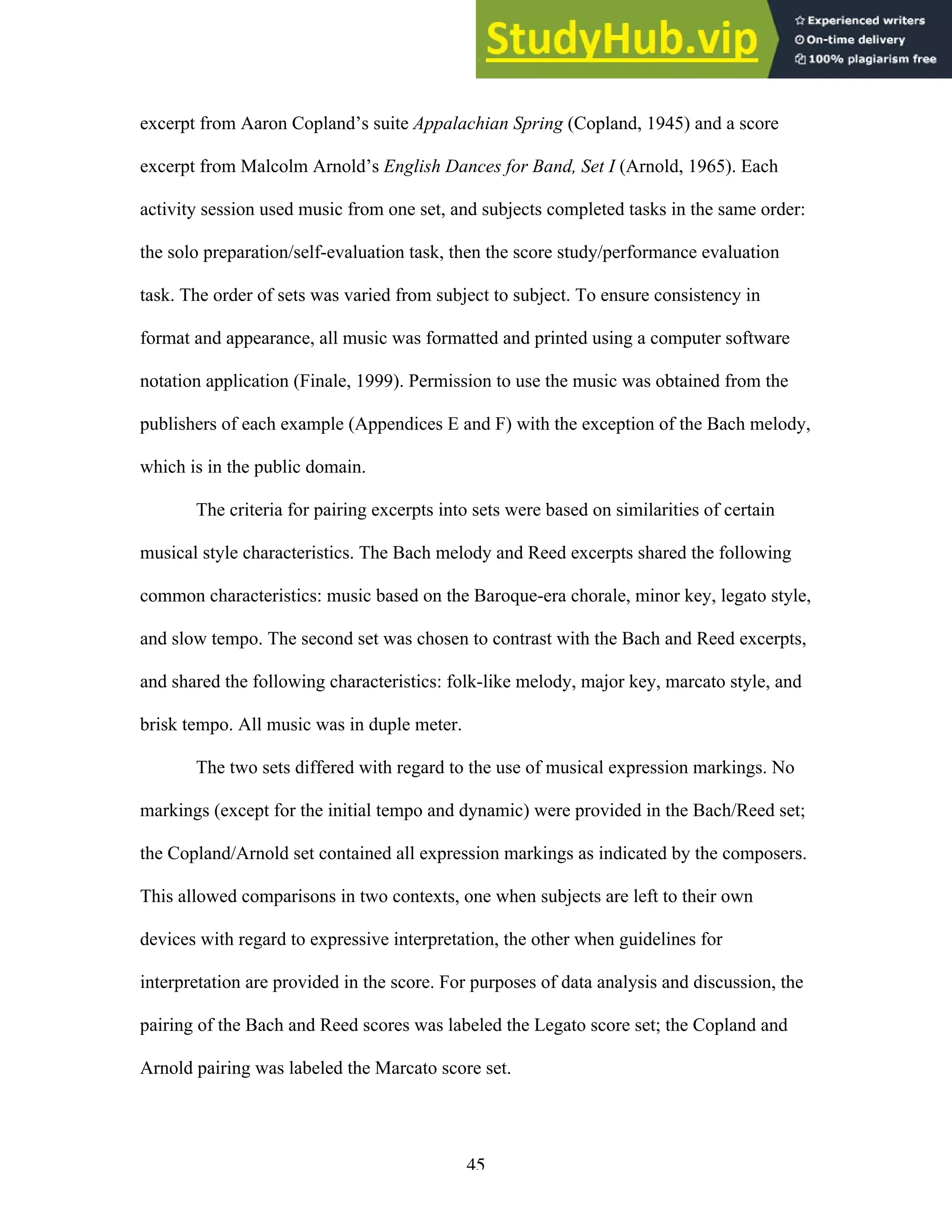
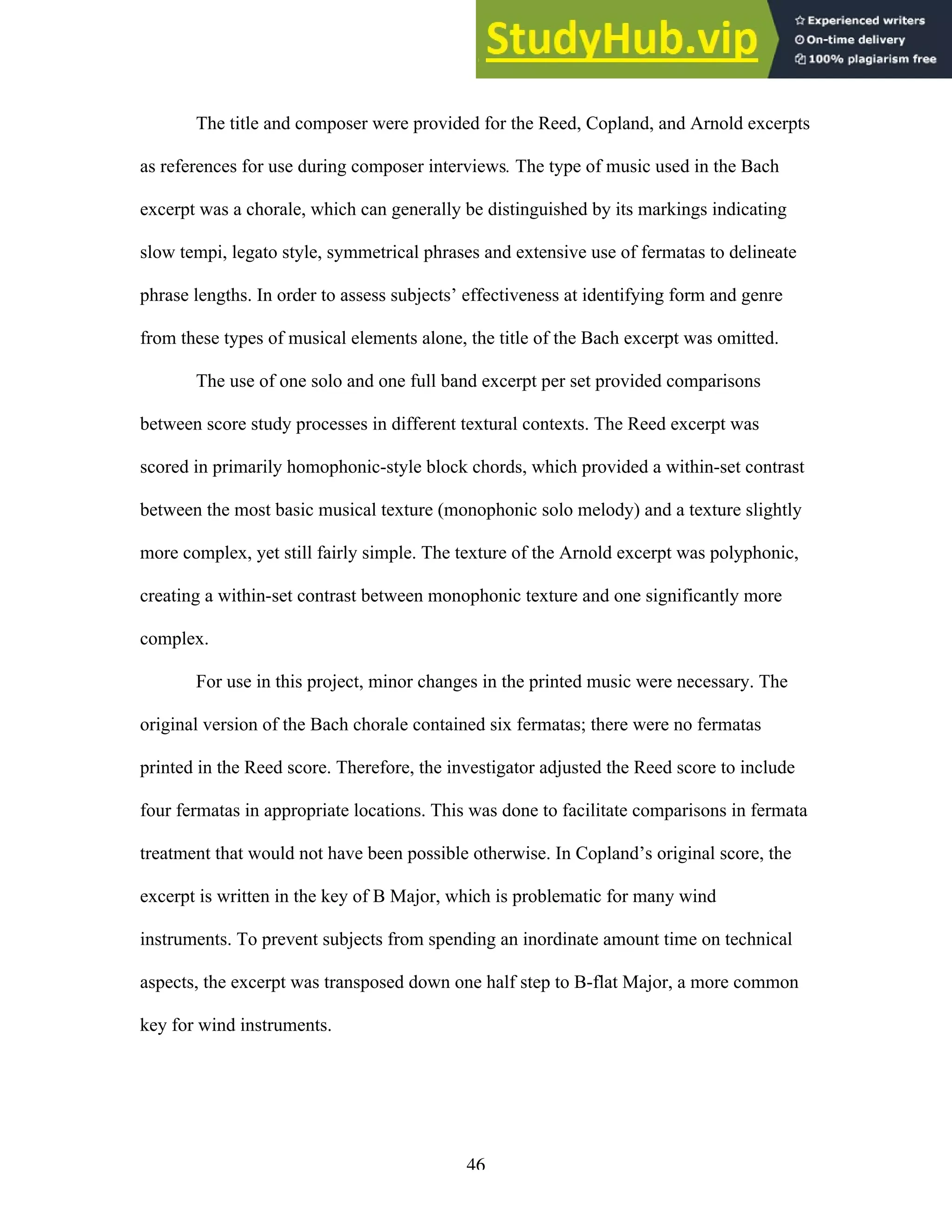
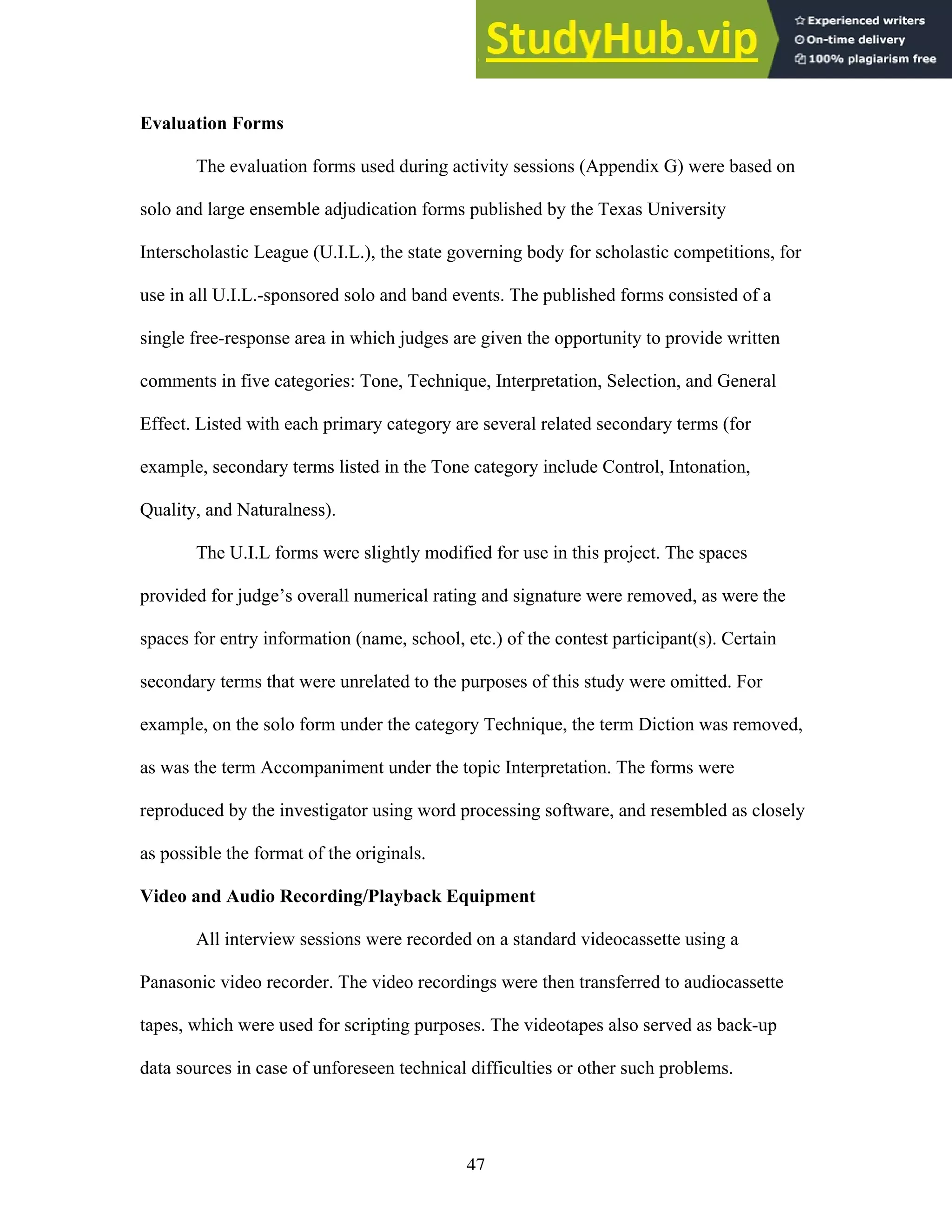
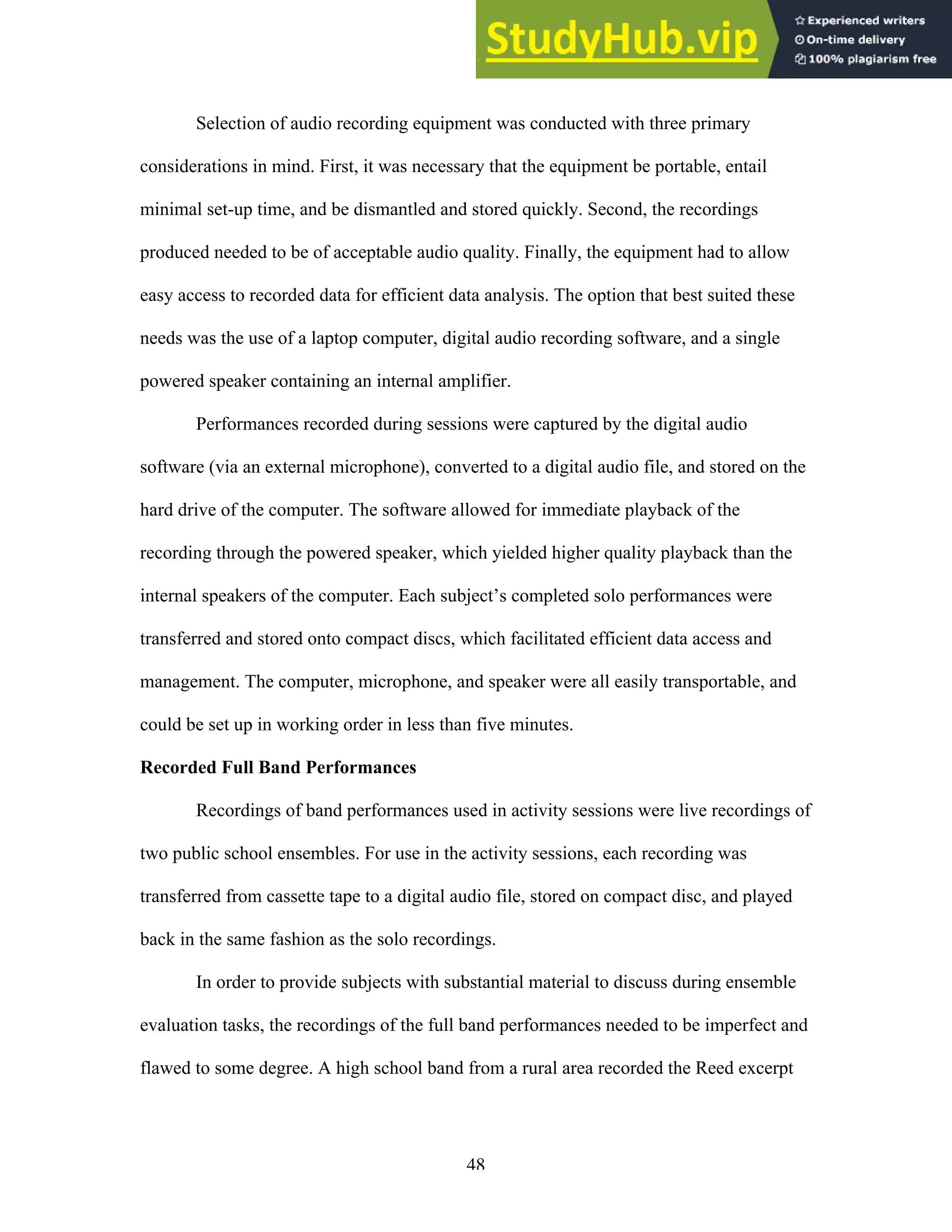
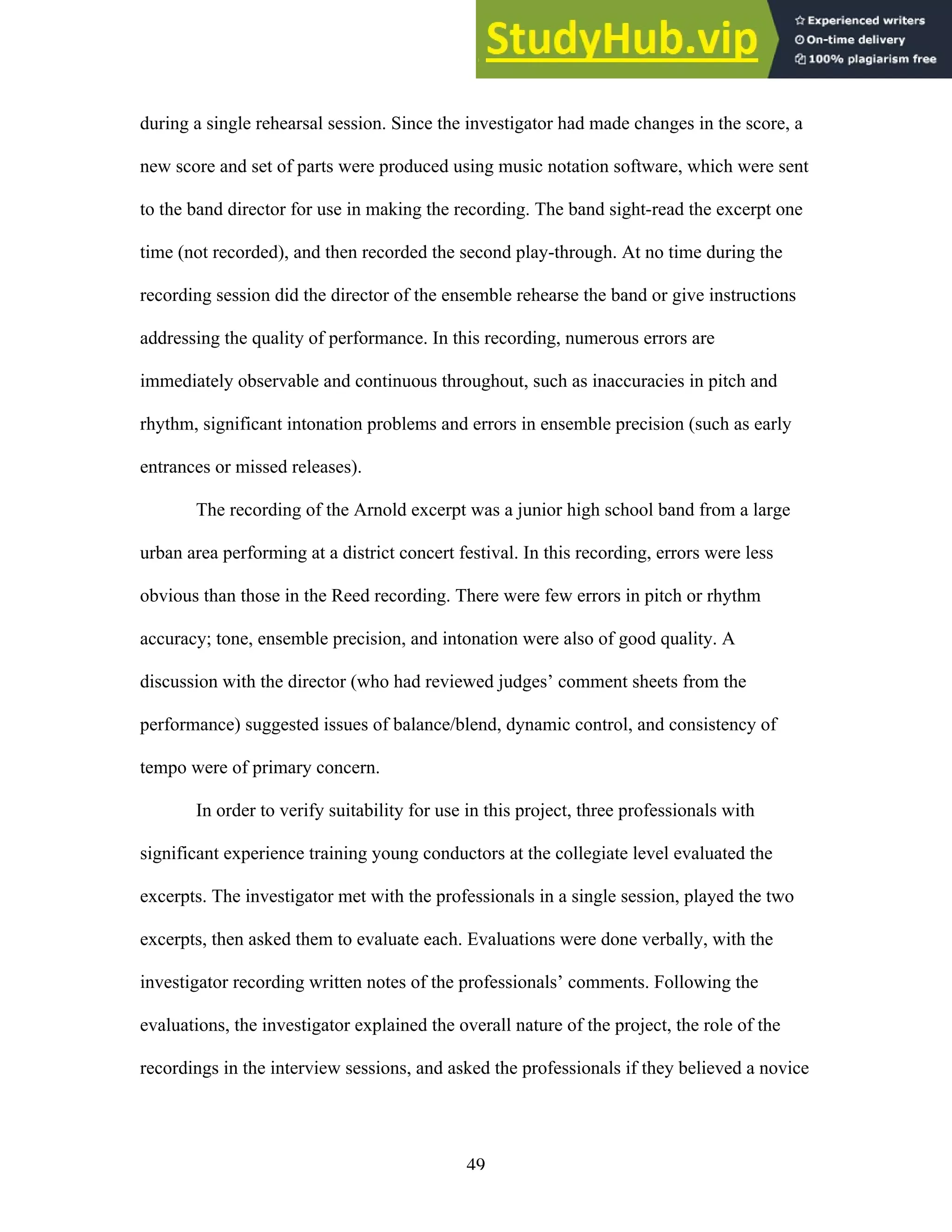
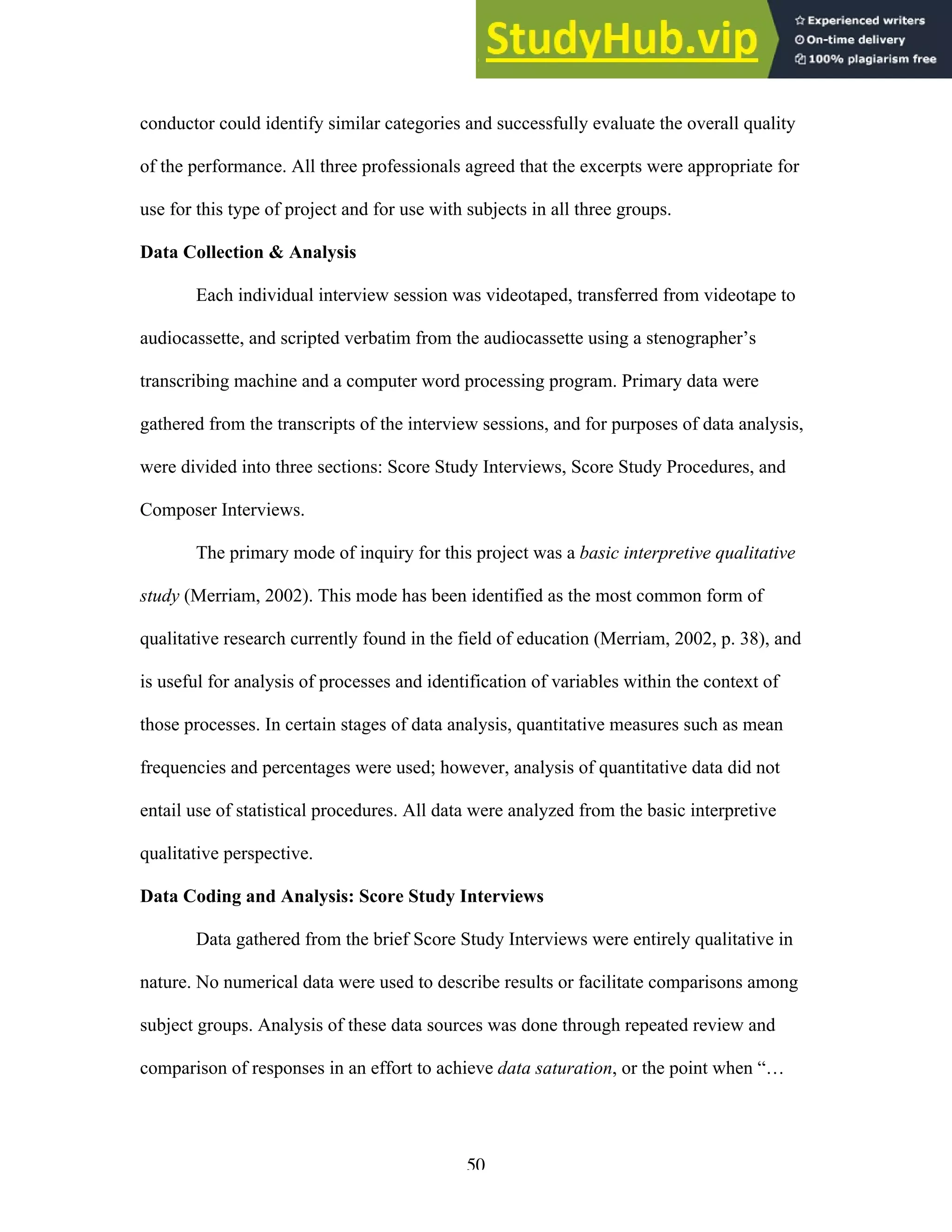
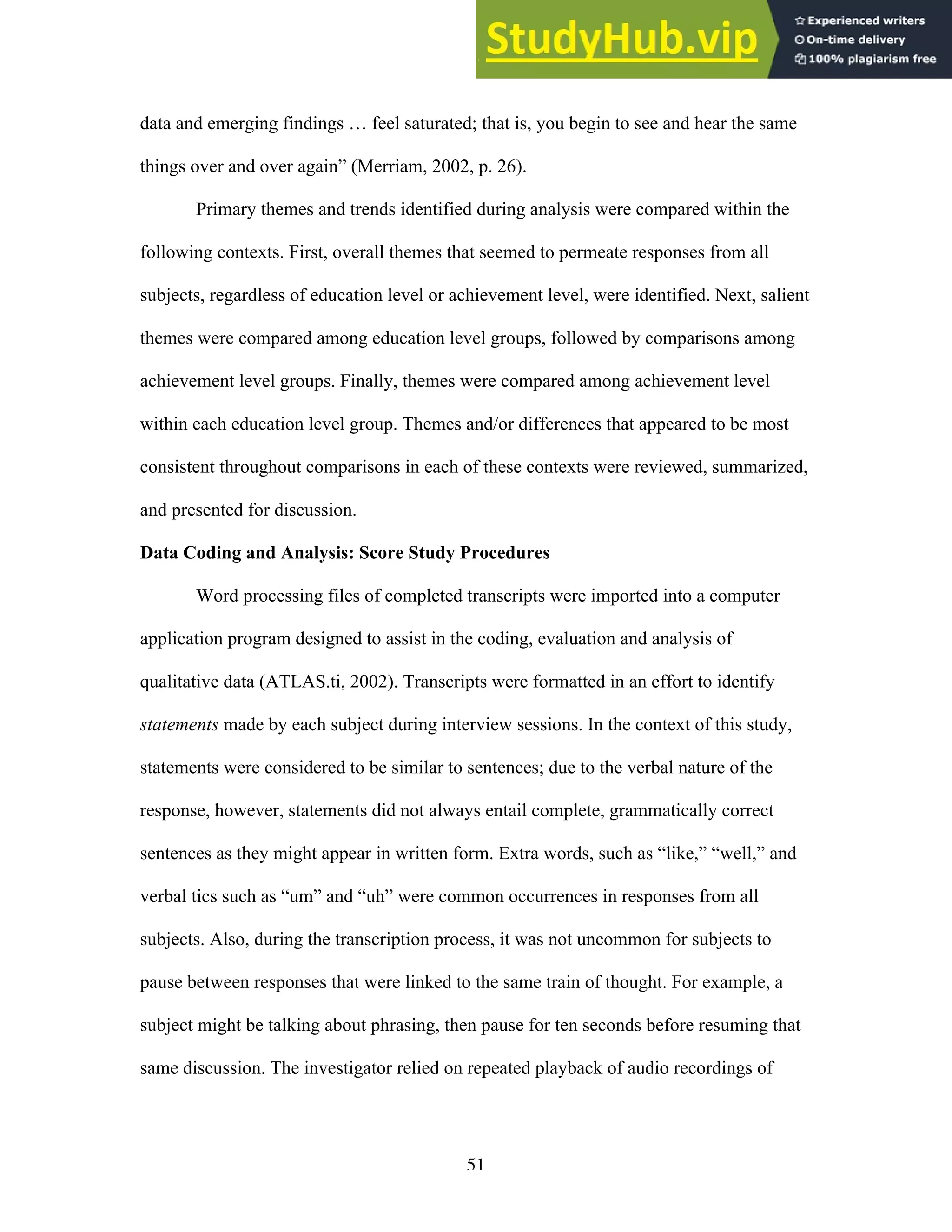
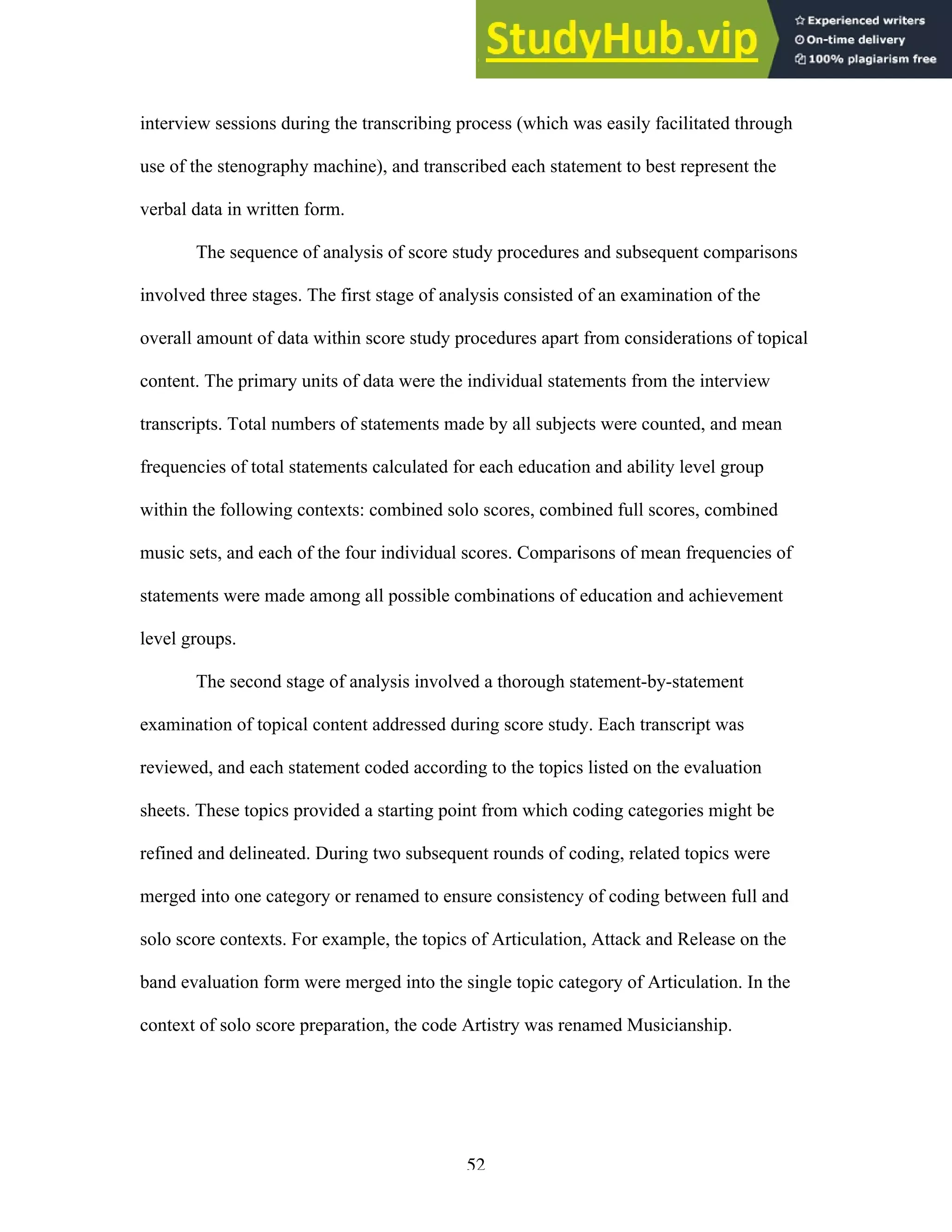
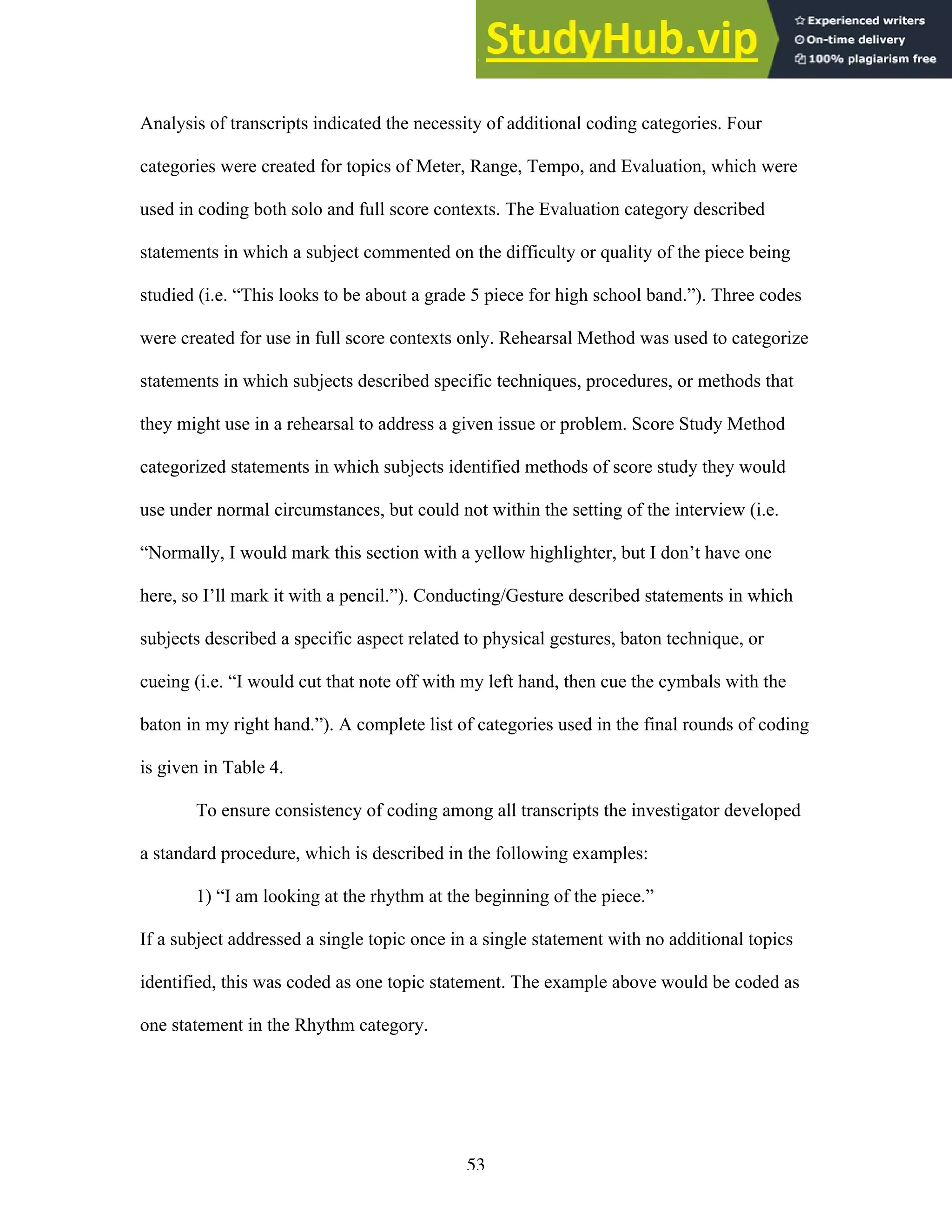
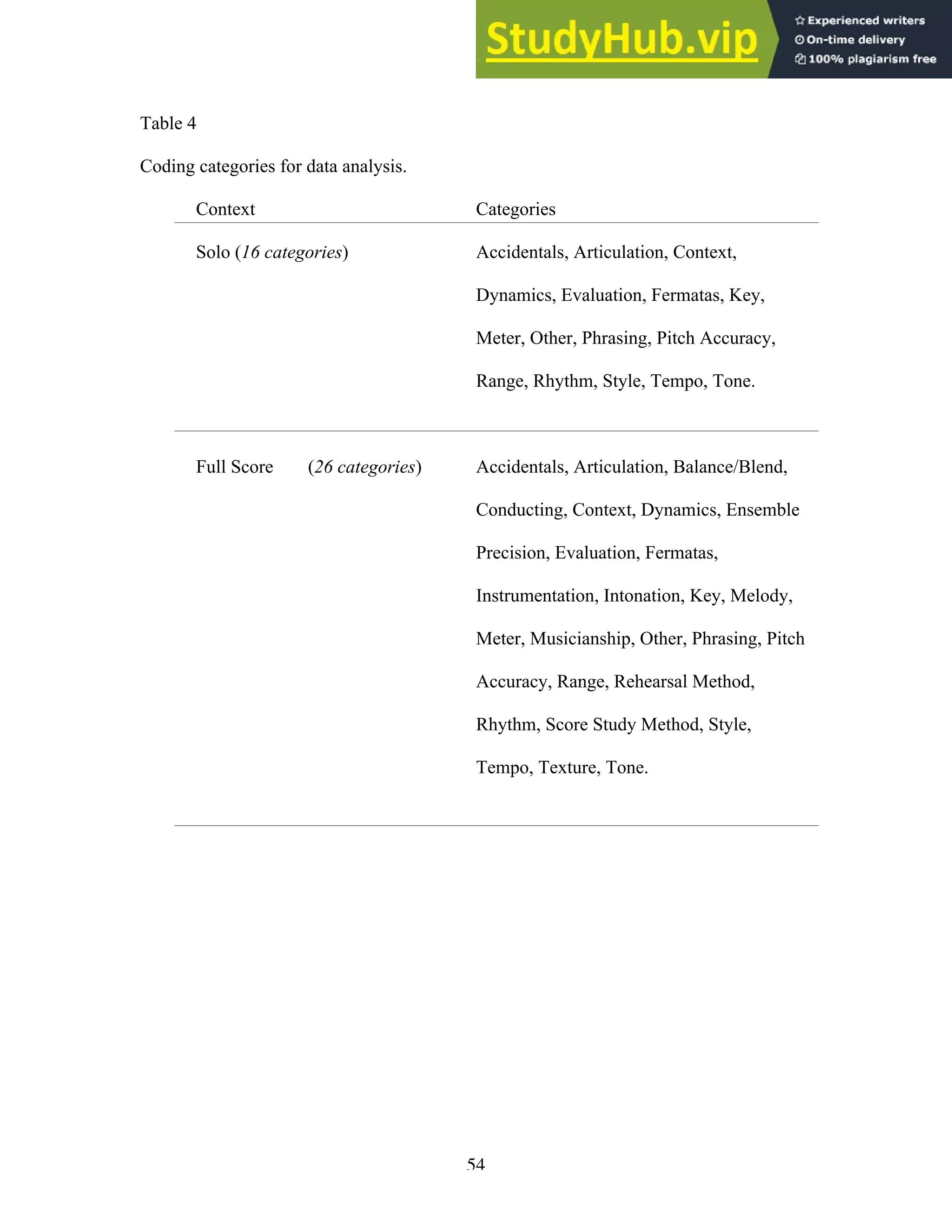
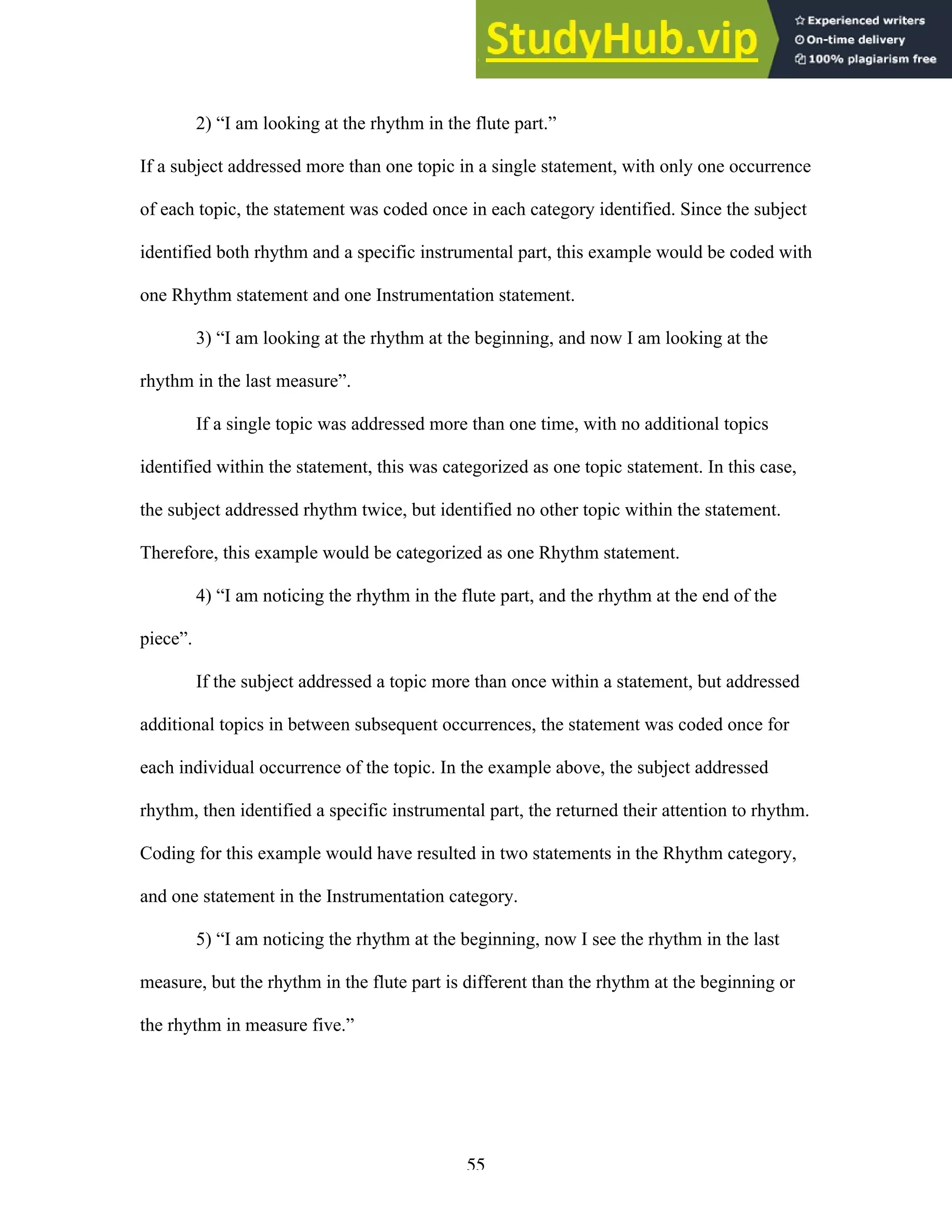



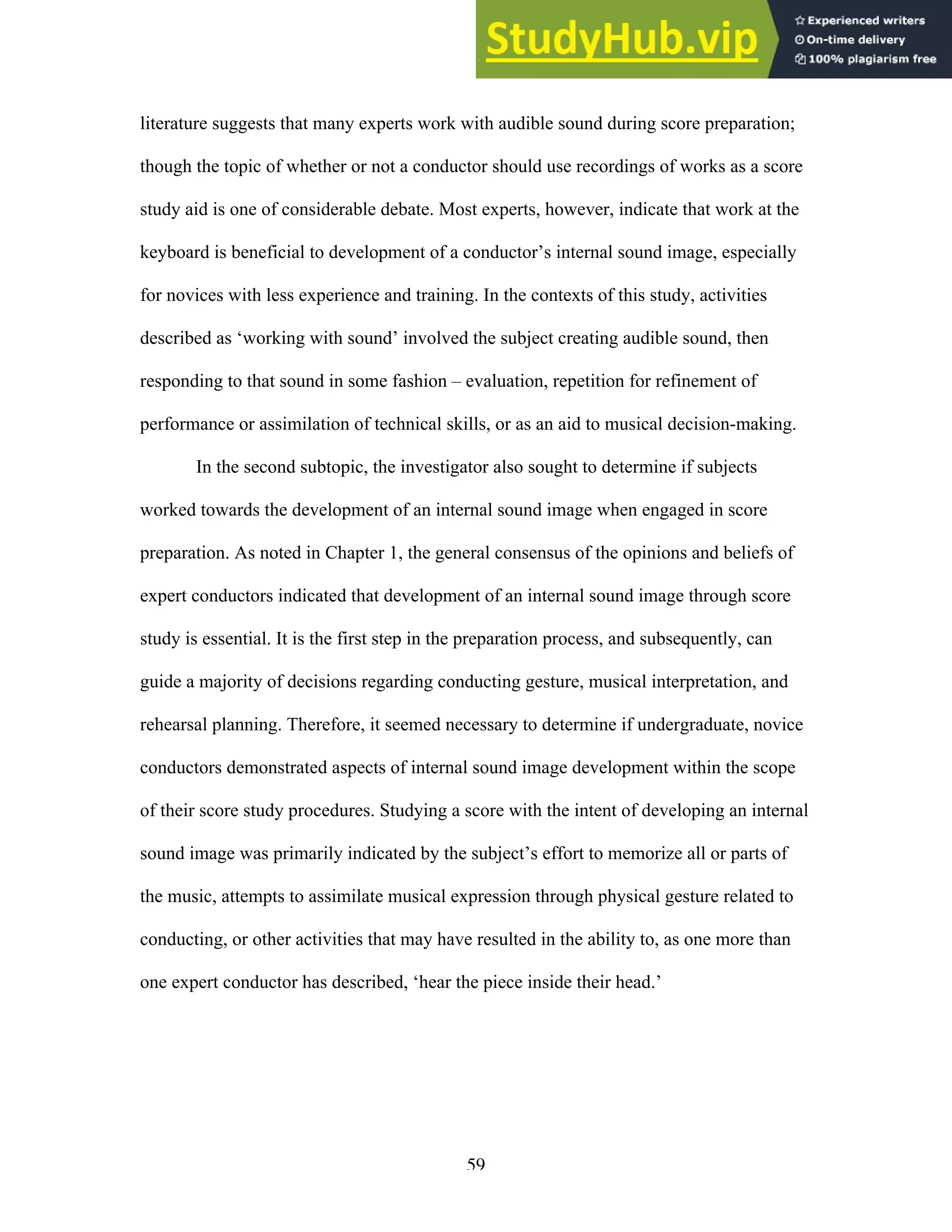
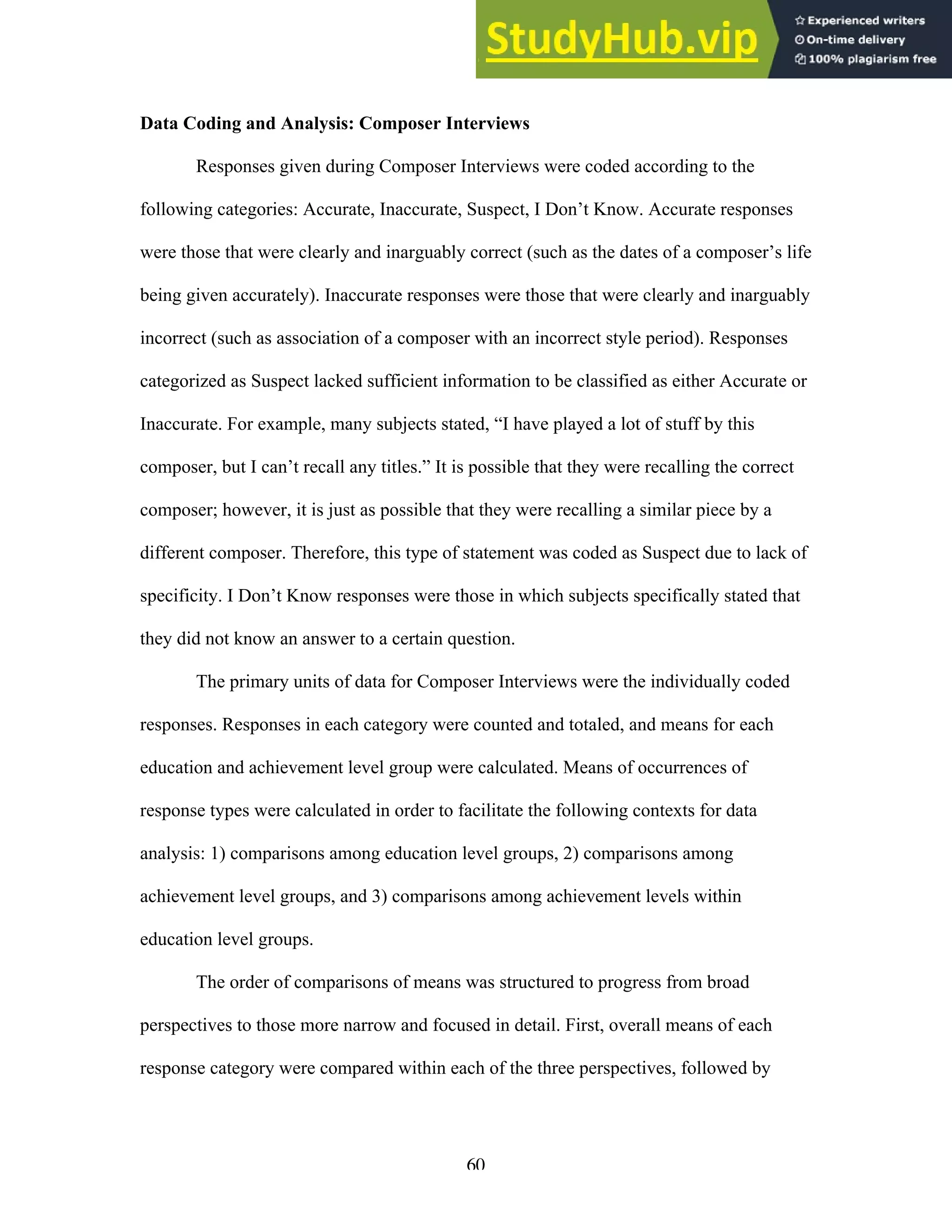
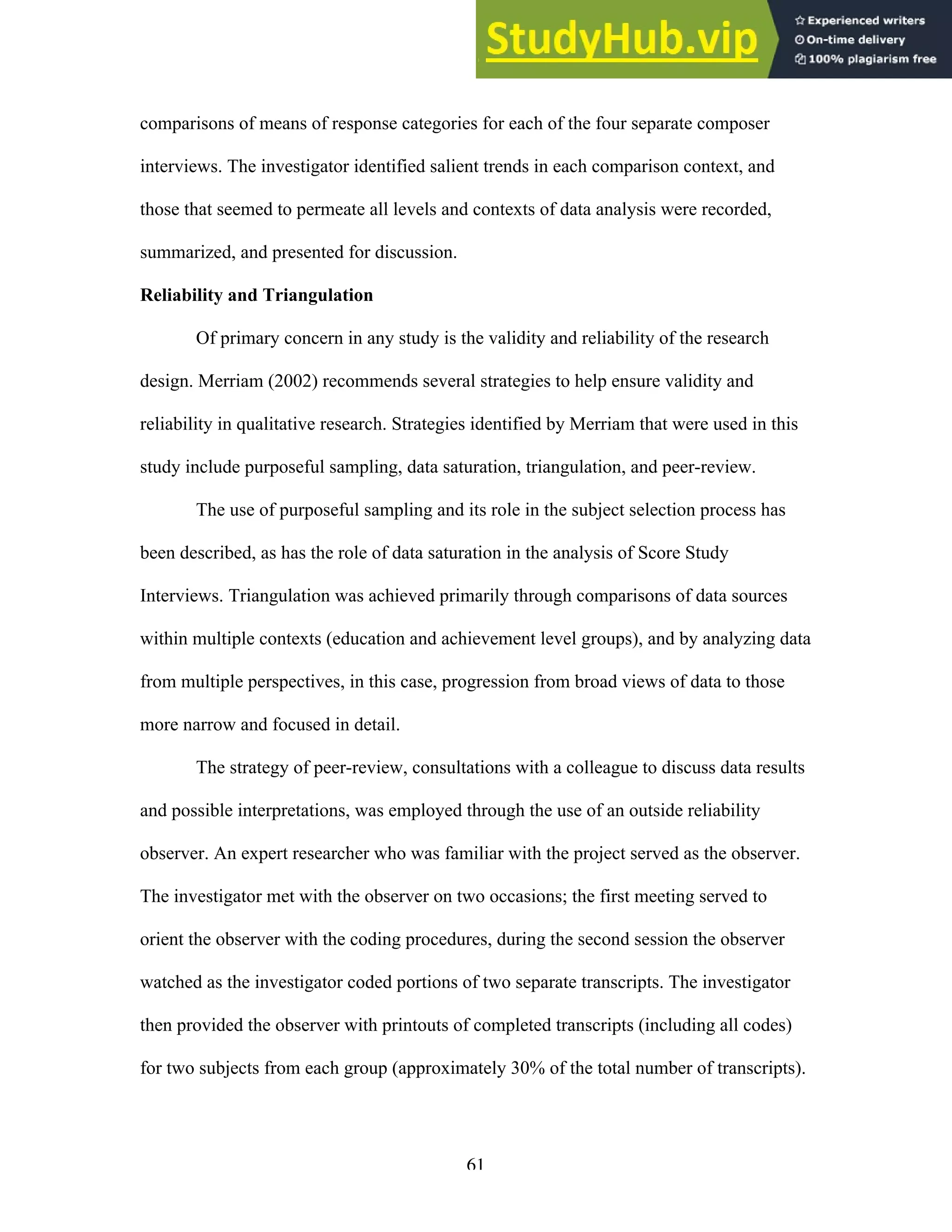
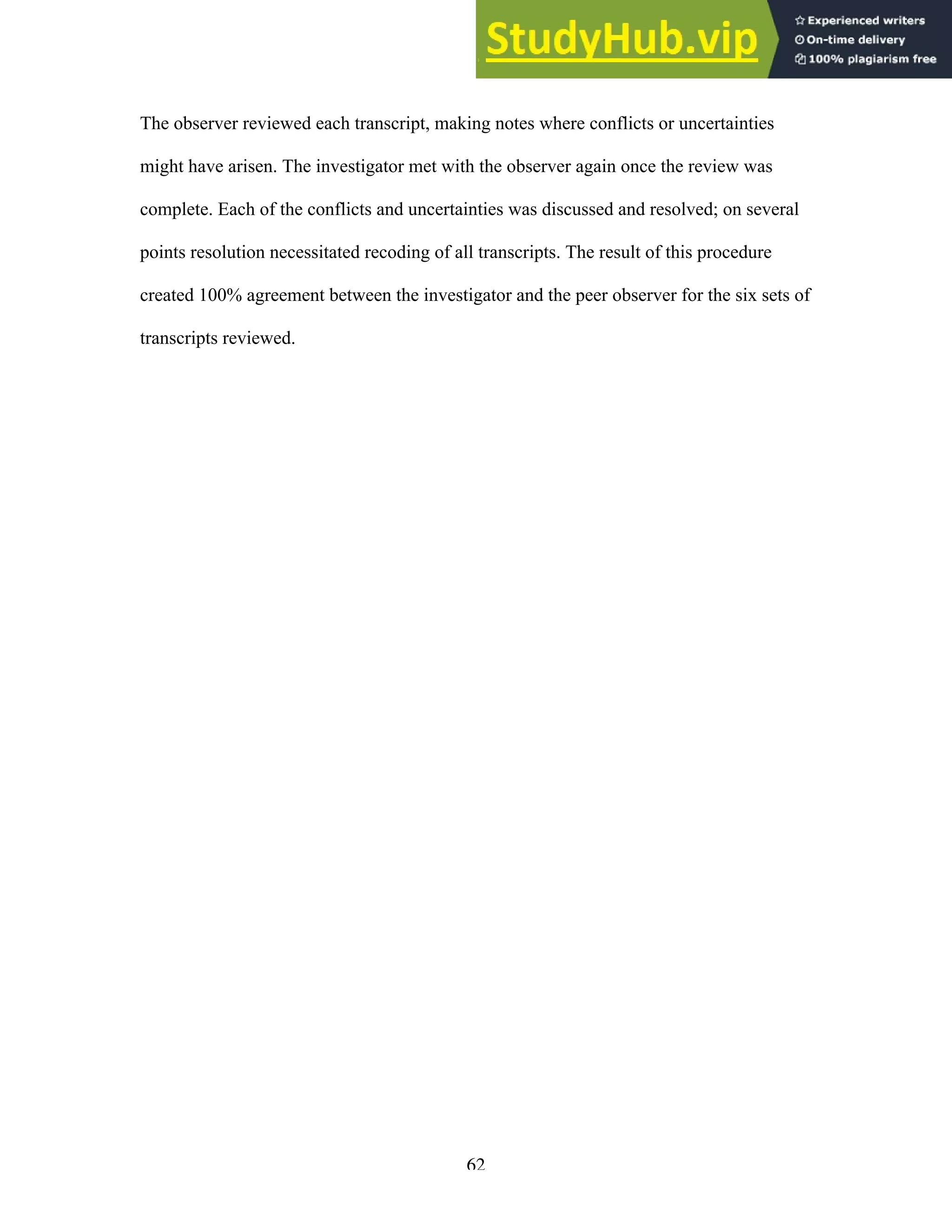
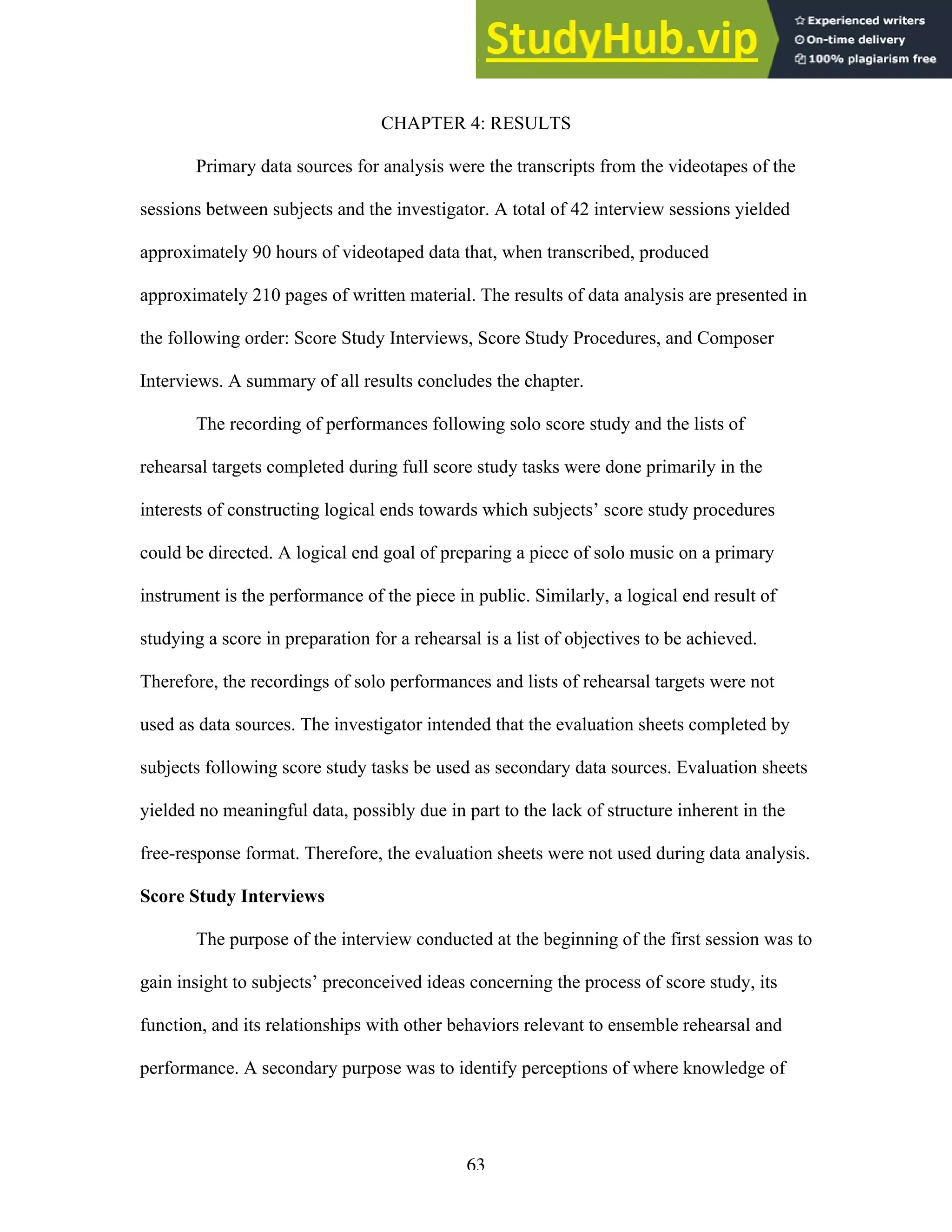
![64
score study was learned (for example, mentorship from an experienced teacher,
university course work, personal experience, etc.).
The first question of the interview directed subjects to provide their own
definition of score study in as much detail as possible. A Lower-level Undergraduate
subject responded with the following:
The way I see it now is looking over a score, finding out just the tiny little details
about dynamics and tempos, and reading through it to see what you can do better
to help your band or orchestra play the piece. Anything you can do to make it
sound better. Getting familiar with it so you know it, so you don’t get up there and
look like a fool.
Two key elements of this response, representative of a majority of responses to
this question in the Lower-level Undergraduate group, are worth noting. First, score study
is viewed solely in relation to effective rehearsing, and not as a fundamental component
of creative music making. For subjects in this group, the function of score study is to
“…help your band or orchestra play the piece.” Second, a lack of specificity within the
definition can be noted with such phrases as “Getting familiar with it…,” “…reading
through it to see what you can do better…,” and “…looking over a score, finding out just
the tiny little details….”
The following example is representative of the responses from the Upper-level
Undergraduate group:
[Score study is] learning the score, and knowing how to sing through the entire
melody all the way through, knowing what instrument has the melody where,
where the important countermelodies are, knowing the dynamics, knowing the](https://image.slidesharecdn.com/abasicinterpretiveanalysis-230806181021-8e7fdd33/75/A-Basic-Interpretive-Analysis-74-2048.jpg)
![65
map of the score, knowing dynamics, where dynamics, tempos, meter, knowing
like the whole basis, and then being able to study it well enough so that you can
get into a rehearsal and you know what to rehearse before you hear a problem.
Within this example there are numerous instances of vague description, (i.e.
“knowing like the whole basis…,” “knowing the map of the score…”); however, there
are also suggestions that certain aspects of the subject’s perceptions of score study reflect
a higher degree of specificity than the example from the Lower-level Undergraduate
subject. For example, the subject says the conductor should know how to sing the melody
through the entire piece. Seven of the nine subjects in the Upper-level Undergraduate
group provided definitions containing descriptions of specific areas of knowledge such as
theoretical analysis, historical background of the composer and piece, and issues related
to instrument transposition and score-reading. As with the Lower-level Undergraduates,
subjects in the Upper Level Undergraduate group tended to view score study solely in
relation to rehearsal preparation.
Student Teachers were similar to Upper-level Undergraduates in that a majority of
subjects in this group (five of six) gave a definition of score study that included
descriptions of specific areas of knowledge. Some responses from the Student Teacher
group, however, included aspects of artistic functions of score study, as evidenced in the
following example:
Score study involves taking a composer’s written piece of music, going over the
ins and outs [sic] of every aspect of what the composer has written, and defining
what interpretation you want from what he wrote. Because you can’t get inside
that composer’s mind, especially if he’s passed away, so your job when you are](https://image.slidesharecdn.com/abasicinterpretiveanalysis-230806181021-8e7fdd33/75/A-Basic-Interpretive-Analysis-75-2048.jpg)
![66
score studying [sic] trying to figure out what was this person’s intent, why did he
write it like this, and how it is supposed to sound.
Although a certain amount of vagueness is present in this definition, the idea of
score study as an element of musical expression is evident. Two subjects in this group
responded with definitions of score study that included references to artistic functions of
score study. The notion of score study being related to rehearsal effectiveness was still
predominant, however, with responses from five of six subjects reflecting this particular
view.
A related follow-up question directed subjects to describe how or from where
their definition of score study was learned or developed. Not surprisingly, the content in
these responses seemed to be directly related to training and experience. Lower-level
Undergraduates described their definition of score study as developing from personal
observations of more experienced teachers or from their own opinions, Upper-level
Undergraduates tended to describe their definition in relation to knowledge gained from
conducting and music education courses, and Student Teachers described a synthesis of
knowledge learned in undergraduate course work with personal experience gained during
student teaching.
The next question in the interview directed subjects to describe their perceptions
of relationships between score study and other aspects of performing, rehearsing and
conducting. All subjects, regardless of education or achievement level, could identify and
describe at least one aspect of performing, rehearsing, or conducting that might be
directly related to or affected by score study. For example, a subject in the Lower-level](https://image.slidesharecdn.com/abasicinterpretiveanalysis-230806181021-8e7fdd33/75/A-Basic-Interpretive-Analysis-76-2048.jpg)
![67
Undergraduate group identified a relationship between score study and knowledge of
potential problem areas in teaching a specific instrument:
By studying the score and knowing where the students are going to have problems
in their pieces, you can give them ways that they can fix their problems while they
rehearse, tell them how to rehearse it. You can know where the trouble spots are
before they actually get to them, kind of have beforehand knowledge of, you
know [sic], this clarinet part is crossing the break, they are going to have trouble
with that or this part is hard to hear the partials or whatever. So you can know
before you get to that part in rehearsal [sic], you already know and have a plan
about that and how you are going to approach it, then you fix it.
A Student Teacher subject reflected a similar view, and related the identification
of problems and rehearsal effectiveness to overall goals of the rehearsal process:
Score study is going to make your rehearsing more efficient, because you know
where the problems are, you know what you want to hear, and you can attack it
whereas if you don’t study a score and you just get up there and start conducting,
you are sort of in a read and react kind of thing. And with practicing, you have to
look at each individual part in the score, just as your first chair clarinet player has
to look at his or her individual part and know the ins and outs [sic] of it. And,
obviously, I think if you do all of those things, and your kids do all those things,
then the musical performance aspect of it is going to be absolutely wonderful
because you are going to make real music.
A follow-up question directed subjects to described their perceptions on where
they learned or became aware of the relationships between score study and other aspects](https://image.slidesharecdn.com/abasicinterpretiveanalysis-230806181021-8e7fdd33/75/A-Basic-Interpretive-Analysis-77-2048.jpg)
![68
of performing, rehearsing, and conducting. As was the case with the definitions of score
study, Lower-level Undergraduates relied on personal observations of experienced
teachers, Upper-level Undergraduates referred to knowledge gained from conducting and
music education courses, and Student Teachers described a synthesis of knowledge
learned in undergraduate course work with personal experience gained during student
teaching.
Next, subjects were asked to describe the end goal, or desired result, of score
study. Lower-level Undergraduates responded most frequently with vague concepts such
as “You know a piece really well,” or “You get a broader concept of the piece.” Two
subjects responded initially with one-word answers of “Satisfaction” and “Knowledge,”
which were then elaborated on slightly in the latter part of the response.
Upper-level Undergraduates tended to describe the end product in one of two
ways. Responses from five of nine subjects in this group were very similar to those given
by Lower-level Undergraduates. These responses tended to be vague, such as, “You
know the score inside and out.” Four subjects, however, responded with an approach
reflective of major disciplinary ways of thinking by experts in the field of conducting.
One example of this type of response is as follows:
[The result of score study is] …an idea of just the music that is on the page, like
[sic], you have an idea, you’ve taken a tangible thing and made it abstract by
being able to put it inside of you and inside your head. Instead of keeping it on the
page, you’ve internalized the score.](https://image.slidesharecdn.com/abasicinterpretiveanalysis-230806181021-8e7fdd33/75/A-Basic-Interpretive-Analysis-78-2048.jpg)
![69
Expert conductors very often describe the end product of score study in terms of an
internalized sound image; the ability to “hear the piece” inside one’s head as a result of
intensive and thorough score study.
Student Teachers’ responses to this question reflected similar trends as those from
the Upper-level Undergraduates. Responses from three subjects contained vague
descriptions of “knowing the score;” responses from the three other subjects described
the end product as an internalized sound image. For example, one subject identified the
product of score study as follows:
[A] sound clip in your head and how it’s supposed to sound. If you see you have
all of these notes or whatever on a page and markings [sic], you take that through
score study and you figure out in your head how it is supposed to sound before
you play it or before you rehearse it…
Finally, subjects were asked to describe their experience with score study. All six
Lower-level Undergraduates indicated little or no experience. Eight of nine Upper-level
Undergraduates indicated that their experience was limited to work done in music
education and conducting courses (one subject described some prior experience gained
while assisting in a local private school band program). In addition to experience gained
in undergraduate course work, all six Student Teacher subjects could name at least one
specific piece (title and composer) that they had studied thoroughly during the course of
their student teaching experience.
Comparisons of responses in score study interviews among High and Medium
musical achievers across all education level groups suggested no apparent trends. One
element of note did emerge among achievement level comparisons within the Upper-](https://image.slidesharecdn.com/abasicinterpretiveanalysis-230806181021-8e7fdd33/75/A-Basic-Interpretive-Analysis-79-2048.jpg)
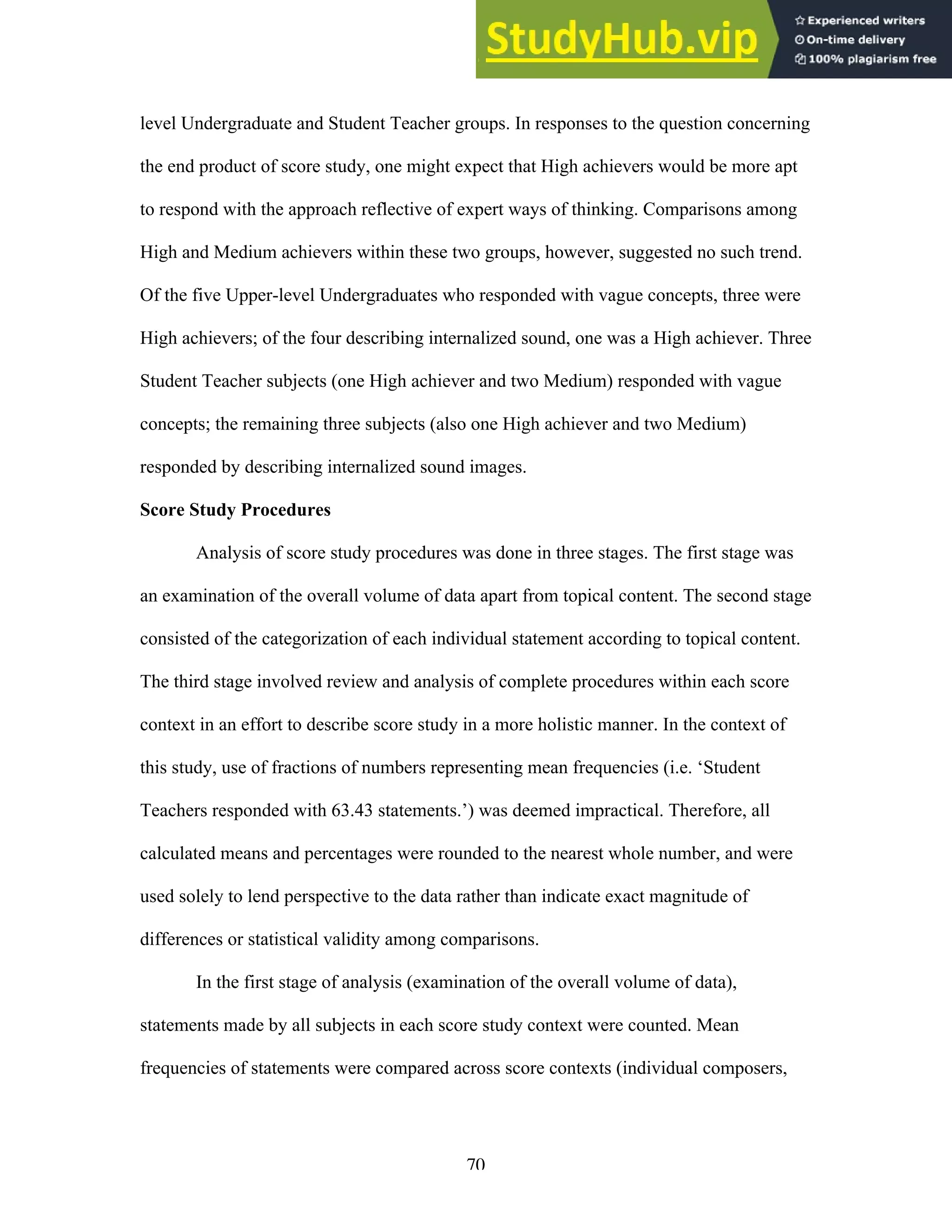
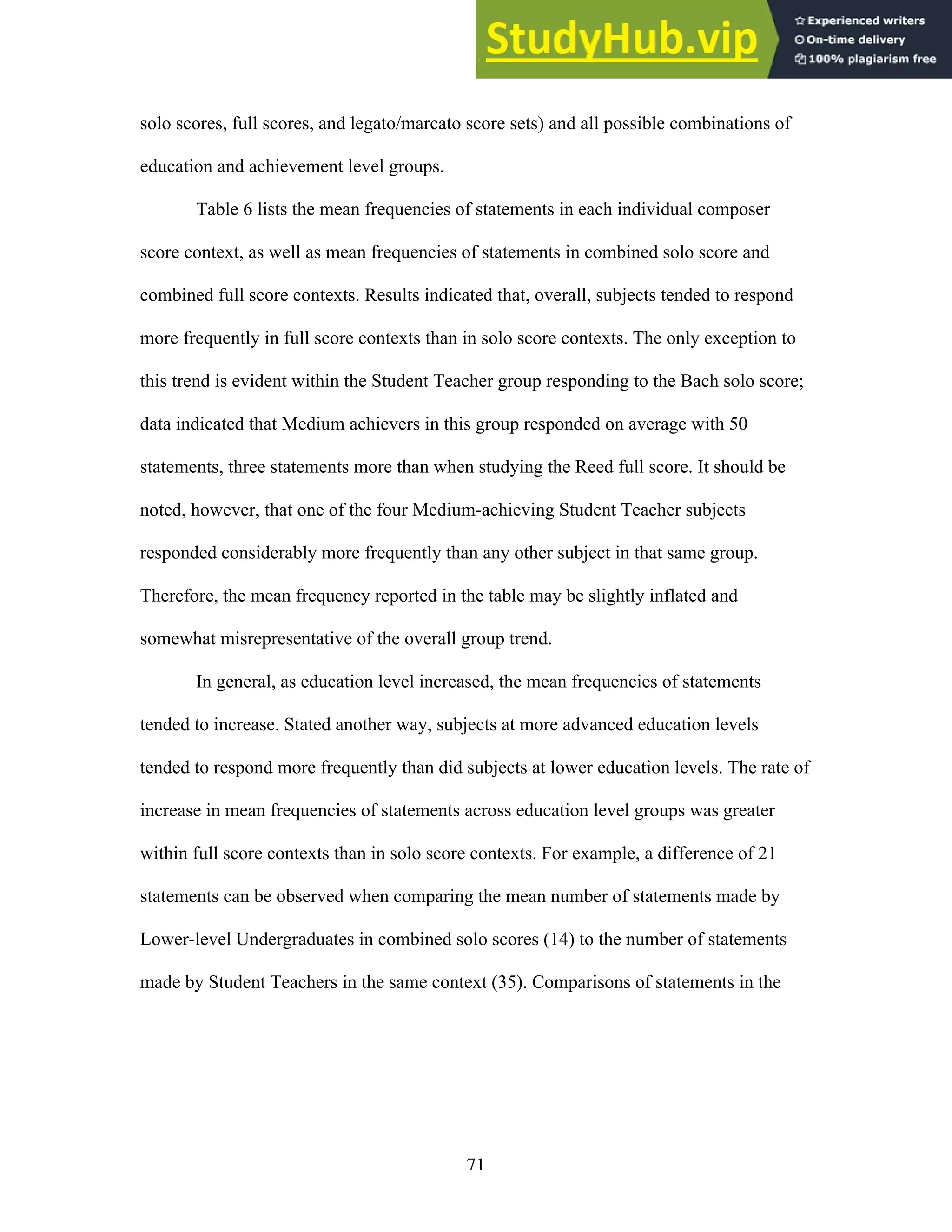
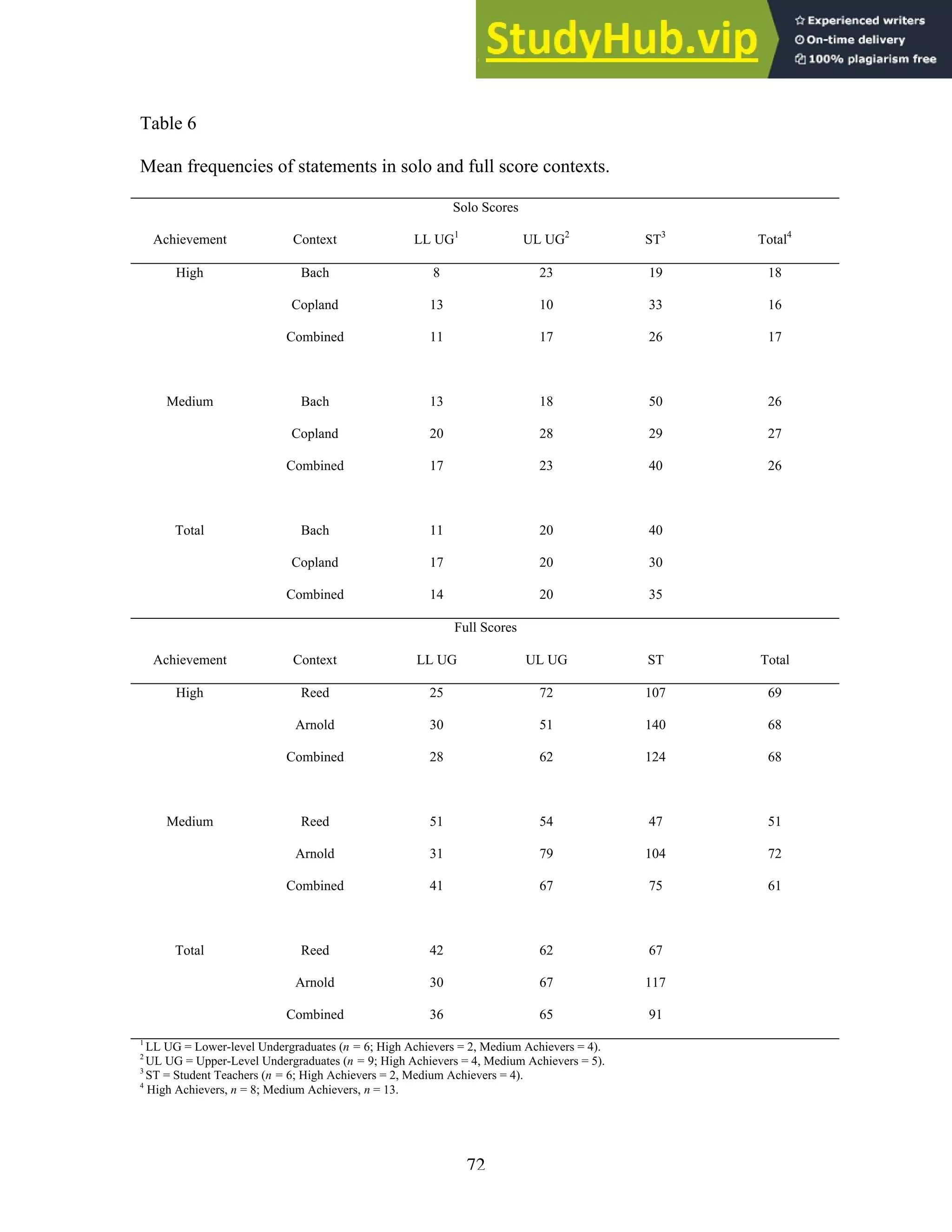
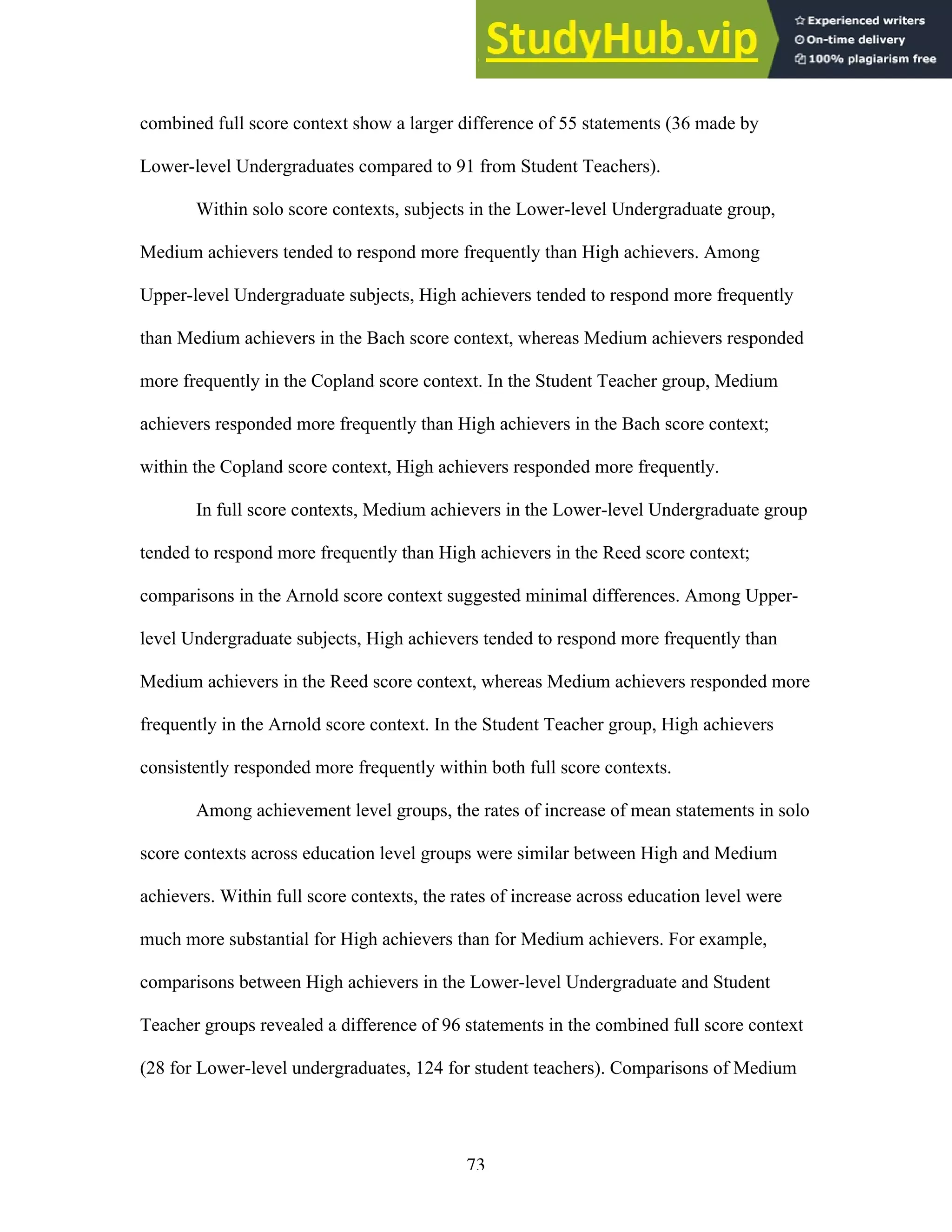

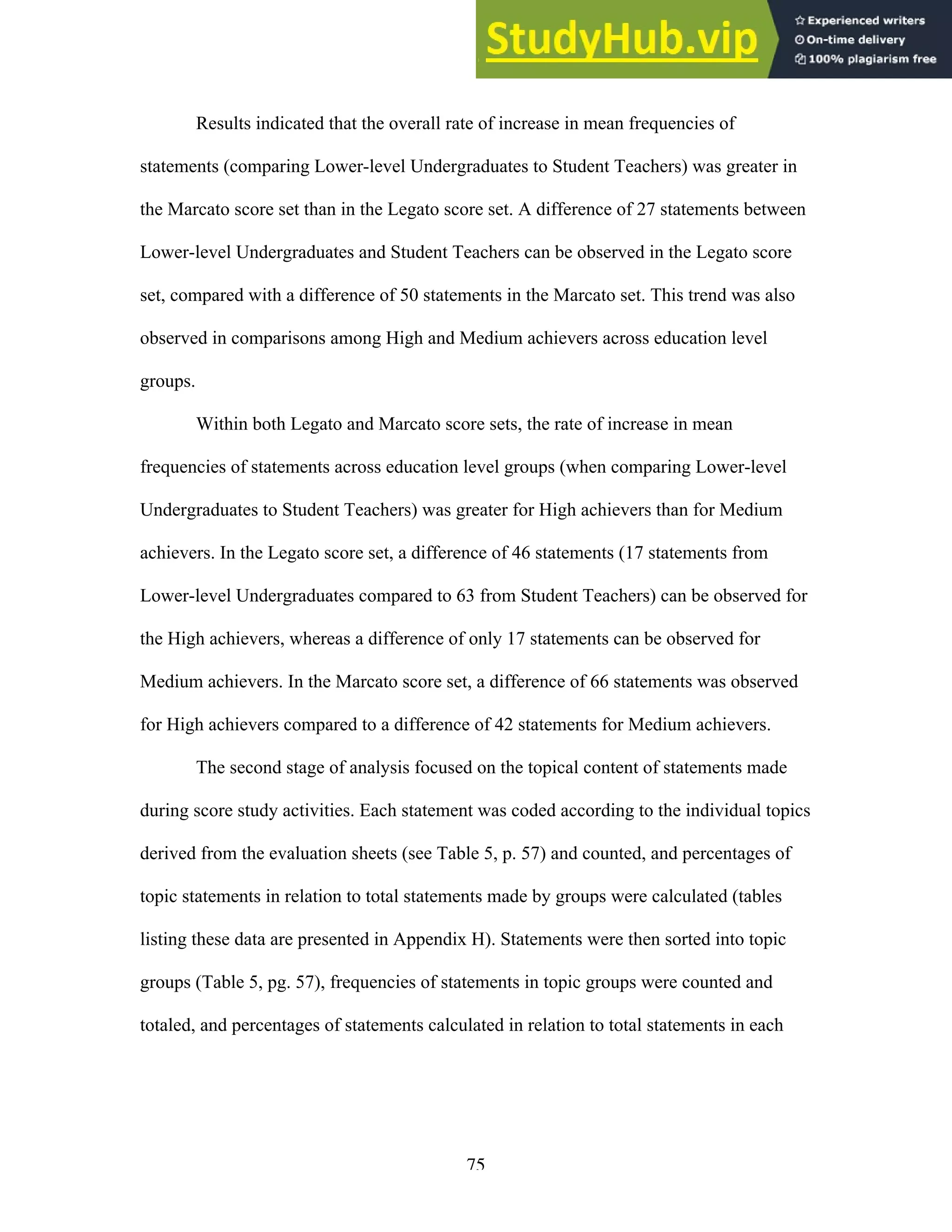
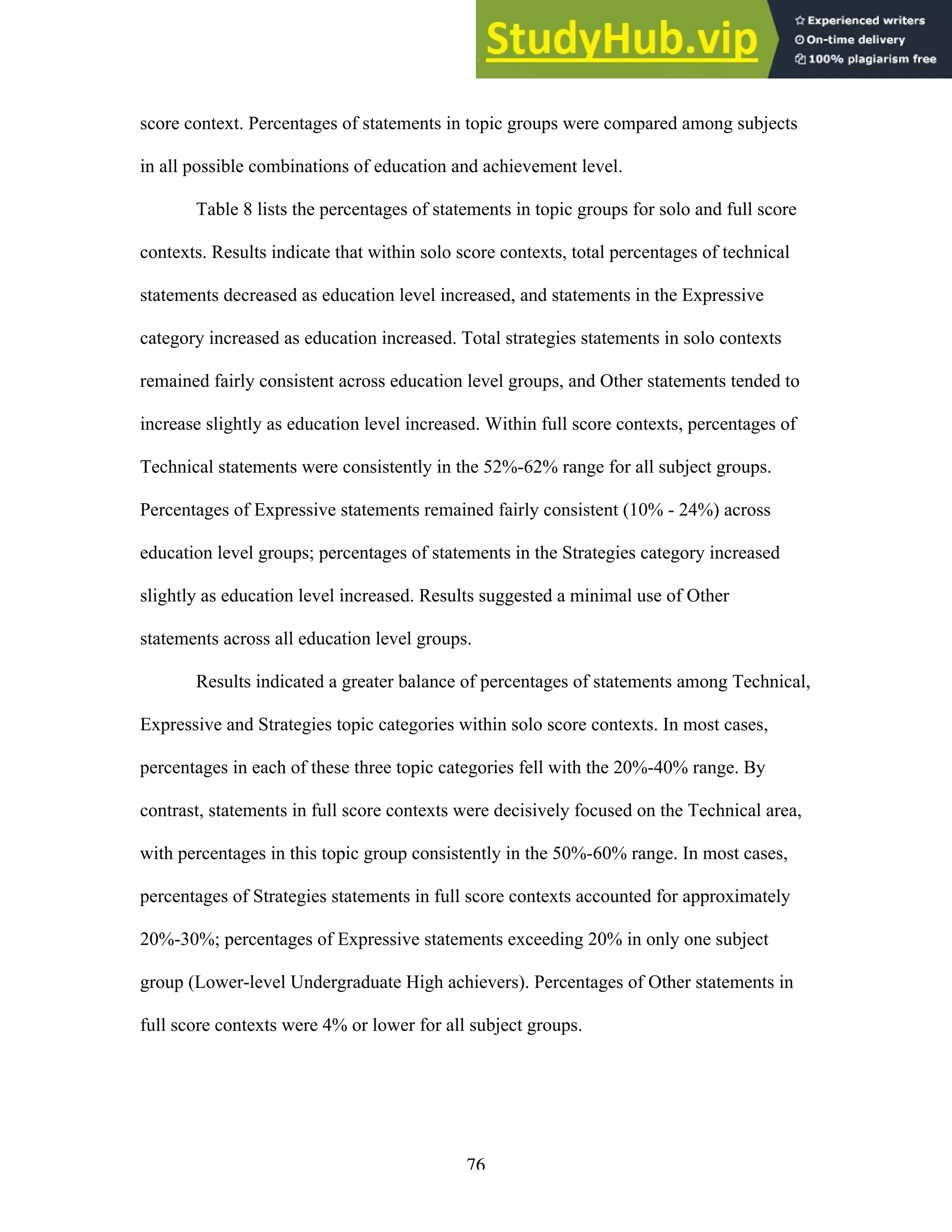
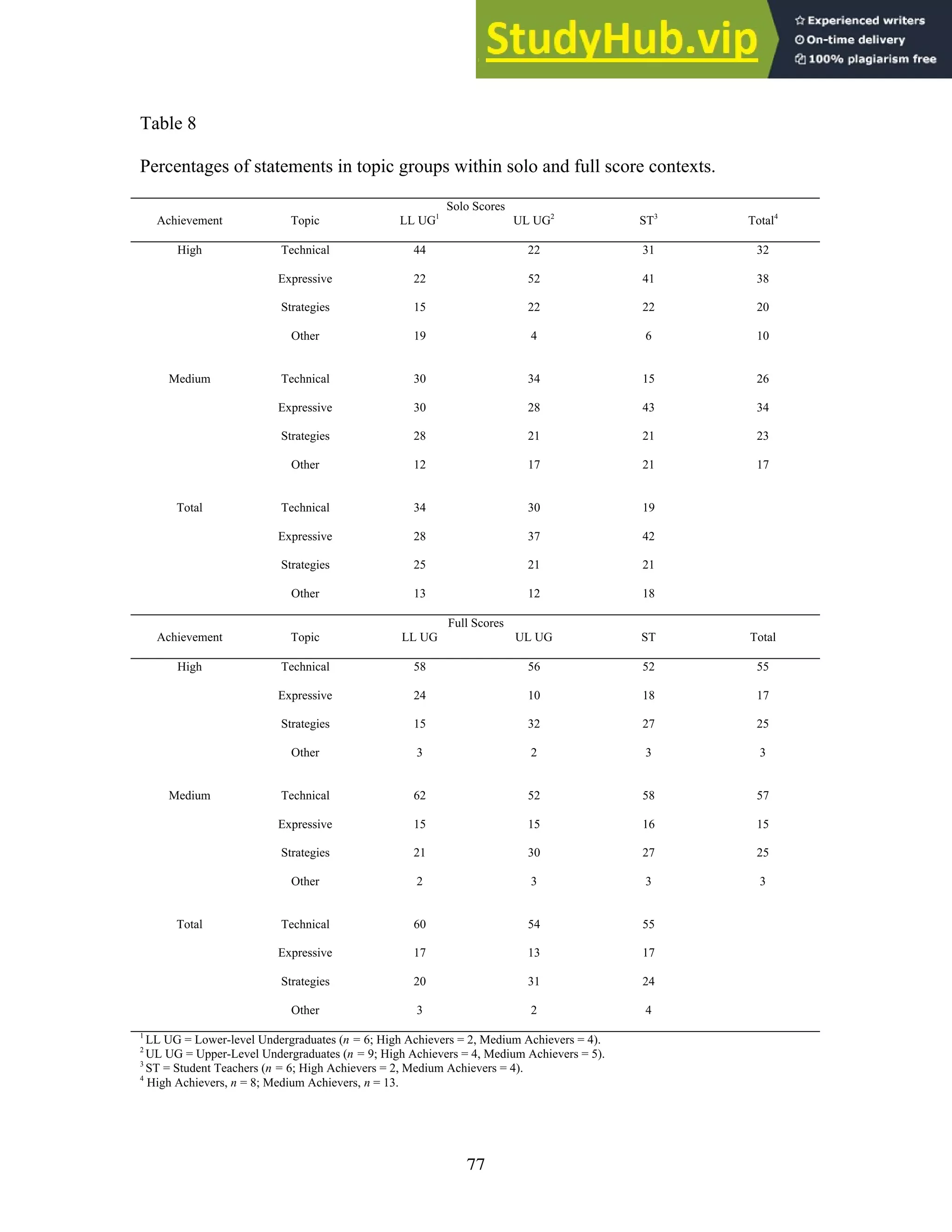

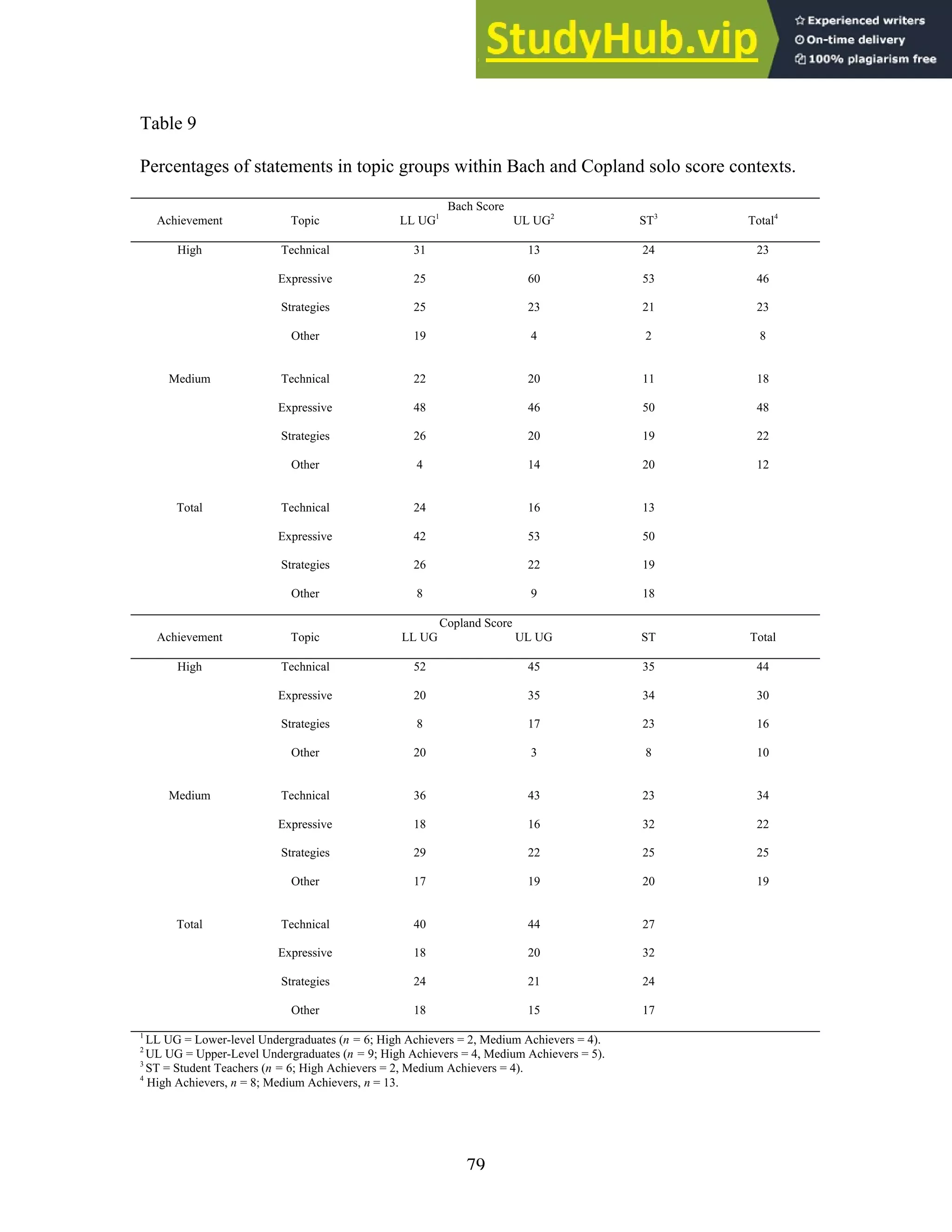
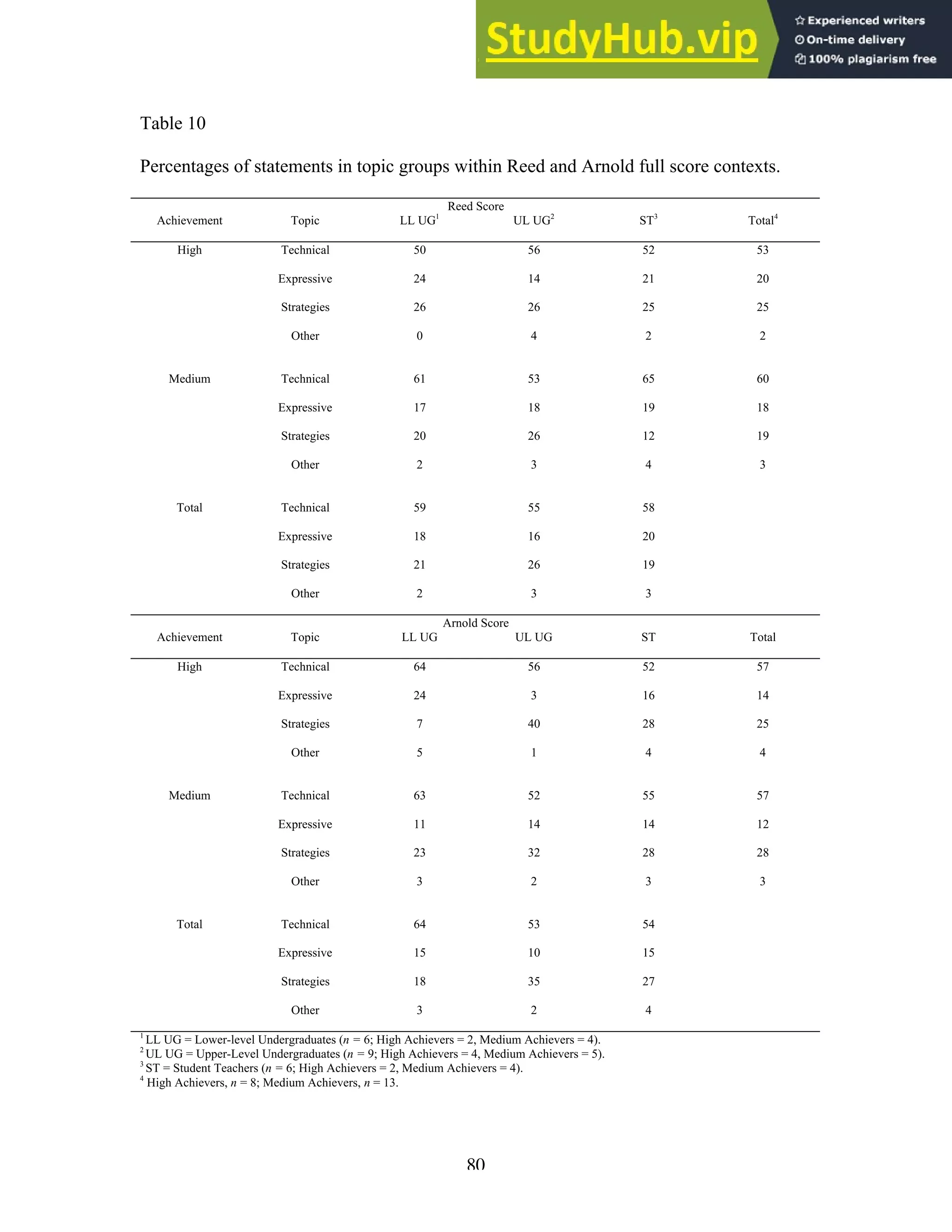
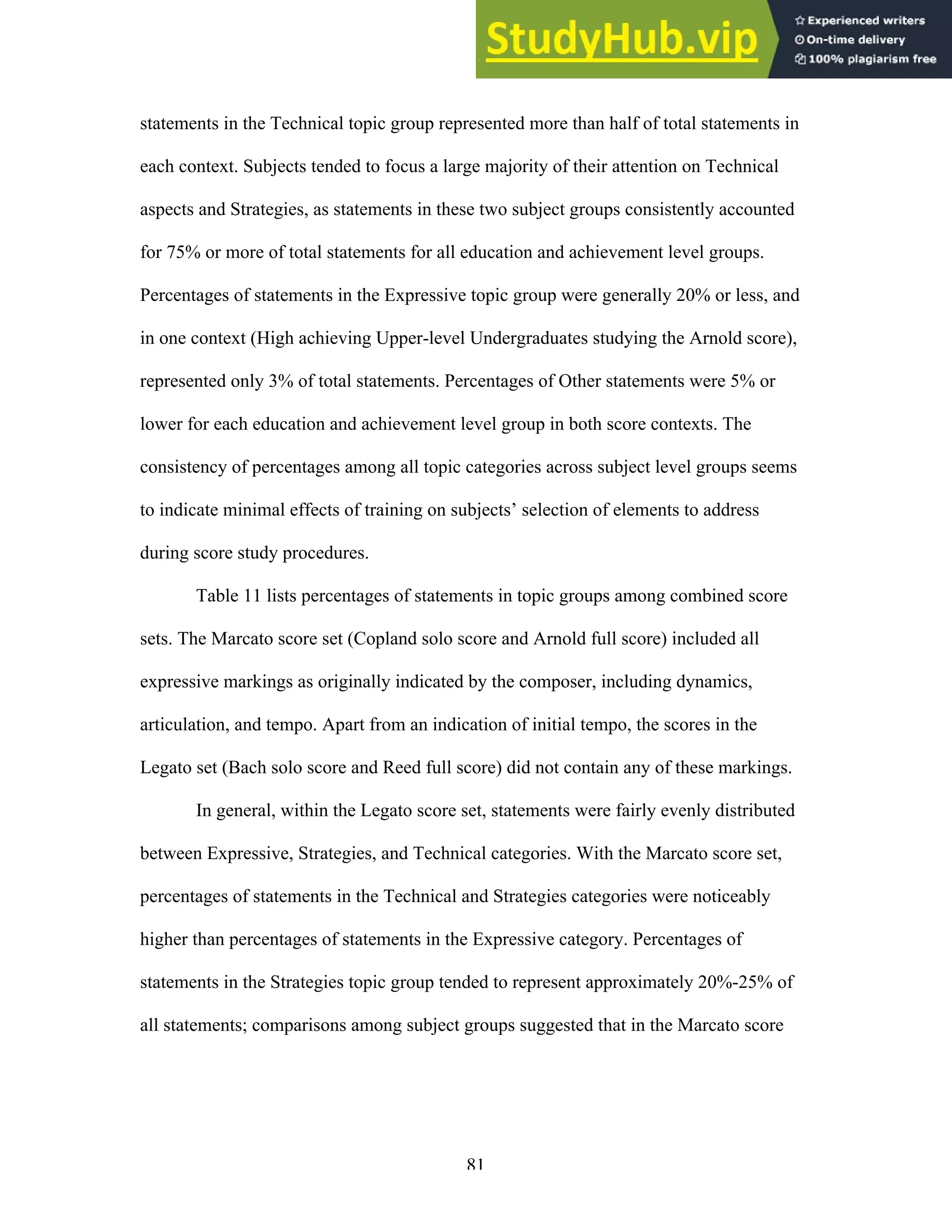

![83
set, Upper-level Undergraduates tended to focus more on Strategies than did Lower-level
Undergraduates or Student Teachers.
In the third stage of analysis, the investigator approached the description of score
study procedures in a more holistic manner. Analysis in this stage was guided by the
topics identified in Chapter 3 (Table 5, p. 57).
In solo contexts, subjects generally initiated their score study procedures with a
look through of the music, establishing contexts of basic elements such as key, meter, and
tempo, followed by a cursory assessment of the overall technical difficulty of the piece
and identification of potential problem areas. The following example, a Medium achiever
in the Lower-level Undergraduate group, is representative of the types of statements
commonly made by subjects within the early stages of solo score study procedures:
First thing I do is look at clefs, because my [primary instrument] tends to jump in
clefs. The second thing I look for is the key signature, and the time. In this piece it
is B-flat Major. The next thing I do is kind of scan the piece for anything that
might be something I really need to focus on and practice. I look for patterns, I
look to see if I can find any chord changes or anything that I might not be able to
hear right off.
Following this initial contextualization of basic elements, subjects tended to
engage in playing the score (or excerpts) on their primary instrument. The first playing
episode usually occurred within the first 10-15 statements; this tendency held true across
all education and achievement level groups and within solo and full score contexts.
Following the initial play-through, subjects then began a process of correcting missed
notes or rhythms, working towards a performance that was technically accurate.](https://image.slidesharecdn.com/abasicinterpretiveanalysis-230806181021-8e7fdd33/75/A-Basic-Interpretive-Analysis-93-2048.jpg)
![84
A notable trend emerged when comparing the solo score preparation procedures
of Lower-level Undergraduates with those of Upper-level Undergraduates and Student
Teachers. Consider the following example, which is the complete procedure of a High
achiever in the Lower-level Undergraduate group working with the Copland solo score:
All right, basically I’m just going to look at, just kind of glance over everything
[sic]. So now I just look through everything look for problem areas, and I’ll just
run through it once to make sure at a very slow tempo [subject plays primary
instrument]. Now I’m just looking at it to see how I can improve the articulations.
I’ll take note of the parts, places where I missed notes, and I’ll pay special
attention to those next time, so I’ll mark those right now. I’m going to play
through it again [subject plays primary instrument]. I’m going to isolate measure
three and get that octave leap I’ve missed twice already [subject plays primary
instrument]. I’m going to play through it one more time [subject plays primary
instrument]. All right, this time I’m going to not pay as much attention to the
notes and exaggerate all the articulations [subject plays primary instrument]. All
right, I’ll record.
In this example, the subject attempts to establish a general context (‘glance over
everything’). After the third full statement, the subject plays the primary instrument, and
continues with the preparation process by addressing incorrect notes and articulations.
Once these elements were performed satisfactorily, the subject was ready to record a final
performance. For comparison, consider the following example, the complete transcript of
a High achiever in the Student Teacher group working with the Copland solo score:](https://image.slidesharecdn.com/abasicinterpretiveanalysis-230806181021-8e7fdd33/75/A-Basic-Interpretive-Analysis-94-2048.jpg)
![85
Well, the first thing I notice is the key. I’m going to just look through it in my
head, get an idea of what the piece sounds like. Now I’ll just play through it at a
slow tempo, get a feel for the piece [subject plays primary instrument]. I notice
the articulations, there are a lot of different articulations, especially in the last few
bars. I’m going to run those and see if I can get the contrast right [subject plays
primary instrument]. Okay, now I’ll go back and try and get more of a playful
style happening through the entire piece. I think choosing a good tempo will
really help [subject plays primary instrument]. The fingerings aren’t too difficult,
but I want to try again for repetition’s sake [subject plays primary instrument].
Okay, I think that’s about how I would do that.
Several similarities between this example and the one previous are apparent. In
both examples, the subject conducted a general survey of the piece, and engaged in
playing the primary instrument early in the score preparation procedure. Both subjects
addressed issues of articulation; both also addressed aspects of technical difficulty. The
Student Teacher subject, however, addressed expressive elements of the piece that the
Lower-level Undergraduate subject did not; in this case, the Student Teacher attempted to
achieve a more ‘playful style’ in their performance.
These two examples serve to illustrate the primary differences in solo score study
procedures among education level groups. In general, Lower-level Undergraduates
tended to stop working with the score once the technical aspects of their performance
were addressed and corrected. Subjects of more advanced education level groups,
however, were more likely to address expressive elements of the music before recording
their performance.](https://image.slidesharecdn.com/abasicinterpretiveanalysis-230806181021-8e7fdd33/75/A-Basic-Interpretive-Analysis-95-2048.jpg)
![86
One interesting trend arose during analysis of score study procedures in the
context of the Bach solo score. When preparing the Bach score (in which the title of the
piece was omitted from the printed page), 18 of 21 subjects correctly identified the piece
as a chorale; three subjects did not attempt to identify the genre or form of the piece. This
trend is notable due to the fact that the investigator did not prompt subjects to identify the
score as a chorale; subjects seemed to engage in this process on their own.
In full score contexts, several notable differences among education level groups
were observed. In the Lower-level Undergraduate group, the initial establishment of
context (key, meter, tempo, etc.) that was very common in solo score preparation was not
as consistently observed in full score preparation. Full score study procedures seemed to
progress in a much more unpredictable, ‘stream of consciousness’ manner. The following
example is from the transcript of a High achiever working with the Arnold score:
The first thing I would look for would be entrances, where different sections play
together. All the forte-pianos, they have that everywhere, all over the place [sic].
So I guess I would try to work the whole band with that, because at one point or
another, they all have it, it’s in every part. Maybe just work them on scale
passages or something like that, just on chords, just getting what a true fortissimo
and a true piano is and the going from that and getting that precise. They have a
lot of little glisses, little triplet pick-ups. Everybody has that at one point or
another, that slurred gliss and the two staccato notes.
In a small number of statements, the subject mentions several elements of the
music (ensemble precision, dynamics, teaching strategies, pick-up notes, articulation), yet
does so in a manner that leads to few specific decisions or conclusions. This type of](https://image.slidesharecdn.com/abasicinterpretiveanalysis-230806181021-8e7fdd33/75/A-Basic-Interpretive-Analysis-96-2048.jpg)
![87
pattern, numerous elements being addressed in few statements in a seemingly random
manner, was a dominant trend in the full score procedures of a majority of Lower-level
Undergraduate subjects. This trend was consistent across Medium and High
achievements level groups.
The following excerpt was taken from the transcript of an Upper-level
Undergraduate (a High achiever) working with the Arnold full score:
The first thing I see is that the score is transposed for each of the instruments so I
won’t have to worry about thinking about who is playing what when I’m telling
them their parts [sic]. I notice the tempo is rather quick, and so hopefully I have
good clarinets and flutes who are going to be able to play that fast. Those parts
will almost definitely need to be slowed down to get all the notes right. The
accompaniment at the beginning doesn’t seem too difficult. The forte-pianos are
something that I think is going to need to be exaggerated [sic]. The triplet grace
notes coming into the different entrances is something that’s going to need to be
practiced just so that they are all uniform, not just between one instrument that
does it again, but so that all of the instruments sound exactly the same when they
do it. First and second flutes, clarinets, E-flat and first B-flat clarinets, the fifth
measure after the first sixteenth note run have to make sure that the eighth-note is
short, need to cut off the sound on that note. The flute part isn’t too high and the
fingerings aren’t very difficult up there.
This example is representative of the types of procedures demonstrated in general
by Upper-level Undergraduate subjects; analysis did not reveal any trends or differences
among achievement level groups. Full score preparation procedures of Upper-level](https://image.slidesharecdn.com/abasicinterpretiveanalysis-230806181021-8e7fdd33/75/A-Basic-Interpretive-Analysis-97-2048.jpg)

![89
described as common among Upper-level Undergraduates. Two Medium achiever
Student Teachers demonstrated this type of pattern when preparing both the Arnold and
Reed scores; one Student Teacher (also a Medium achiever) displayed this pattern when
preparing the Reed score.
In both the Reed and Arnold score contexts, procedures of the two High achiever
Student Teachers reflected a second type of pattern. This pattern was also evident in the
procedures of one Medium achiever Student Teacher working with the Arnold score. The
following example, a High achiever working with the Reed score, demonstrates:
It looks like there’s a variation of the melody, if you will, on the first bassoon and
the alto clarinet, they double the same part [sic]. We’ve got suspension in the
second flute and second clarinet, between bars 15 and 16, that you would
definitely want to bring out… The melody again appears to be in the first
trumpet… Of course from there on out, I am bringing out the black notes, again
I’m pointing out the ties across the bar line that are not group ties. I’m going to
certainly put a ritard on the last measure for some added musical effect. I’m
looking for a rich sonority in the brass and the woodwinds, so that the only thing
that really changes is the timbre of the ensemble between the sections of the band
that come in. As far as what I would look for in a first rehearsal of this piece,
depending on the ensemble, probably, if I were to rehearse this with, say the top
band at [subject identifies a local high school], we would play through it one time.
Tell them, “Guys, there’s a lot of accidentals, you are going to want to look at
those.” [sic] And then we’d probably just play through it… There is not a lot of
note issues, so it is going to be very tonal… I don’t foresee the student having any](https://image.slidesharecdn.com/abasicinterpretiveanalysis-230806181021-8e7fdd33/75/A-Basic-Interpretive-Analysis-99-2048.jpg)
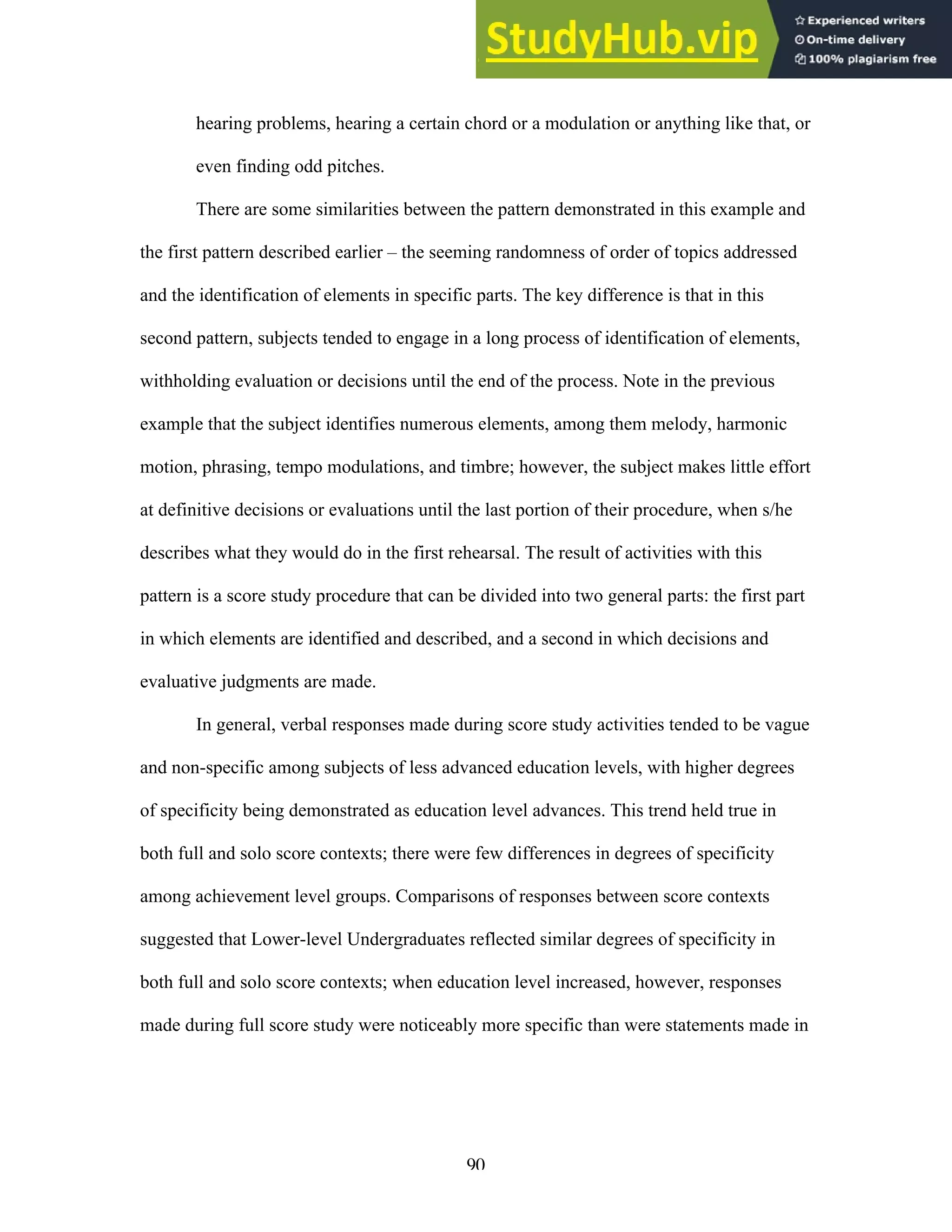
![91
solo score contexts. For example, consider the following excerpt made by a High
achiever in the Lower-level Undergraduate group working with the Bach solo score:
Well, the first thing that I notice is that is says ‘largo.’ It’s in bass clef… it may be
in G minor, yep, I believe it is [sic]. I’m noticing the fermatas, and since it’s by
Bach, it must be a Bach chorale. So, something like this, it’s not so much
phrasing, but tone and tempo. I’m just going to go ahead and run it once [subject
plays primary instrument]. All right, well, it’s pretty straightforward… I need to
think about how I want to shape the phrases, remembering what chord I am
ending on, where to break, where not to break after the fermatas, the shaping I
want to do, do I want the phrase to be quiet, do I want it to be loud, what kind of
effect to I want, so that’s pretty much all I need to think about in this one [sic]…
In this example, the subject identifies several musical elements in verbal
discussion about the score, including phrasing, tone, tempo, key, harmony, and dynamics.
Specific information regarding the treatment of these elements, however, is noticeably
absent. Rather than simply stating that s/he needed to think about ‘how I want to shape
the phrases,’ the subject might have identified two contrasting approaches to phrase
treatment, or indicated specific measures in the music and how treatment of phrases
would be applied.
When compared with the example above, the following excerpt from the same
subject working with the Arnold full score, demonstrates that differences in degrees of
specificity between the contexts is minimal:
Let’s see, it’s in 2/4, and I believe that we are in C major… I would go over the
sixteenth-note grace notes coming into the saxophone and trumpet lines. All this](https://image.slidesharecdn.com/abasicinterpretiveanalysis-230806181021-8e7fdd33/75/A-Basic-Interpretive-Analysis-101-2048.jpg)
![92
before I ever gave the first downbeat, I would just run over them, starting with the
grace notes, the 1st
and 2nd
oboes as well [sic]. I would also talk about the horns
and 1st
and 2nd
bassoons and bass clarinet and 3rd
clarinet, forte-pianos. Depending
on the knowledge of the group, I would describe them as bell tones [sic].
As was evident in the example from the solo score, the subject identifies several
elements to be addressed, and does indicate specific instrumental parts that contain the
identified elements. Through such terms as ‘I would go over…’ and ‘I would just run
over them…,’ however, a certain degree of specificity is absent. To increase the
specificity of these responses, the subject might have indicated specific steps in a
teaching sequence or specified the desired musical result (i.e. “I would want the grace
notes prior to the beat, so they hit the downbeat of the next measure together.”)
As education level increased, specificity in verbal descriptions also increased. The
following quote is from a Medium achiever in the Student Teacher group working with
the Bach score:
I guess I’ll go ahead and start off with a good forte. Make the first fermata, you
know, a decent length with a caesura after that, a full break right there. The next
one I am going to do the same way. After that I am going to start, ok, [sic] go
back to the 2nd
fermata – decrescendo that one so I can set up a more mezzo-piano
in the third phrase, probably do some ritard at the end of that one. No break at the
end of that fermata, no break and a crescendo up to the next phrase, so the next
one will be at a forte. Full break at the end of the 4th
fermata…
Apart from the differences in degree of specificity described earlier, note also the
subject’s use of professional terminology – whereas the Lower-level Undergraduate](https://image.slidesharecdn.com/abasicinterpretiveanalysis-230806181021-8e7fdd33/75/A-Basic-Interpretive-Analysis-102-2048.jpg)
![93
described dynamics with the terms ‘loud’ and ‘quiet,’ the Student Teacher subject used
specific degrees of dynamic level (forte, mezzo-piano) and contrasting manipulations of
dynamics (crescendo, decrescendo).
The increase in specificity within verbal descriptions in relation to increase in
education level was evident also in full score contexts. The following excerpt is from the
transcript of an Upper-level Undergraduate (a Medium achiever) working with the Reed
full score:
I want the moving lines, where the trumpets have quarter notes or the trombones
have quarter notes, and especially when they have eighth notes and it’s going up
and down, to kind of bring that out and then pull back whenever they go through
it. And the same in the woodwinds, and same at measure 19 when it goes back to
the brass. I see that the bass line has the moving part in the second and the third
trombones at 19, going towards the end. I think that at the end of 19, the phrasing,
I want to kind of back down the melody so that the counter-point, the bass line
can be brought out – actually, the harmonies at the end, like at the end before it
reaches the final fermata [sic] …
There are certain areas within this example where specificity within verbal
descriptions is lacking; for example, the phrase “…and especially when they have eighth
notes and it’s going up and down, to kind of bring that out and then pull back whenever
they go through it…” might be interpreted to mean dynamic treatment, tempo treatment,
balance, texture, or any combination of these elements. There are, however, several areas
addressed in specific terms, such as location of the element being considered (in terms of](https://image.slidesharecdn.com/abasicinterpretiveanalysis-230806181021-8e7fdd33/75/A-Basic-Interpretive-Analysis-103-2048.jpg)
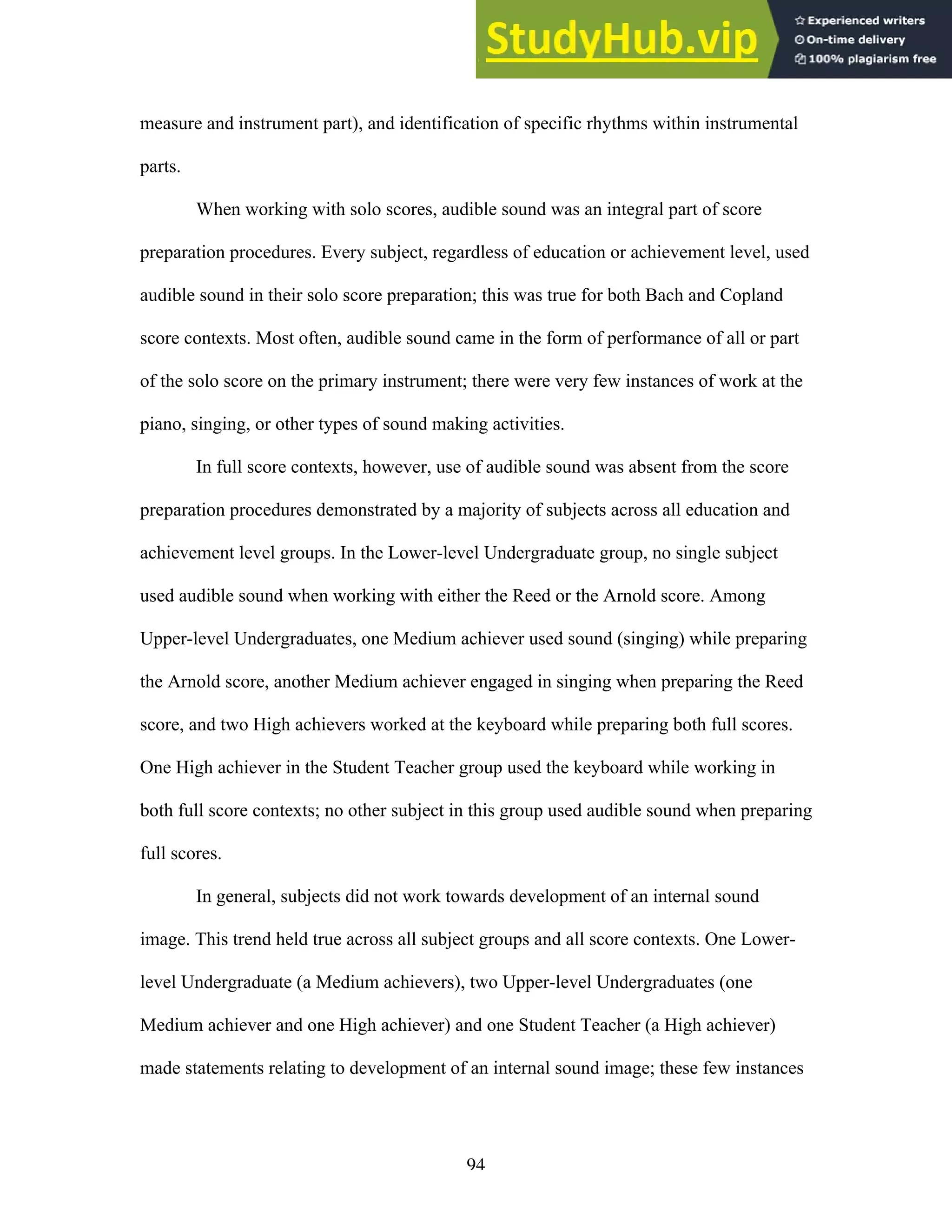

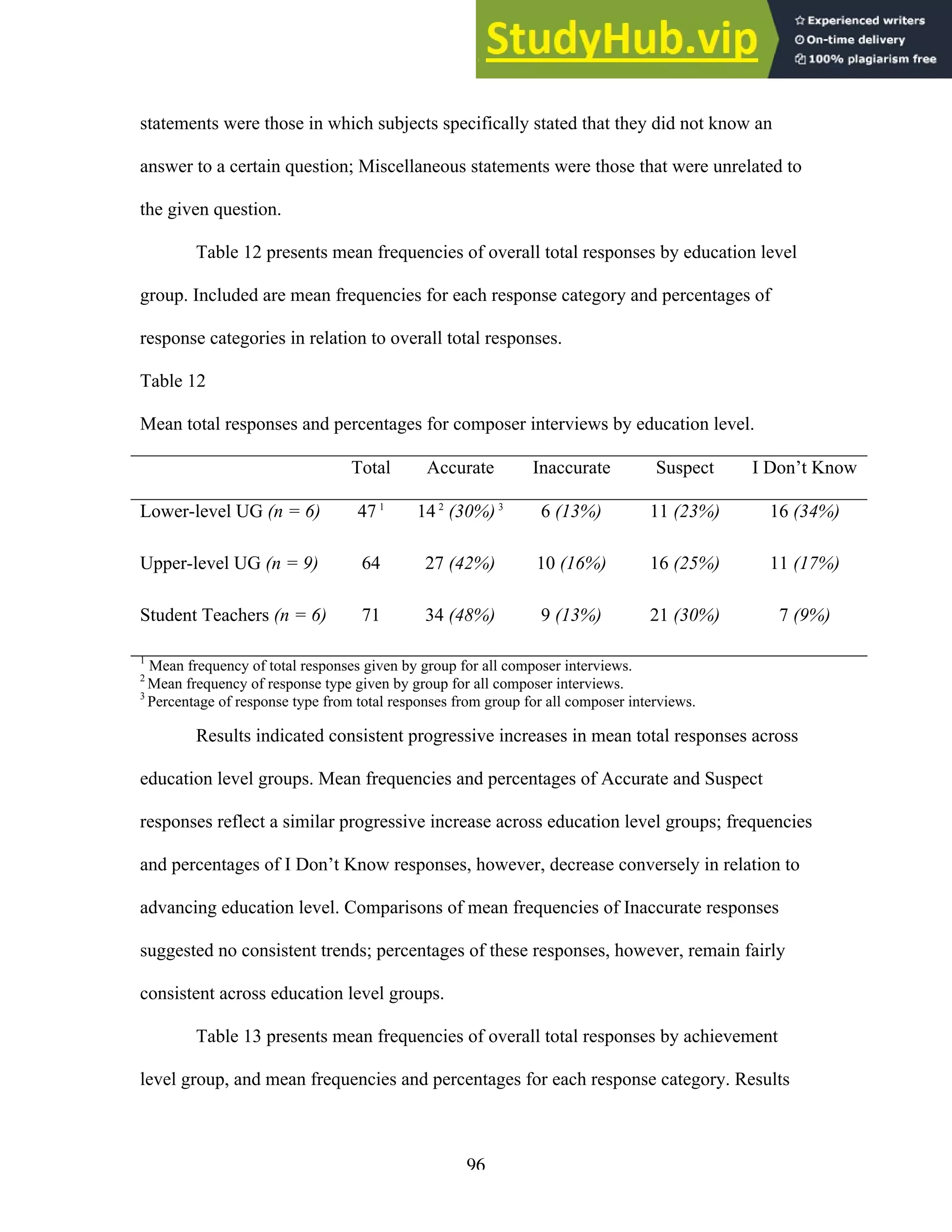
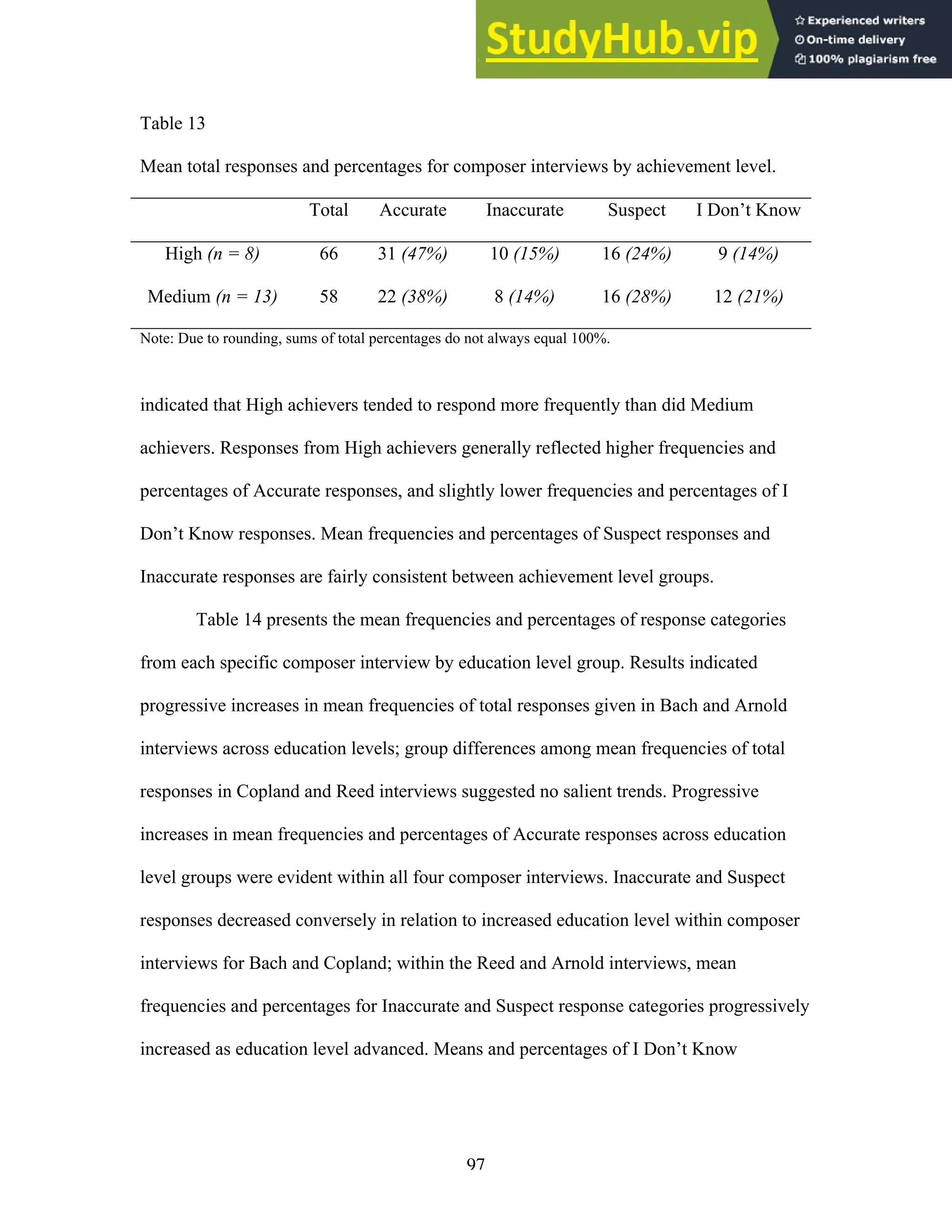
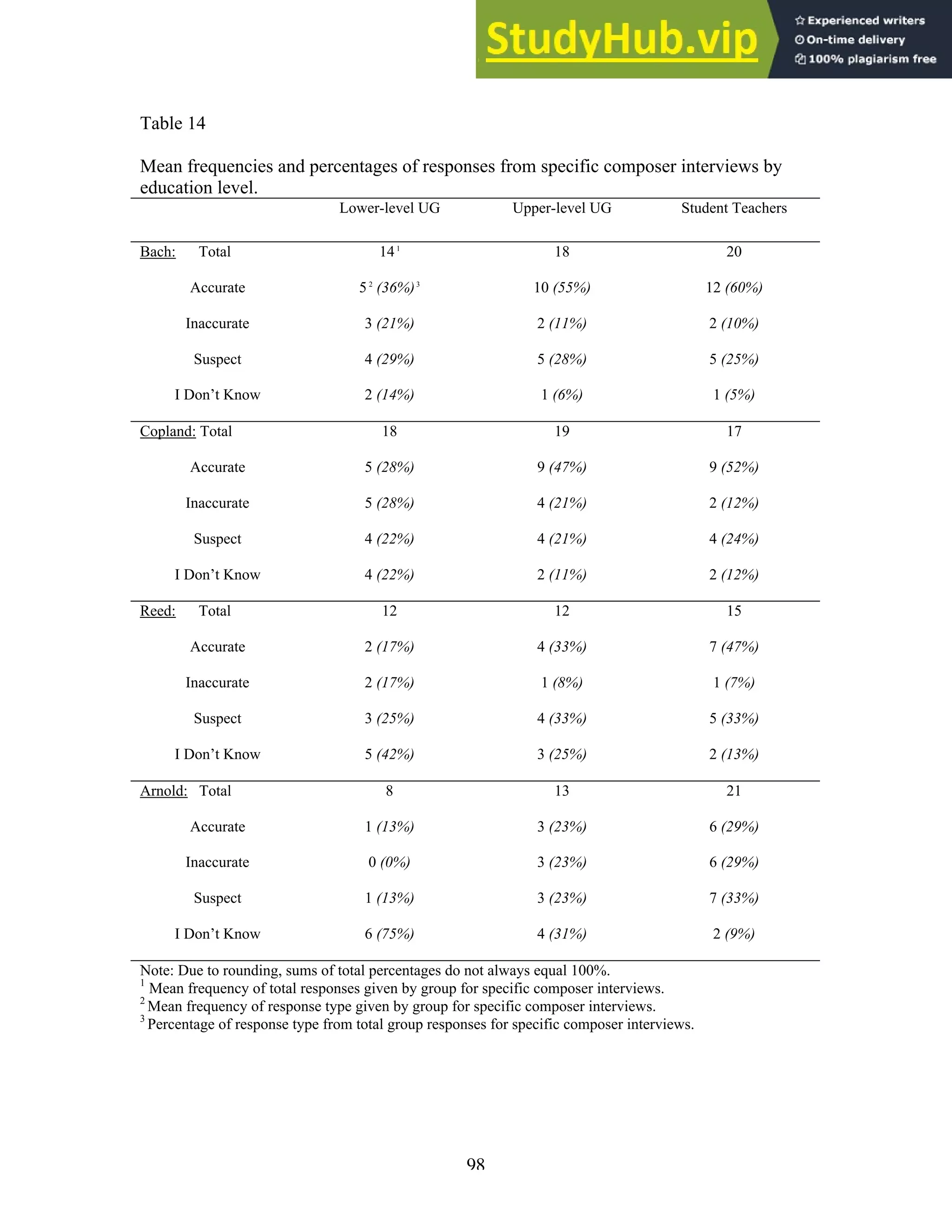

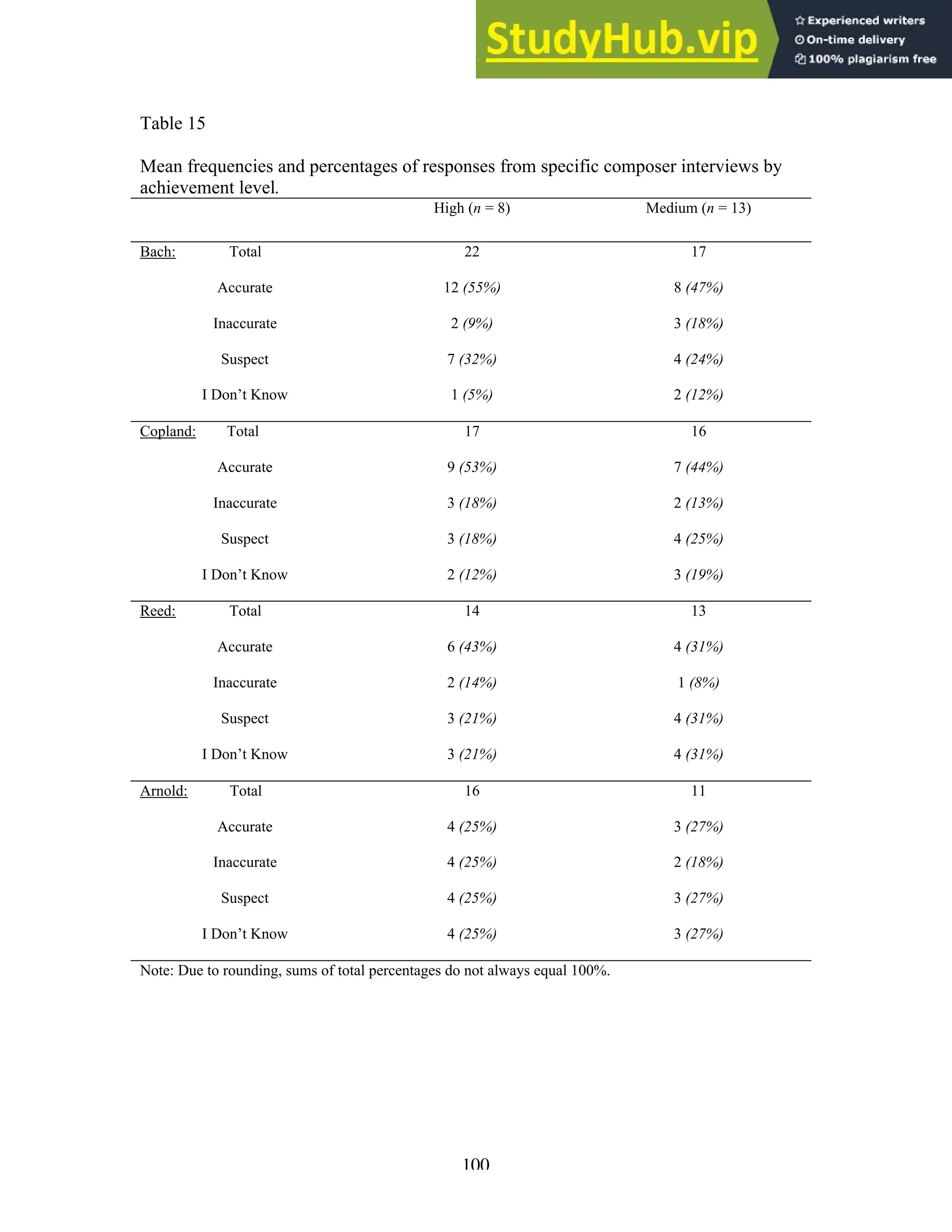
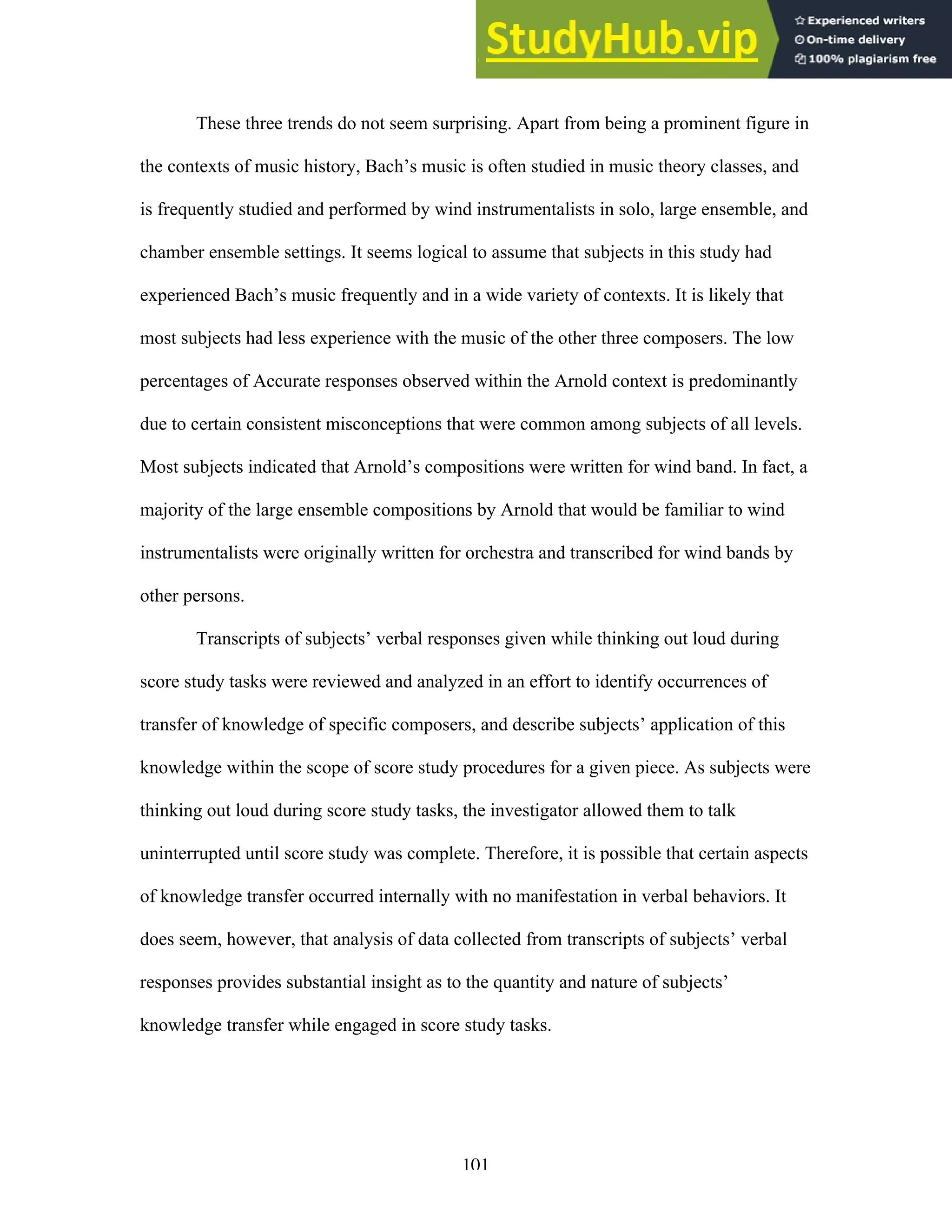


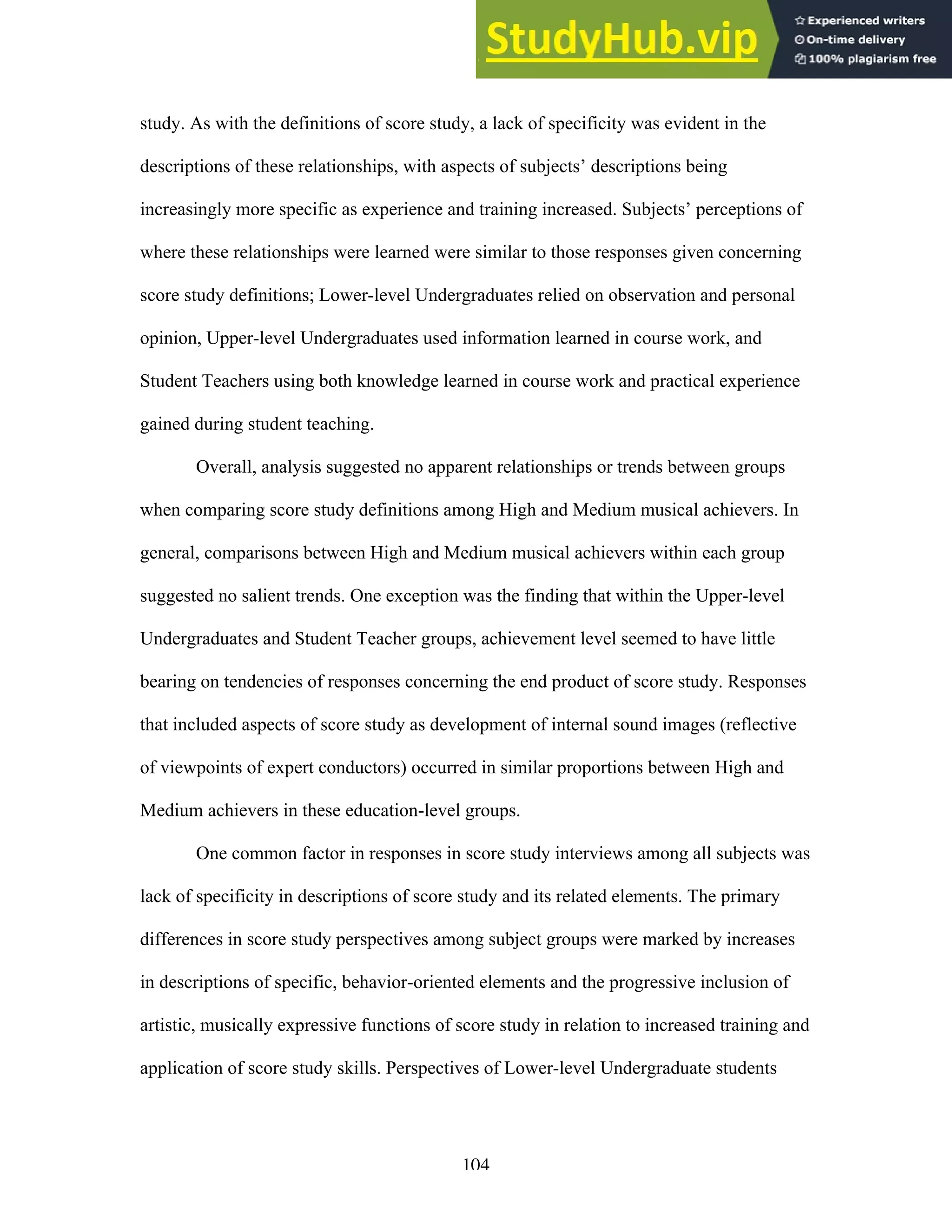

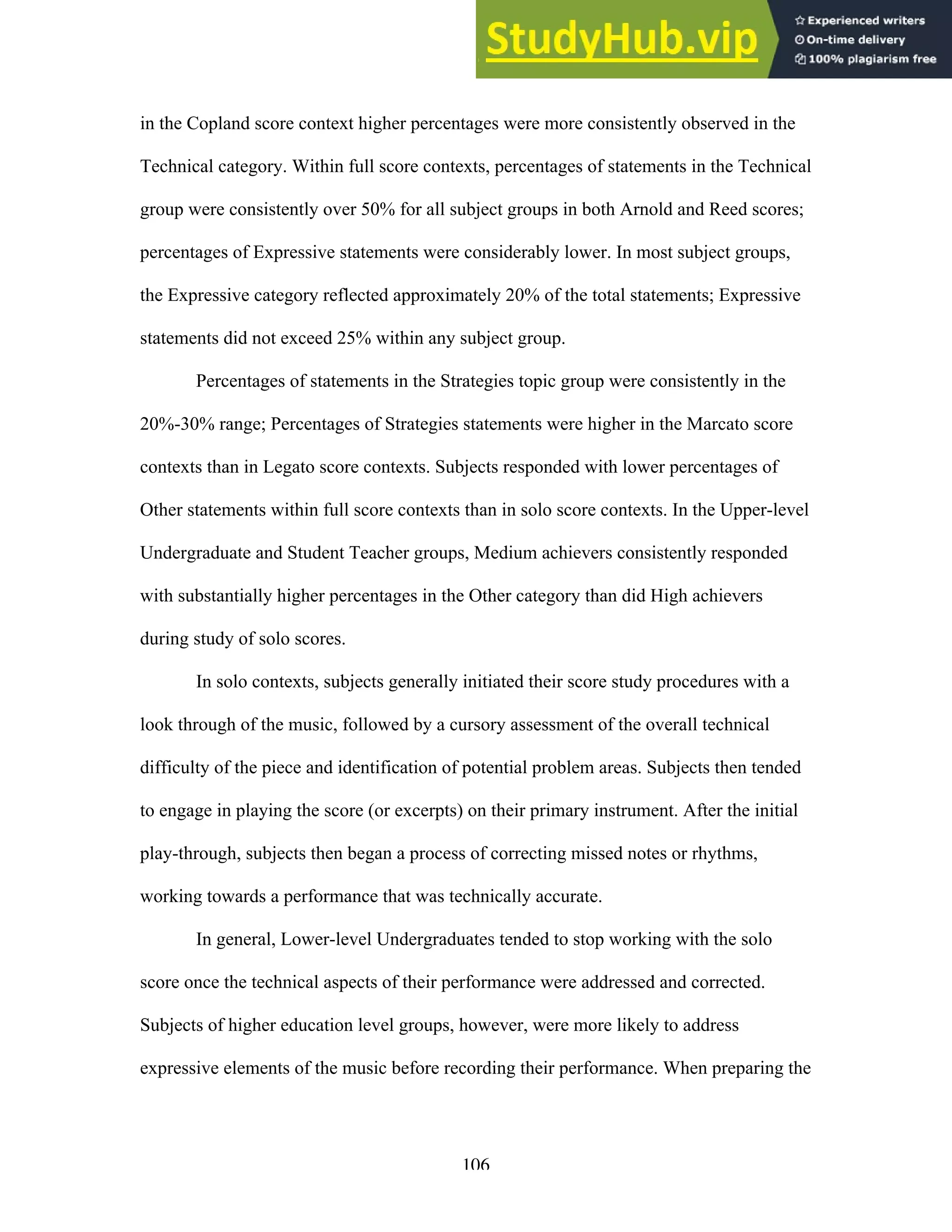

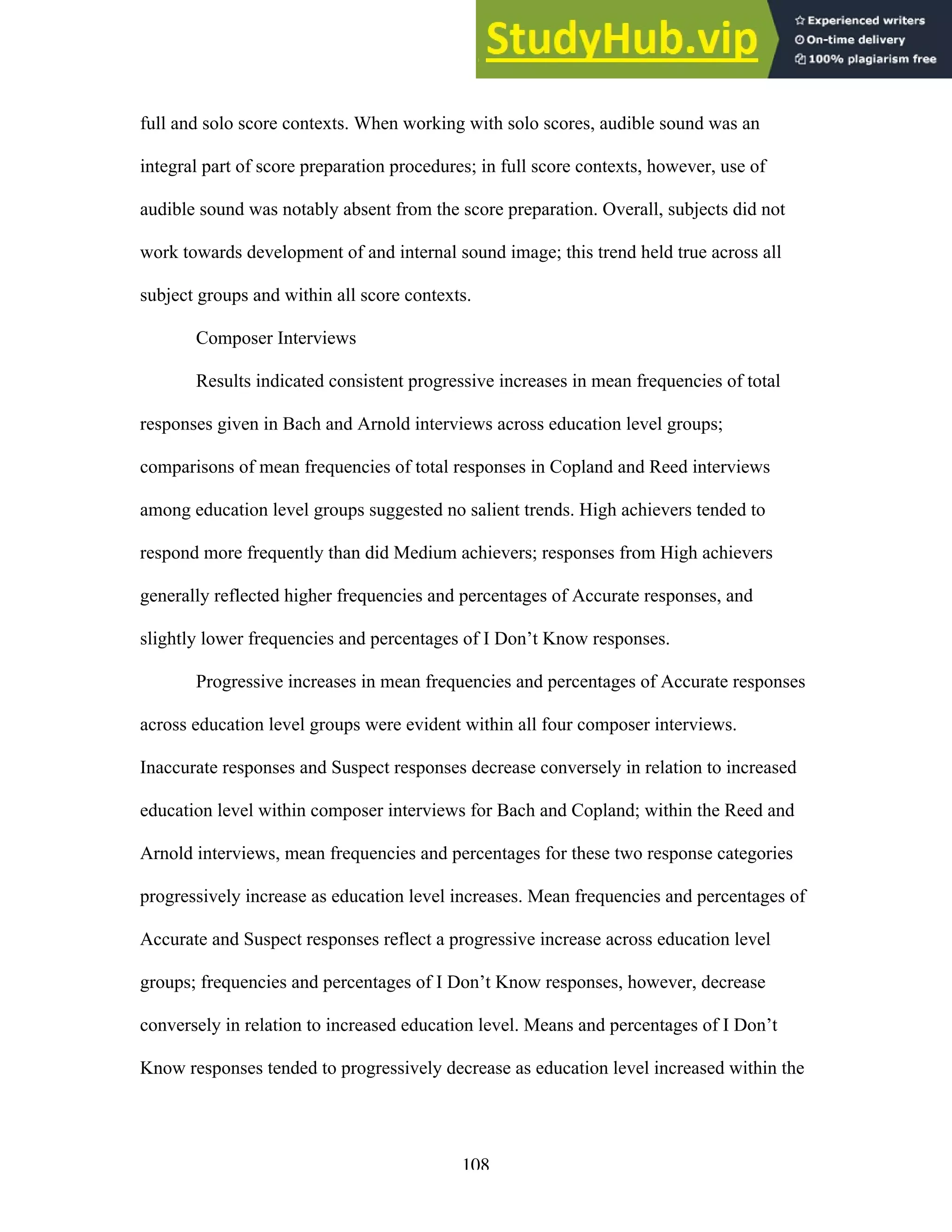
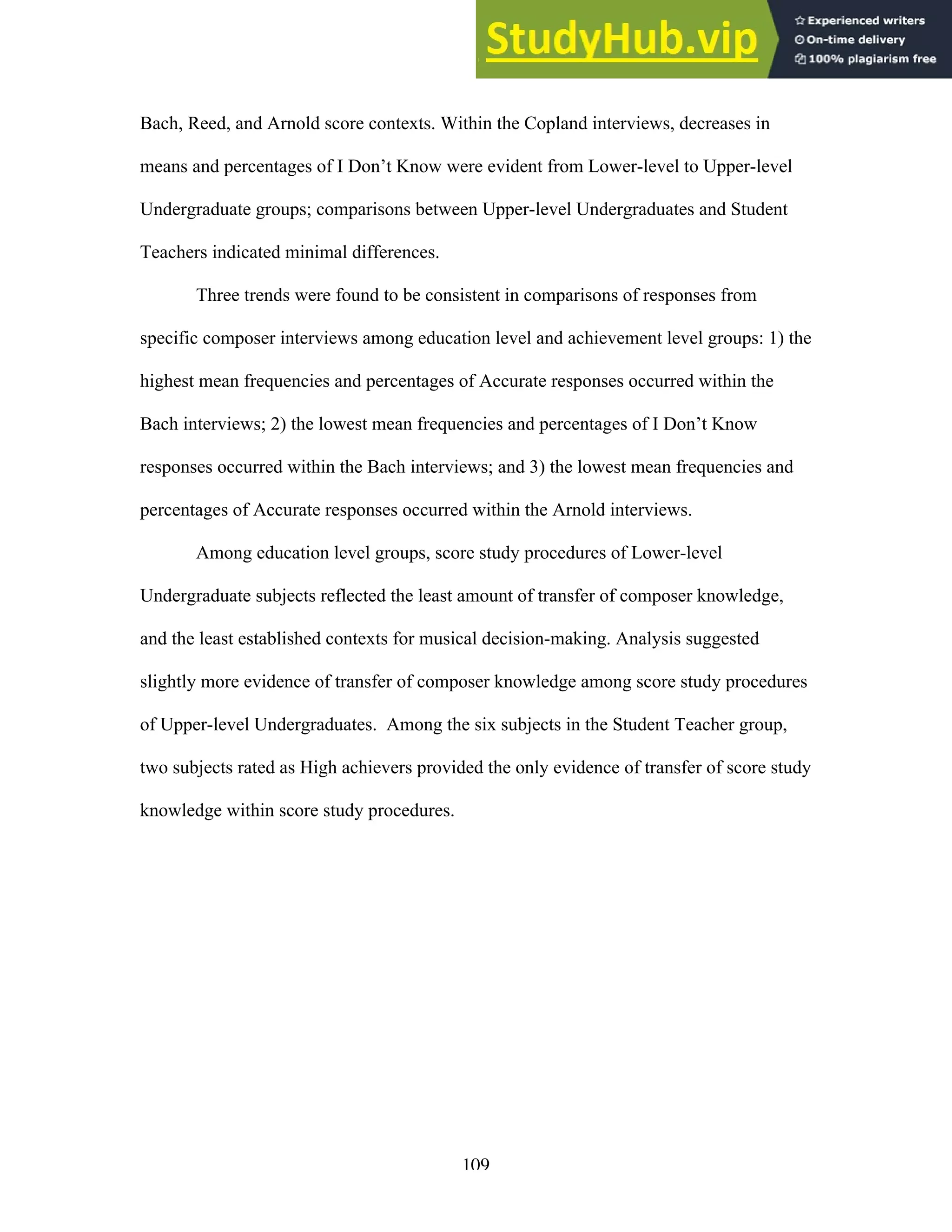
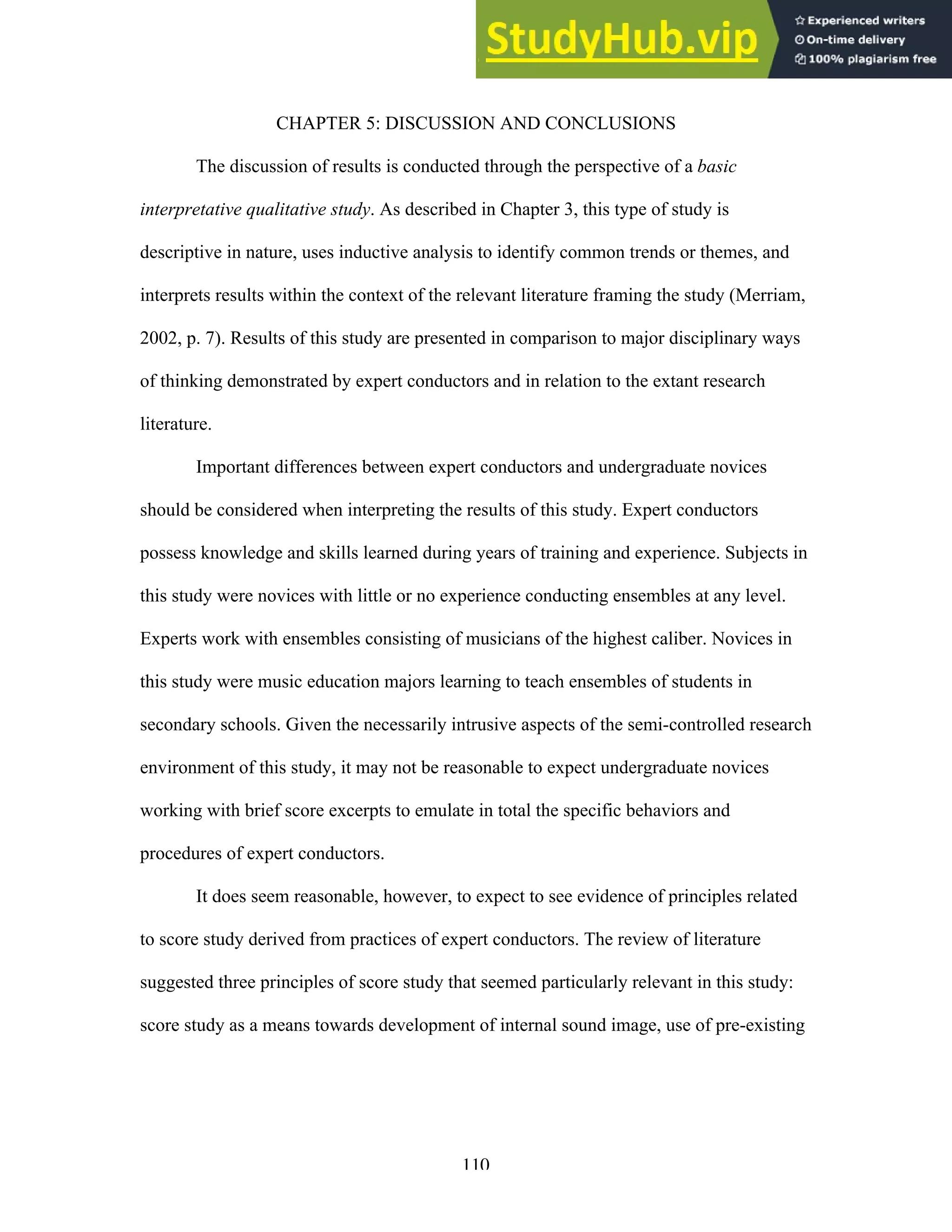
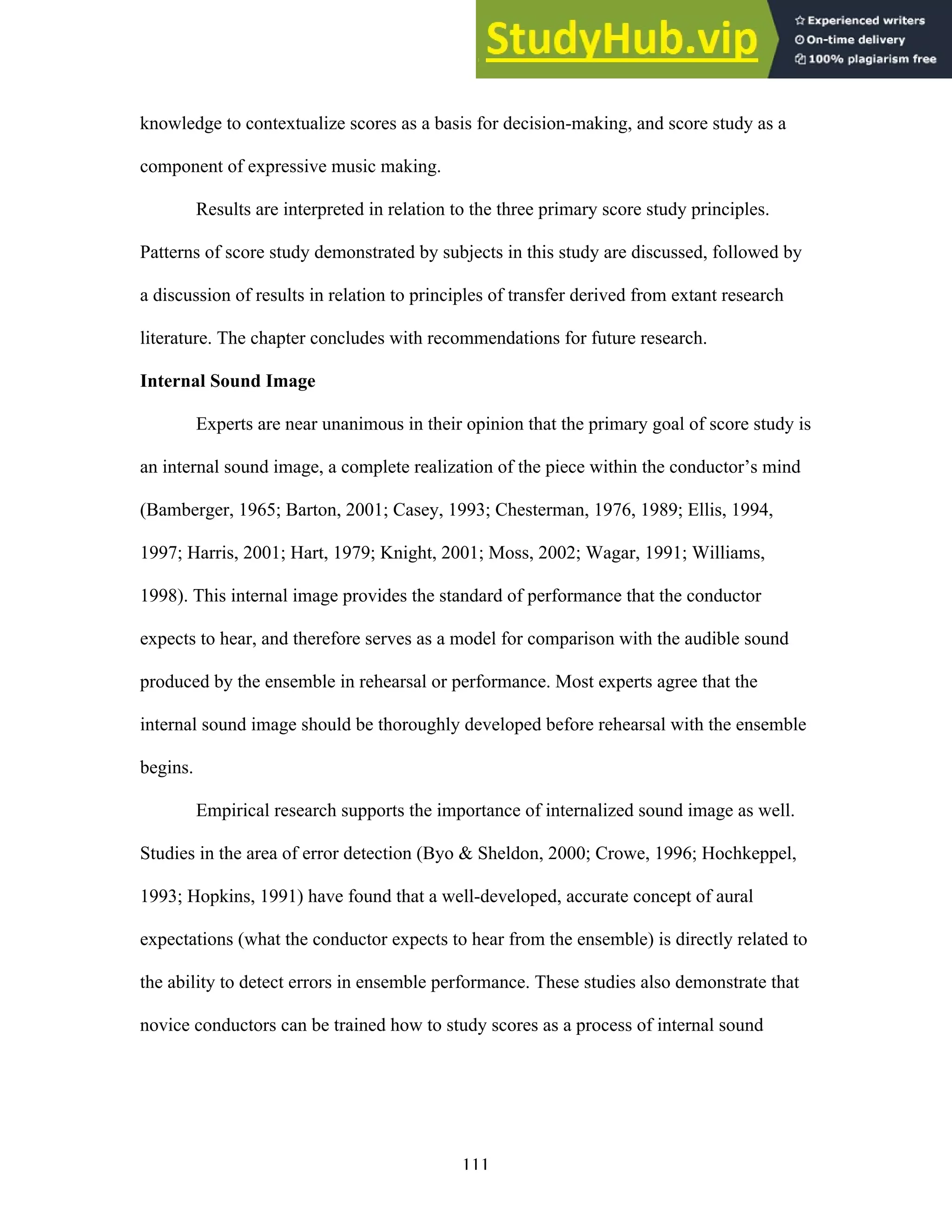
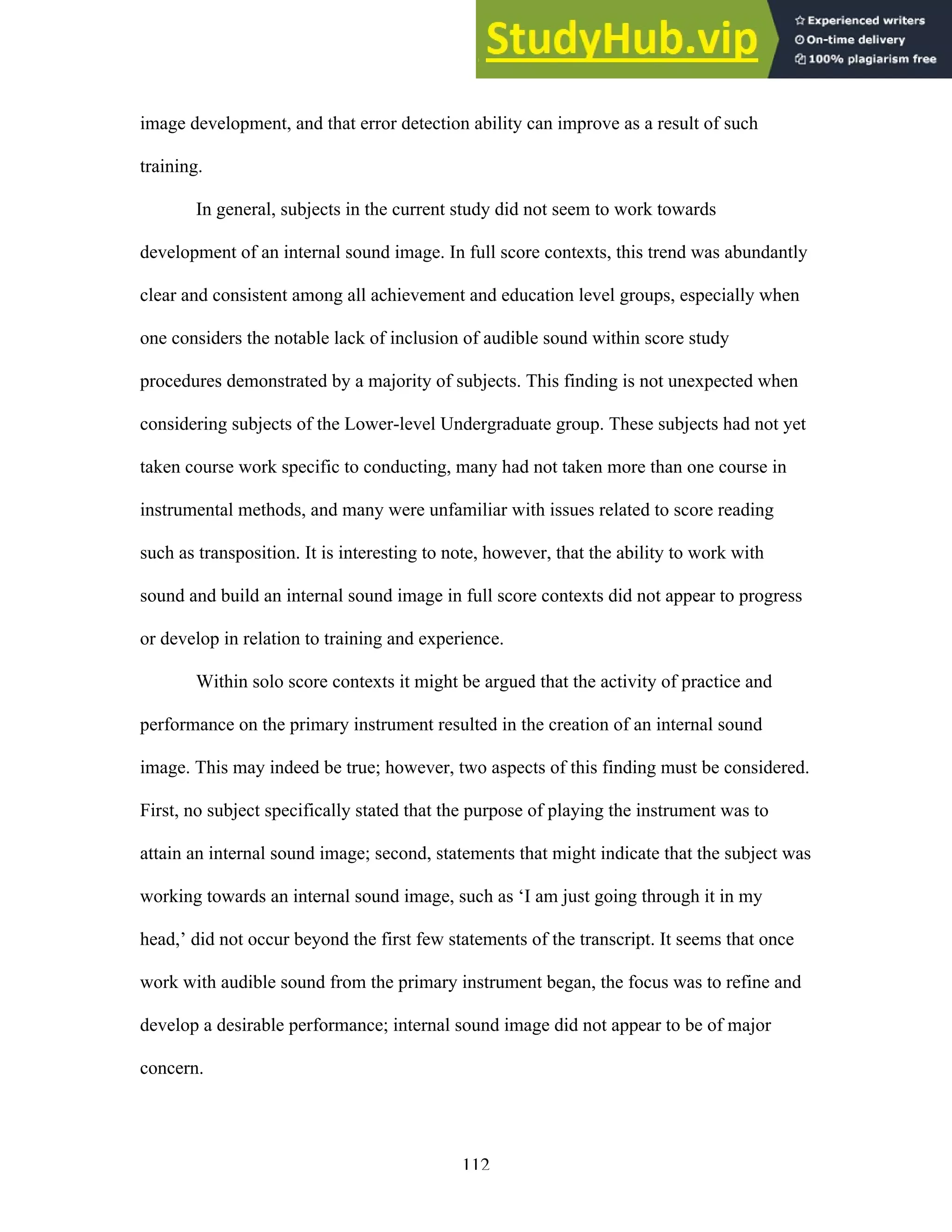
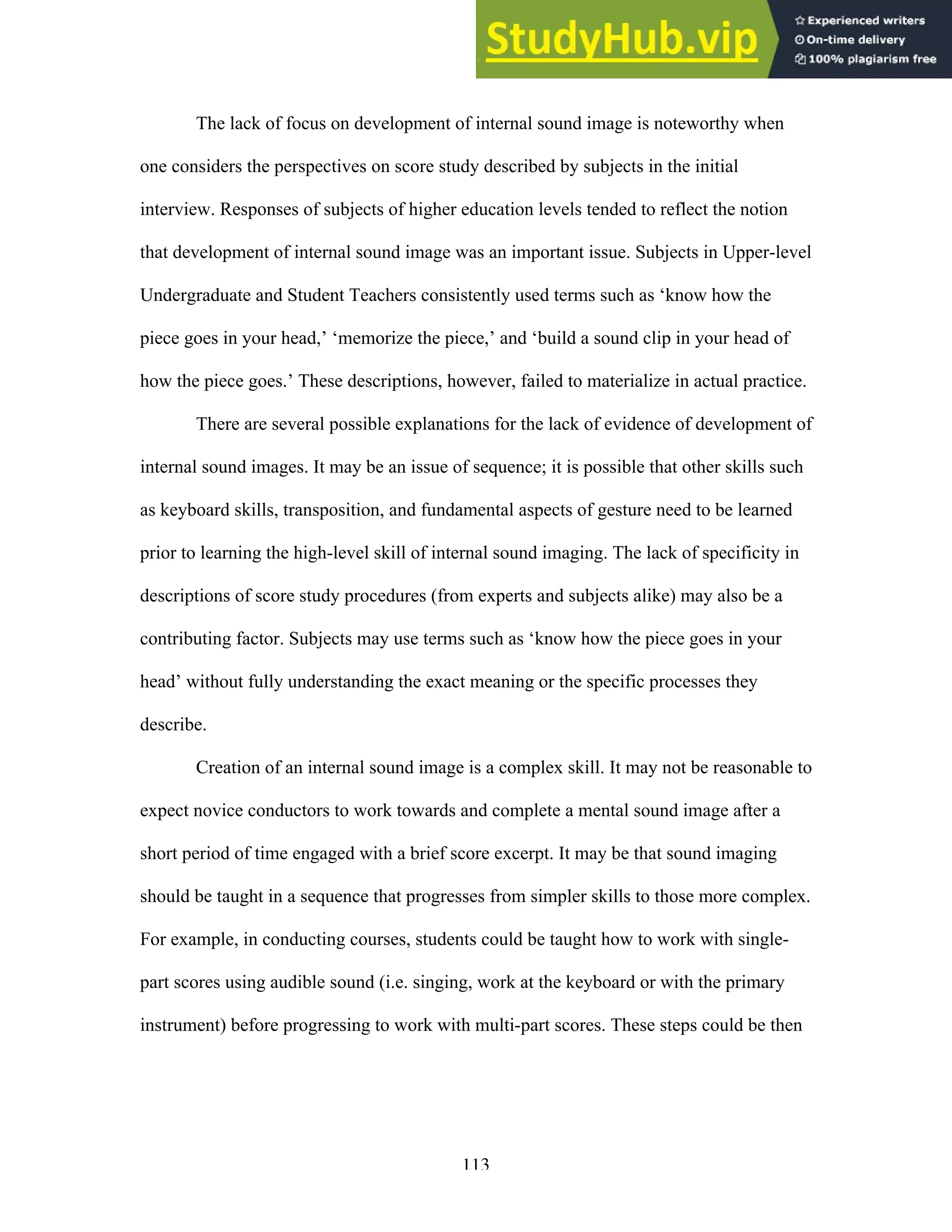
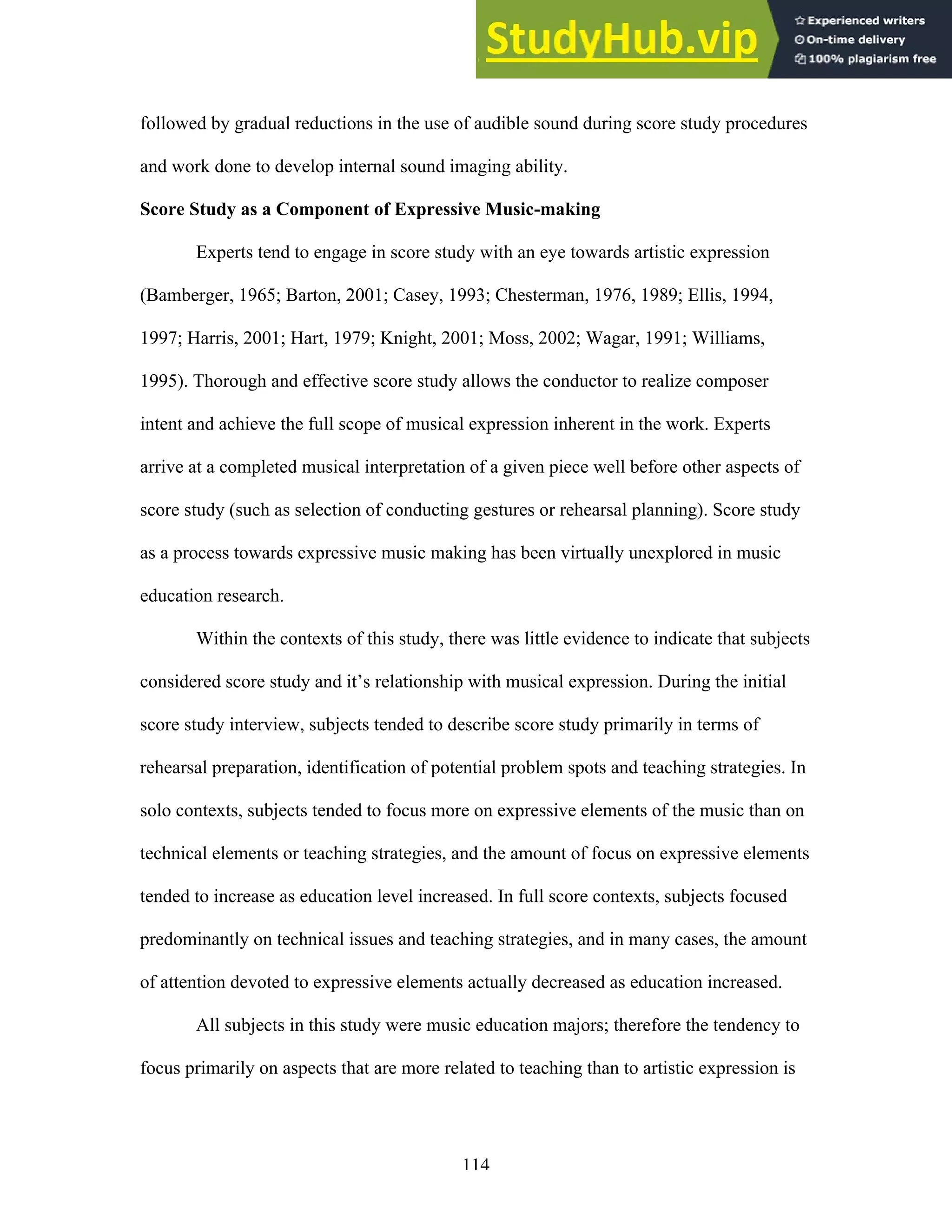
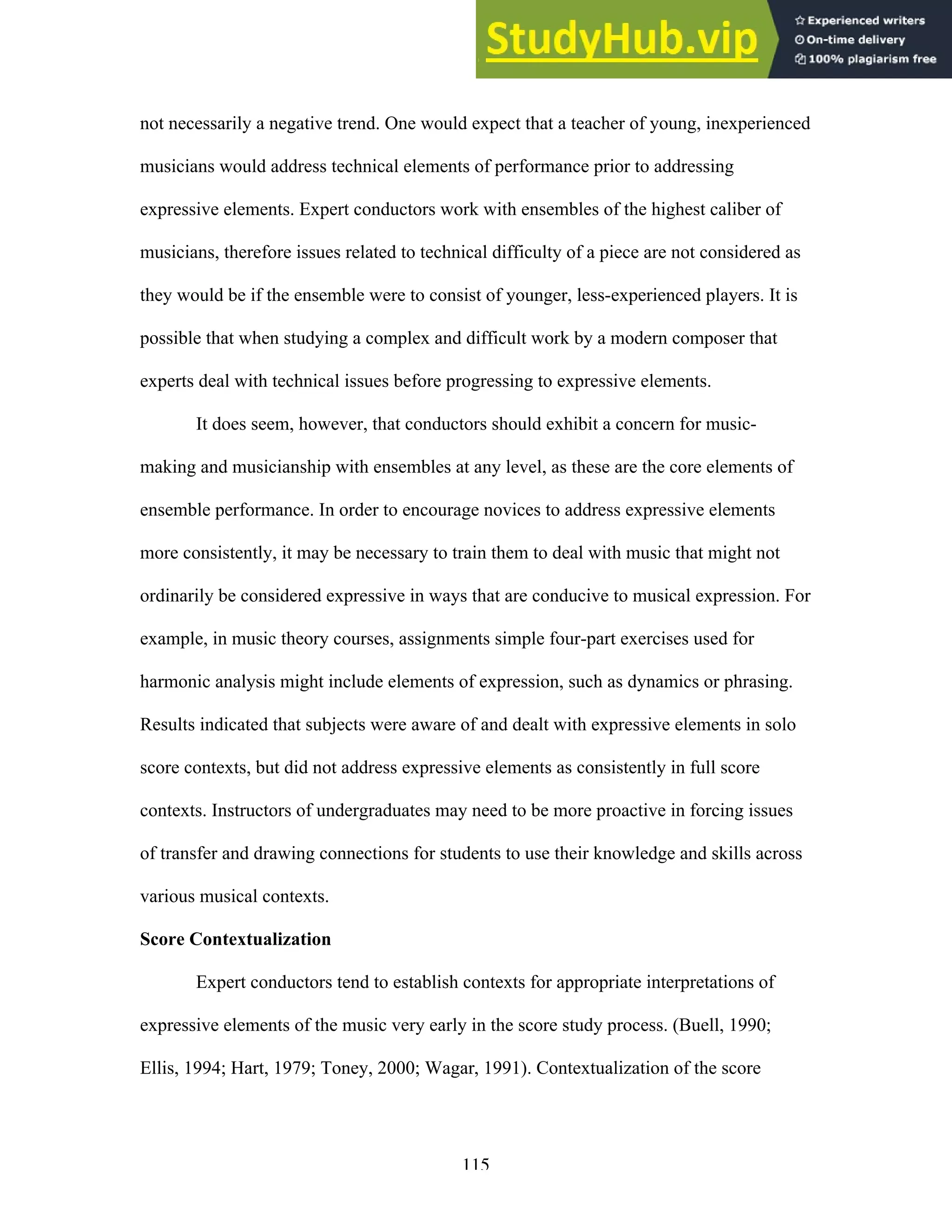
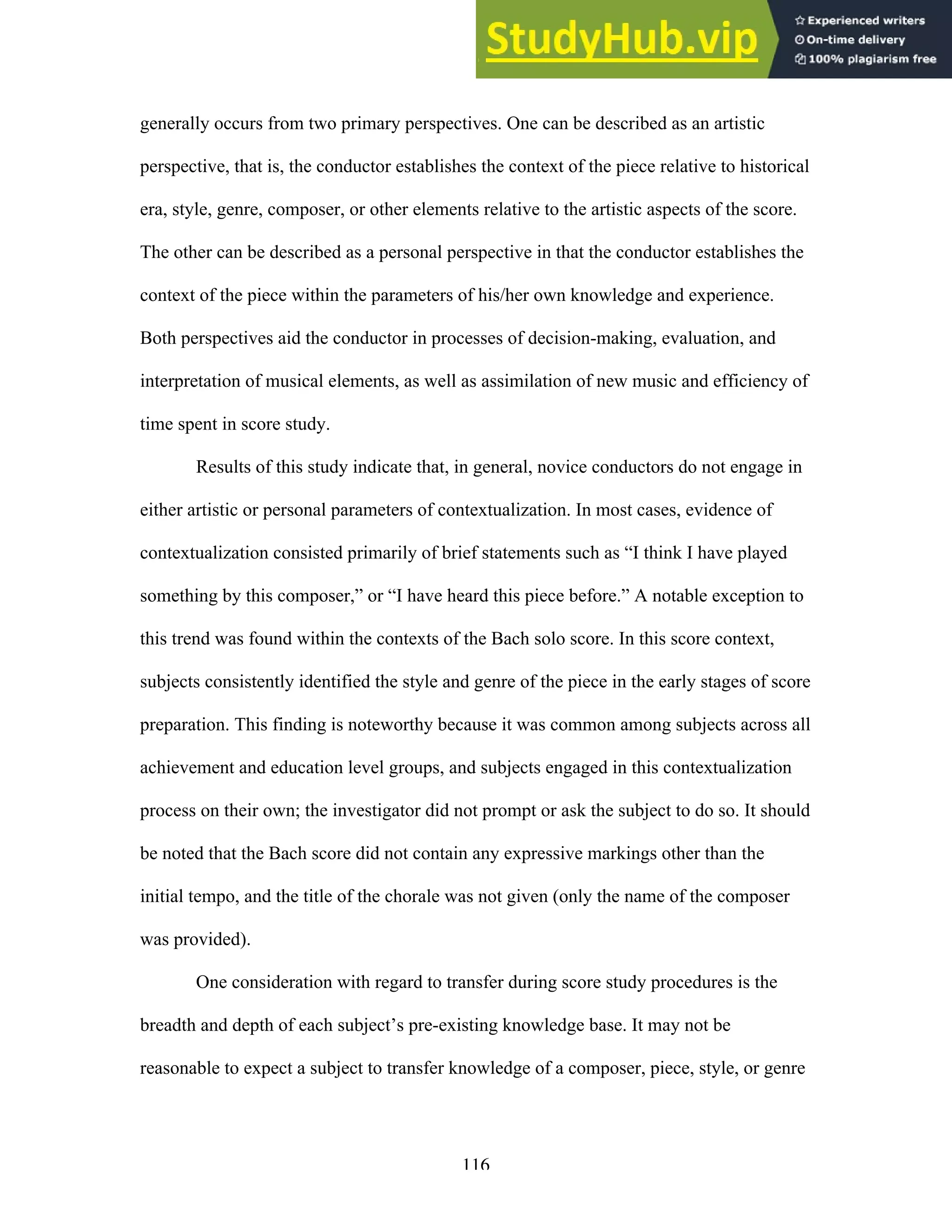
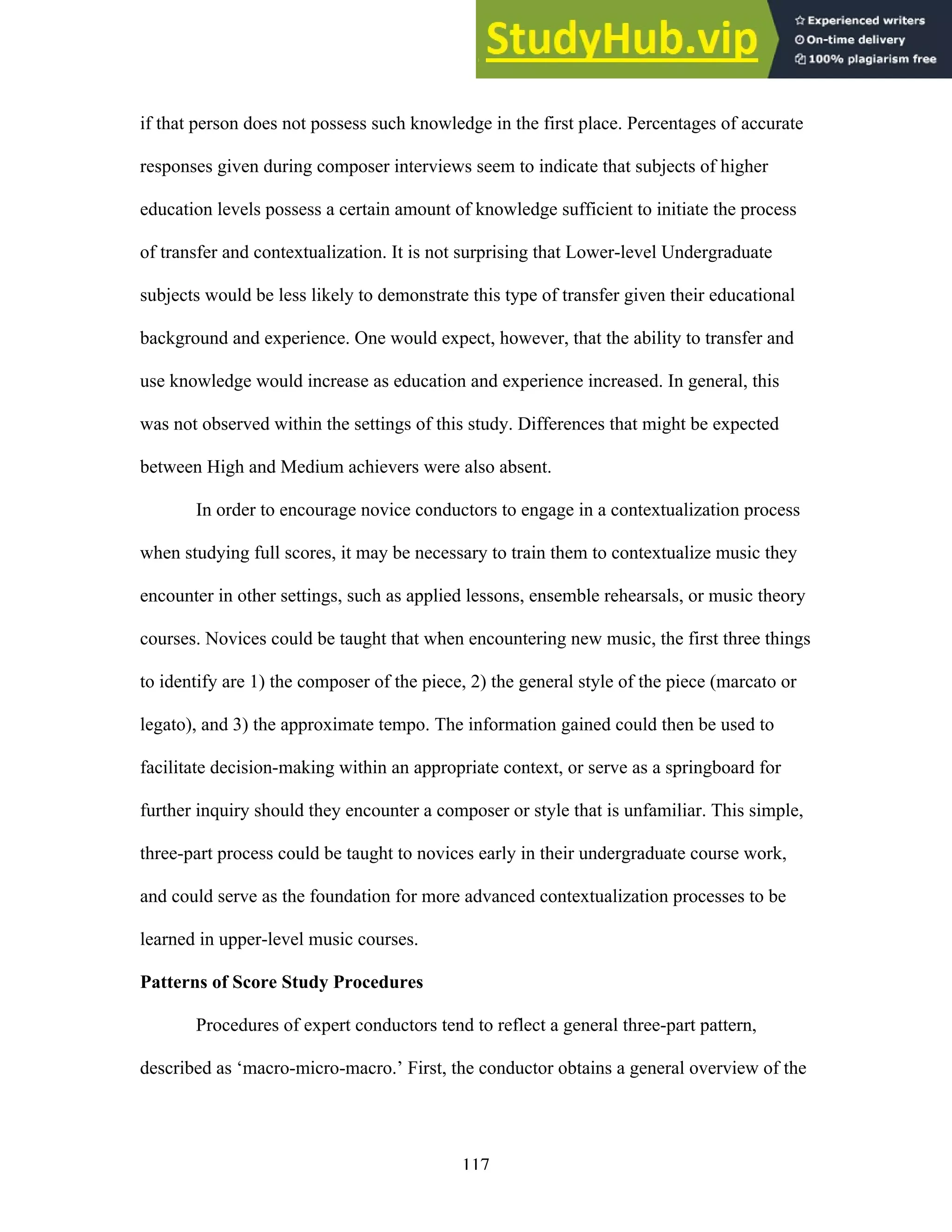
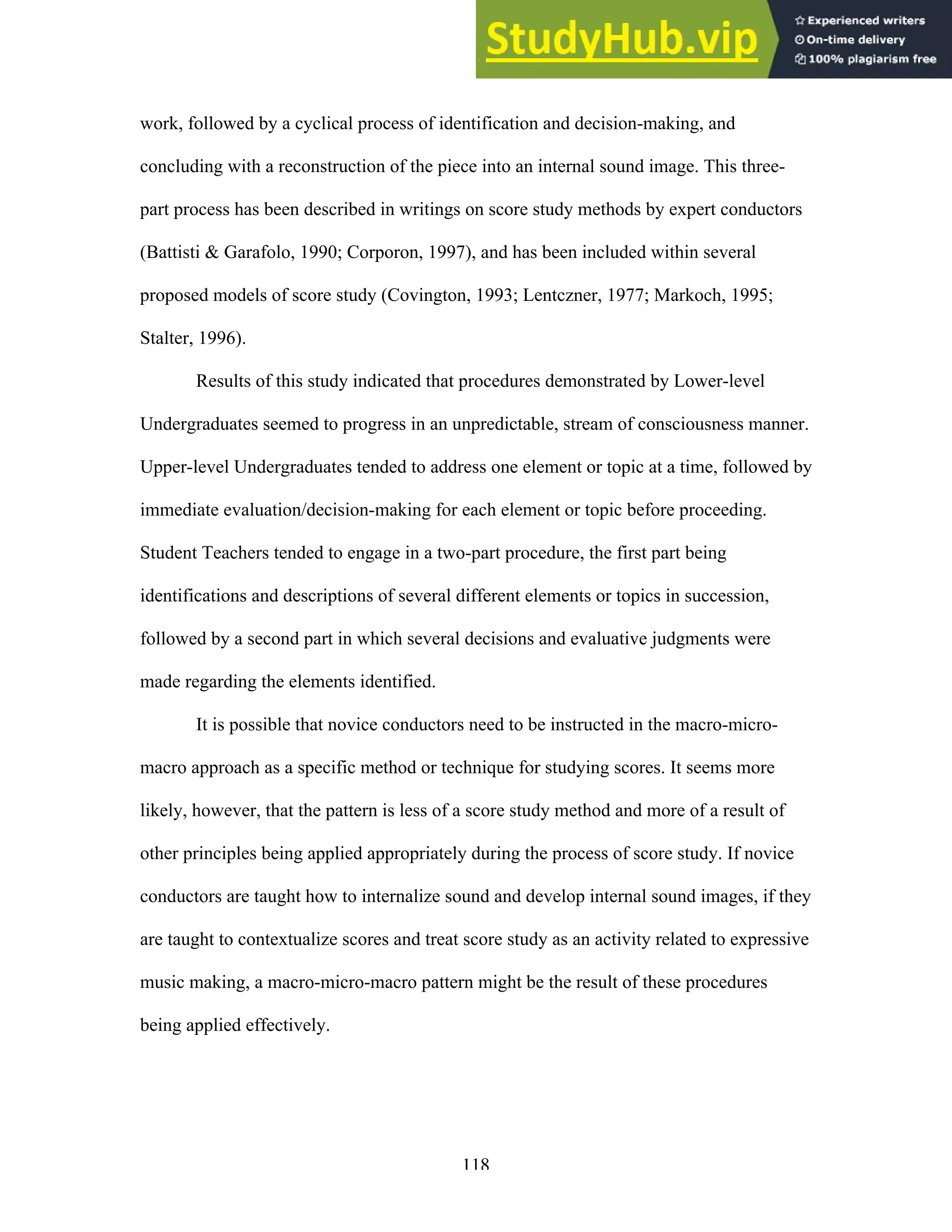
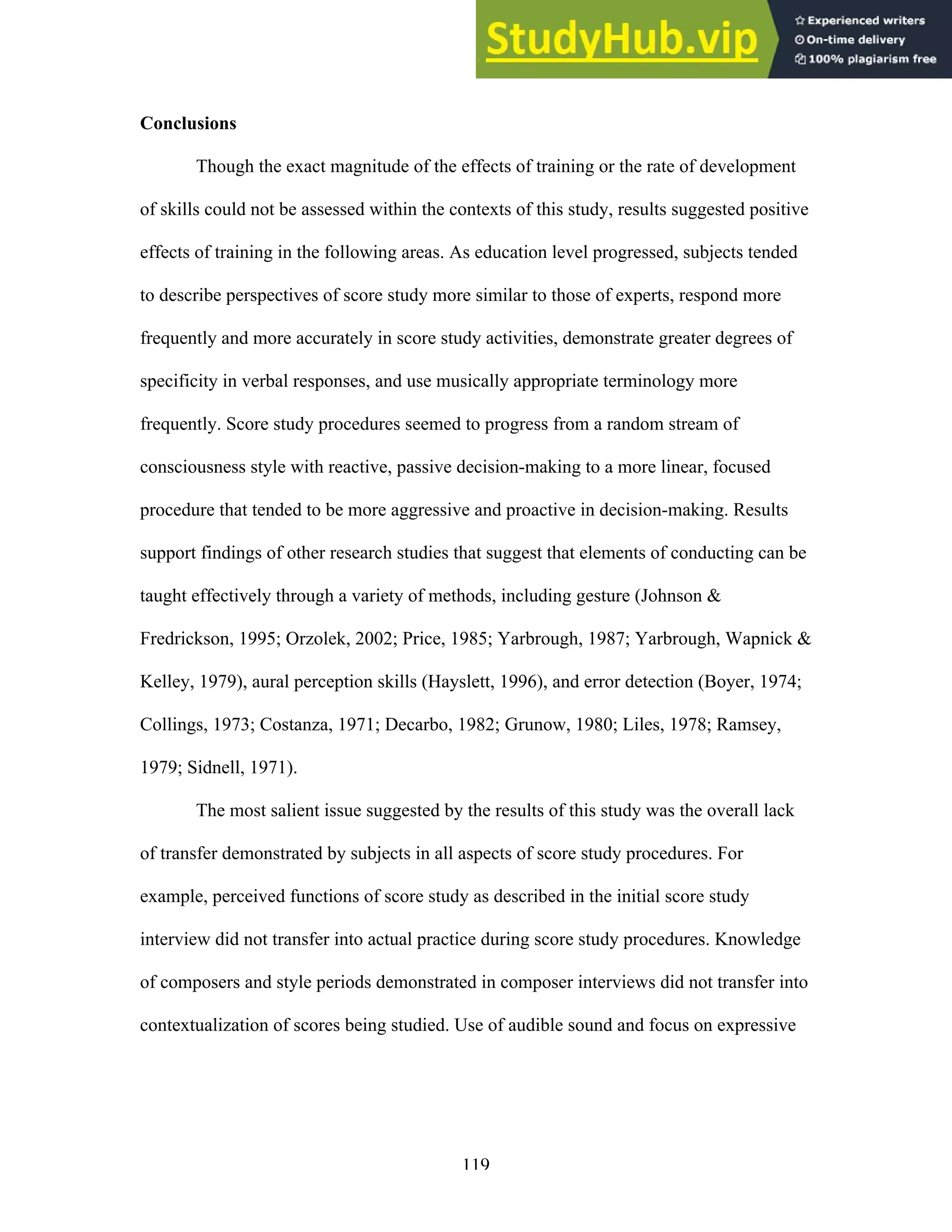
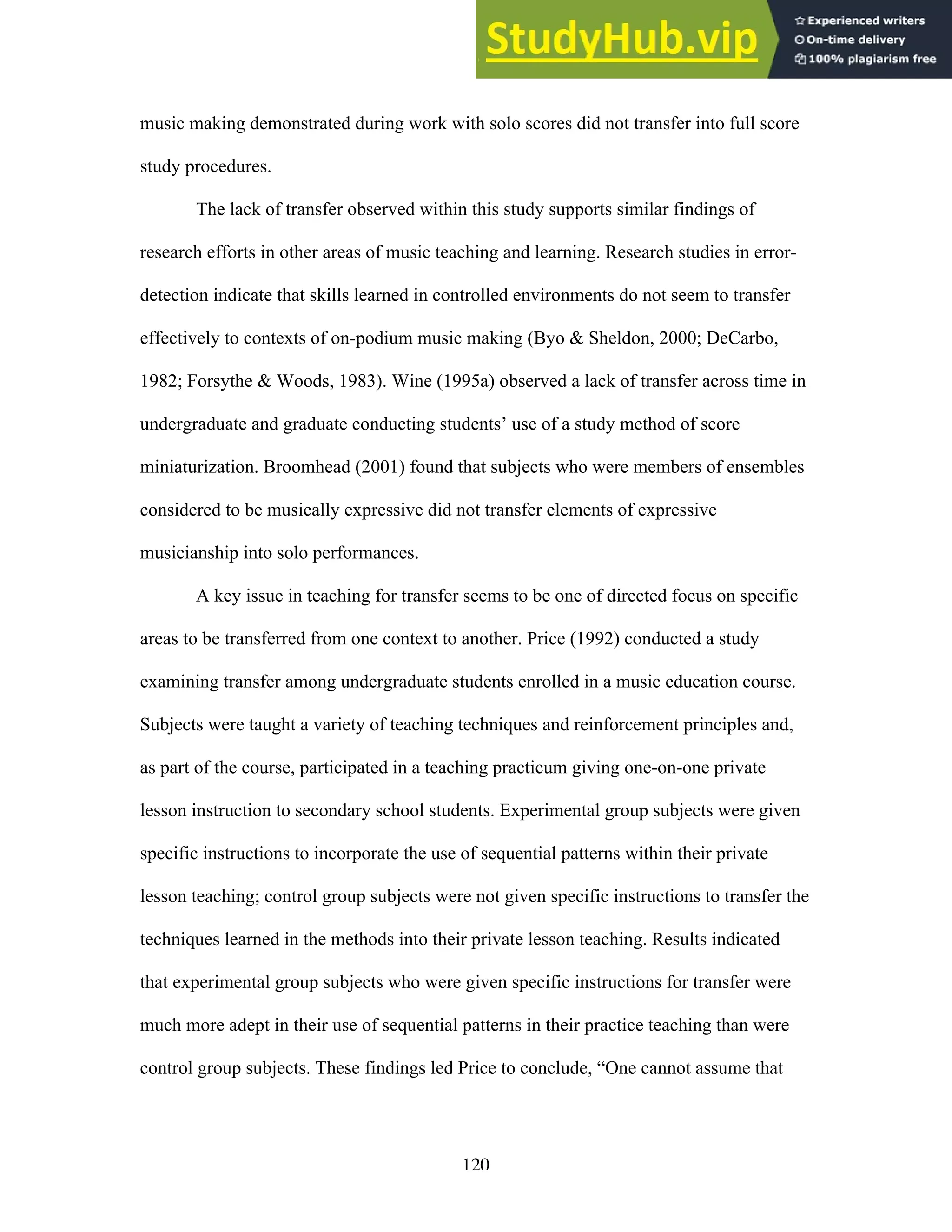
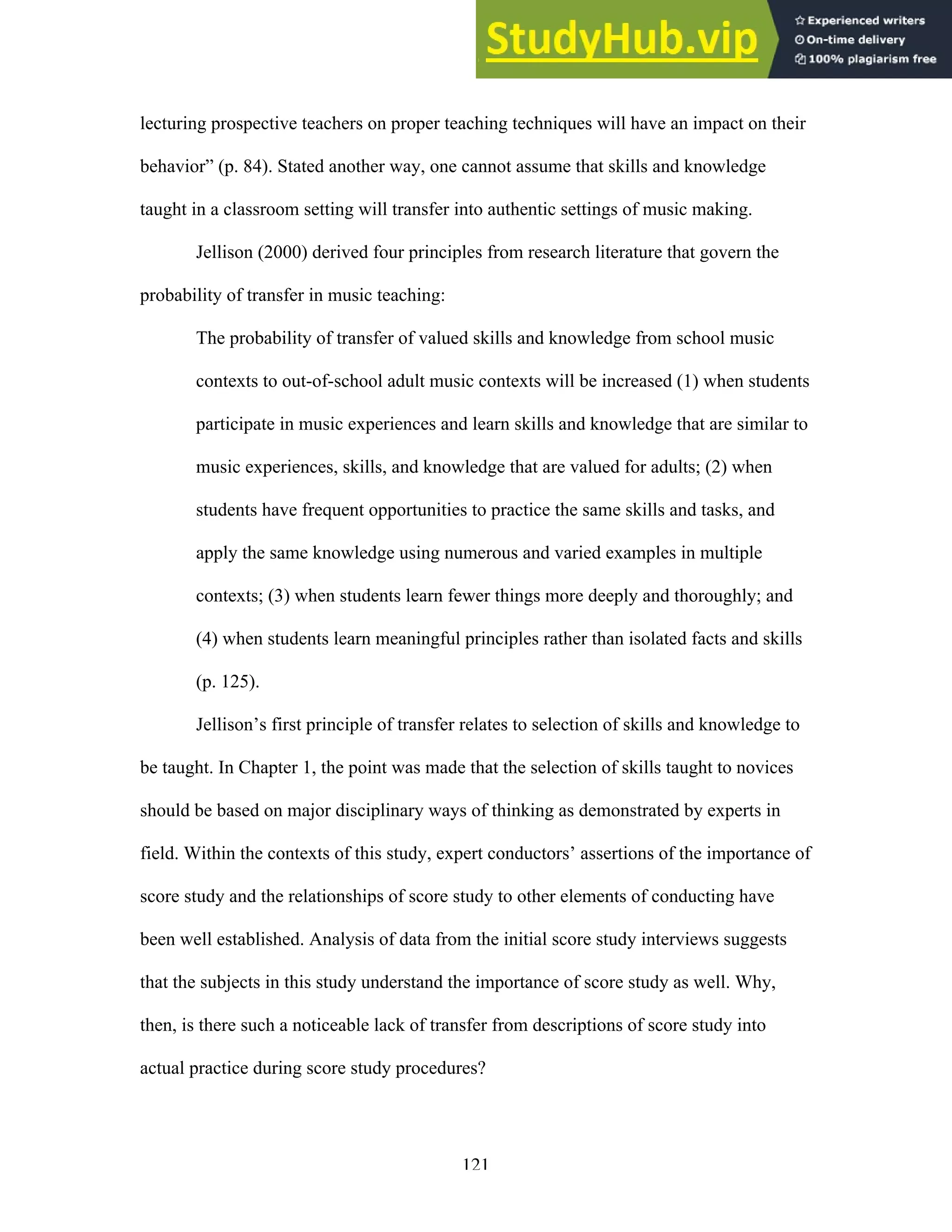
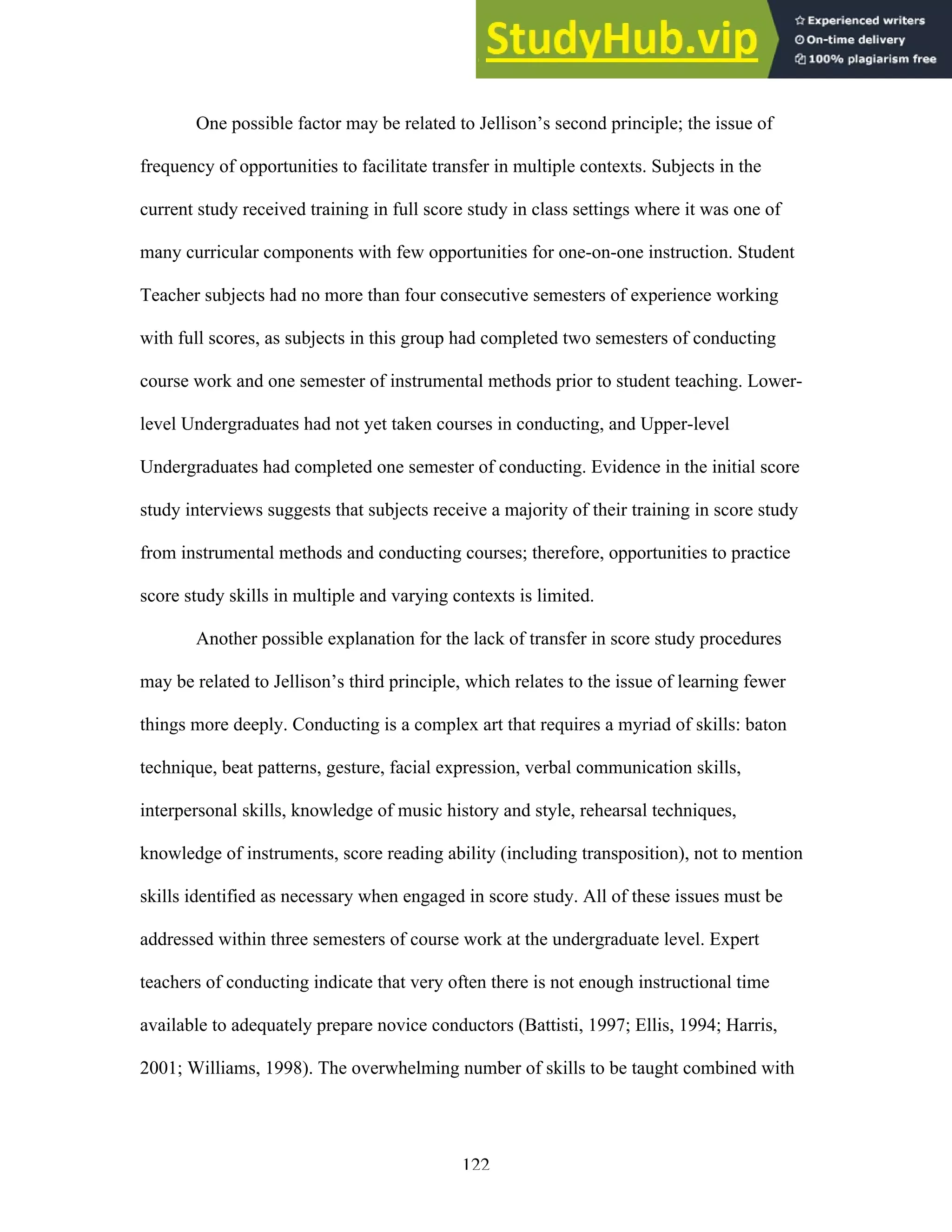
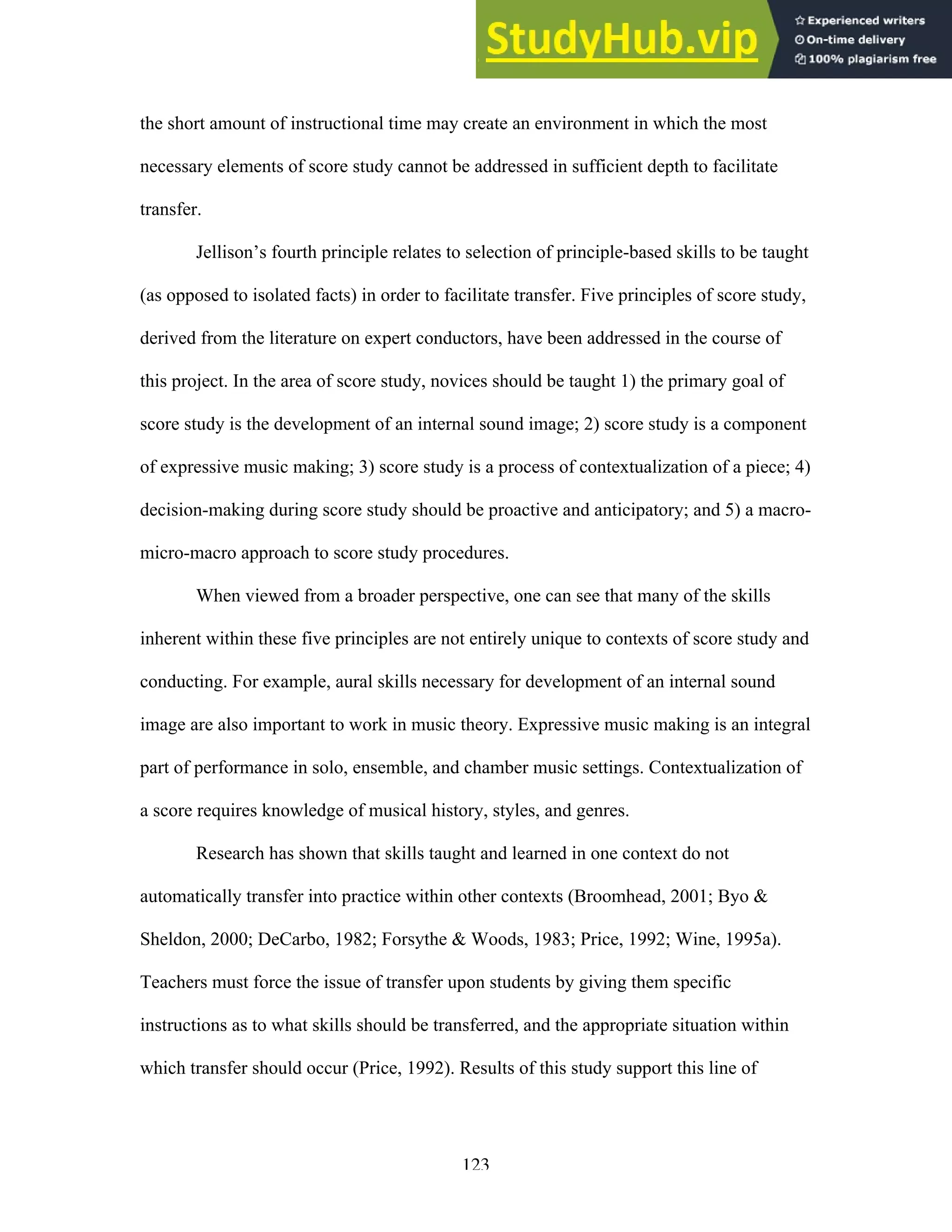
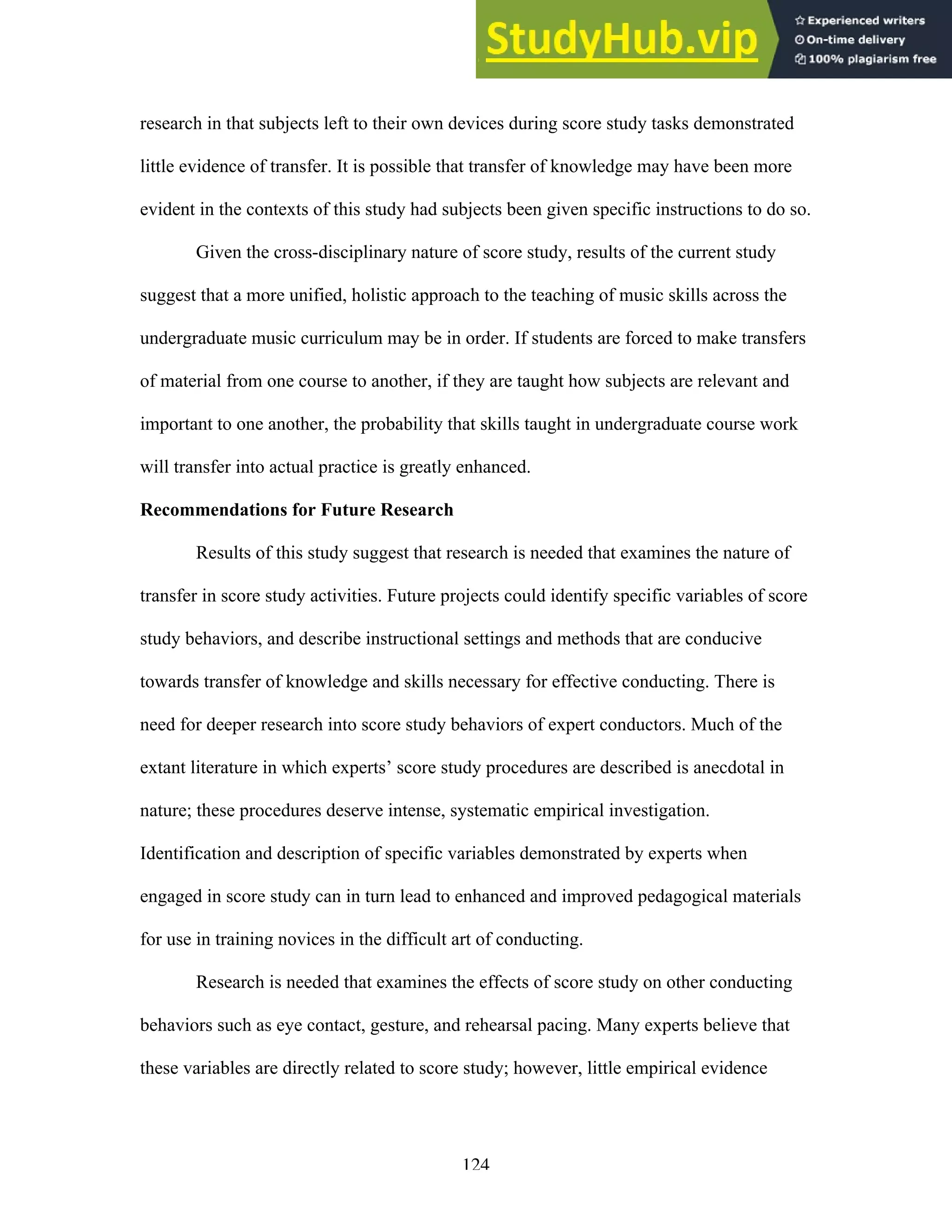
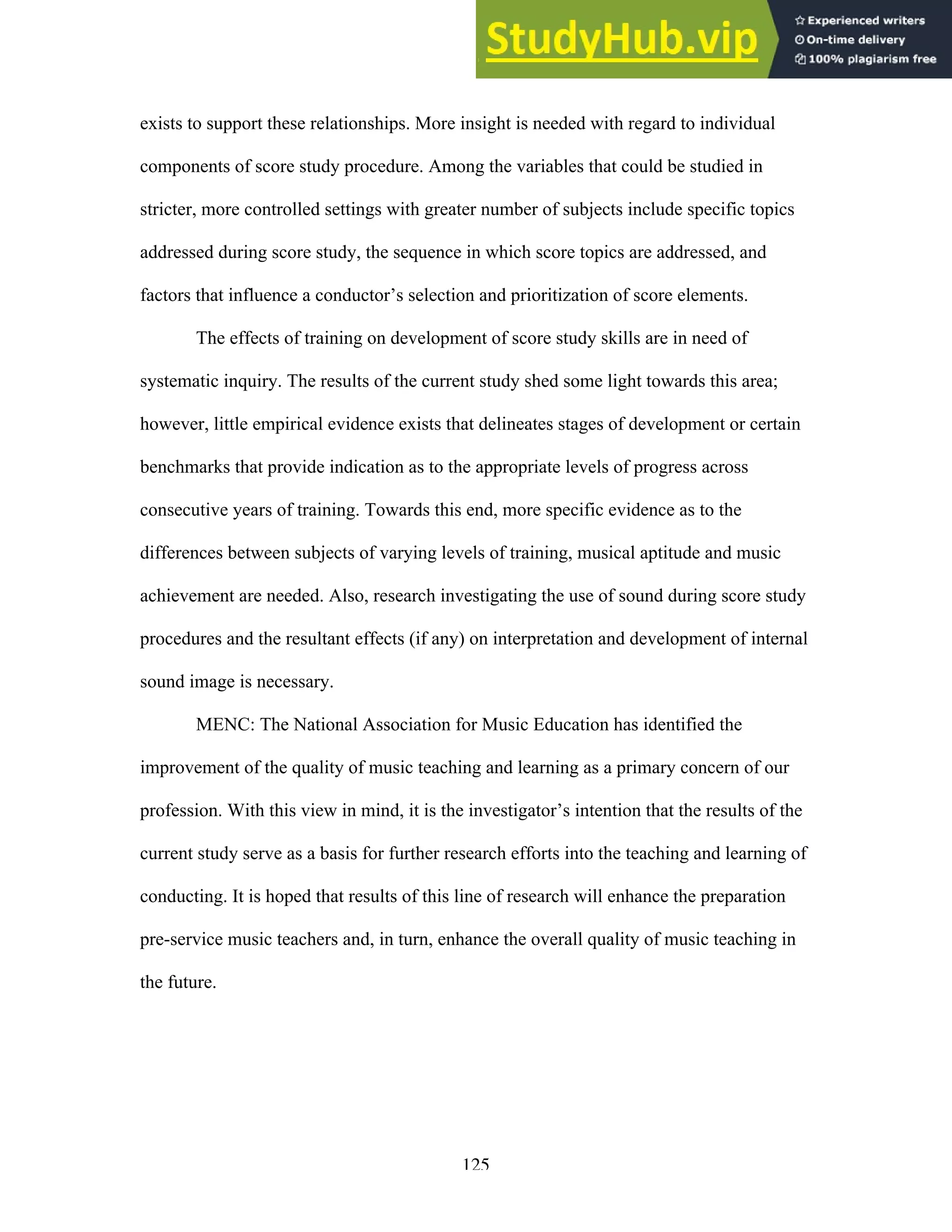
![126
REFERENCES
Anderson, L.W., Krathwohl, D.R., Airasian, P.W., Cruikshank, K.A., Mayer, R.E.,
Pintrich, P.R., et al. (2001). A taxonomy for teaching, learning, and assessing: A
revision of Bloom’s taxonomy of educational objectives (Abridged edition). New
York: Addison Wesley Longman, Inc.
Arnold, M. (1965). Movement II: Vivace. English Dances for Band, Set I (M. Johnstone,
arr.). South Croydon, Surrey, U.K.: Alfred Lengnick & Co., Ltd.
ATLAS.ti: Visual Qualitative Data Analysis (Version 4.2) [Computer software]. (2002).
Berlin: Scientific Software Development.
Bamberger, C. (1965). The conductor’s art. New York: McGraw-Hill.
Barton, G. (2001). On the podium with Larry Rachlef. The Instrumentalist, 56, (3), 15-
19.
Battisti, F.L. (1997). Conducting isn’t easy. The Instrumentalist, 51 (9), 11-16.
Battisti, F.L. and Garafolo, R. (1990). Guide to score study for the wind band conductor.
Ft. Lauderdale, FL: Meredith Music Publications.
Benge, T.J. (1996). Movements utilized by conductors in the simulation of expression
and musicianship. (Doctoral dissertation, University of Southern California,
1996). Dissertation Abstracts International, 58-01A, 18.
Bergee, M.J. (1992). A scale assessing music student teachers’ rehearsal effectiveness.
Journal of Research in Music Education, 40, 5-13.
Boult, A. (1924). ‘The point of the stick’: A handbook on the technique of conducting.
London: Paterson’s Publications, Ltd.
Boyer, C.G. (1974). Developing score reading skills through programmed instruction.
(Doctoral dissertation, Arizona State University, 1974). Dissertation Abstracts
International, 35-06A, 3789.
Brand, M & Burnsed, V. (1981). Music abilities and experiences as predictors of error-
detection skill. Journal of Research in Music Education, 29, 91-96.
Brittin, R. (2003, April). “Let’s turn to page 8…”: An analysis of lesson plans for
beginning instrumentalists. Paper presented at the 15th
International Research in
Music Behavior Symposium, Chicago, IL.](https://image.slidesharecdn.com/abasicinterpretiveanalysis-230806181021-8e7fdd33/75/A-Basic-Interpretive-Analysis-136-2048.jpg)

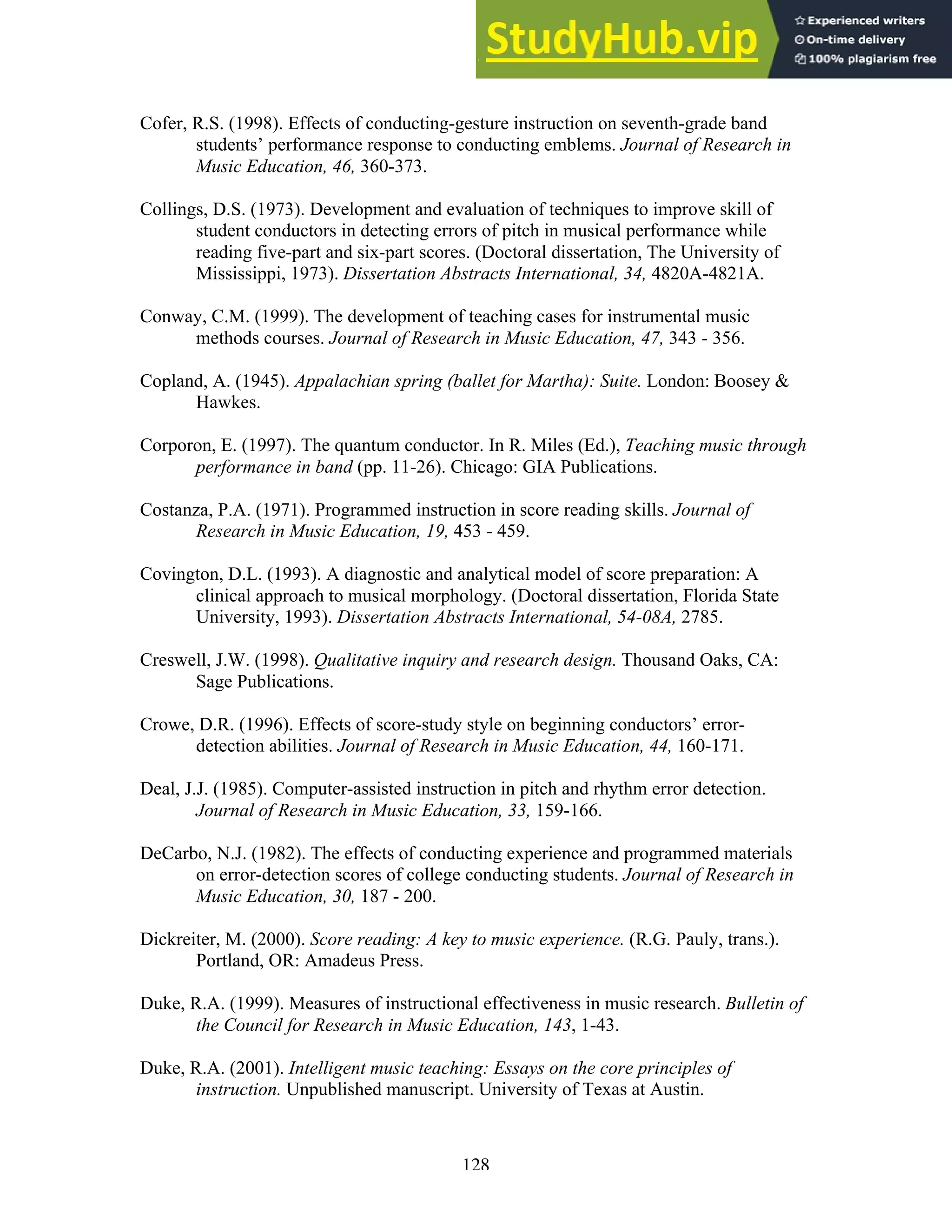
![129
Ellis, B. L. (1994). Selected band conductors’ preparation to conduct selected band
compositions. (Doctoral dissertation, University of Illinois at Urbana -
Champaign, 1994). Dissertation Abstracts International, 55-09A, 2626.
Ellis, B. (1997). Kenneth Bloomquist on the art of score study. The Instrumentalist,
51 (10), 12-15, 76.
Finale 2000 [Computer software]. (1999). Eden Prairie, MN: Coda Music Technology.
Forsythe, J.L. and Woods, J.R. (1983). The effects of conducting on the error detection
ability of undergraduate and graduate instrumental conductors. Contributions to
Music Education, 10, 27-31.
Fredrickson, W.F. (1992). Research on eye contact with implications for the conductor: A
review of literature. Update: Applications of Research in Music Education, 11 (1),
25-31.
Fredrickson, W.F. (1994). Band musicians’ performance and eye contact as influenced by
loss of a visual and/or aural stimulus. Journal of Research in Music Education,
42, 306-317.
Gardner, H. (2000). The disciplined mind. New York: Penguin Books.
Gonzo, C.L. (1971). An analysis of factors related to choral teachers’ ability to detect
pitch errors while reading the score. Journal of Research in Music Education, 19,
259 - 271.
Grant, J.W. and Drafall, L.E. (1991). Teacher effectiveness research: A review and
comparison. Bulletin of the Council for Research in Music Education, 108, 31-48.
Grashel, J. (1991). Teaching basic conducting skills through video. Music Educators
Journal, 77, 36-37.
Grechesky, R.N. (1985). An analysis of nonverbal and verbal conducting behaviors and
their relationship to musical performance. (Doctoral dissertation, The University
of Wisconsin-Madison, 1985). [On-line]. Dissertation Abstracts International, 46,
2956A. Abstract from: WEBSPIRS File: Dissertation Abstracts International,
1981-1986.
Green, E.A.H. (1981). The modern conductor. (3rd
ed.) Englewood Cliffs, NJ: Prentice-
Hall.
Green, E.A.H. and Malko, N. (1975). The conductor and his score. Englewood Cliffs,
NJ: Prentice-Hall.](https://image.slidesharecdn.com/abasicinterpretiveanalysis-230806181021-8e7fdd33/75/A-Basic-Interpretive-Analysis-139-2048.jpg)
![130
Gruner, G.L. (1993). The design and evaluation of a computer-assisted error detection
skills development program for beginning conductors utilizing synthetic sound
sources. (Doctoral dissertation, Ball State University, 1993). Dissertation
Abstracts International, 54-03A, 726.
Grunow, R.F. (1980). An investigation of the relative effectiveness of four modes of
score preparation on visual-aural discrimination skills development. (Doctoral
dissertation, University of Michigan, 1980). [On-line]. Dissertation Abstracts
International, 41-02A, 580. Abstract from: WEBSPIRS File: Dissertation
Abstracts International, 1861-1980.
Grunow, R.F. and Froseth, J.O. (1981). MLR Instrumental Score Reading Program.
Chicago: GIA Publications.
Harris, F., Jr. (2001). Conducting with feeling. Galesville, MD: Meredith Music
Publications.
Hart, P. (1979). Conductors: A new generation. New York: Charles Scribner’s Sons.
Hayslett, D. (1996). The effect of movement-based training upon the aural acuity of
conductors. Contributions to Music Education, 23, 7 – 18.
Hochkeppel, W.J. (1993). Systematic score study: Effects of four methodologies of error
detection achievement in instrumental conducting students. (Doctoral dissertation,
Indiana University, 1993). Dissertation Abstracts International, 54-08A, 2937.
Hoffman, D. K. (2002). Auditory imagery of conductors: An examination of the
electroencephalographic correlates of score reading before and after score study.
(Doctoral dissertation, University of Minnesota, 2002). [On-line]. Dissertation
Abstracts International, 62-12A, 4101. Abstract from: WEBSPIRS File:
Dissertation Abstracts International, 2001-2002/8.
Hopkins, J.E. (1991). The effect of four approaches to score study on student conductors’
ability to detect errors in the performance of choral music. (Doctoral dissertation,
University of Illinois – Urbana/Champaign, 1991). Dissertation Abstracts
International, 52-11A, 3854.
Hudson, M.E. (1996). The development and evaluation of a computer-assisted music
instruction program as an aid to score study for the undergraduate wind band
conducting student. (Doctoral dissertation, University of Florida, 1996).
Dissertation Abstracts International, 57-09A, 3866.
Hunsberger, D. and Ernst, R.E. (1992). The art of conducting (2nd
ed.). New York:
McGraw-Hill.](https://image.slidesharecdn.com/abasicinterpretiveanalysis-230806181021-8e7fdd33/75/A-Basic-Interpretive-Analysis-140-2048.jpg)
![131
Jellison, J.A. (2000). How can all people continue to be involved in meaningful music
participation? In C.K. Madsen (Ed.), Vision 2020: The Housewright symposium
on the future of music education (pp. 111-138). Reston, VA: MENC: The
National Association for Music Education.
Johnson, C.M. and Fredrickson, W.E. (1995). The effect of aural commentary, written
comments, and behavioral self-assessment on conductor intensity. Journal of
Band Research, 30 (2), 27-38.
Jones, D.L. (1990). Design and trial of a computer-assisted system supplying practice in
error detection for preservice instrumental music educators. (Doctoral
dissertation, University of Georgia, 1990). [On-line]. Dissertation Abstracts
International, 51-10A, 3355. Abstract from: WEBSPIRS File: Dissertation
Abstracts International, 1987-1991.
Julian, F.D. (1989). Nonverbal communication: Its application to conducting. Journal of
Band Research, 24 (2), 49-54.
Karpicke, H.A., Jr. (1987). Development of an instrument to assess conducting gesture
and validation of its use in orchestral performance. (Doctoral dissertation,
University of Houston, 1987). [On-line]. Dissertation Abstracts International, 49-
02A, 216. Abstract from: WEBSPIRS File: Dissertation Abstracts
International, 1987-1991.
Kelly, S.N. (1997). Effects of conducting instruction on the musical performance of
beginning band students. Journal of Research in Music Education, 45, 295-305.
Kelly, S.N. (1999). Using conducting gestures to teach music concepts: A review of
research. Update: Applications of Research in Music Education, 16 (1), 3-6.
Knight, J. (2001). Freedom with discipline: An interview with Cristoph von Dohnanyi.
The Instrumentalist, 54 (8), 12-17.
Kraus, B.N., Gonzalez, G.M., Hill, G.W., & Humphreys, J.T. (2002, February). The
effects of interactive computer feedback on the development of fundamental
conducting skills. Paper presented at the annual convention of the Texas Music
Educators Association, San Antonio, TX, February 8, 2002.
Labuta, J.A. (1995). Basic conducting techniques (3rd
ed.). Englewood Cliffs, NJ:
Prentice Hall.
Laib, J.R. (1994). The effect of expressive conducting on band performance. (Doctoral
dissertation, University of Georgia, 1994). Dissertation Abstracts International,
54, 3258A.
Lake, M. (1938). Sixteen chorales by J.S. Bach. New York: G. Schirmer.](https://image.slidesharecdn.com/abasicinterpretiveanalysis-230806181021-8e7fdd33/75/A-Basic-Interpretive-Analysis-141-2048.jpg)
![132
Lane, J.S. (2002a). A descriptive analysis of undergraduate instrumental music education
majors’ score-study behaviors. Unpublished manuscript, Louisiana State
University, Baton Rouge.
Lane, J.S. (2002b). A description of undergraduate music majors’ verbal and written
behaviors when engaged in score preparation and the generation of a grounded
-theory. Unpublished manuscript, Louisiana State University, Baton Rouge.
LaRue, J. (1992). Guidelines for style analysis. (2nd
ed.). Warren, MI: Harmonie Park
Press.
Lentczner, B. (1977). Guidelines and models of score preparation of atonal band
literature. (Doctoral dissertation, Ball State University, 1977). Dissertation
Abstracts International, 30-01A, 356.
Leppla, D.A. (1990). The acquisition of basic conducting skills by beginning conductors:
A comparison of the effects of guided and unguided videotaped modeling. [On-
line]. (Doctoral dissertation, The Ohio State University, 1990). Dissertation
Abstracts International, 50, 3509A. Abstract from: WEBSPIRS File:
Dissertation Abstracts International, 1987-1991.
Liles, J.N. (1978). A study of the effectiveness of rhythmic drill materials with student
conductor teachers while conducting a live ensemble from a full score. (Doctoral
dissertation, The Ohio State University, 1978). [On-line]. Dissertation Abstracts
International, 39-08A, 4797. Abstract from: WEBSPIRS File: Dissertation
Abstracts International, 1861-1980.
Locy, R.S. (1996). The effect of instrumental timbre on the pitch error detection skills of
university conducting students. (Doctoral dissertation, Virginia Polytechnic
Institute and State University, 1996). Dissertation Abstracts International, 59-
07A, 3866.
Louisiana State University Office, Office of Academic Affairs (2002). 2002-2003
Undergraduate Catalog. (Volume 94, No. 1, April). Baton Rouge, LA: Author.
Maclin, J.P. (1993). The effect of task analysis on sequential patterns of music
instruction. Journal of Research in Music Education, 41, 48 - 56.
Markoch, J.R., Jr. (1995). An approach to the musical analysis of wind-band literature
based on analytical models used by wind-band specialists and music theorists.
(Doctoral dissertation, Louisiana State University, 1995). Dissertation Abstracts
International, 56-11A, 4312.](https://image.slidesharecdn.com/abasicinterpretiveanalysis-230806181021-8e7fdd33/75/A-Basic-Interpretive-Analysis-142-2048.jpg)
![133
Marrin, N.T. (2002). Inside the “Conductor’s Jacket”: Analysis, interpretation, and
musical synthesis of gesture. (Doctoral dissertation, Massachusetts Institute of
Technology, 2000). [On-line]. Dissertation Abstracts International, 61-06A,
2095. Abstract from: WEBSPIRS File: Dissertation Abstracts International,
1997-2000.
Mayne, R.G. (1993). An investigation of the use of facial expression in conjunction with
musical conducting gestures and their interpretation by instrumental performers.
(Doctoral dissertation, The Ohio State University, 1993). [On-line]. Dissertation
Abstracts International 53, 2729A. Abstract from: WEBSPIRS File:
Dissertation Abstracts International, 1992-1996.
McWilliams, R.L. (1996). An investigation into the use and effectiveness of videotape
self-evaluations of conducting for practicing music educators. . (Doctoral
dissertation, University of Minnesota, 1996). [On-line]. Dissertation Abstracts
International 57-06A, 2407. Abstract from: WEBSPIRS File: Dissertation
Abstracts International, 1992-1996.
MENC: The National Association for Music Education, Music Education Research Task
Force (1998). A research agenda for music education. Retrieved October 21,
2002 from http://www.menc.org.
Merriam, S.B. (2001). Qualitative research and case study applications in education (2nd
ed.). San Francisco: Jossey-Bass.
Merriam, S.B. (2002). Qualitative research in practice: Examples for discussion and
analysis. San Francisco: Jossey-Bass.
Moss, B. (2002). The secret of good conducting: An interview with James Croft.
The Instrumentalist, 56 (10), 14-18.
Oertel, D.W. (1998). William Steinberg: His conducting and career. (Doctoral
dissertation, The University of North Carolina at Greensboro, 1998). [On-line].
Dissertation Abstracts International, 59-07A, 2245. Abstract from: WEBSPIRS
File: Dissertation Abstracts International, 1997-2000.
Orzolek, D.C. (2002). The effect of imagery and movement exercises on the ability of
students to conduct expressively. Journal of Band Research 37 (2), 61-78.
Ostling, A., Jr. (1977). Research on nonverbal communication with implications for
conductors. Journal of Band Research, 12 (2), 29-43.
Prausnitz, F. (1983). Score and podium: A complete guide to conducting. New York:
W.W. Norton.](https://image.slidesharecdn.com/abasicinterpretiveanalysis-230806181021-8e7fdd33/75/A-Basic-Interpretive-Analysis-143-2048.jpg)

![135
Sidoti, V.J. (1990). The effects of expressive and nonexpressive conducting on the
performance accuracy of selected expressive markings by high school
instrumentalists. (Doctoral dissertation, The Ohio State University, 1990). [On-
line]. Dissertation Abstracts International, 51, 3270A. Abstract from:
WEBSPIRS File: Dissertation Abstracts International, 1987-1991.
Snow, S.L. (1998). Rehearsing in the choral context: A qualitative examination of
undergraduate conductor/teacher planning processes and relationships to
emergent pedagogical knowledge evidenced in teaching. (Doctoral dissertation,
Michigan State University, 1998). Dissertation Abstracts International, 60-03A,
684.
Sousa, G.D. (1989). Musical conducting emblems: An investigation of the use of specific
conducting gestures by instrumental conductors and their interpretation by
instrumental performers. (Doctoral dissertation, The Ohio State University, 1989).
[On-line]. Dissertation Abstracts International, 49, 2143A. Abstract from:
WEBSPIRS File: Dissertation Abstracts International, 1987-1991.
Stalter, T.J. (1996). The conductors’ process model and its presentation in current
conducting materials and methodologies. (Doctoral dissertation, University of
Wisconsin-Madison, 1996). Dissertation Abstracts International, 57-04A, 1384.
Strouse, L.H. (1987). From analysis to gesture: A comprehensive approach to score
preparation for the conductor. (Doctoral dissertation, Ball State University, 1987).
Dissertation Abstracts International, 48-03A, 511.
Swinehart, T.E. (1994). The effect of timbral variance on the score-reading ability of
novice conductors. (Doctoral dissertation, The Ohio State University, 1994).
Dissertation Abstracts International, 56-01A, 132.
Teachout, D.J. (1997). Preservice and experienced teachers’ opinions of skills and
behaviors important to successful music teaching. Journal of Research in Music
Education, 41,41-50.
Teicher, J.M. (1997). Effect of multicultural music experience on preservice elementary
teachers’ attitudes. Journal of Research in Music Education, 45, 15 - 27.
Toney, H. Jr. (2000). Expressive ensemble conducting and performing: A qualitative case
study of one conductor’s practice. (Doctoral dissertation, University of Illinois at
Urbana-Champaign, 2000). Dissertation Abstracts International, 61-04A, 3824.
University Interscholastic League (n.d.) Music contest entry blanks and comment sheet
forms, Nos. 4 and 6. Austin, TX: Author.](https://image.slidesharecdn.com/abasicinterpretiveanalysis-230806181021-8e7fdd33/75/A-Basic-Interpretive-Analysis-145-2048.jpg)
![136
Vincent, D.E. (1990). Ensemble pitch and rhythm error discrimination: The identification
and selection of predictors. (Doctoral dissertation, University of British Columbia,
1990). [On-line]. Dissertation Abstracts International, 53-09A, 3136. Abstract
from: WEBSPIRS File: Dissertation Abstracts International, 1987-1991.
Wagar, J. (1991). Conductors in conversation. Boston: G.K. Hall & Co.
White, J.D. (1984). The analysis of music (2nd
ed.). Metuchen, NJ: Scarecrow Press.
White, J.D. (1994). Comprehensive musical analysis. Metuchen, NJ: Scarecrow Press.
Wiggins, G.P. and McTighe, J. (1998). Understanding by design. Alexandria, VA:
Association for Supervision and Curriculum Development.
Williams, J.E. (1998). Rehearsing the band. (K.L. Neidig, Ed.). Cloudcroft, NM: Neidig
Services.
Wine, T.R. (1995a) Approaches to score marking by undergraduate and graduate choral
conducting. Missouri Journal of Research in Music Education, 32, 53-56.
Wine, T.R. (1995b). Student perception of score miniaturization as a pedagogical tool for
developing choral conducting skills. Contributions to Music Education, 22, 49 -
61.
Yarbrough, C. (1975). Effect of magnitude of conductor behavior on students in selected
mixed choruses. Journal of Research in Music Education, 35, 183-189.
Yarbrough, C. (1987). The relationship of behavioral self-assessment to the achievement
of basic conducting skills. Journal of Research in Music Education, 35, 183-189.
Yarbrough, C. (1988). Content and pacing in music teaching. In P.J. Flowers (Ed.),
Current Issues in Music Education: Vol. 13. Student and Teacher Competencies:
Interacting for Success. Columbus, OH: Division of Music Education, School of
Music, The Ohio State University.
Yarbrough, C. (2002). Sequencing musical tasks: The teaching artistry of Robert
Shaw. Update: Applications of Research in Music Education, 21, Fall/Winter.
Retrieved May 17, 2002 from http://www.menc.org/mbronly/publication/
updatefall02a2.html
Yarbrough, C. and Price, H.E. (1981). Prediction of performer attentiveness based upon
rehearsal activity and teacher behavior. Journal of Research in Music Education,
29, 209-217.](https://image.slidesharecdn.com/abasicinterpretiveanalysis-230806181021-8e7fdd33/75/A-Basic-Interpretive-Analysis-146-2048.jpg)




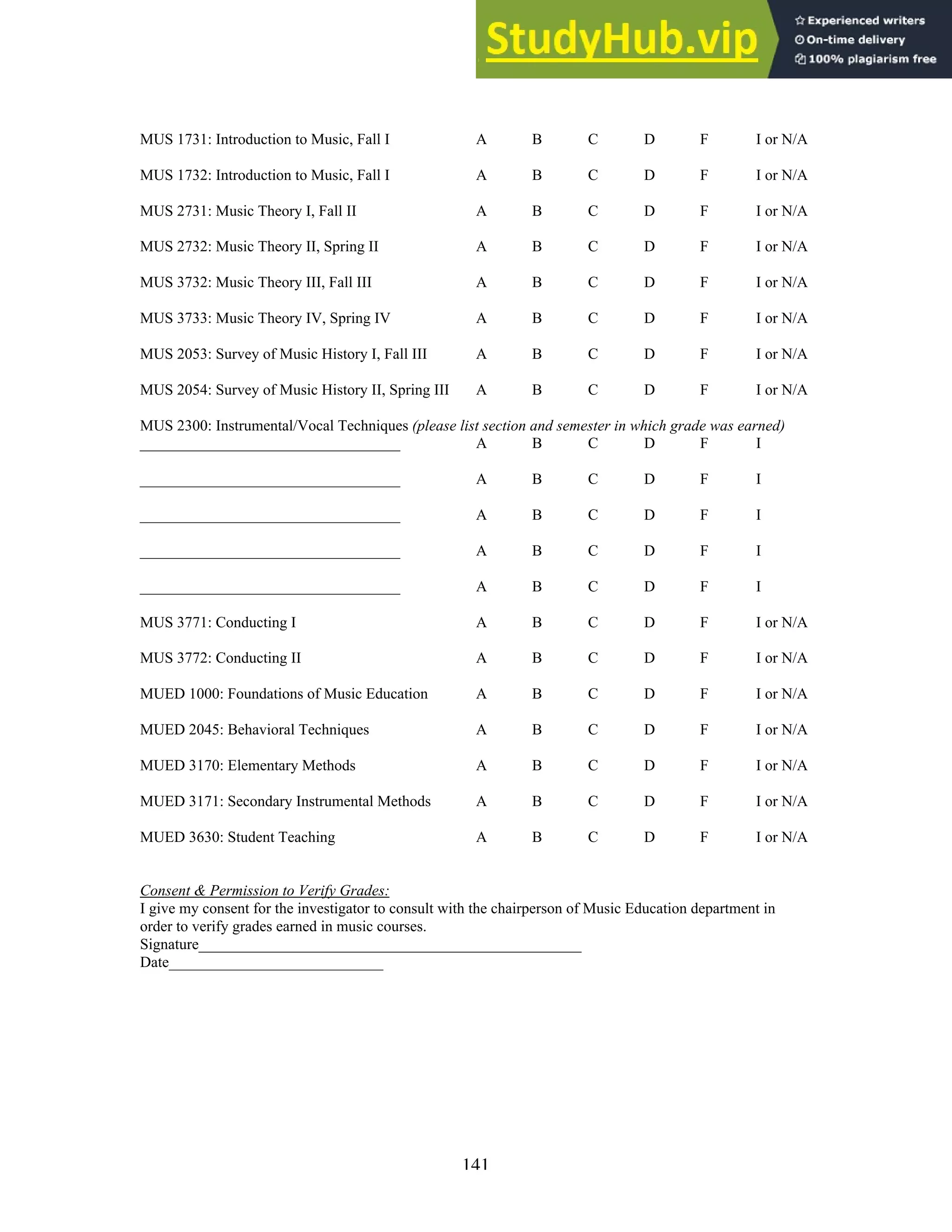


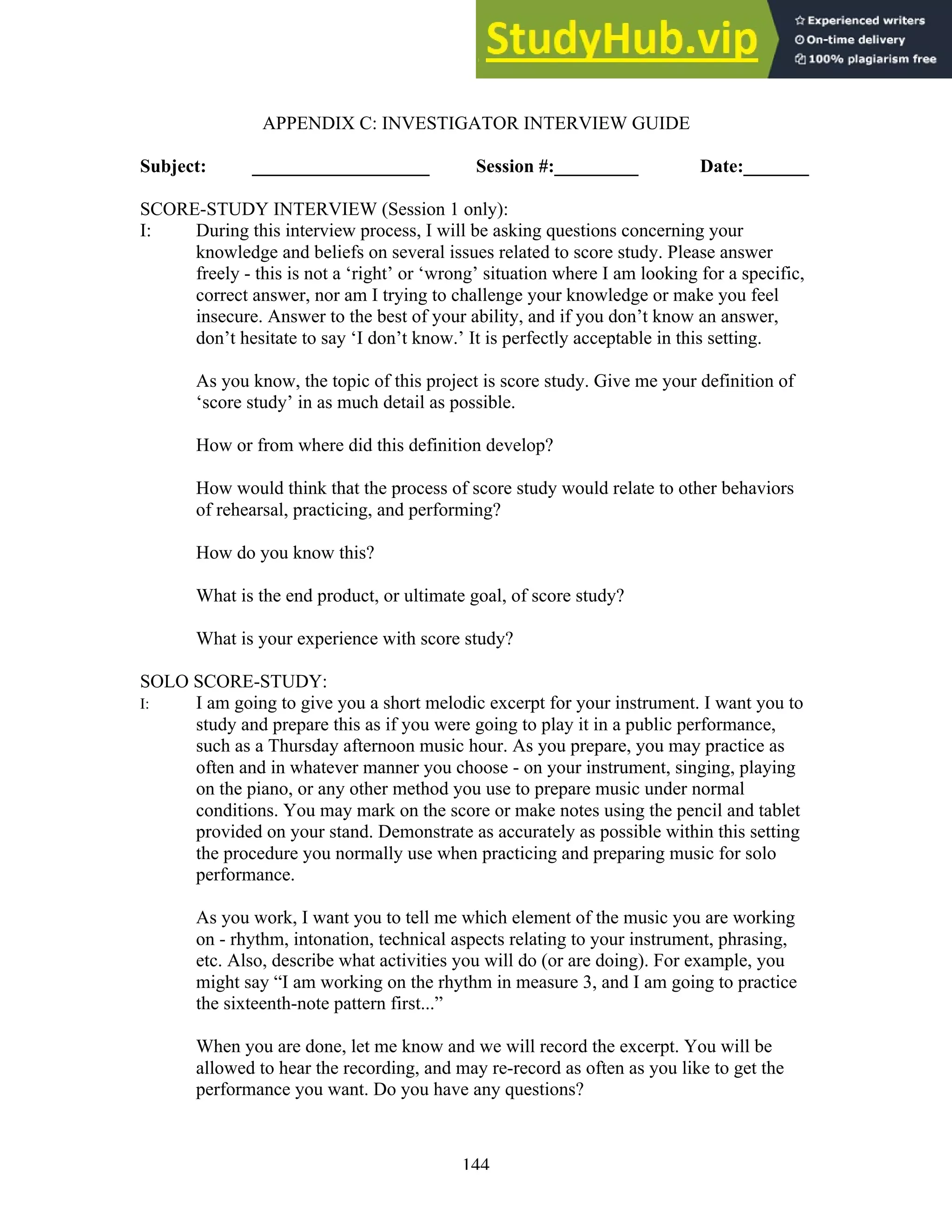
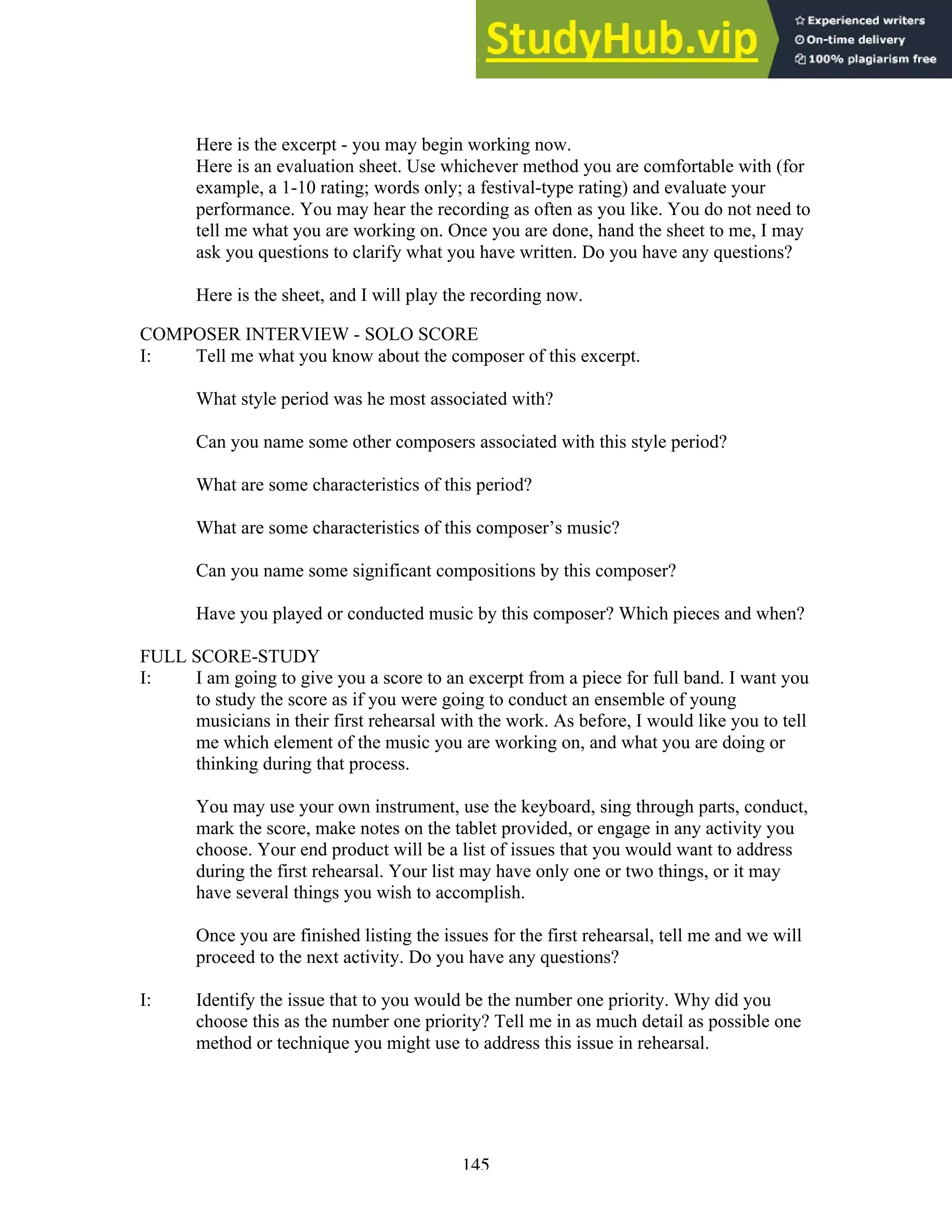
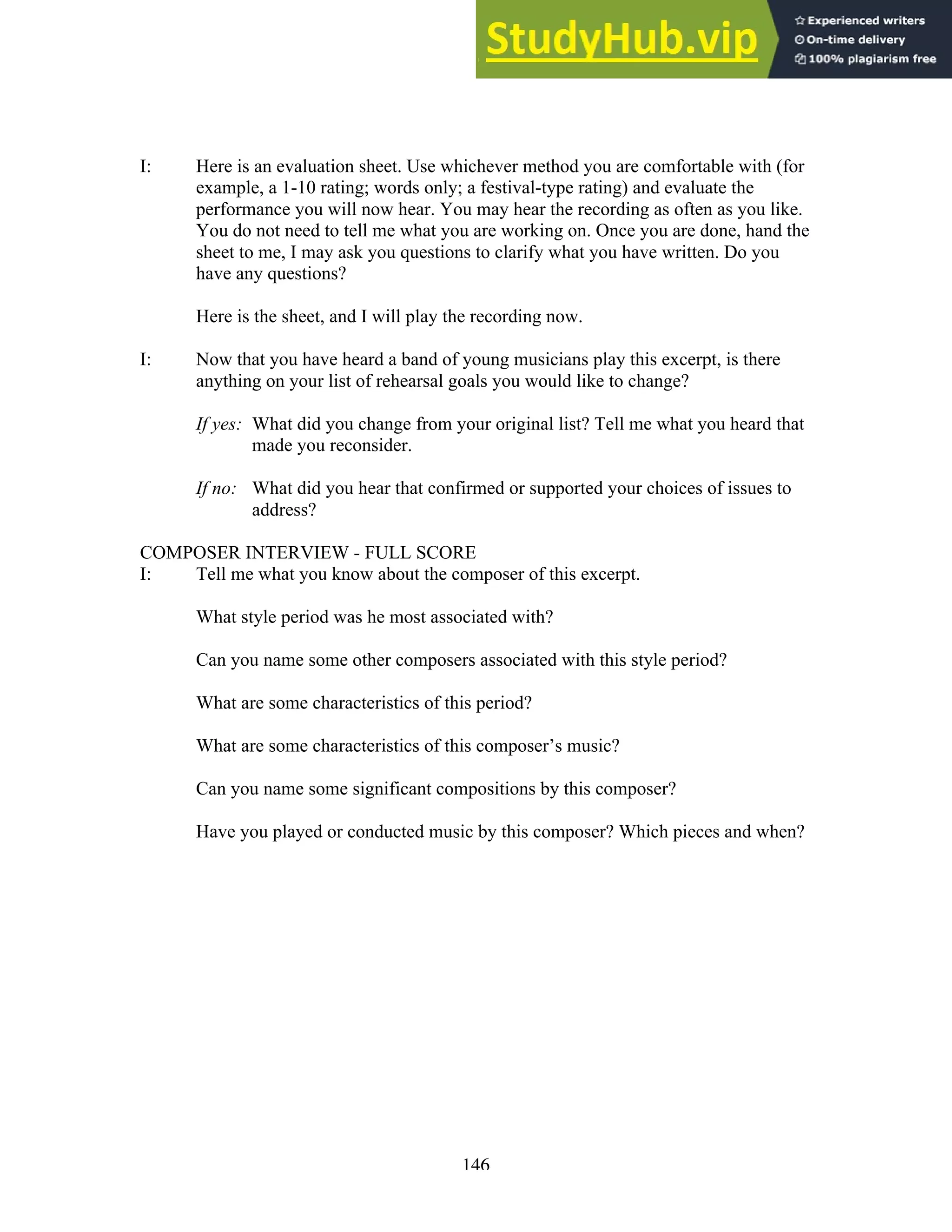
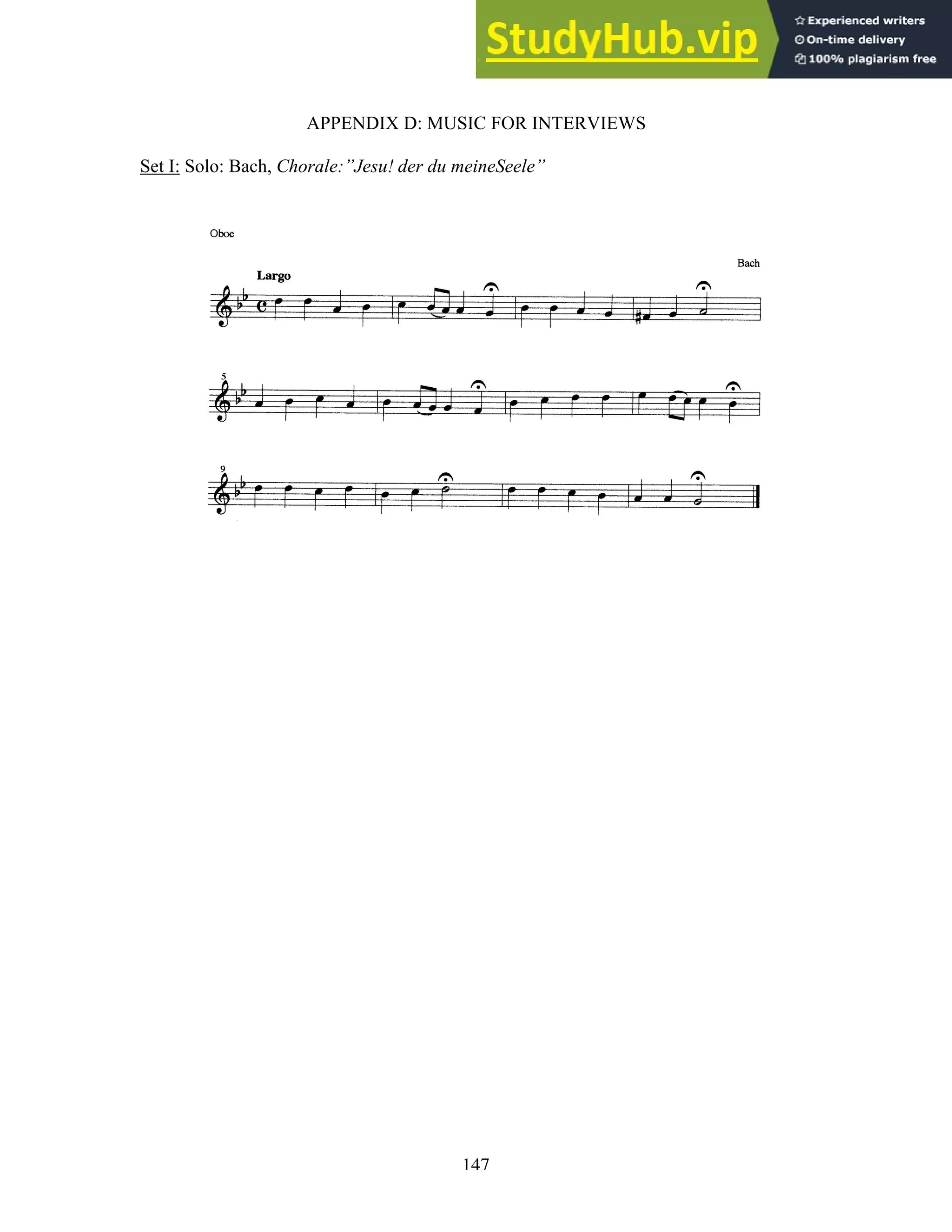

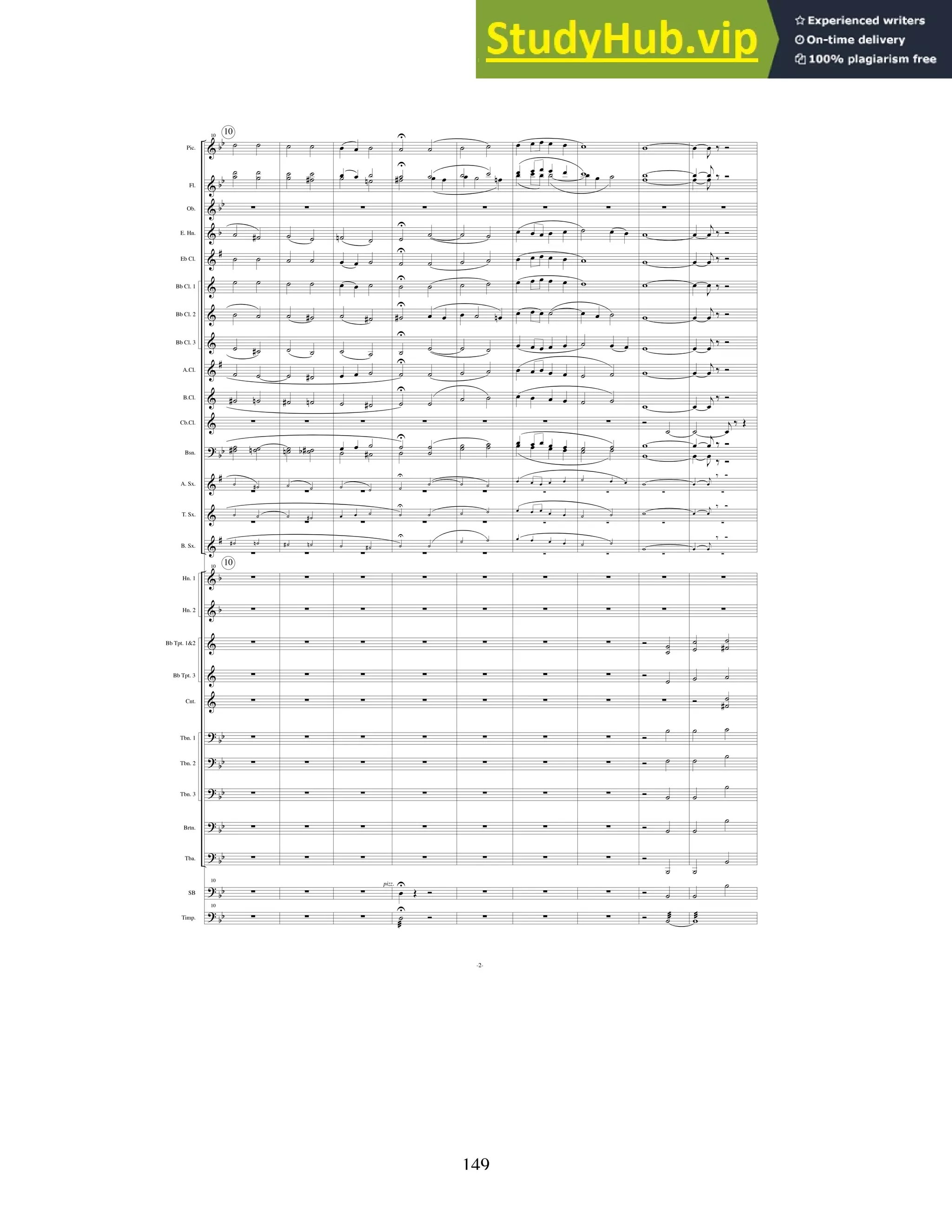
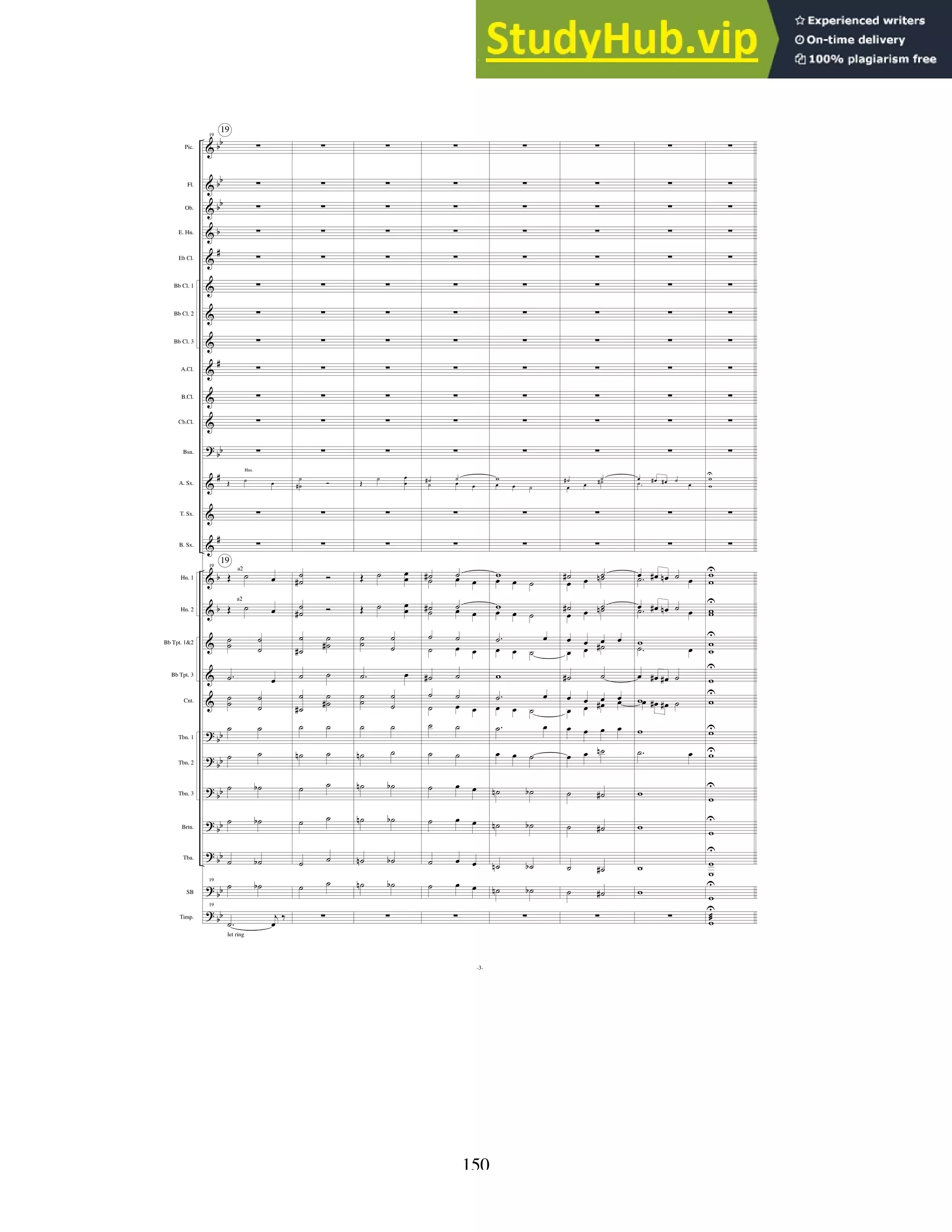
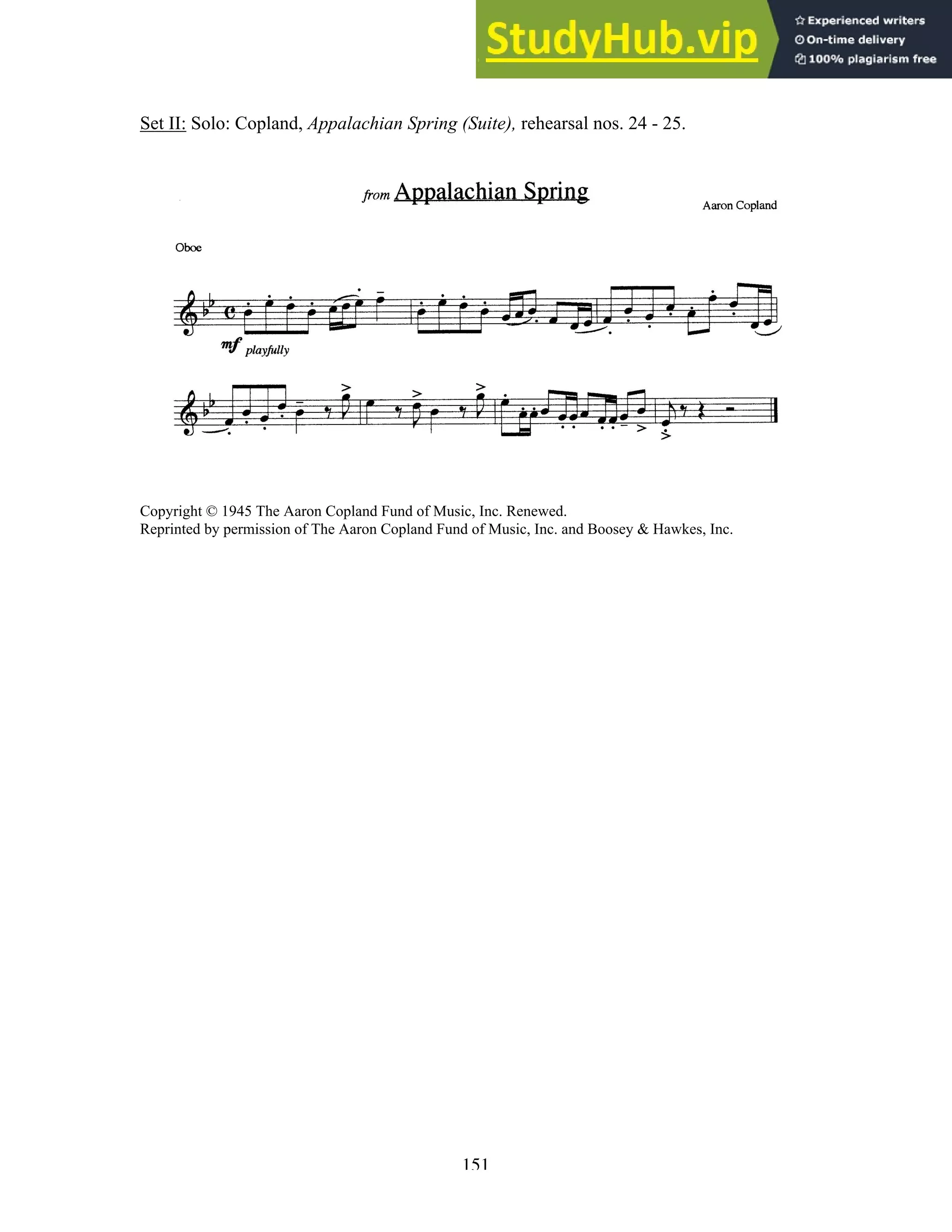
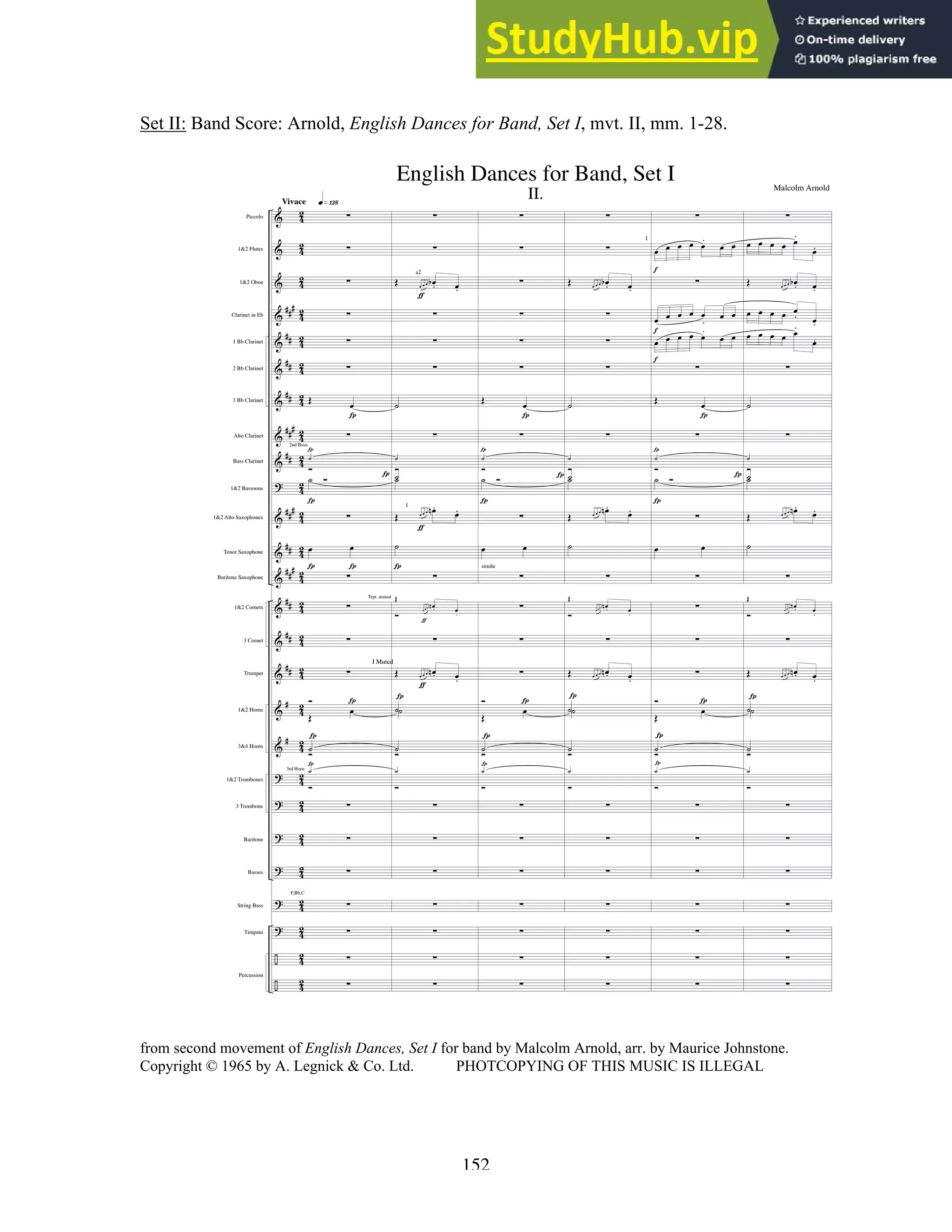
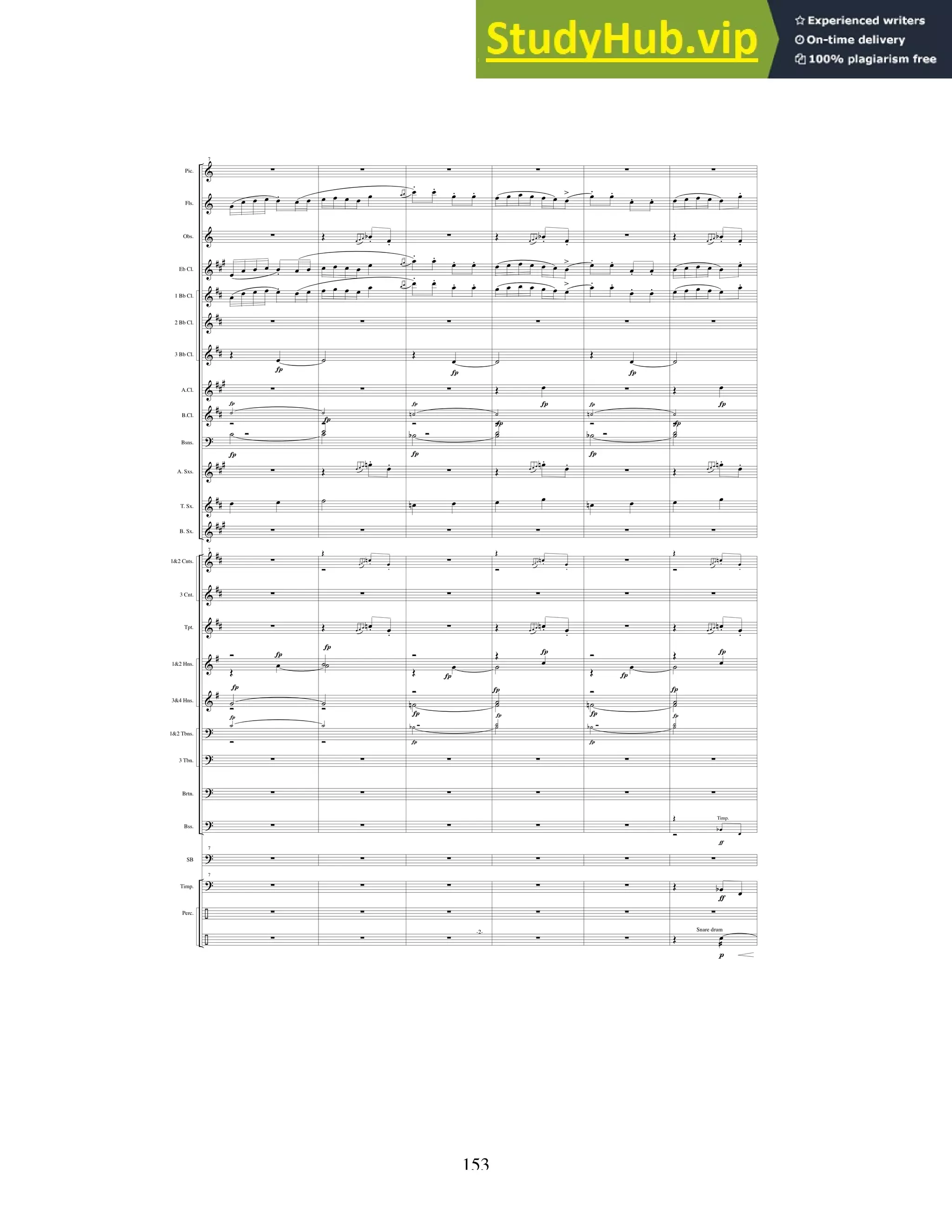
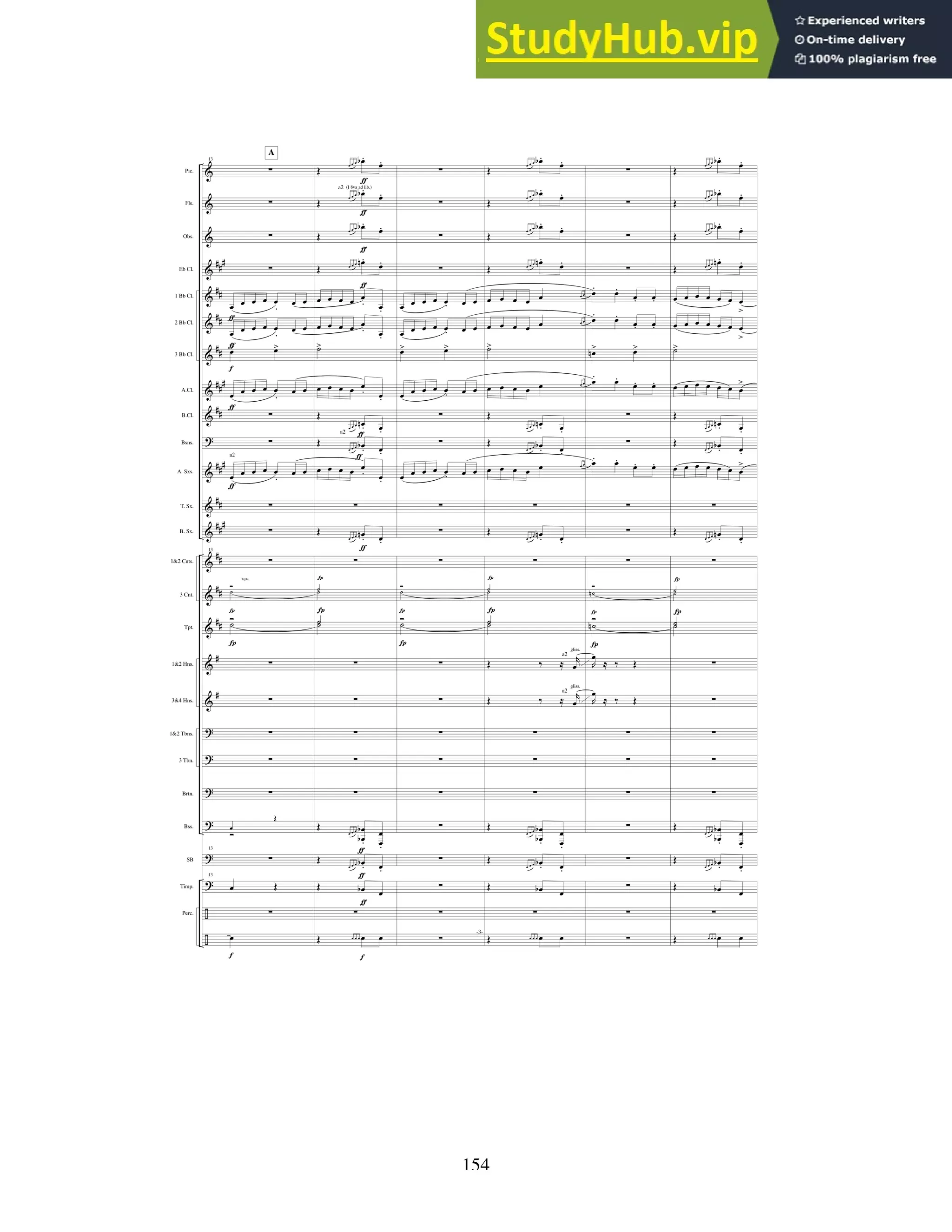

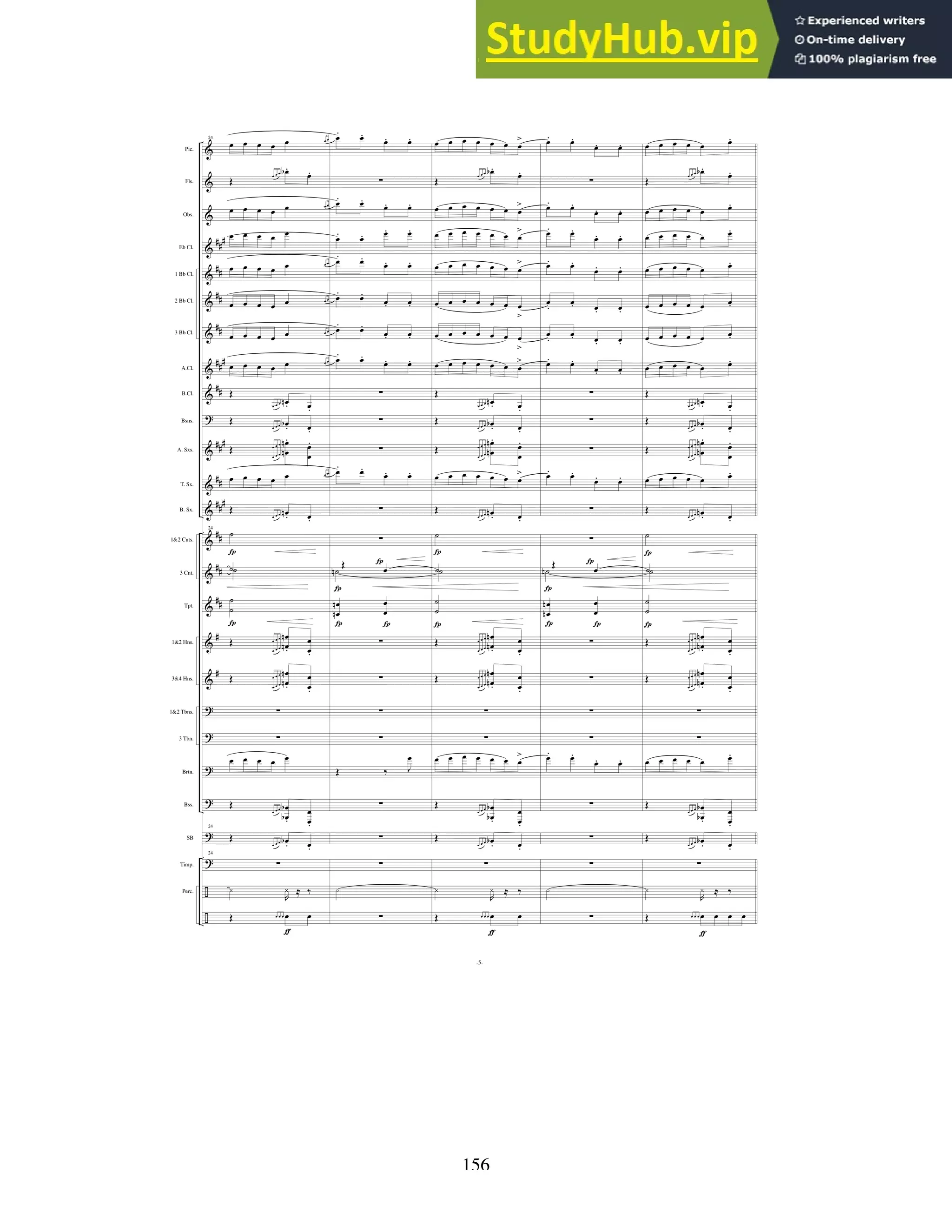
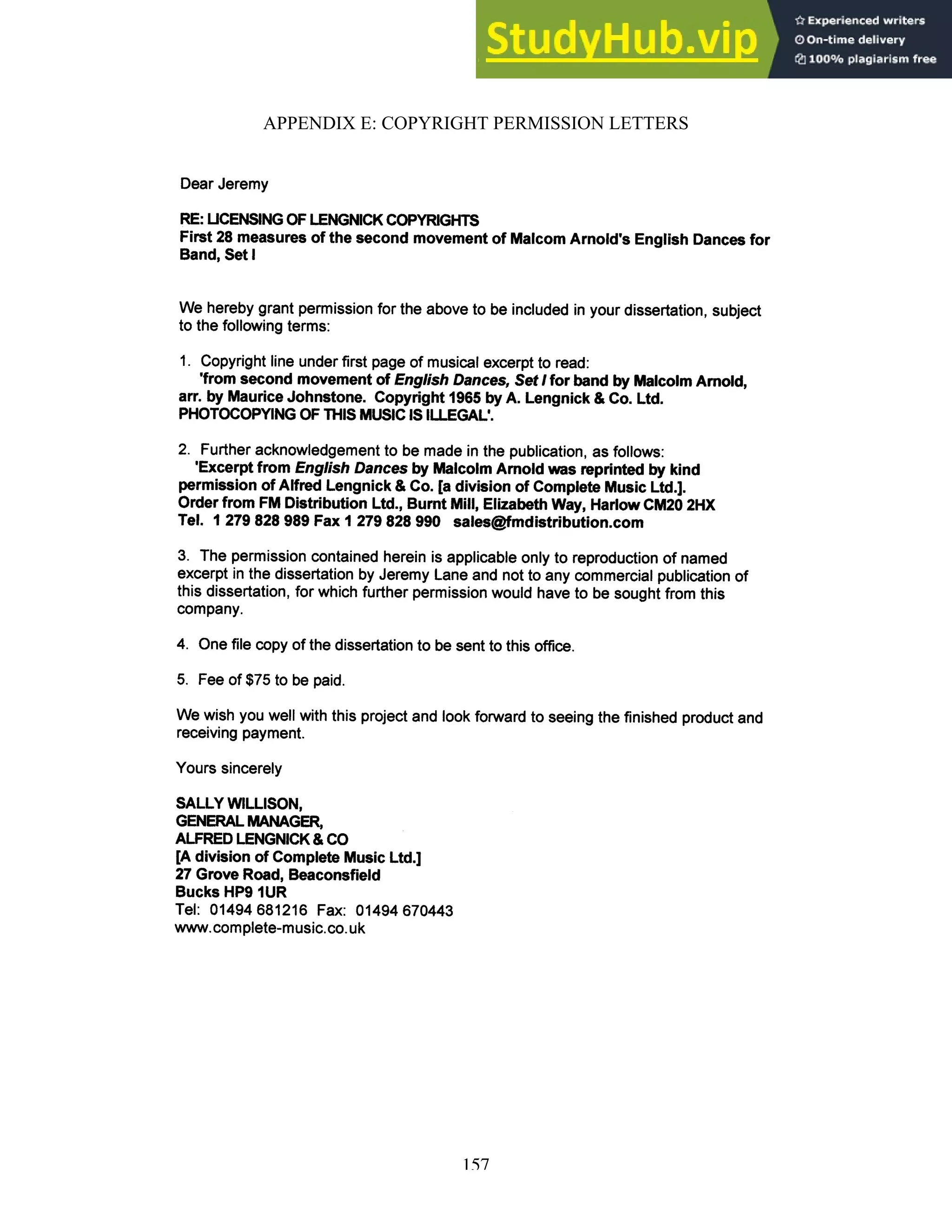
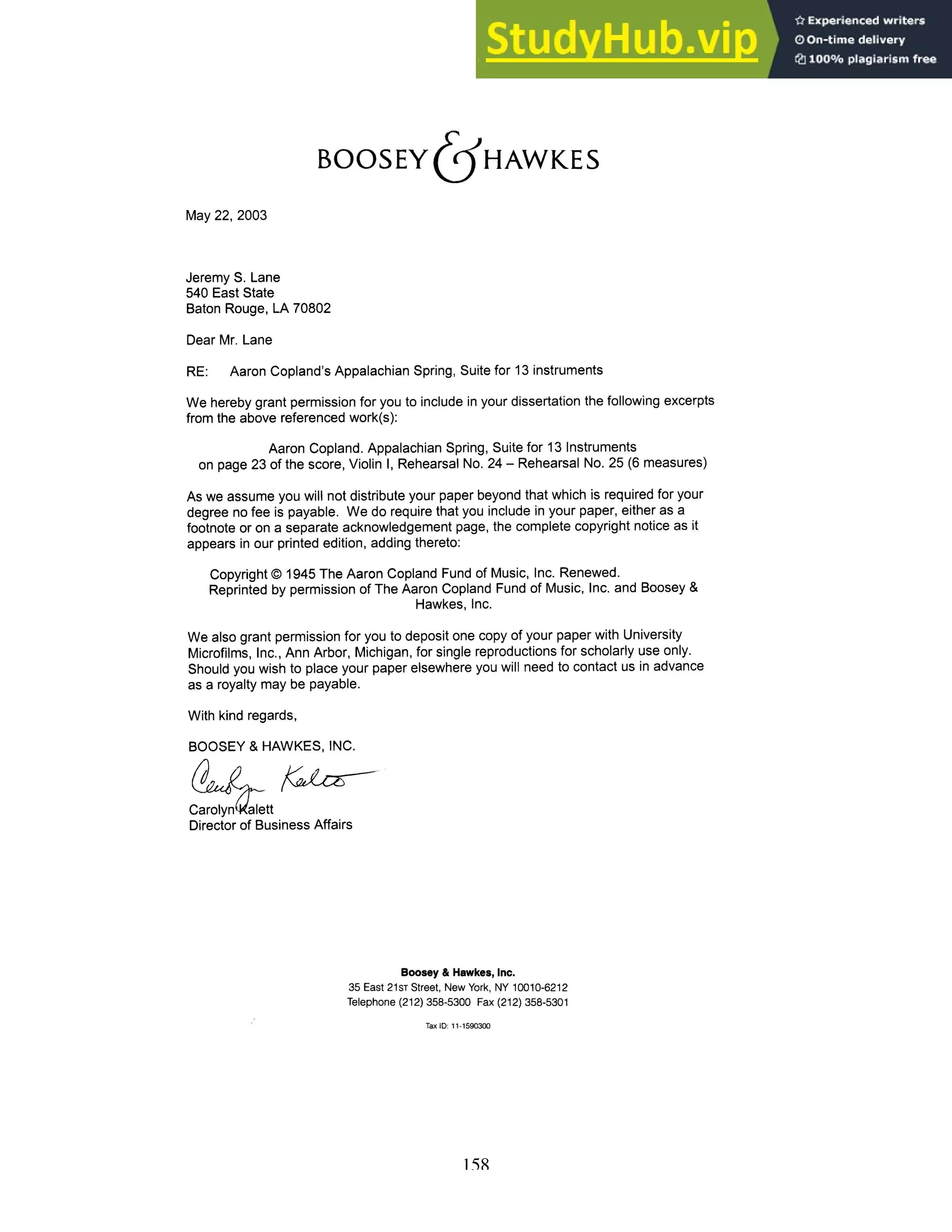
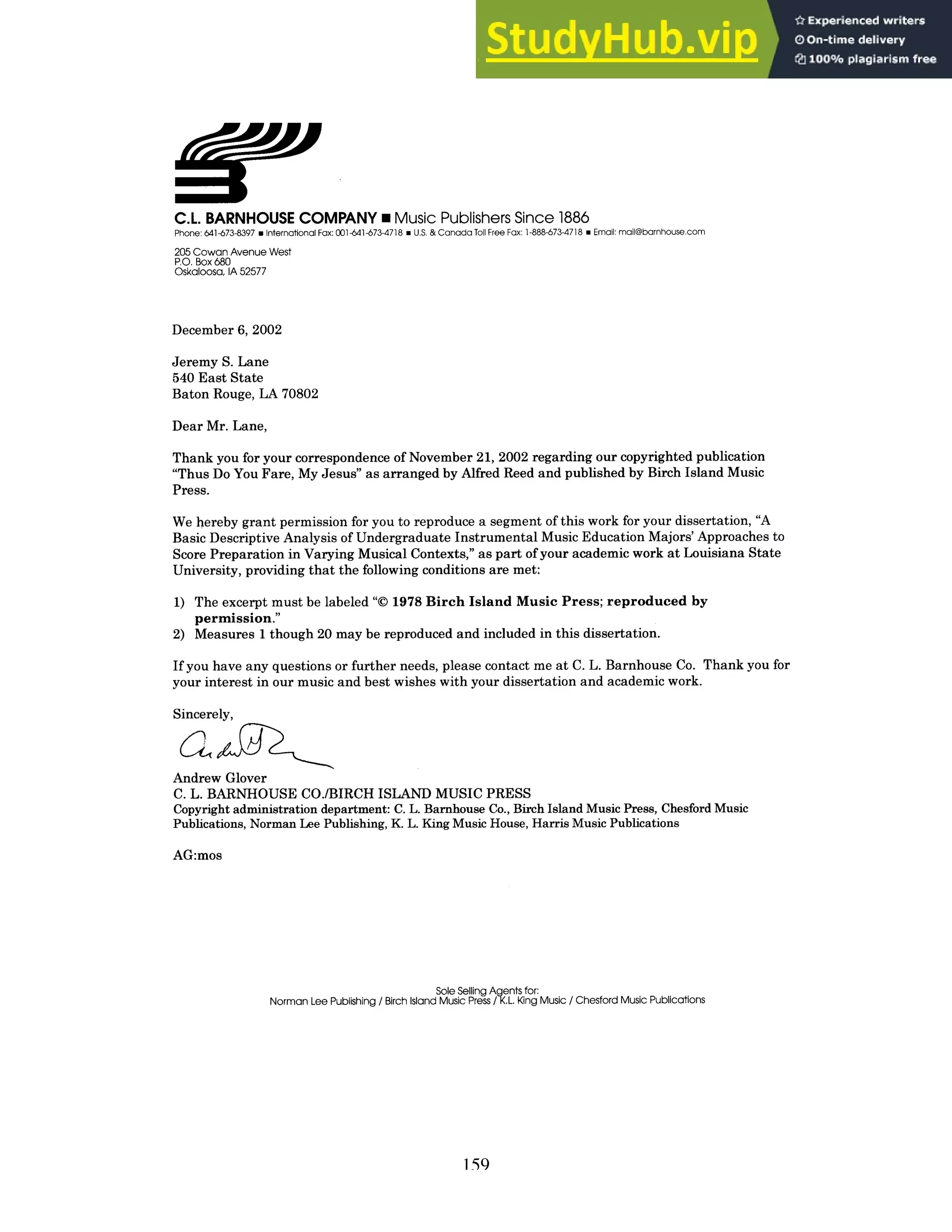
![160
APPENDIX F: COPYRIGHT ACKNOWLEDGEMENTS
Excerpt from Thus Do You Fare, My Jesus, arranged by Alfred Reed, reprinted by
kind permission of Birch Island Music Press [a division of C.L. Barnhouse Company].
Excerpt from Appalachian Spring (Suite for 13 Instruments) by Aaron Copland
reprinted with kind permission of Boosey & Hawkes, Inc. Copyright © 1945 The Aaron
Copland Fund of Music, Inc. Renewed. Reprinted by permission of The Aaron Copland
Fund of Music, Inc. and Boosey & Hawkes, Inc.
Excerpt from English Dances by Malcolm Arnold reprinted by kind permission of
Alfred Lengnick & Co. [a division of Complete Music Ltd.]. Order from FM Distribution
Ltd., Burnt Mill, Elizabeth Way, Harlow CM20 2HX Tel. 1 279 828 989 FAX 1 279 828
990 sales@fmdistribution.com.](https://image.slidesharecdn.com/abasicinterpretiveanalysis-230806181021-8e7fdd33/75/A-Basic-Interpretive-Analysis-170-2048.jpg)
